Patch News – June 2025
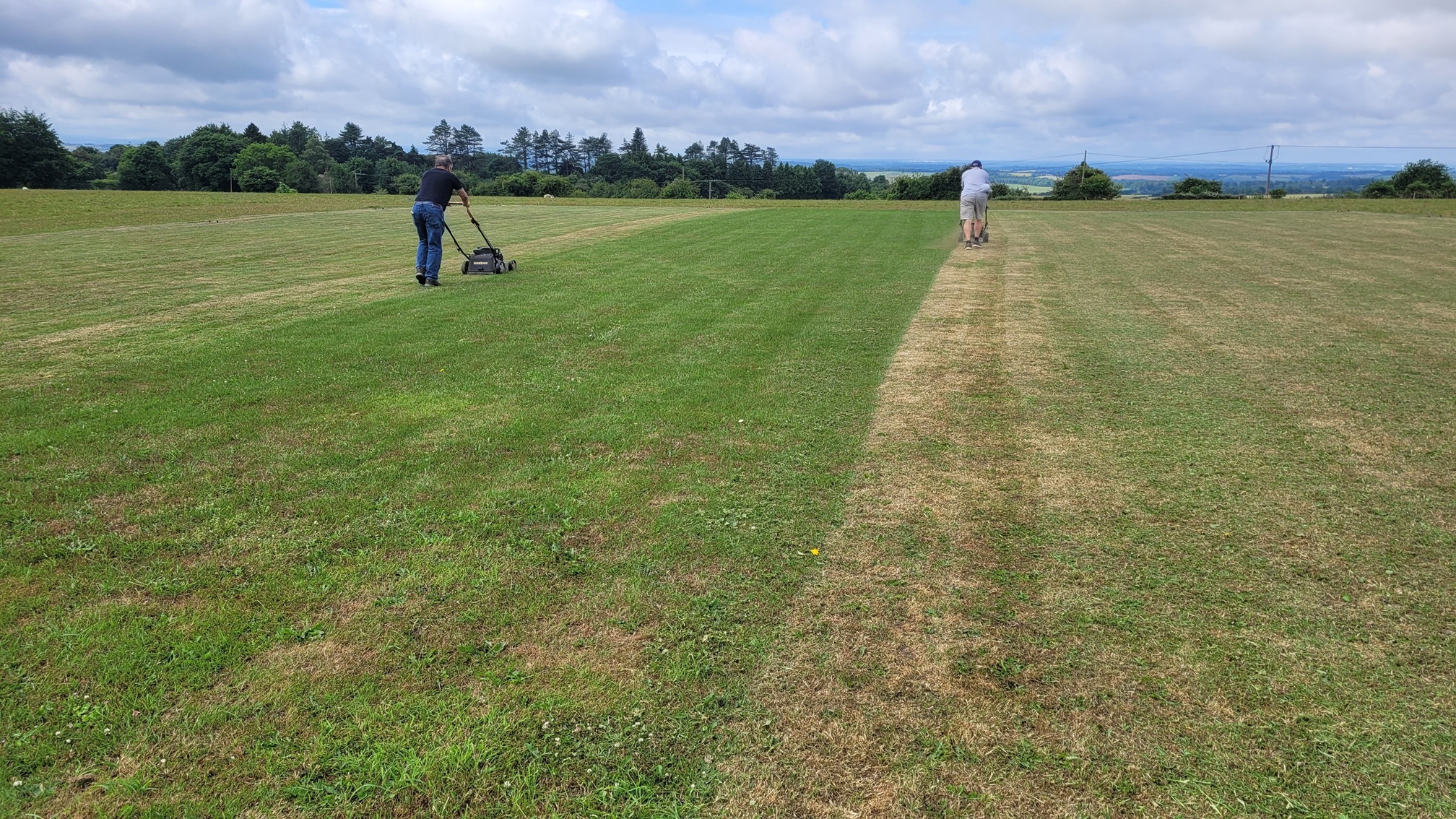
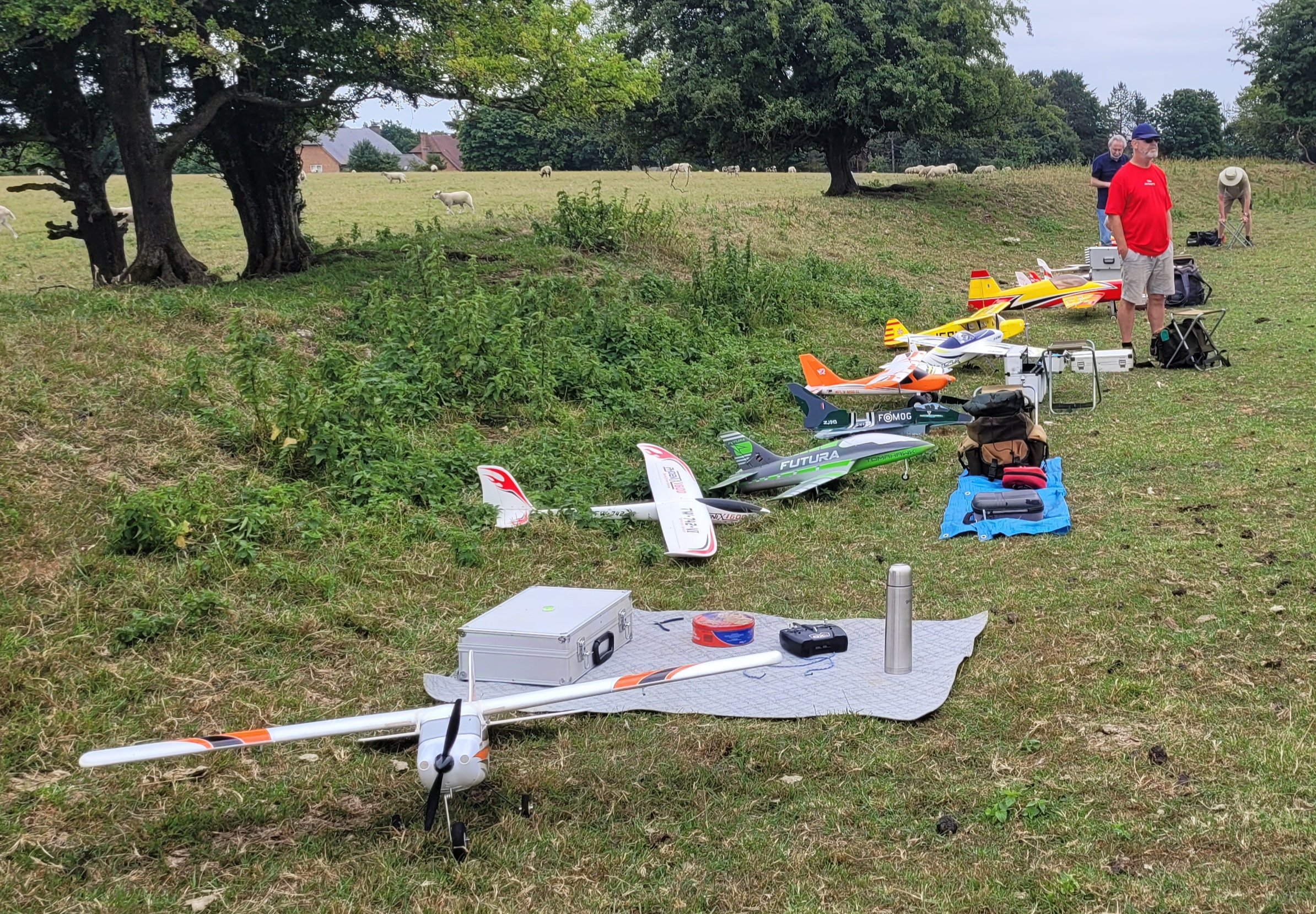 The bullocks have disappeared (to Sainsburys Taste the Difference I believe!) but several hundred sheep came and went a few times throughout June and left plenty of ‘presents’.
The bullocks have disappeared (to Sainsburys Taste the Difference I believe!) but several hundred sheep came and went a few times throughout June and left plenty of ‘presents’.
 We also saw the farmers doing educational trips for school children, bringing them up to the field in a trailer towed by a tractor. We didn’t have trips like that when I was at school!
With good weather in June a few new models appeared at the patch. First up was Catapult King who brought along two new models, one being a ready to fly ‘toy’, a Sky Viper Vector.
We also saw the farmers doing educational trips for school children, bringing them up to the field in a trailer towed by a tractor. We didn’t have trips like that when I was at school!
With good weather in June a few new models appeared at the patch. First up was Catapult King who brought along two new models, one being a ready to fly ‘toy’, a Sky Viper Vector.
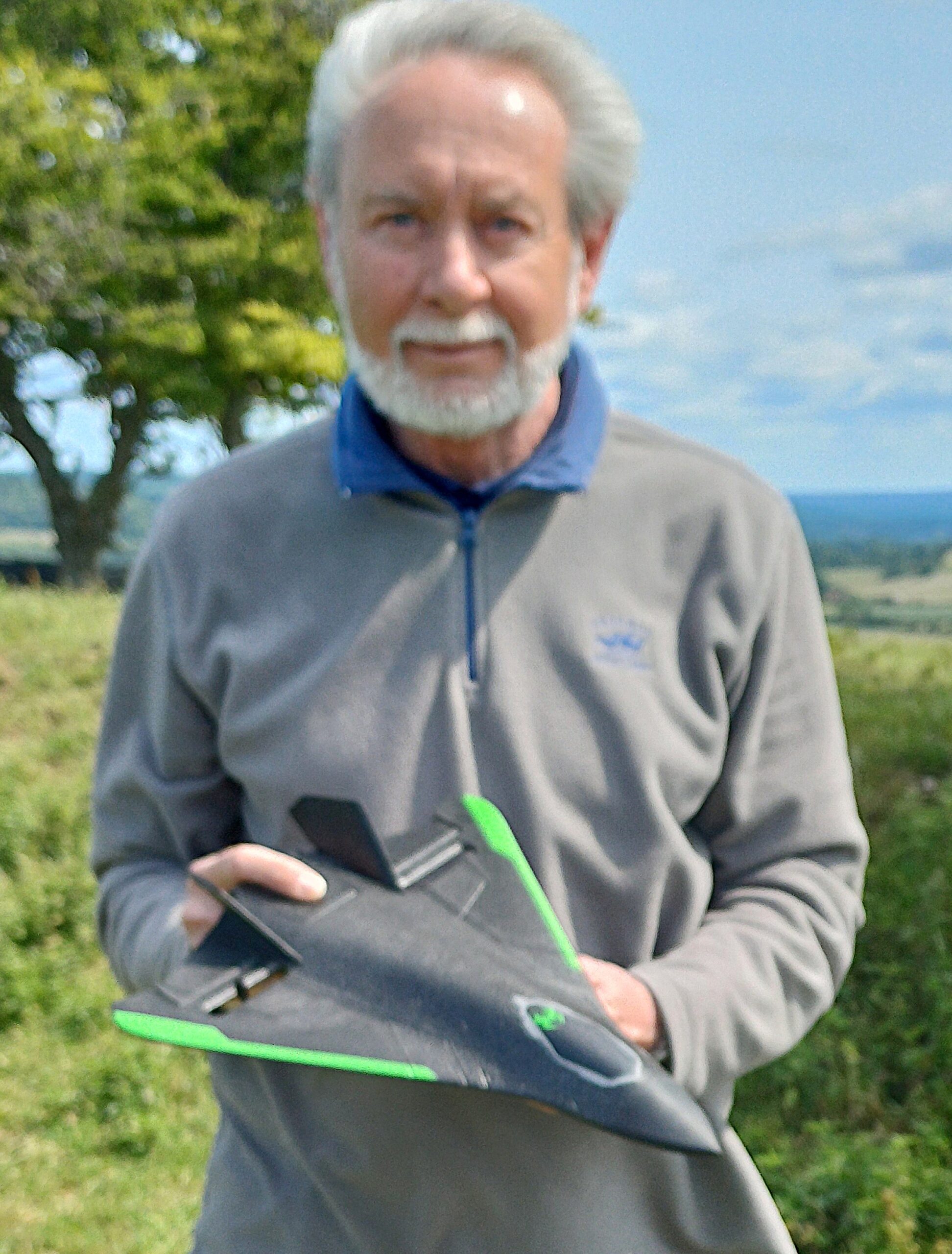 The Vector is the same as both Woody and Captain Slow got for Christmas and Woody has successfully flown his several times, but Captain Slow hasn’t rushed into flying his yet. It was a windy day when Catapult King flew his Viper but it handled the conditions well.
The Vector is the same as both Woody and Captain Slow got for Christmas and Woody has successfully flown his several times, but Captain Slow hasn’t rushed into flying his yet. It was a windy day when Catapult King flew his Viper but it handled the conditions well.
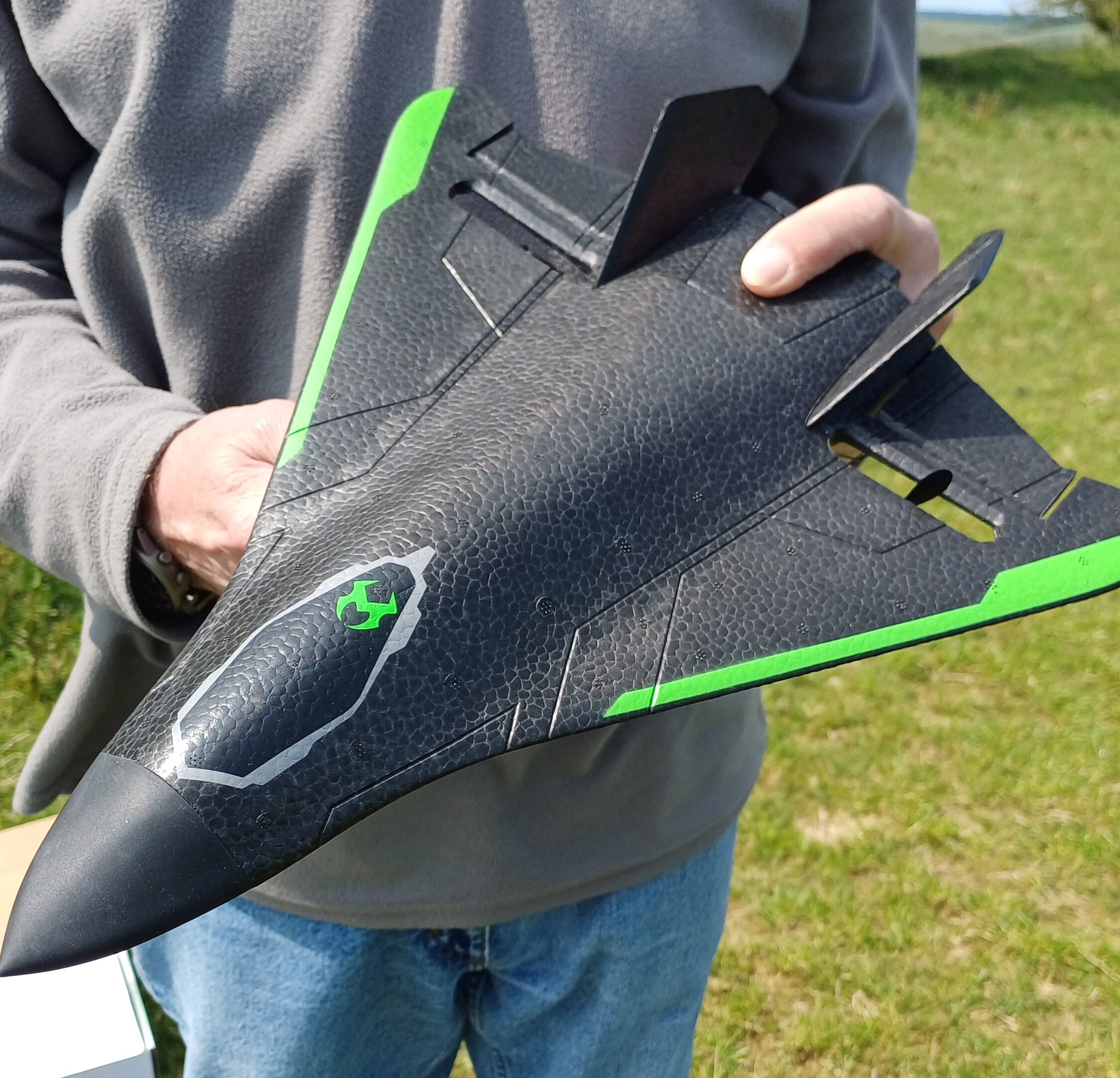 In the video you’ll see a big difference between the upwind and downwind speeds.
The second model that Catapult brought is much more interesting, it is a copy of an E-flite Pulse that he’s built from balsa, unlike an earlier Pulse copy that he’d built from Depron!
In the video you’ll see a big difference between the upwind and downwind speeds.
The second model that Catapult brought is much more interesting, it is a copy of an E-flite Pulse that he’s built from balsa, unlike an earlier Pulse copy that he’d built from Depron!
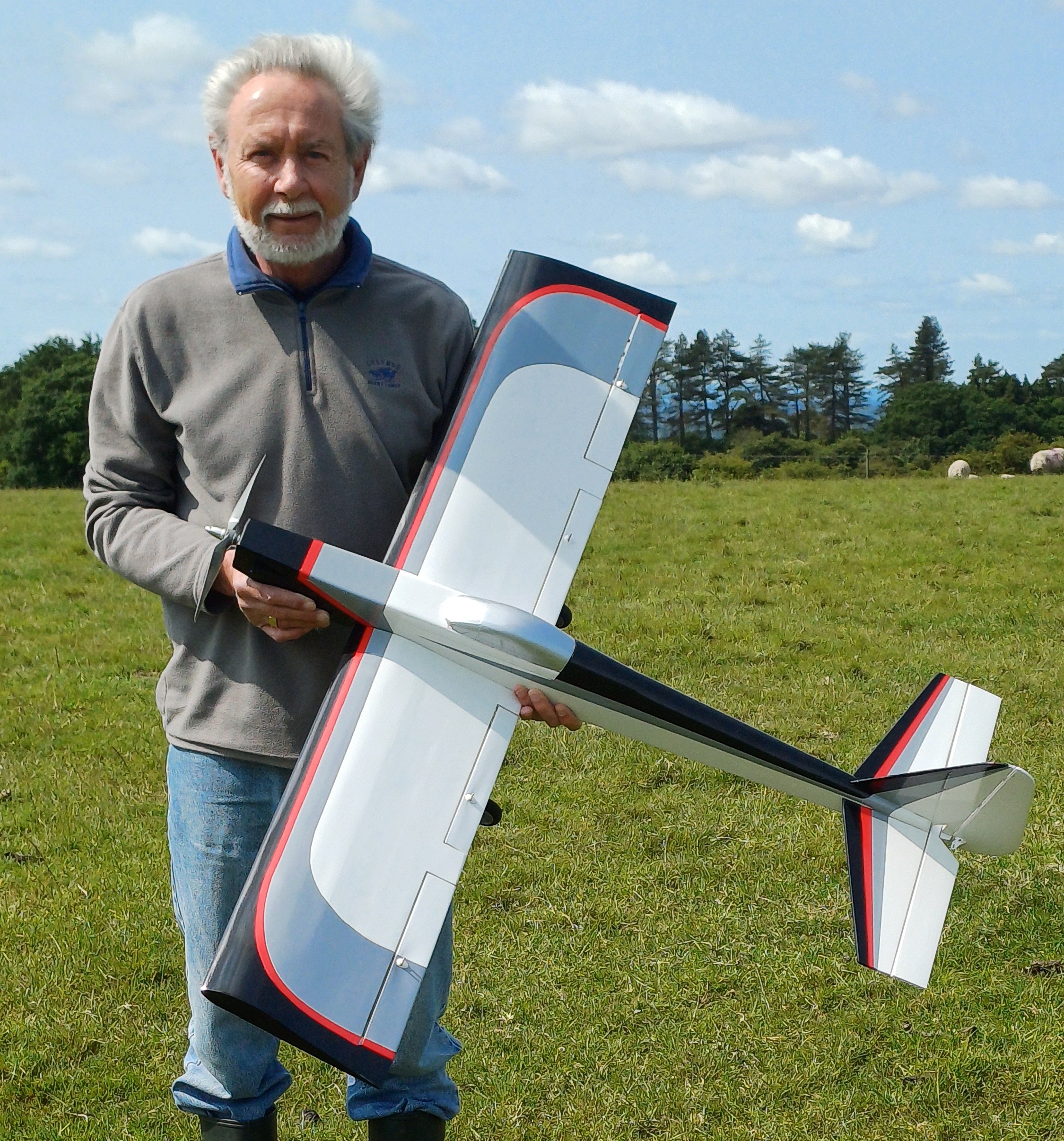 I asked Catapult for a few details: Amazingly this plane came in 200g lighter than the foam version so I used all the electrics from the old one. Good old HK900 servos for all control surfaces, Turnigy 4s 2650 battery, PropDrive 3530 900kv motor, HK 40amp ESC and a 10×6 APC prop (I think if all goes well this could go up to an 11×8).
I asked Catapult for a few details: Amazingly this plane came in 200g lighter than the foam version so I used all the electrics from the old one. Good old HK900 servos for all control surfaces, Turnigy 4s 2650 battery, PropDrive 3530 900kv motor, HK 40amp ESC and a 10×6 APC prop (I think if all goes well this could go up to an 11×8).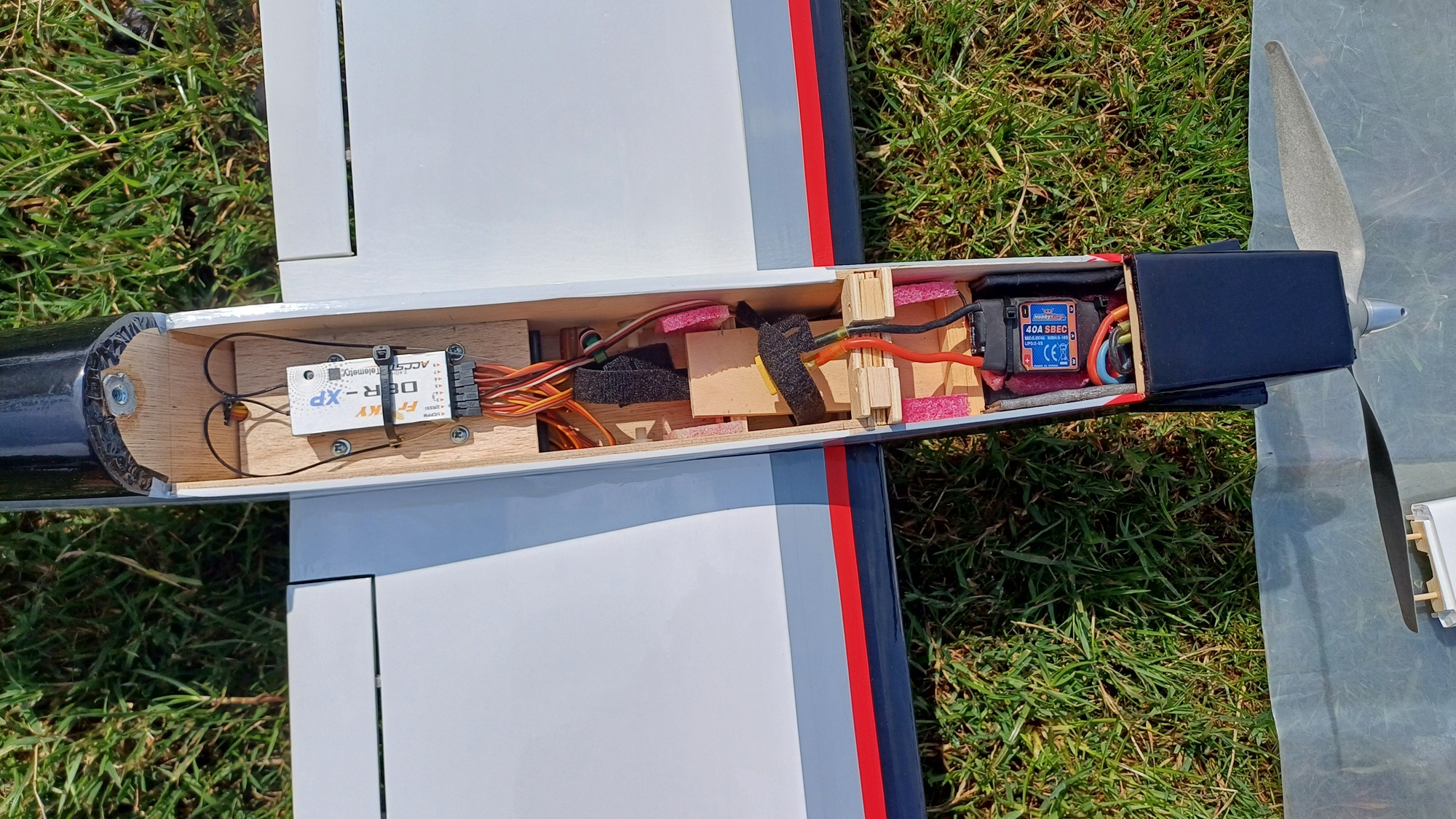 Catapult has made a lovely job of the model, and the quality of the covering, which is HobbyKing film, is amazing. He asked Dougal Entendre to do the maiden flight and this is what Dougal says about it: It took off OK, and was fine once I’d got sufficient down trim in. However, I commented that it looked like the wing was flexing a bit, and it seemed to have more dihedral than when it took off! It also dug in on a couple of turns, so I refrained from doing any aerobatics and got it down fairly sharpish.
Catapult has made a lovely job of the model, and the quality of the covering, which is HobbyKing film, is amazing. He asked Dougal Entendre to do the maiden flight and this is what Dougal says about it: It took off OK, and was fine once I’d got sufficient down trim in. However, I commented that it looked like the wing was flexing a bit, and it seemed to have more dihedral than when it took off! It also dug in on a couple of turns, so I refrained from doing any aerobatics and got it down fairly sharpish.
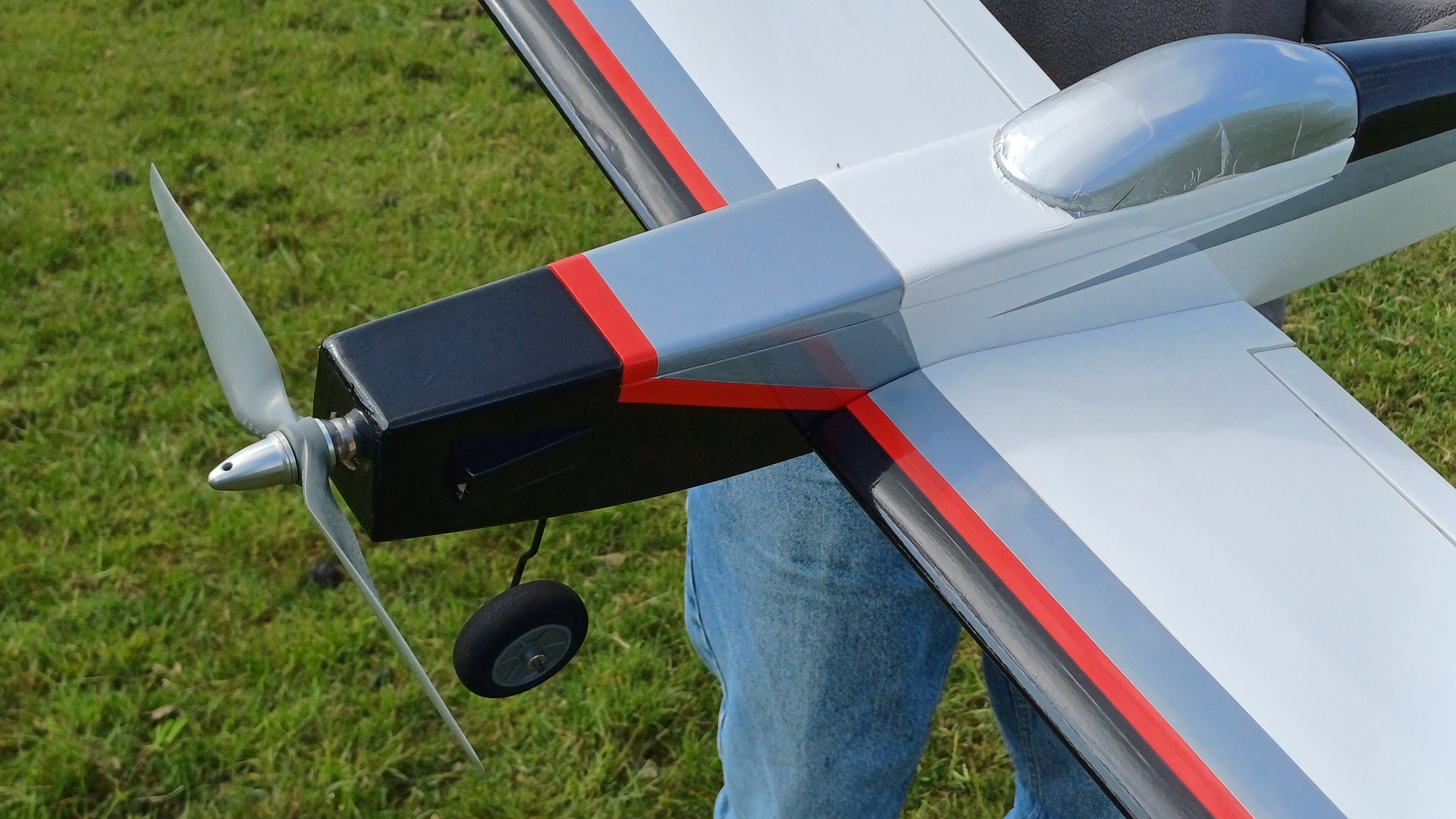 I asked Catapult if he’d found and cured the problem, this is his reply: I had had my concerns about the flex in the wing joints but stayed with it as I thought the dihedral looked more pleasing. However, as Dougal says one gust on the day and it was obvious they were not going to hold very long. It was just as well he landed as on inspecting the wings the original carbon tube had actually split inside the fuselage area. To fix this I cut an old aluminium arrow in half, filed a ‘V’ shape in one end, and then with one end in a drill and the other being guided by the carbon tube (and with a lot of trepidation) I literally drilled the arrow into the wing about three quarters of the way. Unfortunately I didn’t take any pictures. The wing itself though feels very solid.
The next part was the join in the fuselage. I filled the old angled tubes with epoxy (let it cure) and then drilled a new hole directly through the original openings. Finding a carbon rod which fitted the inside of the arrows I then drilled out the original carbon tube from inside the arrows with the longest drill I had, even more scary than before. This goes about as far as the second rib in each wing. Refitting the wings already feels much better than before, but I still need to rework the first rib in each wing from angled to flat against the fuse. Then I think we’ll be ready for a proper test flight. Watch this space. Sadly nobody filmed the test flight so we’ll have to wait for test flight number two.
Not content with putting together his HobbyKing Voltigeur last month, 1066 has also started building another one to add to his collection: Having stumbled across a build video of the Angelwing Blink V2 I decided to take a look at the Angelwing website.
I asked Catapult if he’d found and cured the problem, this is his reply: I had had my concerns about the flex in the wing joints but stayed with it as I thought the dihedral looked more pleasing. However, as Dougal says one gust on the day and it was obvious they were not going to hold very long. It was just as well he landed as on inspecting the wings the original carbon tube had actually split inside the fuselage area. To fix this I cut an old aluminium arrow in half, filed a ‘V’ shape in one end, and then with one end in a drill and the other being guided by the carbon tube (and with a lot of trepidation) I literally drilled the arrow into the wing about three quarters of the way. Unfortunately I didn’t take any pictures. The wing itself though feels very solid.
The next part was the join in the fuselage. I filled the old angled tubes with epoxy (let it cure) and then drilled a new hole directly through the original openings. Finding a carbon rod which fitted the inside of the arrows I then drilled out the original carbon tube from inside the arrows with the longest drill I had, even more scary than before. This goes about as far as the second rib in each wing. Refitting the wings already feels much better than before, but I still need to rework the first rib in each wing from angled to flat against the fuse. Then I think we’ll be ready for a proper test flight. Watch this space. Sadly nobody filmed the test flight so we’ll have to wait for test flight number two.
Not content with putting together his HobbyKing Voltigeur last month, 1066 has also started building another one to add to his collection: Having stumbled across a build video of the Angelwing Blink V2 I decided to take a look at the Angelwing website.
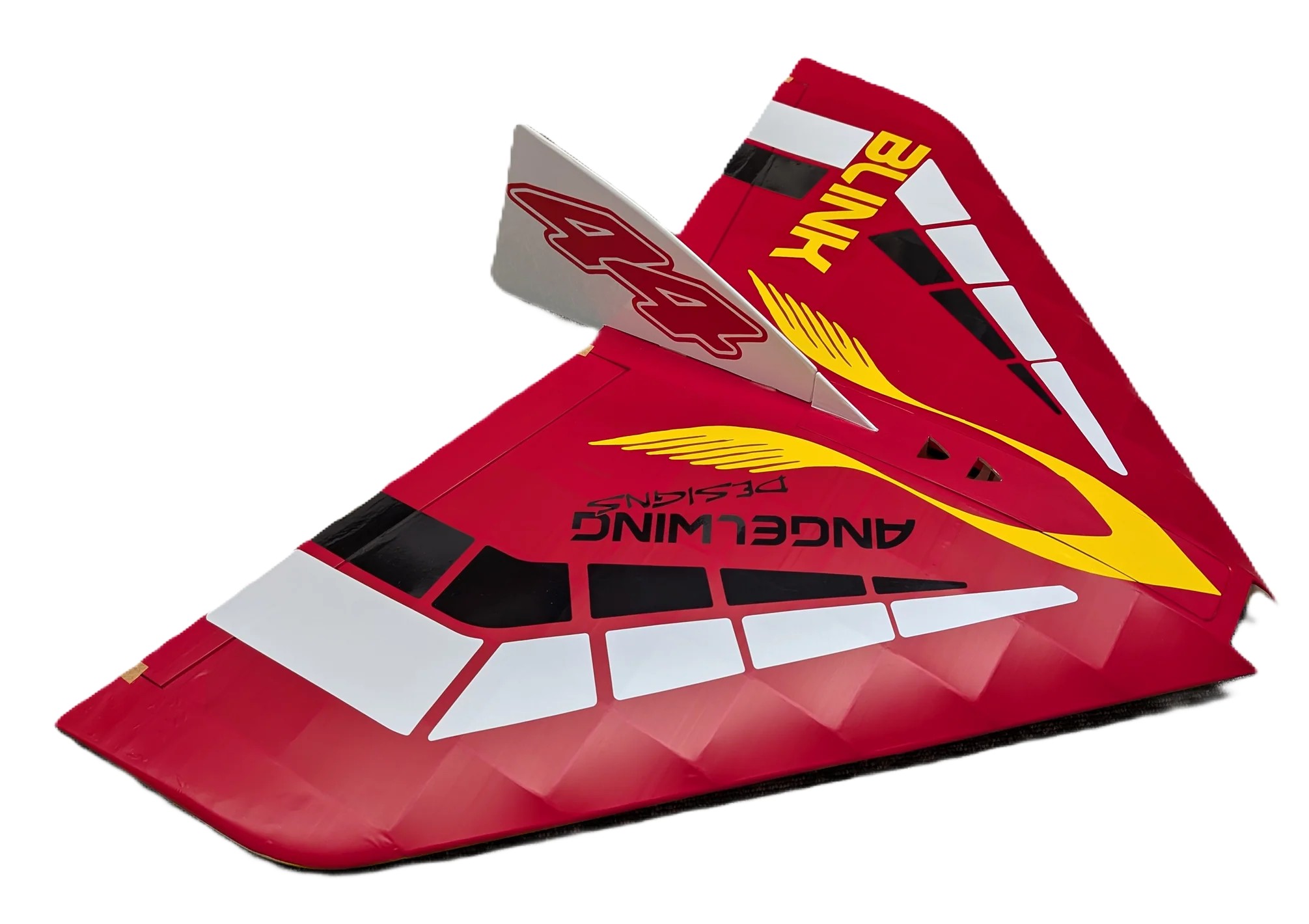 The Blink looked like an interesting and easy build, and for £60 delivered was not so expensive, so after putting one in my basket I ummed and ahhed for a couple of weeks before hitting the buy button. The kit arrived a couple of days later, wow the boxes seem to get smaller and smaller! For £60.00 you don’t get a lot, not even a plan or instructions, these have to be downloaded as a PDF, however they are really good, I’m assuming they are taken from the CAD drawings used in the design process.
The Blink looked like an interesting and easy build, and for £60 delivered was not so expensive, so after putting one in my basket I ummed and ahhed for a couple of weeks before hitting the buy button. The kit arrived a couple of days later, wow the boxes seem to get smaller and smaller! For £60.00 you don’t get a lot, not even a plan or instructions, these have to be downloaded as a PDF, however they are really good, I’m assuming they are taken from the CAD drawings used in the design process.
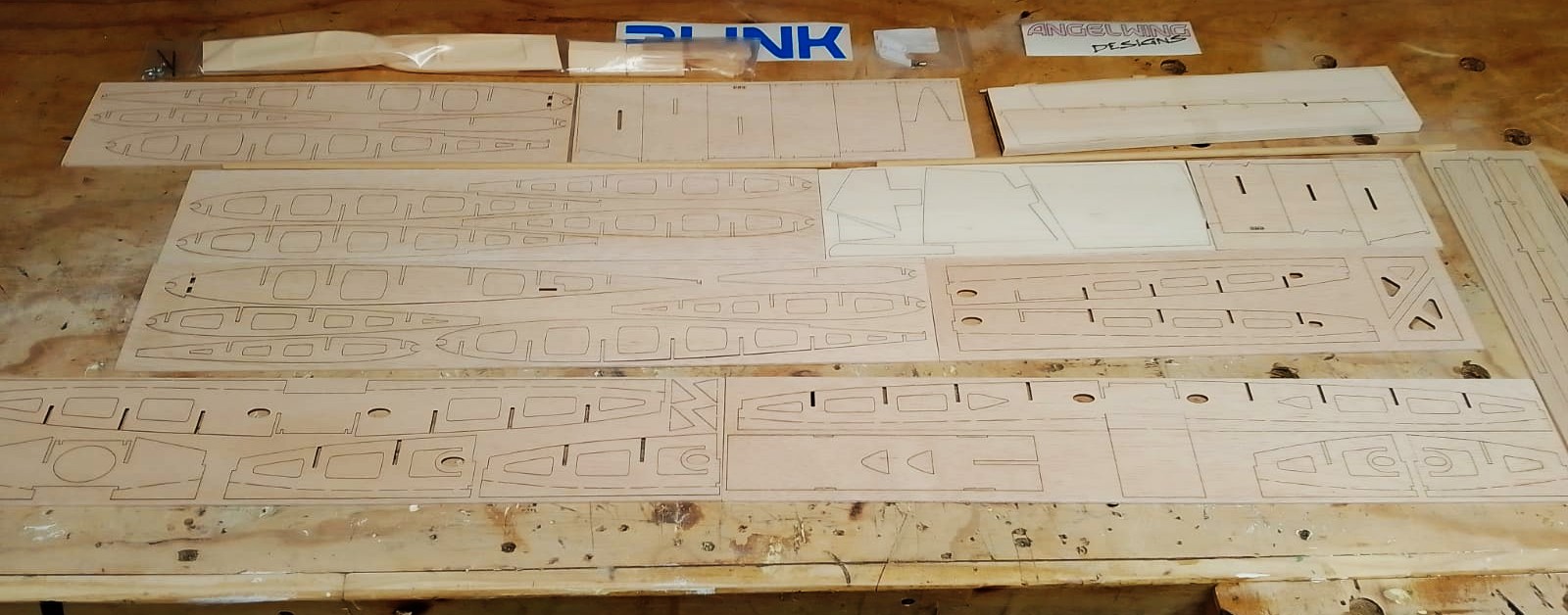
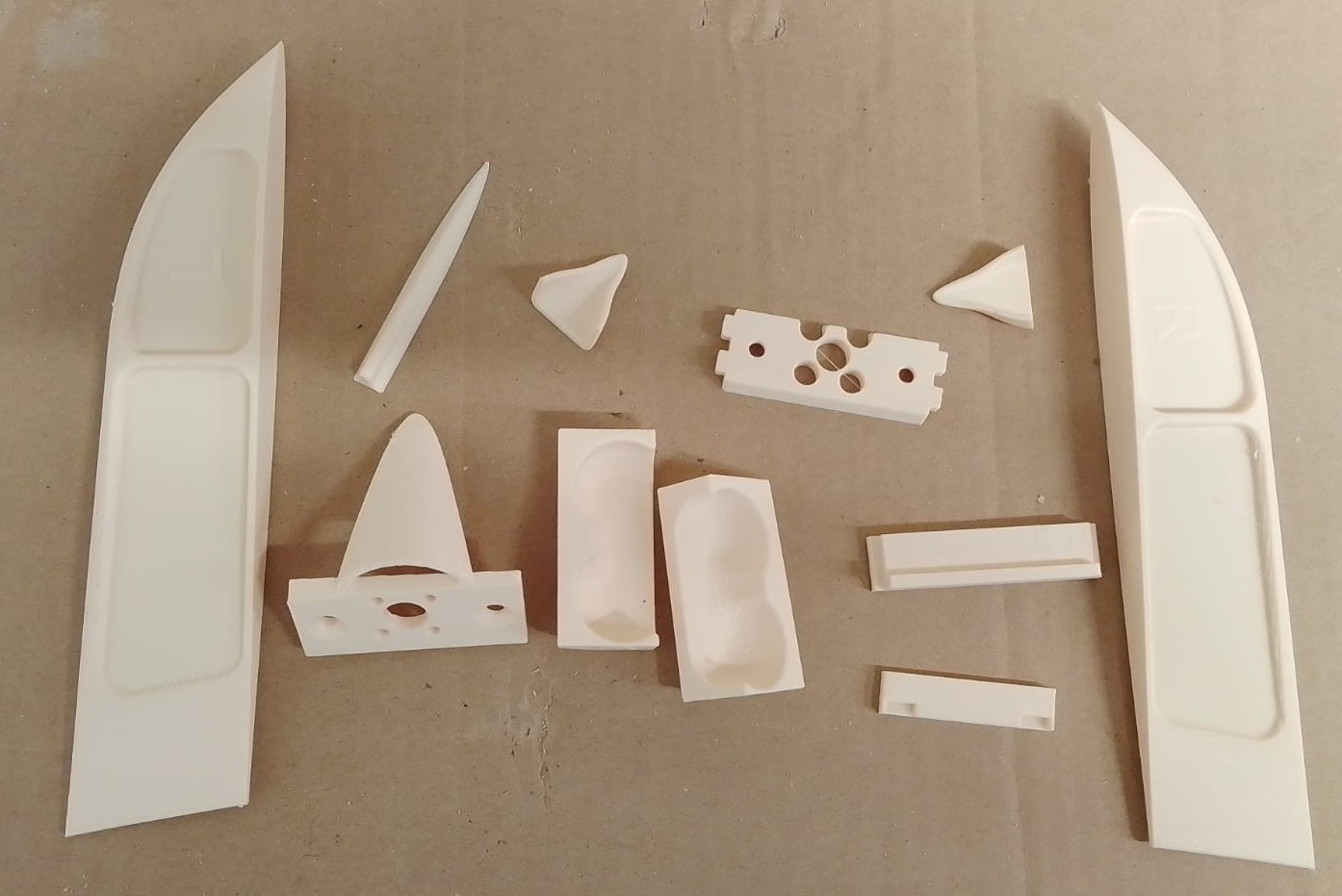 What you do get is a bunch of laser cut sheets of balsa, and a bag of 3D printed parts which includes the motor mount, wing tips, finger holds, rear hatch support, plus a couple of bits I’m not sure about yet. The laser cutting is some of the best I’ve seen, with some of the parts falling from the sheets just taking them out of the box. However when I started building there was one sheet where the laser hadn’t quite penetrated so a knife was required and I did break a few bits on the grain, mainly at the leading edge.
What you do get is a bunch of laser cut sheets of balsa, and a bag of 3D printed parts which includes the motor mount, wing tips, finger holds, rear hatch support, plus a couple of bits I’m not sure about yet. The laser cutting is some of the best I’ve seen, with some of the parts falling from the sheets just taking them out of the box. However when I started building there was one sheet where the laser hadn’t quite penetrated so a knife was required and I did break a few bits on the grain, mainly at the leading edge.
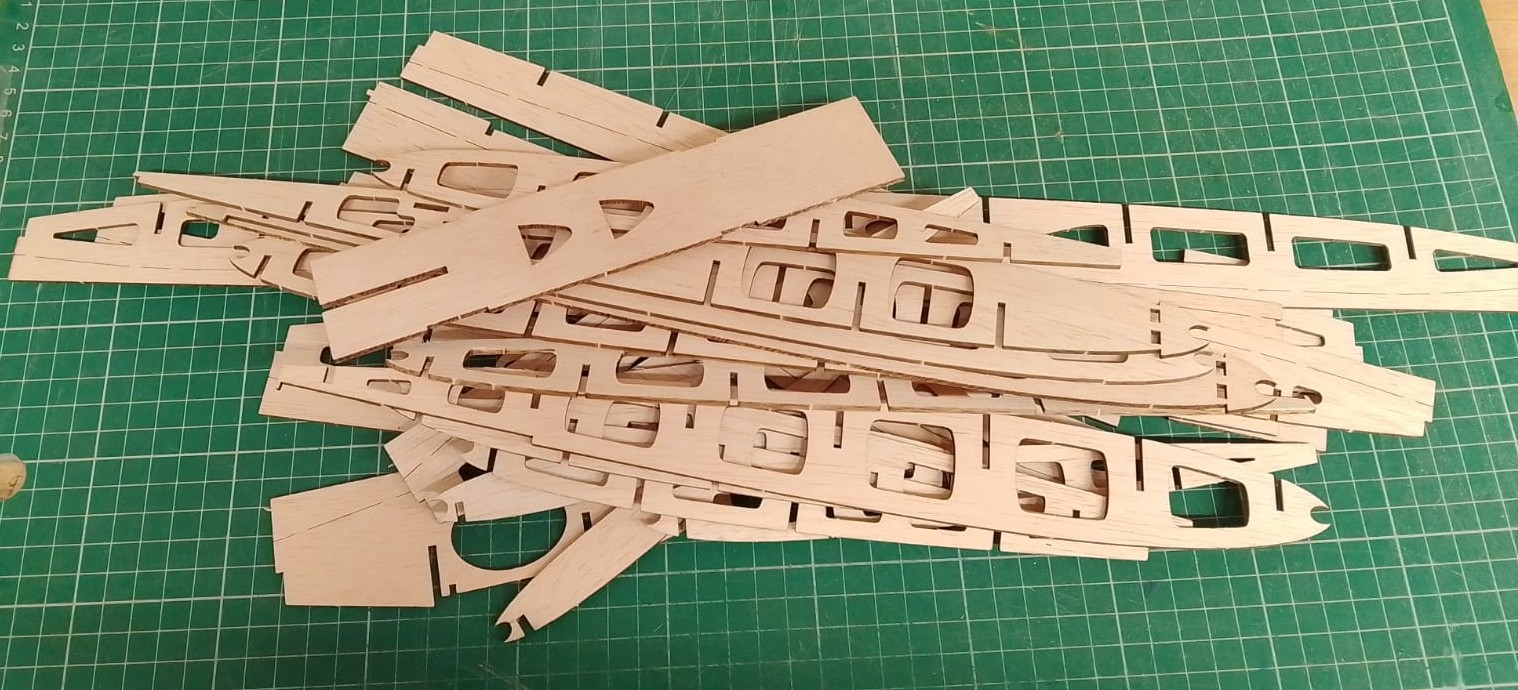 Now I don’t know about you lot, but my old lady is always nagging me about not reading instructions, so why break the habit of a lifetime, besides, I had looked at all the lovely pictures! When I build this sort of kit I like to remove all the parts from their respective sheets first, OK so far, but what I hadn’t noticed was that all the spar components have built in sacrificial jigging so, anyone like to guess how many jigging parts had to be rescued from the bin and be stuck back on, before I realised my mistake?
Now I don’t know about you lot, but my old lady is always nagging me about not reading instructions, so why break the habit of a lifetime, besides, I had looked at all the lovely pictures! When I build this sort of kit I like to remove all the parts from their respective sheets first, OK so far, but what I hadn’t noticed was that all the spar components have built in sacrificial jigging so, anyone like to guess how many jigging parts had to be rescued from the bin and be stuck back on, before I realised my mistake?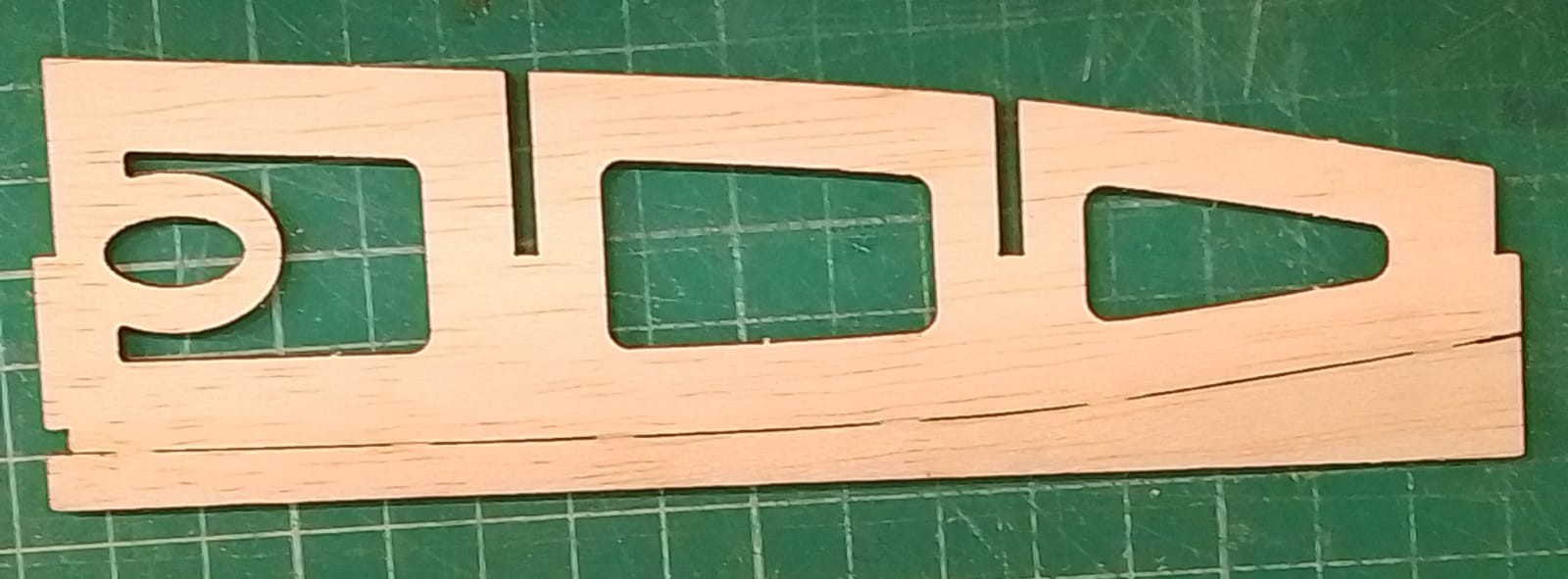
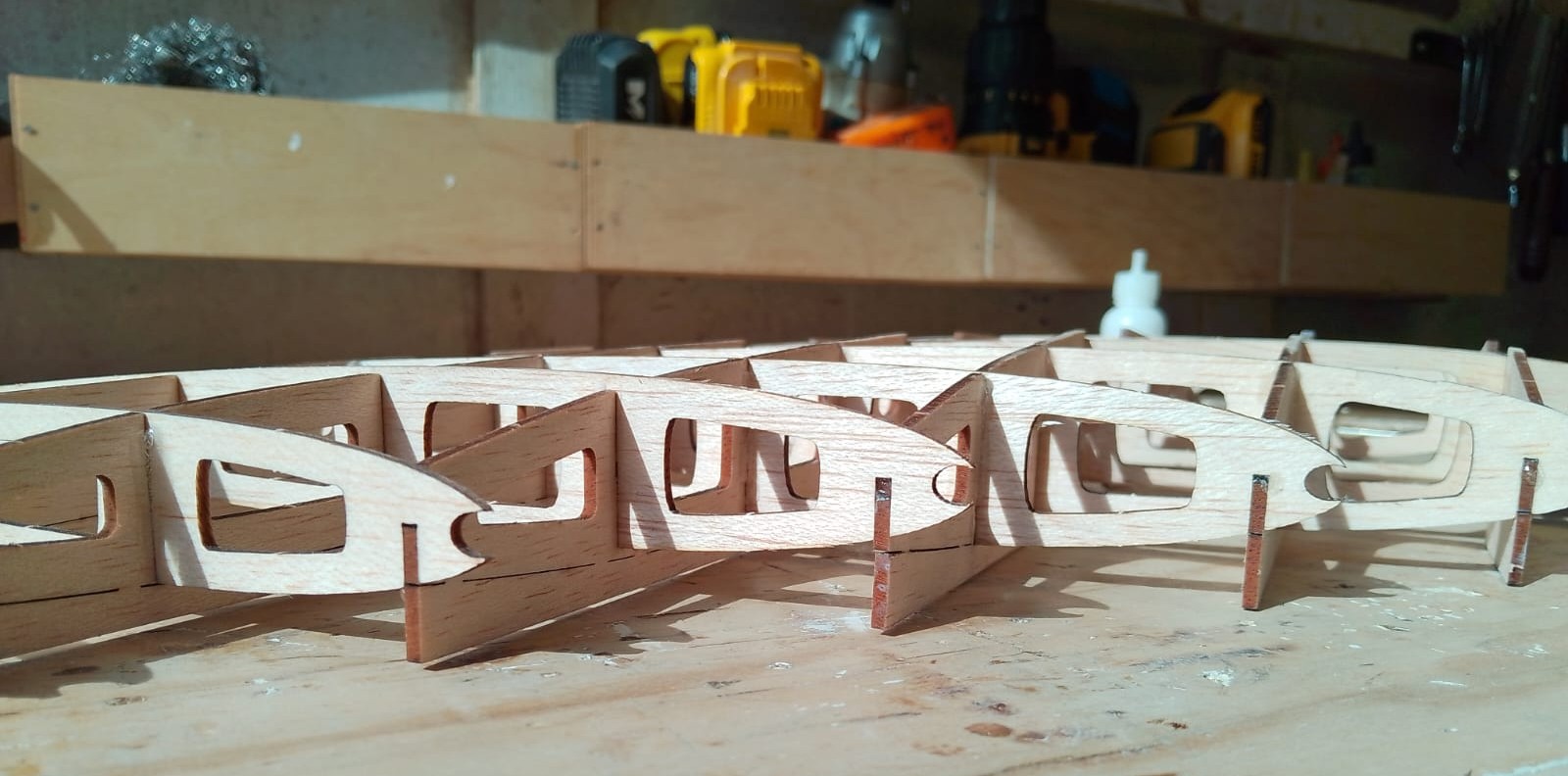 The accuracy of the laser cutting, and the self-jigging design means the model goes together very quickly, I opted to use wood glue in all the slots, backed up with dots of super glue to act as pins while the wood glue dries. Having dry assembled 75% of the wing to check it went together before committing to glue it became very apparent this was a very stable structure, so if I had some very thin glue available, I would have probably slotted it all together dry, then run the glue in. My thoughts so far, well the quality is fantastic, but the model is quite a bit smaller than I thought, so is it good value? So far I think it is, even if I could cut balsa to the accuracy the laser can, it would take days, and it’s very obvious the manufacturer has put a lot of effort into the design.
The accuracy of the laser cutting, and the self-jigging design means the model goes together very quickly, I opted to use wood glue in all the slots, backed up with dots of super glue to act as pins while the wood glue dries. Having dry assembled 75% of the wing to check it went together before committing to glue it became very apparent this was a very stable structure, so if I had some very thin glue available, I would have probably slotted it all together dry, then run the glue in. My thoughts so far, well the quality is fantastic, but the model is quite a bit smaller than I thought, so is it good value? So far I think it is, even if I could cut balsa to the accuracy the laser can, it would take days, and it’s very obvious the manufacturer has put a lot of effort into the design.
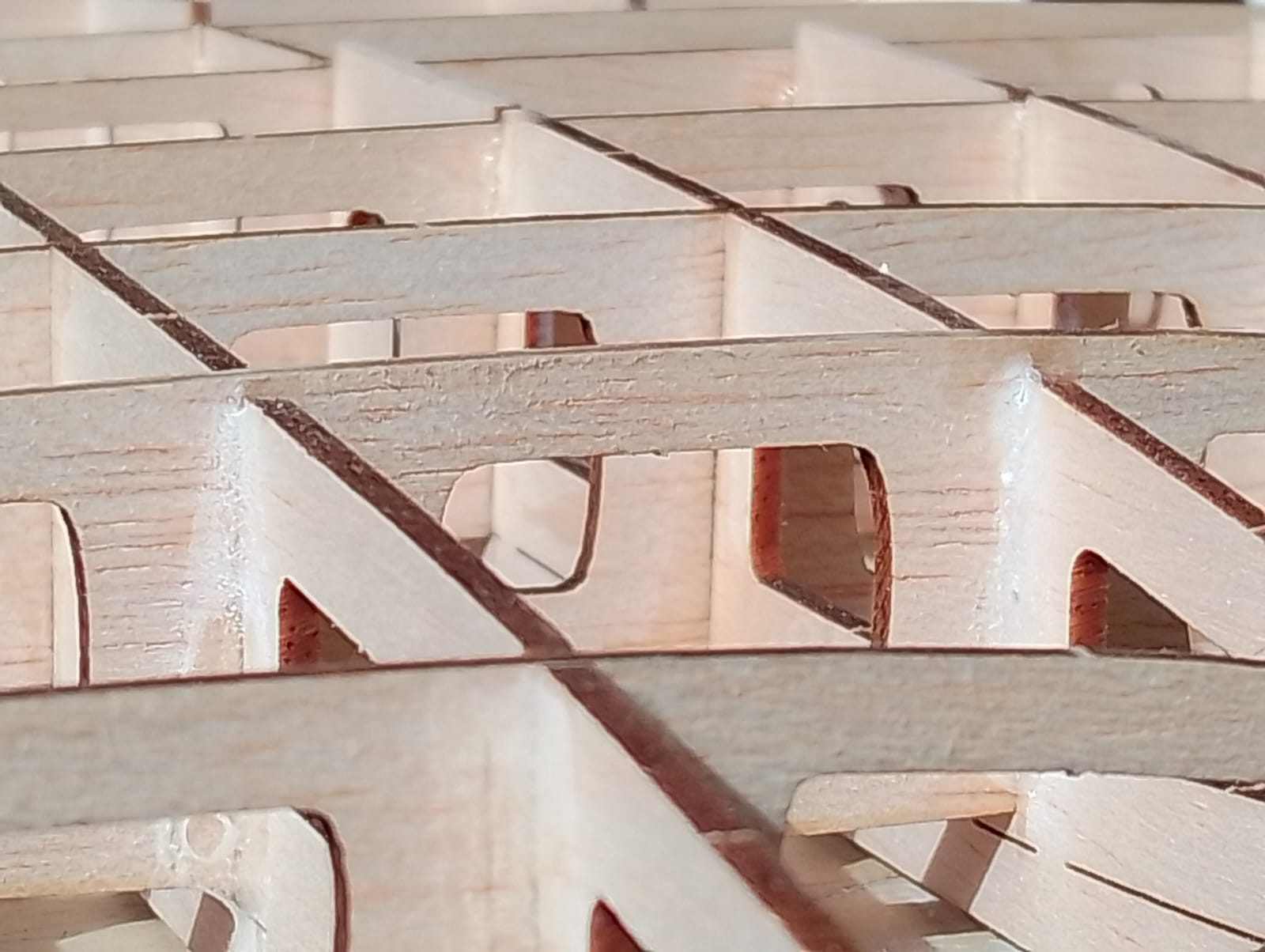
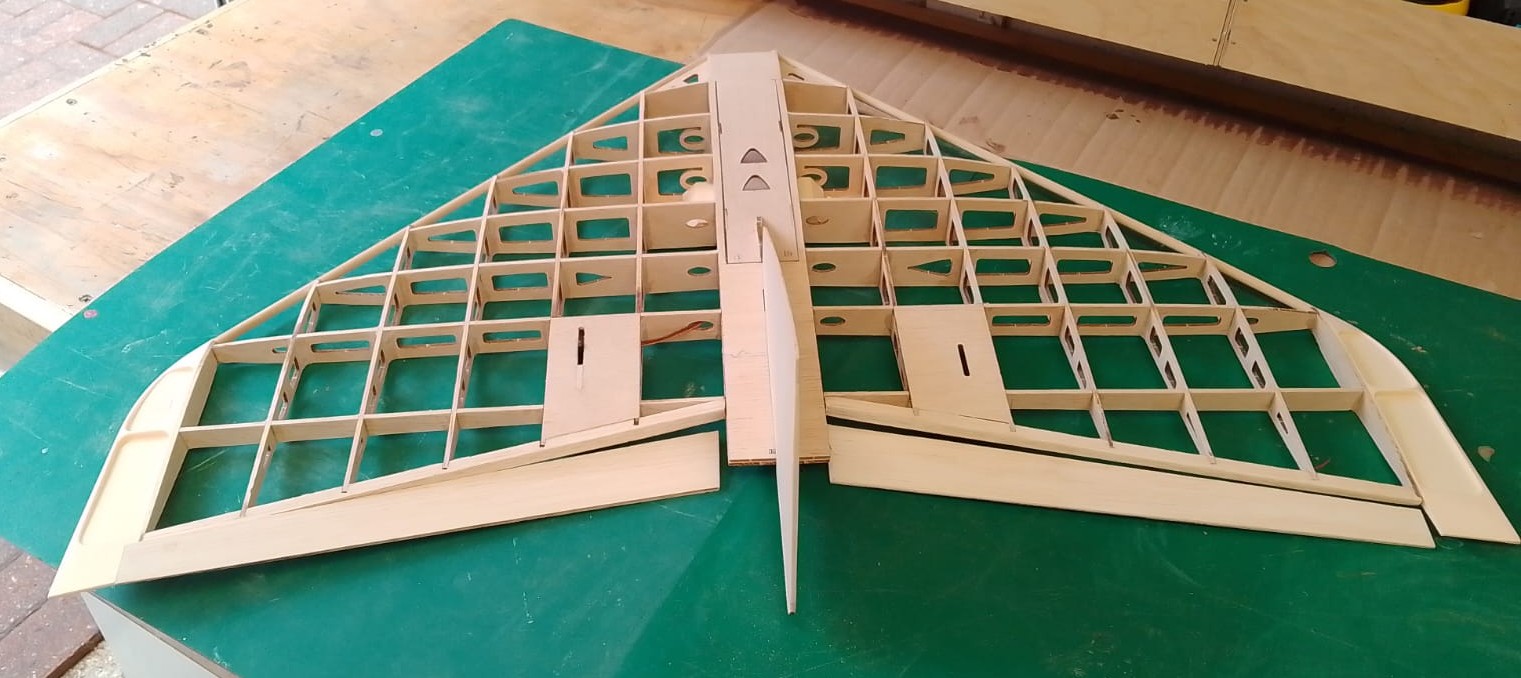 Let’s hope it fly’s as well as it is going together. Thanks 1066, looking forward to it flying.
Dwayne Pipe will be running the club Annual Chuck Glider Competition at 7.30pm on Wednesday 9th July. It will be held at the Buriton playing fields rather than our patch as it will hopefully be less windy and won’t involve a half mile retrieval after every flight! Dwayne has set an alternative date of 16th July if the weather is bad but I can’t make the 16th so I say we’re having the comp on the 9th even if it’s pouring with rain and blowing a gale! There will be two classes, normal chuck glider, and catapult launched glider, with the catapult being provided by Dwayne. It’s always a fun evening so come along and join in.
Let’s hope it fly’s as well as it is going together. Thanks 1066, looking forward to it flying.
Dwayne Pipe will be running the club Annual Chuck Glider Competition at 7.30pm on Wednesday 9th July. It will be held at the Buriton playing fields rather than our patch as it will hopefully be less windy and won’t involve a half mile retrieval after every flight! Dwayne has set an alternative date of 16th July if the weather is bad but I can’t make the 16th so I say we’re having the comp on the 9th even if it’s pouring with rain and blowing a gale! There will be two classes, normal chuck glider, and catapult launched glider, with the catapult being provided by Dwayne. It’s always a fun evening so come along and join in.
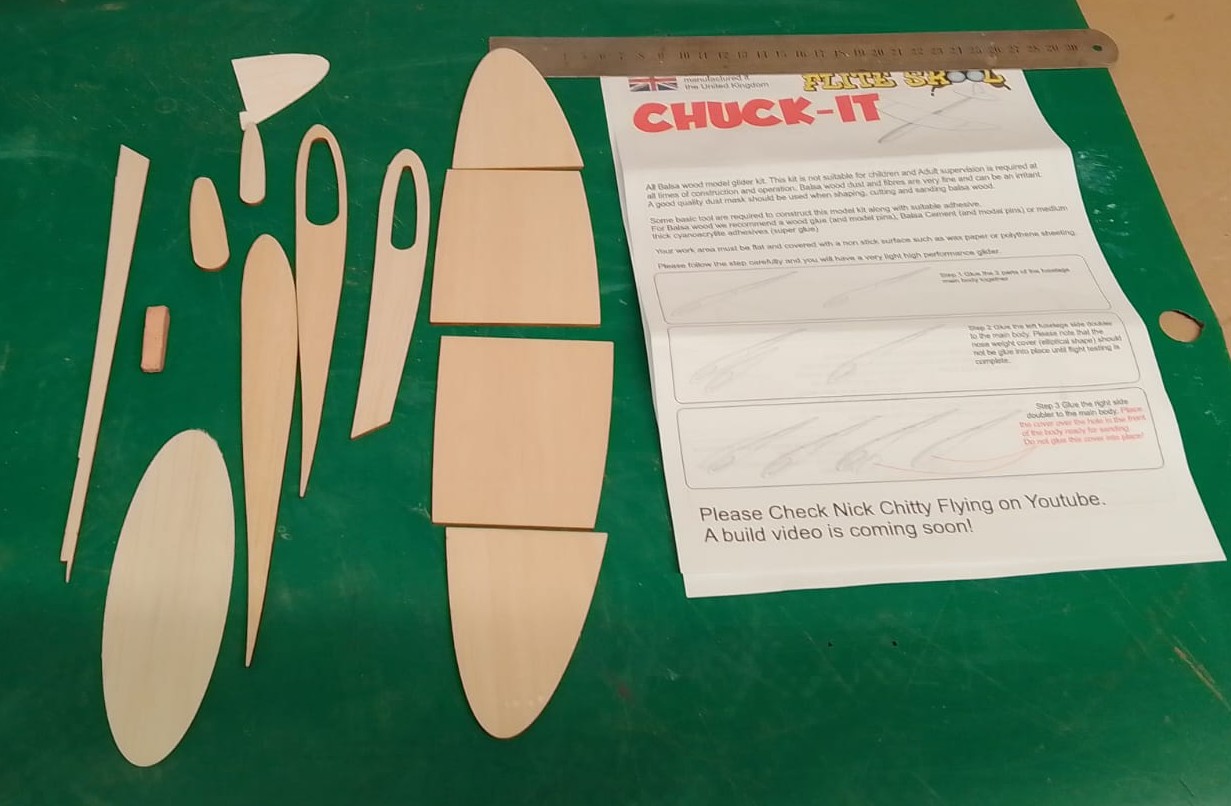 1066 has never taken part in the chuck glider comp but this year he’s got one on the building board and says he intends to be there and win the trophy. He even sent me a photo of the kit he’s building so we know exactly what we’ll be up against.
Dougal Entendre has been busy getting a Sportster that was a second-hand purchase ready for flight, here’s his report: Back when we had the club auction for John Bourne’s planes, there were no takers for his large Sportster. The airframe had to go somewhere, so I paid the club a tenner and had it decorating the ceiling in my hangar.
1066 has never taken part in the chuck glider comp but this year he’s got one on the building board and says he intends to be there and win the trophy. He even sent me a photo of the kit he’s building so we know exactly what we’ll be up against.
Dougal Entendre has been busy getting a Sportster that was a second-hand purchase ready for flight, here’s his report: Back when we had the club auction for John Bourne’s planes, there were no takers for his large Sportster. The airframe had to go somewhere, so I paid the club a tenner and had it decorating the ceiling in my hangar.
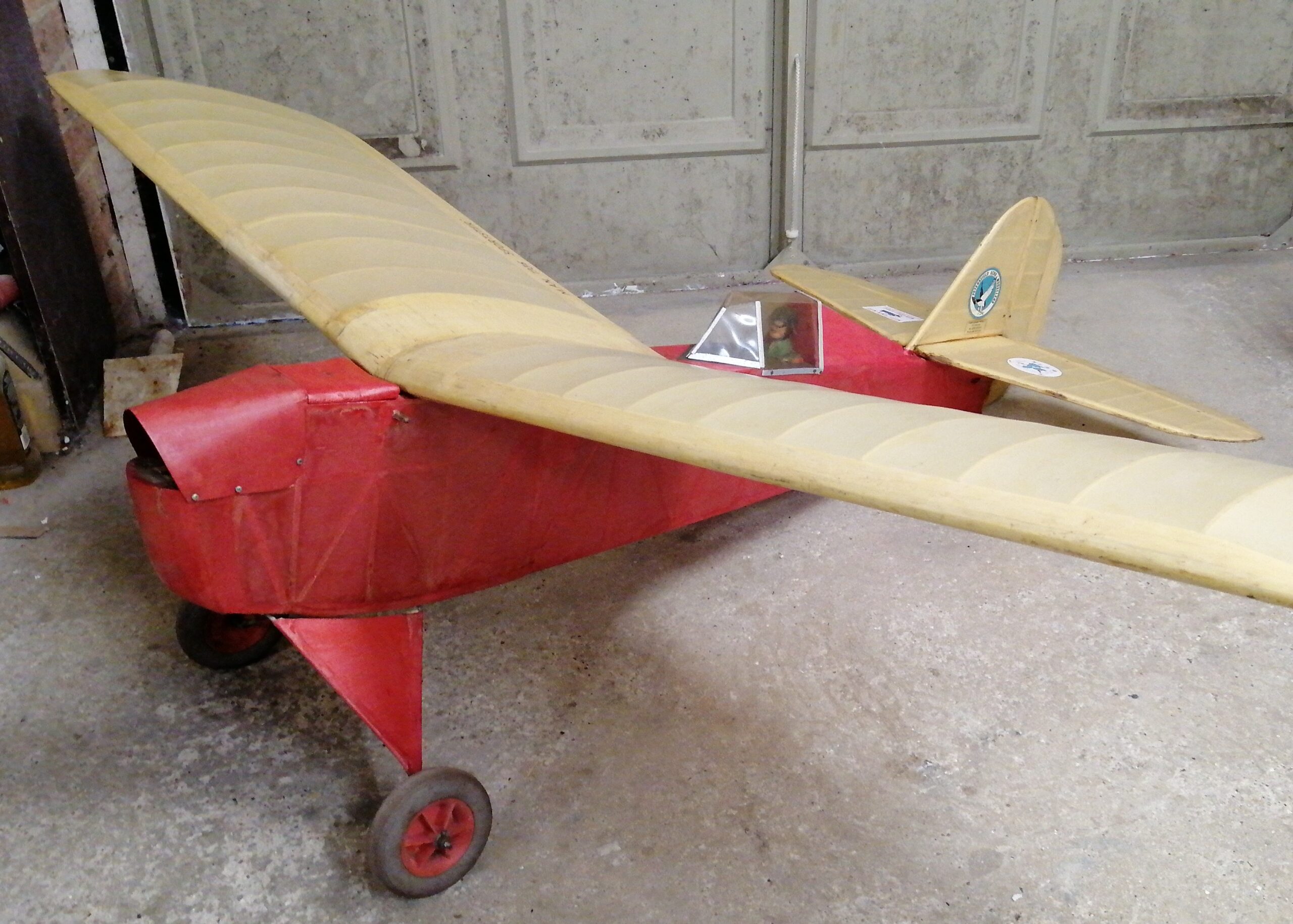
 A few weeks ago I added a motor and ESC, and took it to the patch. 1066 said that I was unlikely to get my usual adrenaline fix from it, but it turned out to be quite eventful!
A few weeks ago I added a motor and ESC, and took it to the patch. 1066 said that I was unlikely to get my usual adrenaline fix from it, but it turned out to be quite eventful!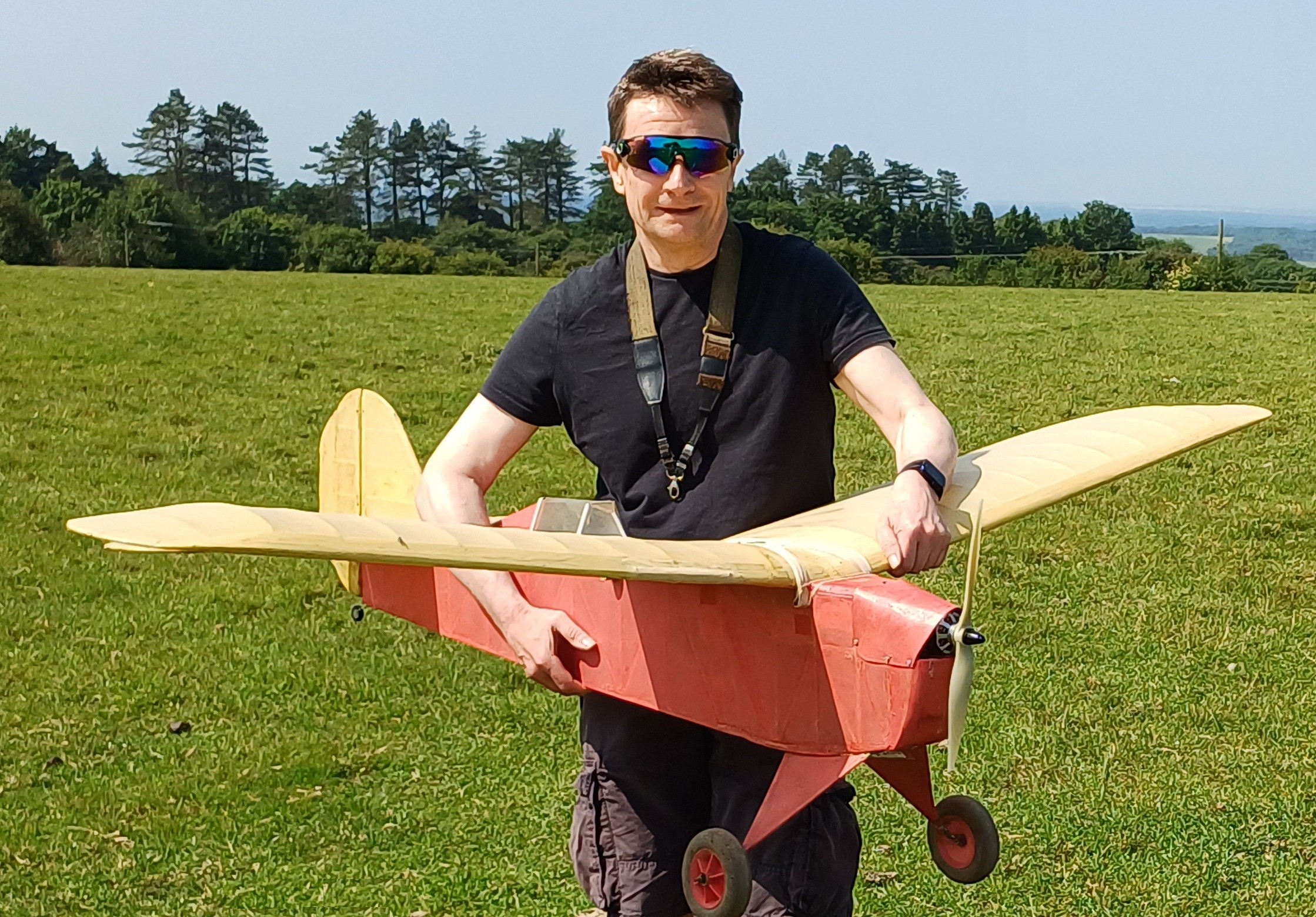
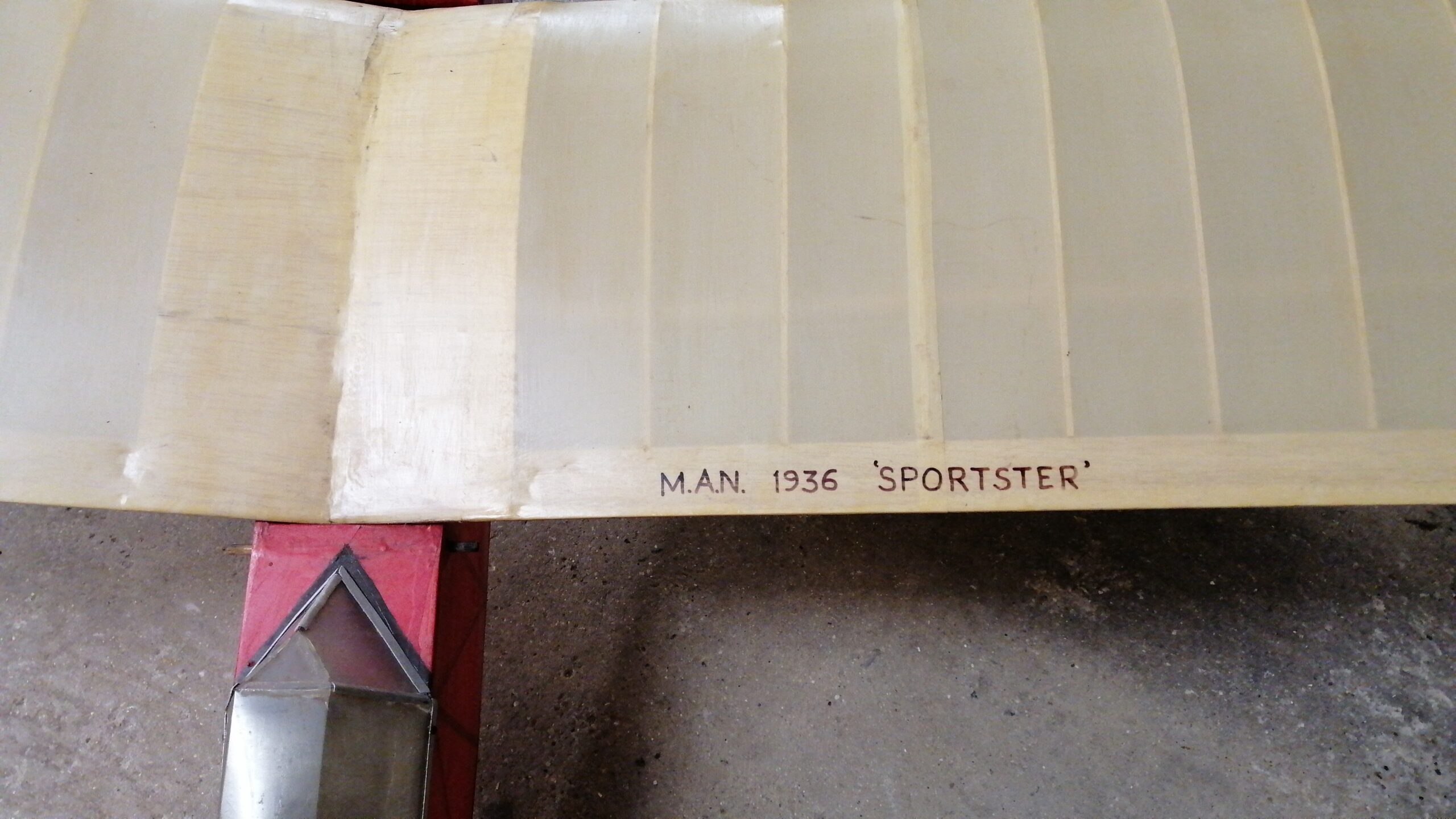 To backtrack; it’s a 1936 design from Model Aircraft News, about 73″ span, and the plan is available on Outerzone. It was beautifully built and covered in what I think is Solartex, with just rudder and elevator controls. It’s got John Bourne’s phone number on it from before it changed to an 01 dialling code, so that dates the airframe to before 1995!
To backtrack; it’s a 1936 design from Model Aircraft News, about 73″ span, and the plan is available on Outerzone. It was beautifully built and covered in what I think is Solartex, with just rudder and elevator controls. It’s got John Bourne’s phone number on it from before it changed to an 01 dialling code, so that dates the airframe to before 1995!
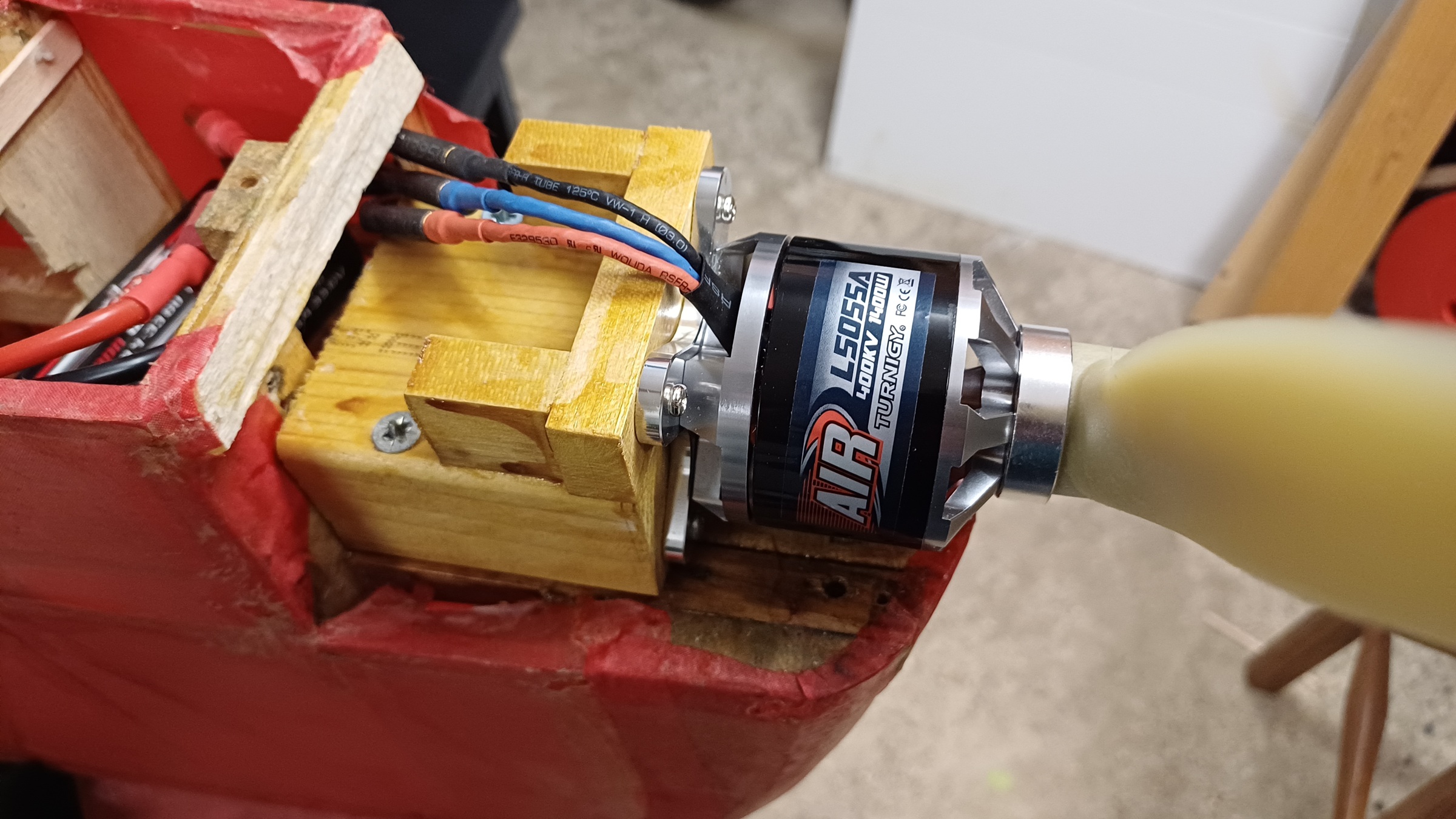 I added a 5055 400kV motor, 80A ESC and a 13 inch prop, with a 6s 5000mAh pack from my Velox. On take-off, it was immediately apparent that it had plenty of power, but needed nearly full down trim. The rudder was powerful, but the plane had a tendency to wallow from side to side, which can be seen in the video. I think it’s due to all the dihedral and the short moment arm. After 5 minutes I landed, flipping it over in the wind, but no damage. Remaining battery capacity: 85%!
I added a 5055 400kV motor, 80A ESC and a 13 inch prop, with a 6s 5000mAh pack from my Velox. On take-off, it was immediately apparent that it had plenty of power, but needed nearly full down trim. The rudder was powerful, but the plane had a tendency to wallow from side to side, which can be seen in the video. I think it’s due to all the dihedral and the short moment arm. After 5 minutes I landed, flipping it over in the wind, but no damage. Remaining battery capacity: 85%!
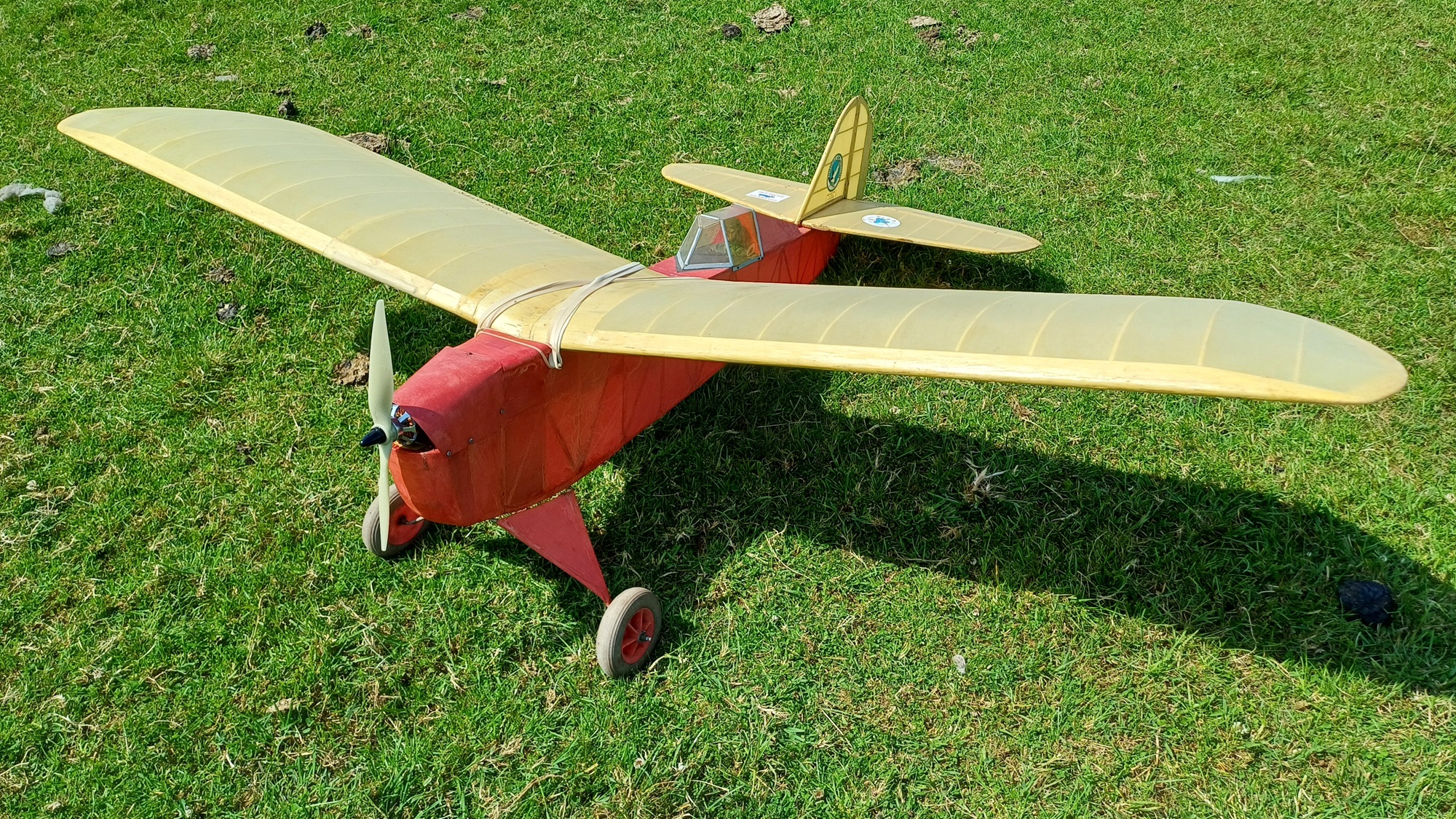 After winding in a load of down elevator I flew it again. After a minute or two I dared to try a loop, but got very violent tail flutter as it pulled out. I throttled back quickly and found I had no elevator control. I turned round using rudder and braced for disaster, but in the event it landed downwind about half way across the field, and didn’t even flip over! On inspecting the damage, I found the elevator control horn had broken off, and the violent flutter had broken the tailplane in the middle (the Solartex held it together well enough for the landing!). I’m not sure what to do now. I could strengthen the tail and move the elevator servo down to the back of the fuselage to eliminate pushrod flex.
After winding in a load of down elevator I flew it again. After a minute or two I dared to try a loop, but got very violent tail flutter as it pulled out. I throttled back quickly and found I had no elevator control. I turned round using rudder and braced for disaster, but in the event it landed downwind about half way across the field, and didn’t even flip over! On inspecting the damage, I found the elevator control horn had broken off, and the violent flutter had broken the tailplane in the middle (the Solartex held it together well enough for the landing!). I’m not sure what to do now. I could strengthen the tail and move the elevator servo down to the back of the fuselage to eliminate pushrod flex.
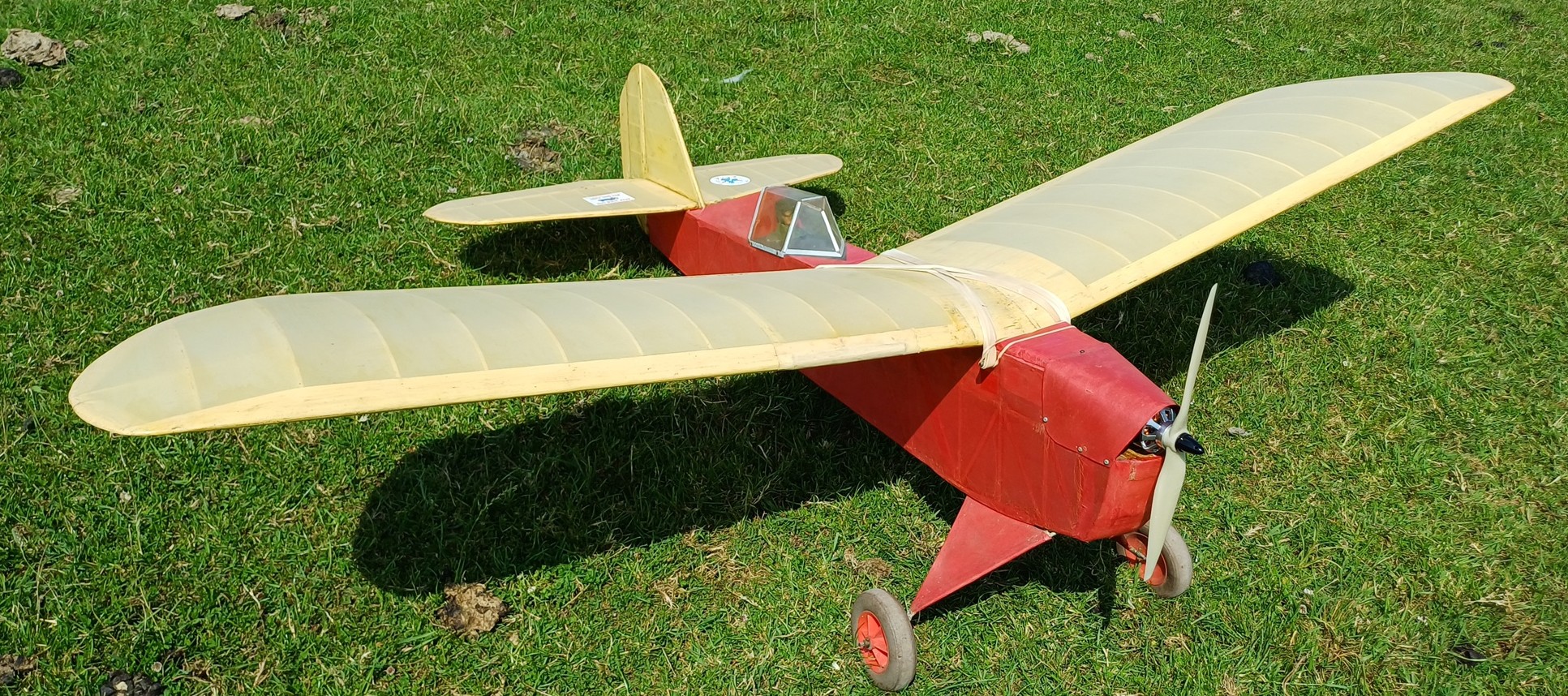 It would still have the wallowy flying characteristic though, so it’s returned to being a hangar queen for now. But at least it flew! Thanks for that Dougal, I rather like it, an ideal model for a calm summer’s day. It’s bound to Dutch roll (wallow) with all that dihedral, not much you can do about that without changing the dihedral but then the Sportster would lose part of it’s charm. I can’t help thinking that six cells provide way too much power, surely it would be fine on four cells, then being lighter and slower maybe there would be less wallowing? Take a look at the video and see for yourselves how it performs.
The last new model that flew this month was mine, an FMS Futura. I wasn’t looking a for a new model, like many of us I already have too many, but I spotted the Futura on the AliExpress site for just £109.93 with free delivery and it was simply too cheap to resist.
It would still have the wallowy flying characteristic though, so it’s returned to being a hangar queen for now. But at least it flew! Thanks for that Dougal, I rather like it, an ideal model for a calm summer’s day. It’s bound to Dutch roll (wallow) with all that dihedral, not much you can do about that without changing the dihedral but then the Sportster would lose part of it’s charm. I can’t help thinking that six cells provide way too much power, surely it would be fine on four cells, then being lighter and slower maybe there would be less wallowing? Take a look at the video and see for yourselves how it performs.
The last new model that flew this month was mine, an FMS Futura. I wasn’t looking a for a new model, like many of us I already have too many, but I spotted the Futura on the AliExpress site for just £109.93 with free delivery and it was simply too cheap to resist. 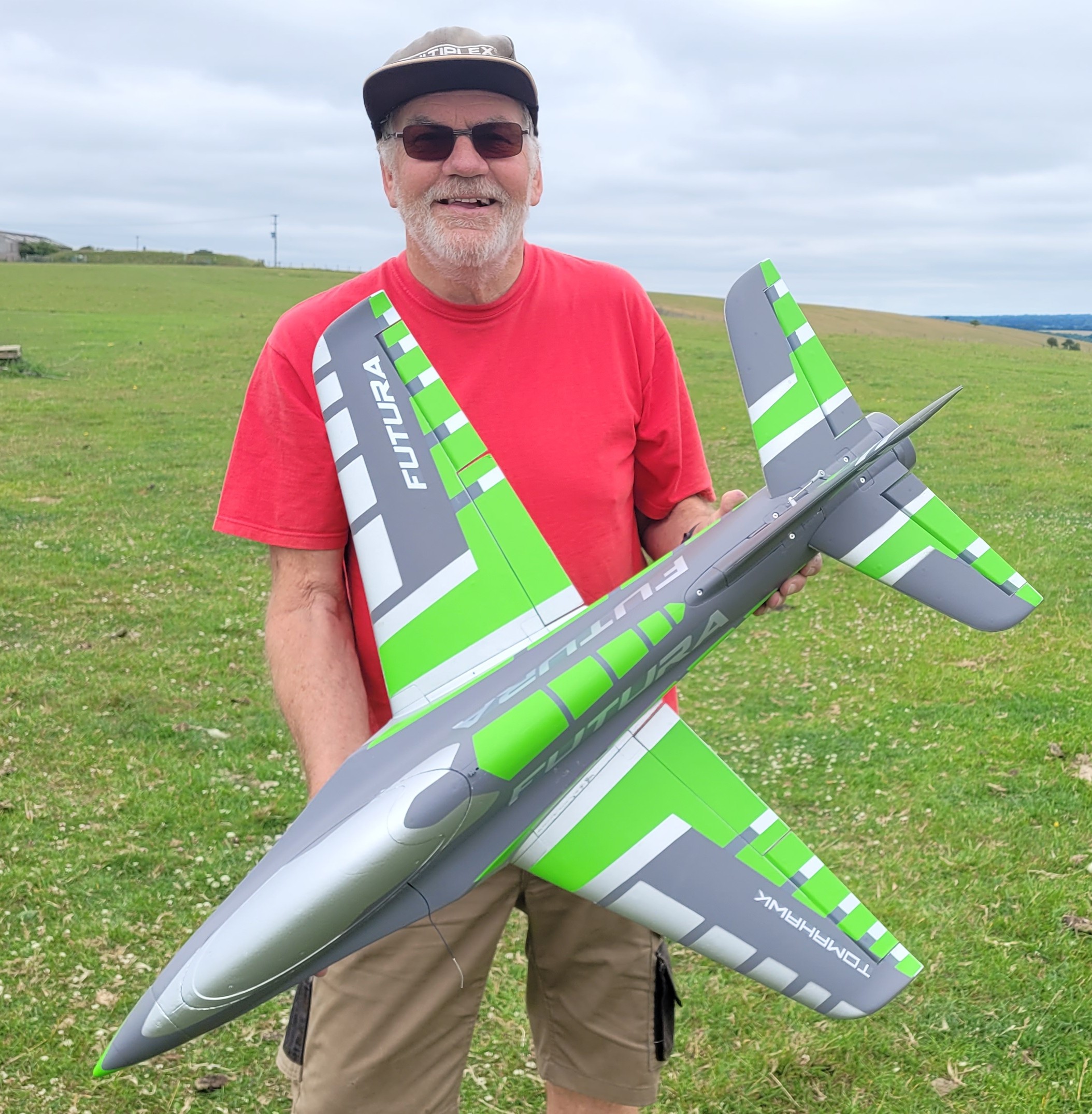 While I was waiting for mine to be delivered the price dropped and on 25th June the price was just £92.15 but the following day it had gone up to £115.46 so keep your eye on it!
While I was waiting for mine to be delivered the price dropped and on 25th June the price was just £92.15 but the following day it had gone up to £115.46 so keep your eye on it!
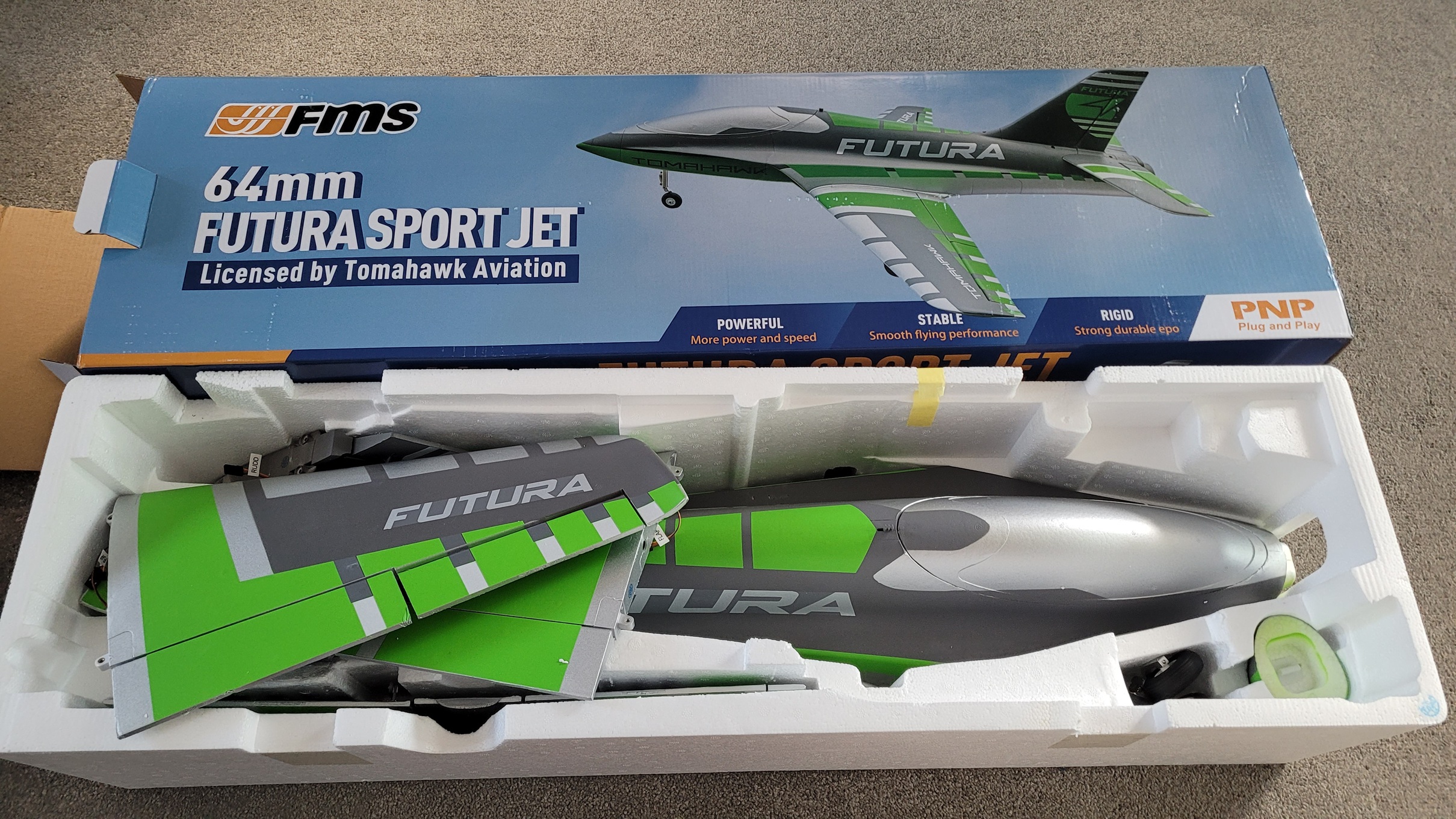 The Futura design has been around for quite a while and there are many versions from enormous turbine powered ones down to small EDF foamies. Mine has a wingspan of 900mm, is fitted with a 64mm fan and runs on four cells. This is what FMS say about it: The FMS Futura is a licensed sport jet developed by FMS in conjunction with Tomahawk-Aviation. Designed by a Sino-German team of engineers, the Futura represents the pinnacle of what a foam jet can be. Futura is definitely a pleasant surprise for those who struggle to choose between speed and stunts. It has high speed, high maneuverability, and excellent handling performance, satisfying players’ needs to experience various flying modes such as free flying, simulation competitions, and stunt flying.
The Futura design has been around for quite a while and there are many versions from enormous turbine powered ones down to small EDF foamies. Mine has a wingspan of 900mm, is fitted with a 64mm fan and runs on four cells. This is what FMS say about it: The FMS Futura is a licensed sport jet developed by FMS in conjunction with Tomahawk-Aviation. Designed by a Sino-German team of engineers, the Futura represents the pinnacle of what a foam jet can be. Futura is definitely a pleasant surprise for those who struggle to choose between speed and stunts. It has high speed, high maneuverability, and excellent handling performance, satisfying players’ needs to experience various flying modes such as free flying, simulation competitions, and stunt flying.
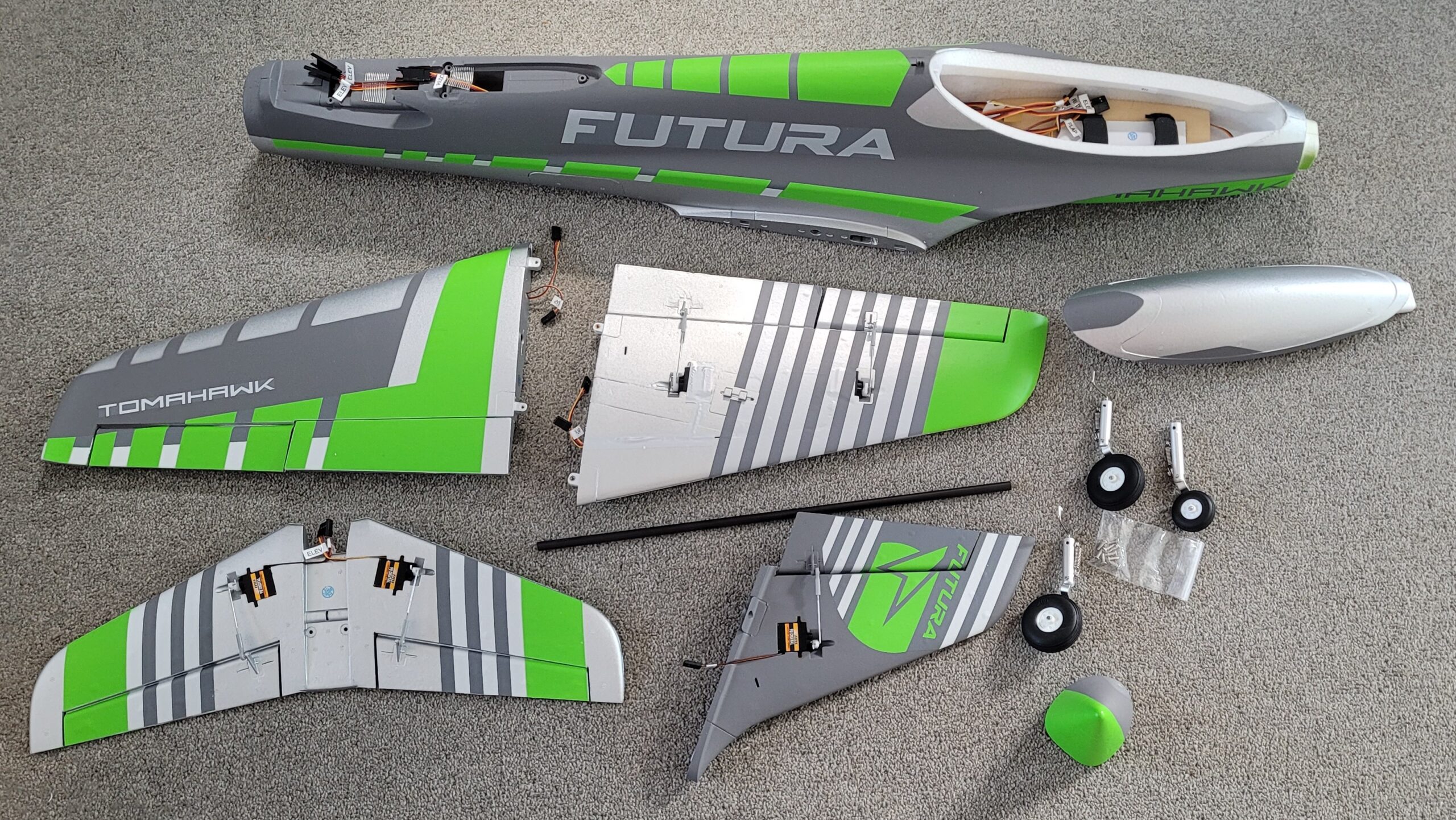 The power system is composed of a high-torque 2840-KV3150 brushless motor, a high-stability 40A ESC, and a 4S 2200mAh-2600mAh battery (to be purchased separately), which is paired with 8pcs high-precision 9g servos mounted on the wings, tail, and front steering position, allowing players to easily experience various control techniques and enjoy the pleasure of high-speed flight. In addition, the wings and tail of Futura have been pre-embedded with reinforced ribbons, and the cockpit is firmly fixed in place with buckle, which allows players to perform aggressive turns, rolls, and flips without any concerns. The CNC all-metal landing gear with trailing-link suspension is highly precise and robust, protecting the plane against rough landings. I placed the order on 26th May and it arrived on 23rd June, a week earlier than the date quoted, and it was in a sturdy box and was undamaged. Construction was simple, the parts simply screw together, no gluing required, then add your own receiver and battery. The ailerons, elevators, flaps, and rudder/steerable noseleg are all fitted with Y leads so only five channels are required.
The power system is composed of a high-torque 2840-KV3150 brushless motor, a high-stability 40A ESC, and a 4S 2200mAh-2600mAh battery (to be purchased separately), which is paired with 8pcs high-precision 9g servos mounted on the wings, tail, and front steering position, allowing players to easily experience various control techniques and enjoy the pleasure of high-speed flight. In addition, the wings and tail of Futura have been pre-embedded with reinforced ribbons, and the cockpit is firmly fixed in place with buckle, which allows players to perform aggressive turns, rolls, and flips without any concerns. The CNC all-metal landing gear with trailing-link suspension is highly precise and robust, protecting the plane against rough landings. I placed the order on 26th May and it arrived on 23rd June, a week earlier than the date quoted, and it was in a sturdy box and was undamaged. Construction was simple, the parts simply screw together, no gluing required, then add your own receiver and battery. The ailerons, elevators, flaps, and rudder/steerable noseleg are all fitted with Y leads so only five channels are required. 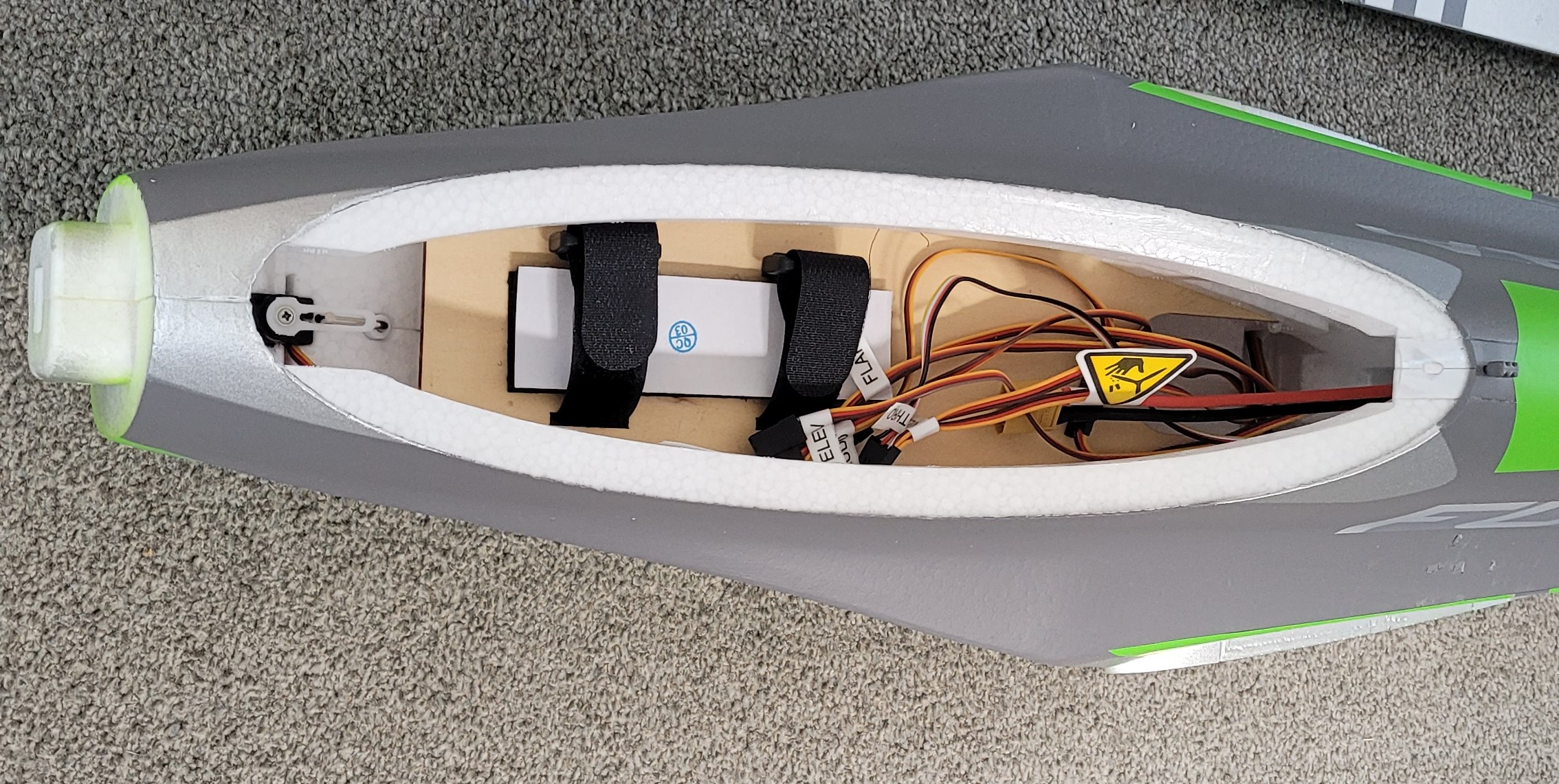 Interestingly the speed controller has an extra signal lead which enables you to have switched reverse thrust but as I am using a five channel receiver I don’t have a spare channel to try it. Presumably you’d only use reverse thrust after landing to slow the model on the ground, or maybe when taxiing, neither of which are relevant on our grass patch. The instructions warn not to engage reverse thrust at more than 50% throttle as it could damage the ESC so it wouldn’t be much use for crazy aerobatic antics!
Interestingly the speed controller has an extra signal lead which enables you to have switched reverse thrust but as I am using a five channel receiver I don’t have a spare channel to try it. Presumably you’d only use reverse thrust after landing to slow the model on the ground, or maybe when taxiing, neither of which are relevant on our grass patch. The instructions warn not to engage reverse thrust at more than 50% throttle as it could damage the ESC so it wouldn’t be much use for crazy aerobatic antics!
 As usual I took some photos of the model before the first flight but then I made the mistake of handing my mobile to Gordon Bennett for him to take a photo of me holding the plane. That’s very childish Gordon (well done!) and his accomplice Woody is no better!
As usual I took some photos of the model before the first flight but then I made the mistake of handing my mobile to Gordon Bennett for him to take a photo of me holding the plane. That’s very childish Gordon (well done!) and his accomplice Woody is no better!
 With the photos taken, the first flight was uneventful, using half flap the Futura took-off from the grass with no problems and then flew beautifully. The power set-up provides plenty of thrust and all the usual manoeuvres are possible. I landed using half flap and the Futura came in nicely and landed gently, no doubt helped by the sprung oleo legs.
With the photos taken, the first flight was uneventful, using half flap the Futura took-off from the grass with no problems and then flew beautifully. The power set-up provides plenty of thrust and all the usual manoeuvres are possible. I landed using half flap and the Futura came in nicely and landed gently, no doubt helped by the sprung oleo legs.
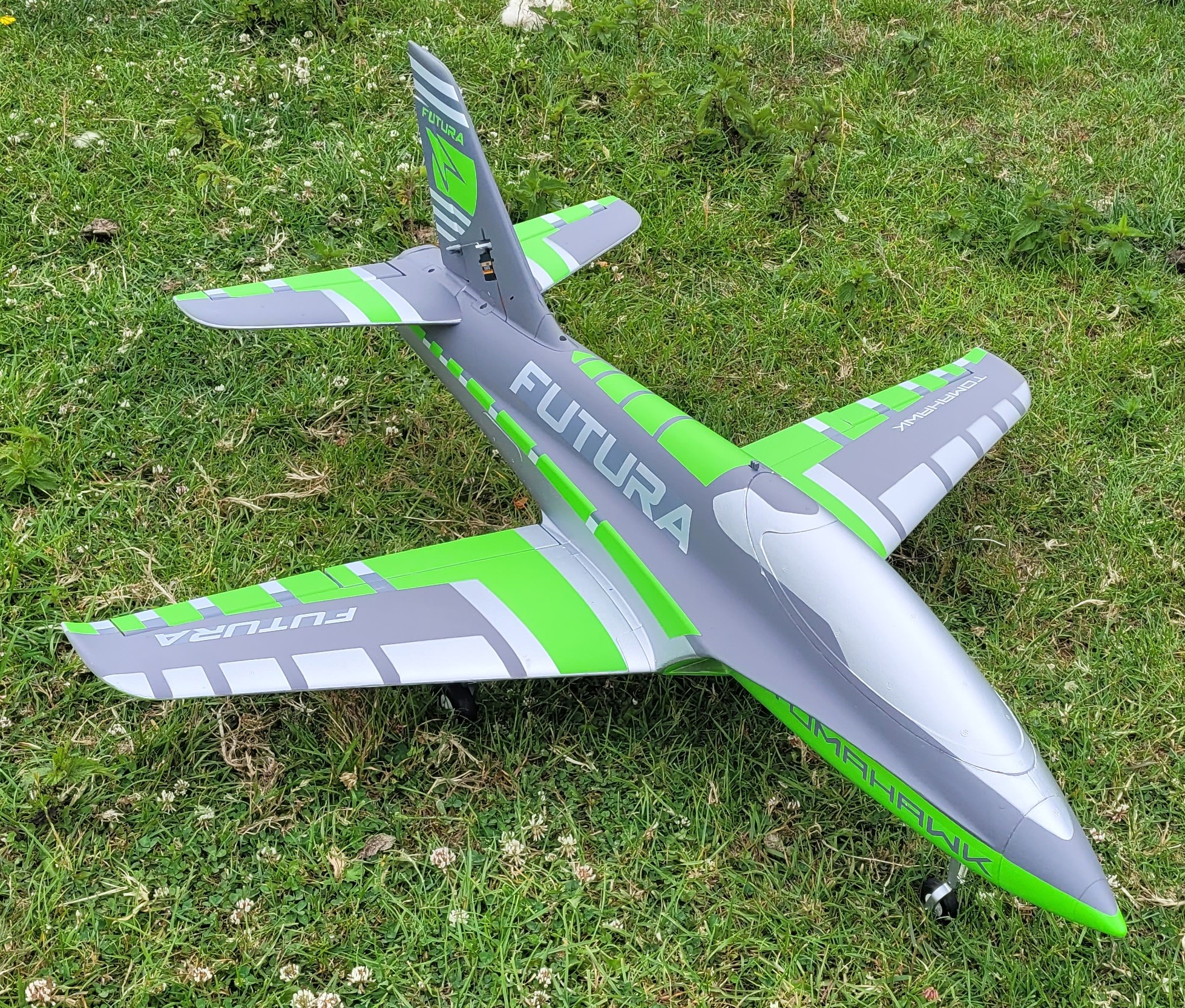 At the time of writing I’ve had three flights with no problems and I’m gradually getting used it’s characteristics. You can of course see some of the flying in this month’s video.
This month the ‘action shots’ aren’t action shots at all (my blog, my rules!):
I’m not sure if I’ve ever mentioned it (!) but back in October 2020 I was fortunate enough to have a flight in a two seat Spitfire from Solent Airport Daedalus, courtesy of my son.
At the time of writing I’ve had three flights with no problems and I’m gradually getting used it’s characteristics. You can of course see some of the flying in this month’s video.
This month the ‘action shots’ aren’t action shots at all (my blog, my rules!):
I’m not sure if I’ve ever mentioned it (!) but back in October 2020 I was fortunate enough to have a flight in a two seat Spitfire from Solent Airport Daedalus, courtesy of my son. 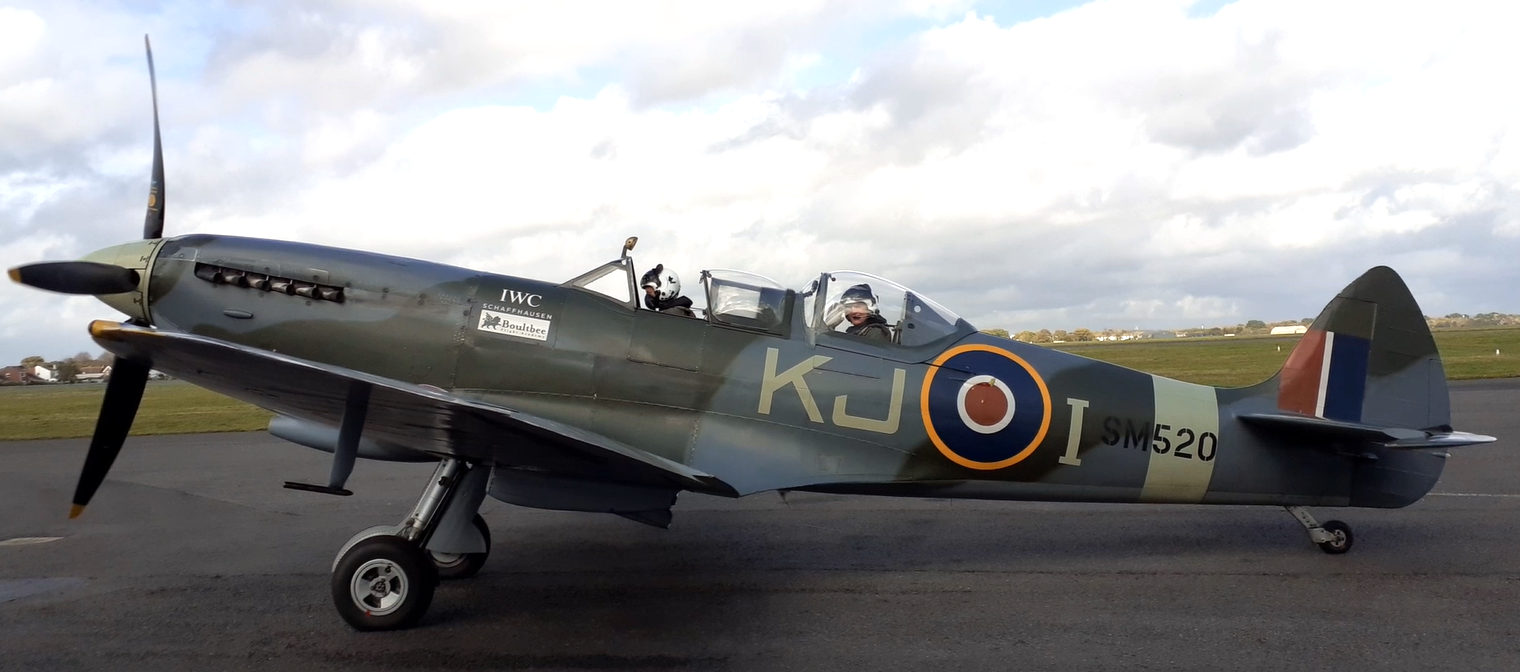
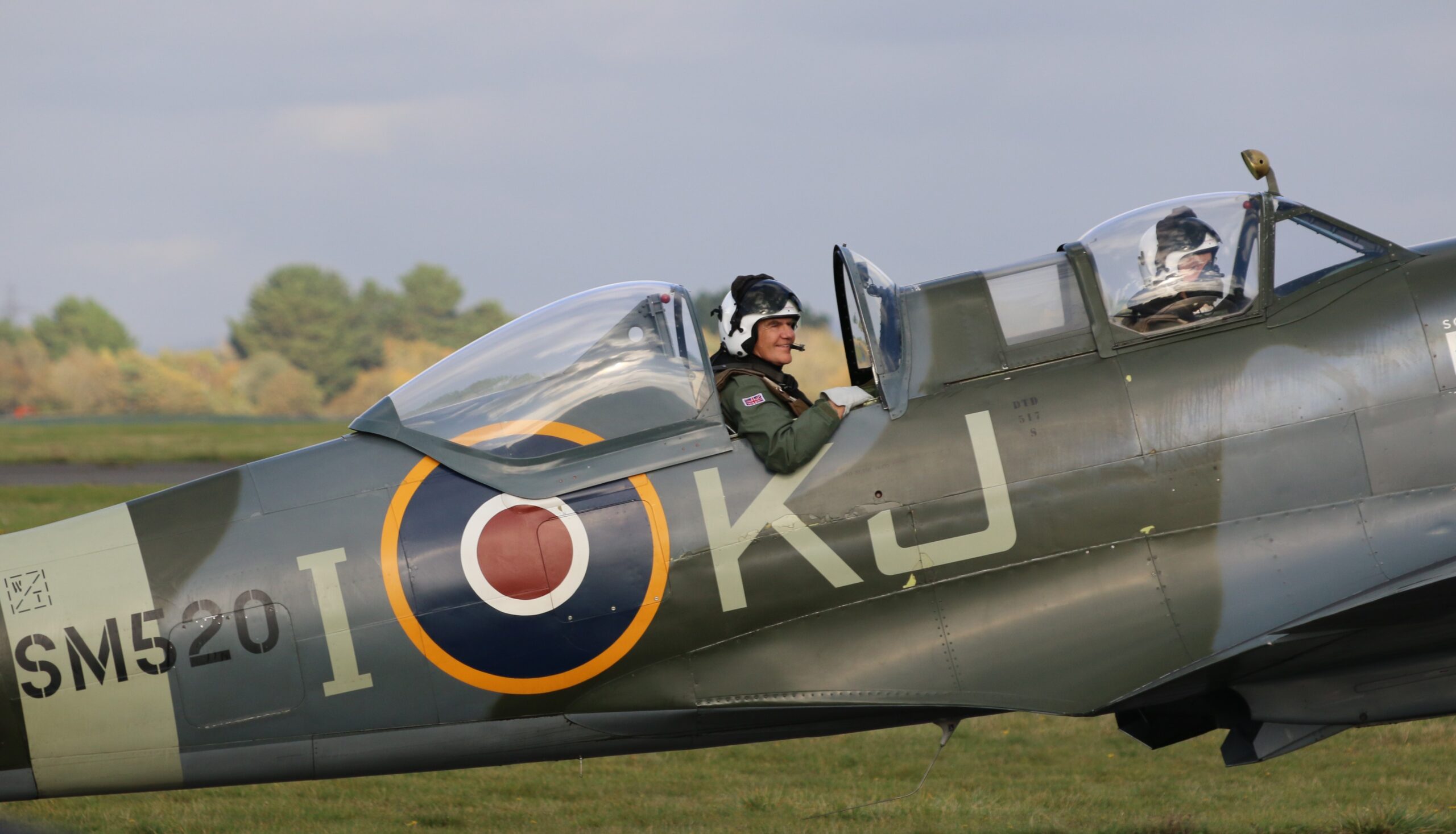 For some strange reason some club members seem to think I mention it far too much, and at the end of June Woody bought me a present in the hope that it’ll finally shut me up!
For some strange reason some club members seem to think I mention it far too much, and at the end of June Woody bought me a present in the hope that it’ll finally shut me up!

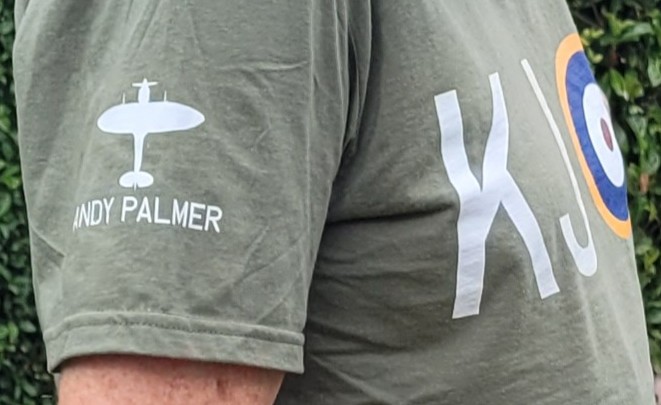
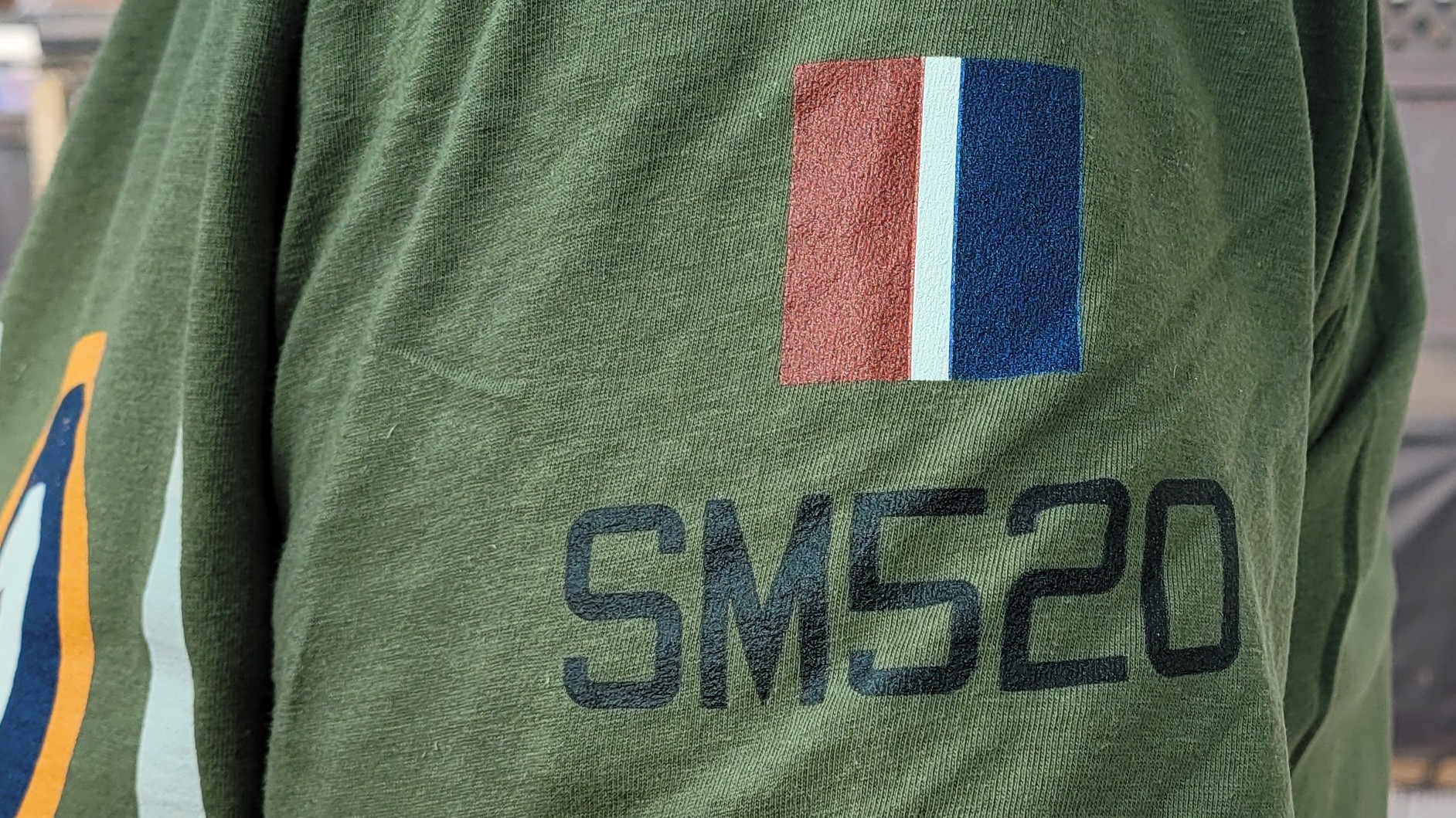 A T-shirt with all the correct aircraft markings! Thanks Woody… but it won’t shut me up!
Video time now, this month with footage shot by me, MacFly, Dougal, and Dot Cottam.
Please watch the video full-screen, it’s so much better with small models flying around:
If the video won’t play for you please click HERE
Final Funny:
No joke this month but I saw this and it made me chuckle
A T-shirt with all the correct aircraft markings! Thanks Woody… but it won’t shut me up!
Video time now, this month with footage shot by me, MacFly, Dougal, and Dot Cottam.
Please watch the video full-screen, it’s so much better with small models flying around:
If the video won’t play for you please click HERE
Final Funny:
No joke this month but I saw this and it made me chuckle
 Colin Cowplain
Colin Cowplain Patch News – May 2025
I was away for the last week of April and much of May so I missed most of what was going on at the patch. Fortunately both MacFly and Dougal Entendre took lots of photos and video as well as keeping me informed of the various events that I missed, thank you both.
The May weather was very mixed, at the start of the month the unusual easterly winds carried over from April, then there was a spell of glorious sunshine with light winds, and then more normal windy and showery weather returned towards the end of the month.
 As there’s been little rain the grass hasn’t grown much but the dandelions have flourished! The last Sunday of May was unflyable due to strong winds, but Woody went along and mowed the patch all by himself, that’s a lot of mowing for one person, Woody you’re a star!
As there’s been little rain the grass hasn’t grown much but the dandelions have flourished! The last Sunday of May was unflyable due to strong winds, but Woody went along and mowed the patch all by himself, that’s a lot of mowing for one person, Woody you’re a star!
On 25th April, just before I went away, Dot (Simon Cottam) took and passed his BMFA ‘A’ test. Dot has recently joined PAM and returned to flying after a break of around fifteen years, and had in fact passed the test previously, but BMFA were unable find it in their records. Of course things have changed a lot in fifteen years with all the new regulations so Dot was keen to take the test again and make sure he was up to date with everything.
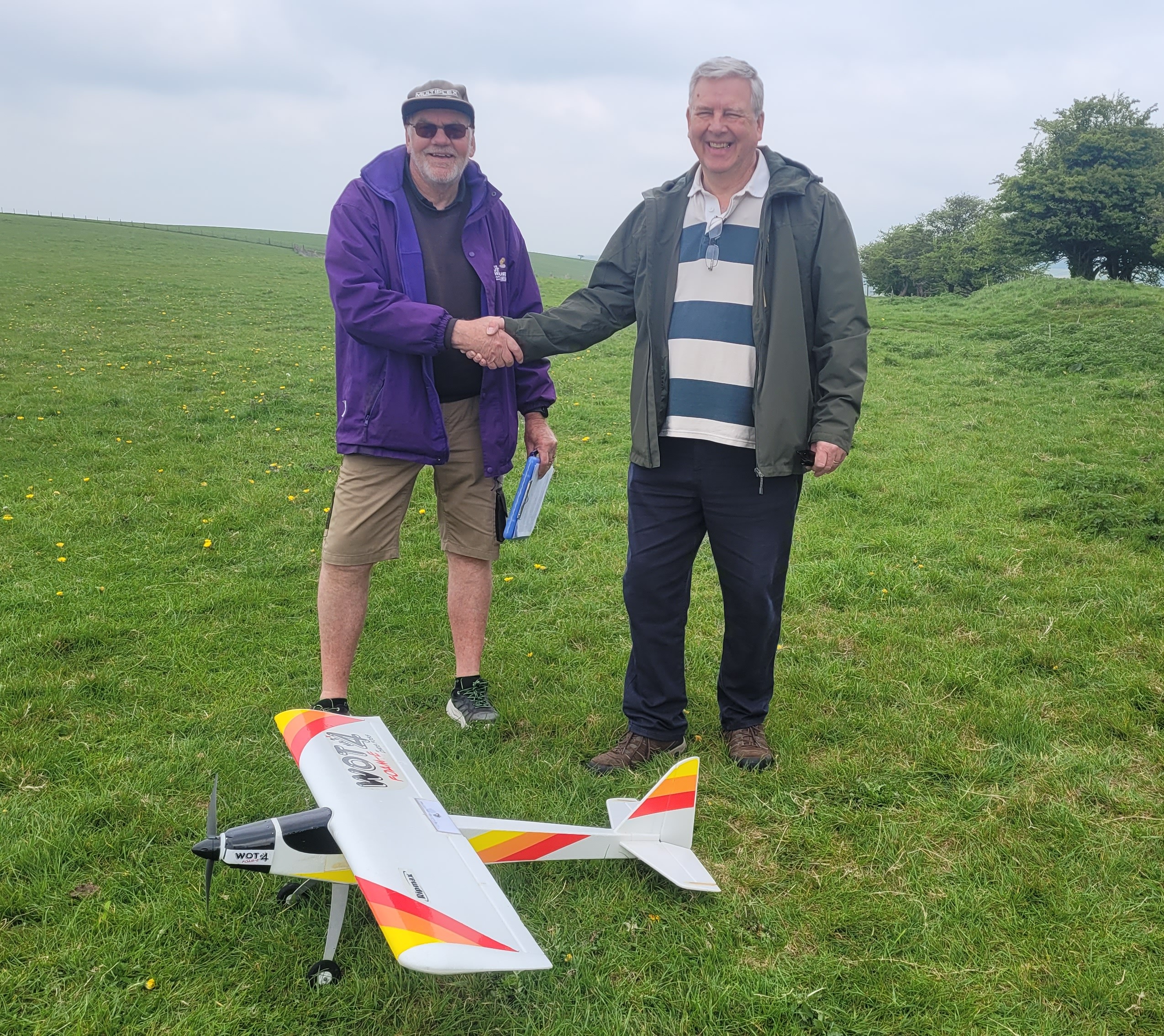 Having watched him flying since he joined us it was clear that Dot is a very capable flier and he sailed through the test with no problems at all, easily the best candidate that I’ve taken. Well done Dot, now it’s time to start practising for your ‘B’ test!
Having watched him flying since he joined us it was clear that Dot is a very capable flier and he sailed through the test with no problems at all, easily the best candidate that I’ve taken. Well done Dot, now it’s time to start practising for your ‘B’ test!
Another event that occurred on the same day was sadly not so good but it did cause a lot of evil laughter amongst all those present. Gordon’s Freewing Grumman Panther has had a rather short and chequered history up to now. It’s proved to be tricky to get away from a hand-launch and has been damaged a couple of times when it’s failed make it, although once up to speed and safely away it flies beautifully. Like all EDFs, with no propwash over surfaces, the pilot has little control until the speed builds up, and that takes a few seconds. 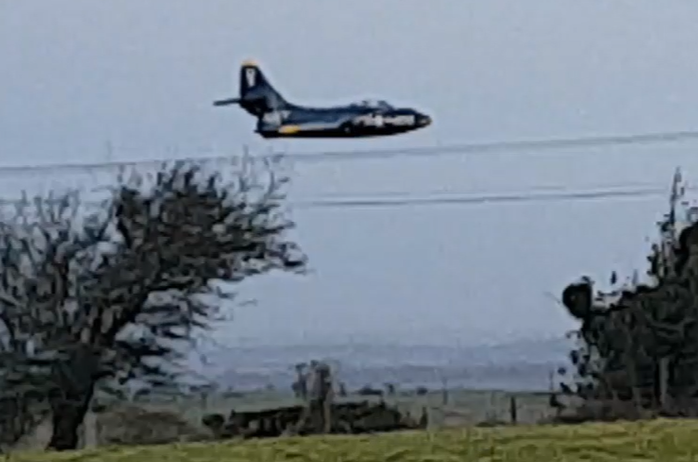
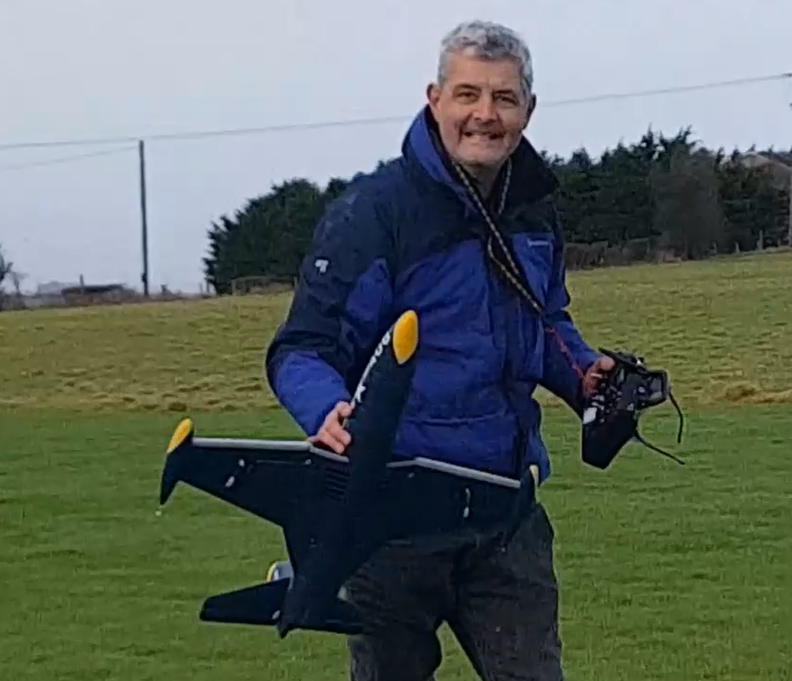 Gordon has been toying with the idea of borrowing Dwayne Pipe’s launch ramp and bungee but, having repaired the damage from the previous failure but not added a bungee hook, he decided to try one more hand-launch. He also decided to hand me the transmitter and do the launching himself. There was a nice breeze blowing so a hand-launch should surely be alright, what could possibly go wrong?! Gordon gave it a perfect throw, nice and level, directly into wind, and the Panther sank very low to the ground, slowly gathering flying speed, straight as a die, and just starting to climb when…it met the fence box!
Gordon has been toying with the idea of borrowing Dwayne Pipe’s launch ramp and bungee but, having repaired the damage from the previous failure but not added a bungee hook, he decided to try one more hand-launch. He also decided to hand me the transmitter and do the launching himself. There was a nice breeze blowing so a hand-launch should surely be alright, what could possibly go wrong?! Gordon gave it a perfect throw, nice and level, directly into wind, and the Panther sank very low to the ground, slowly gathering flying speed, straight as a die, and just starting to climb when…it met the fence box! 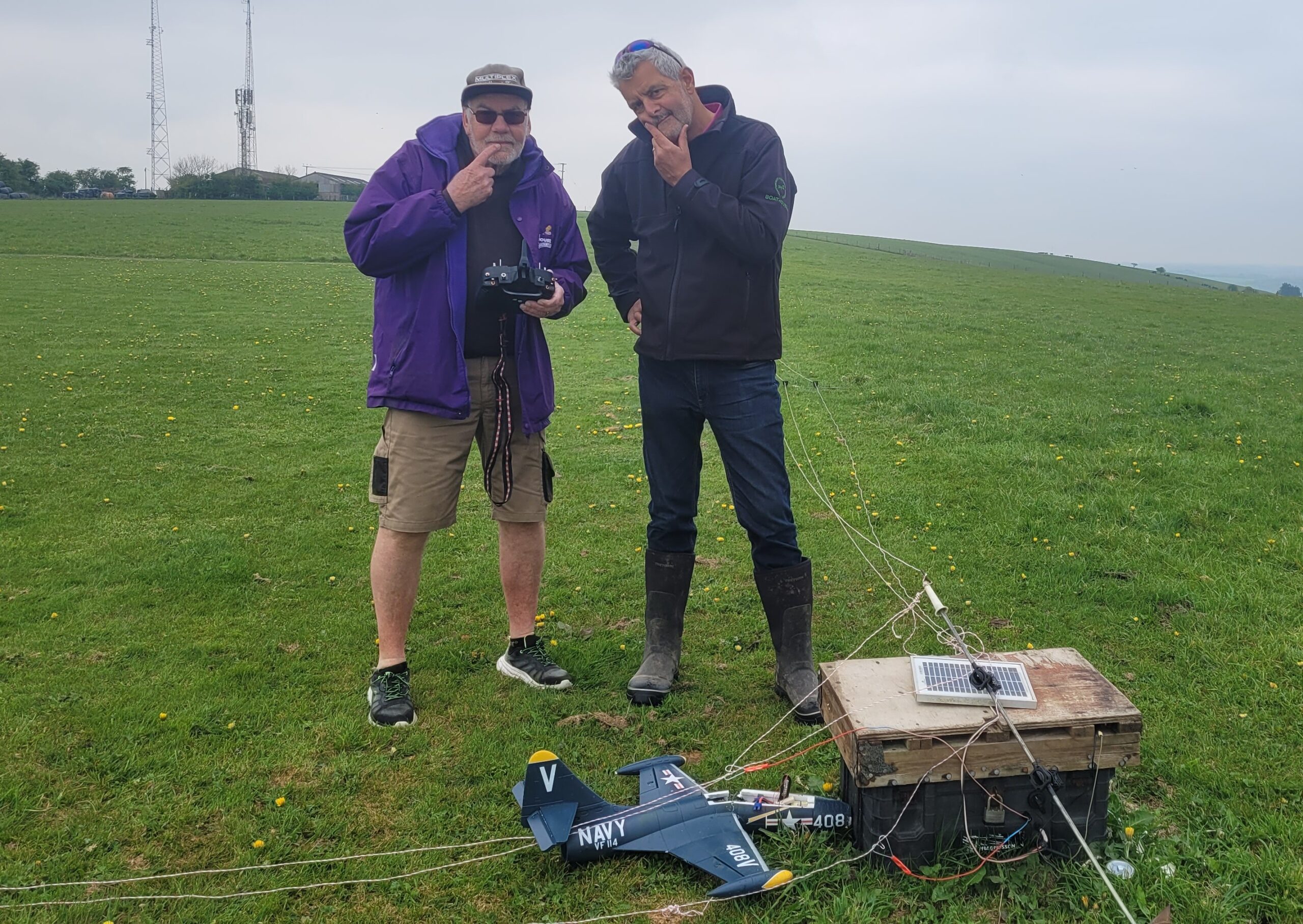
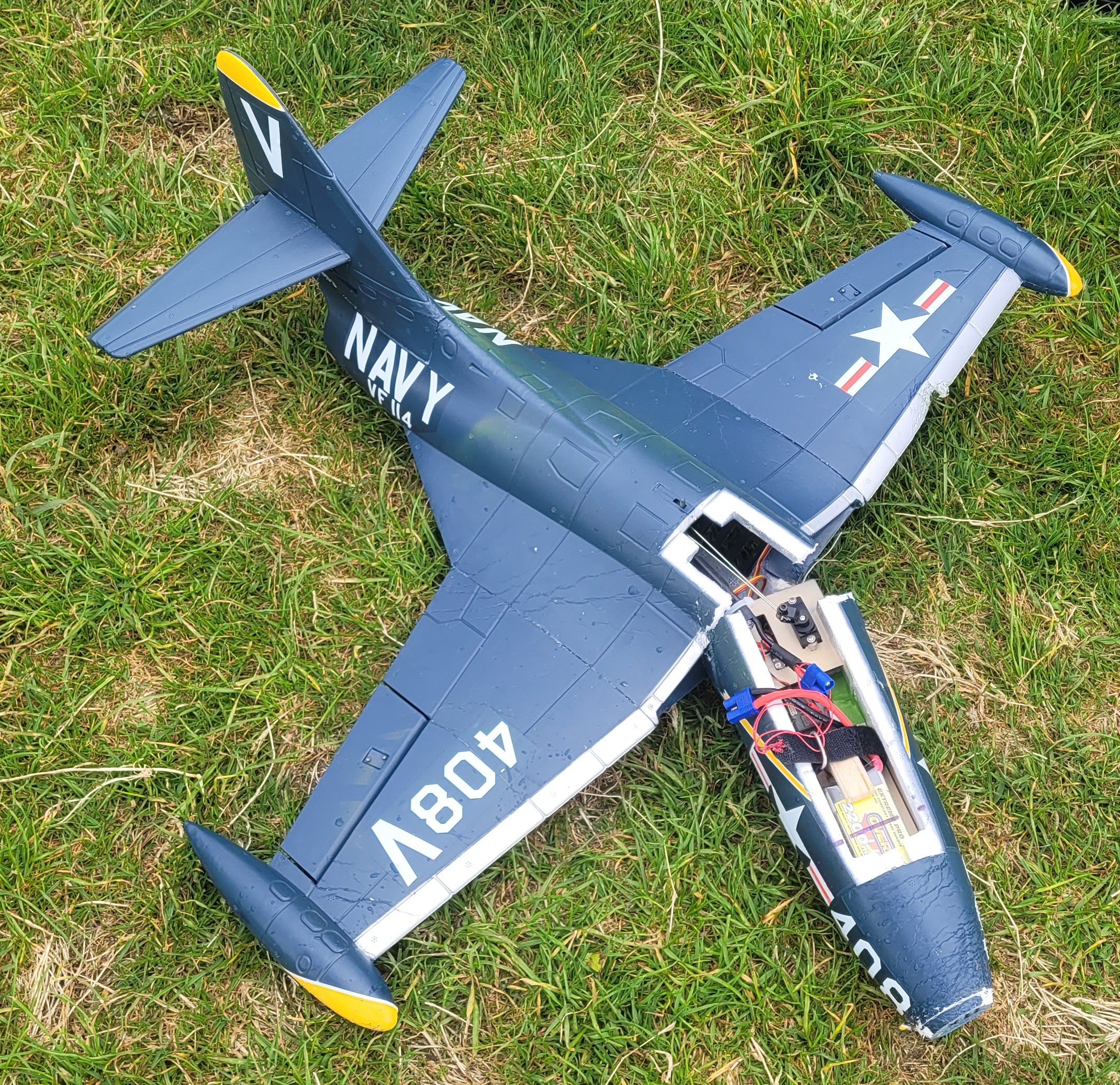
Fortunately (I think?) it hit the box straight on, not with one wing, so the damage wasn’t as bad as it could have been and hopefully Gordon will soon have it back in one piece, and I’m guessing, with a shiny new bungee hook ready to be launched from Dwayne’s ramp.
Thinking of Dwayne Pipe, when I returned from my travels I heard that Dwayne has been unwell. I wrote to wish him well and in his reply he included this: You may remember I spectacularly disassembled my Folland Gnat in April. I have used the last month to rebuild most of it. I hope to get it up to the patch soon. Regards to all the midweek flyers.
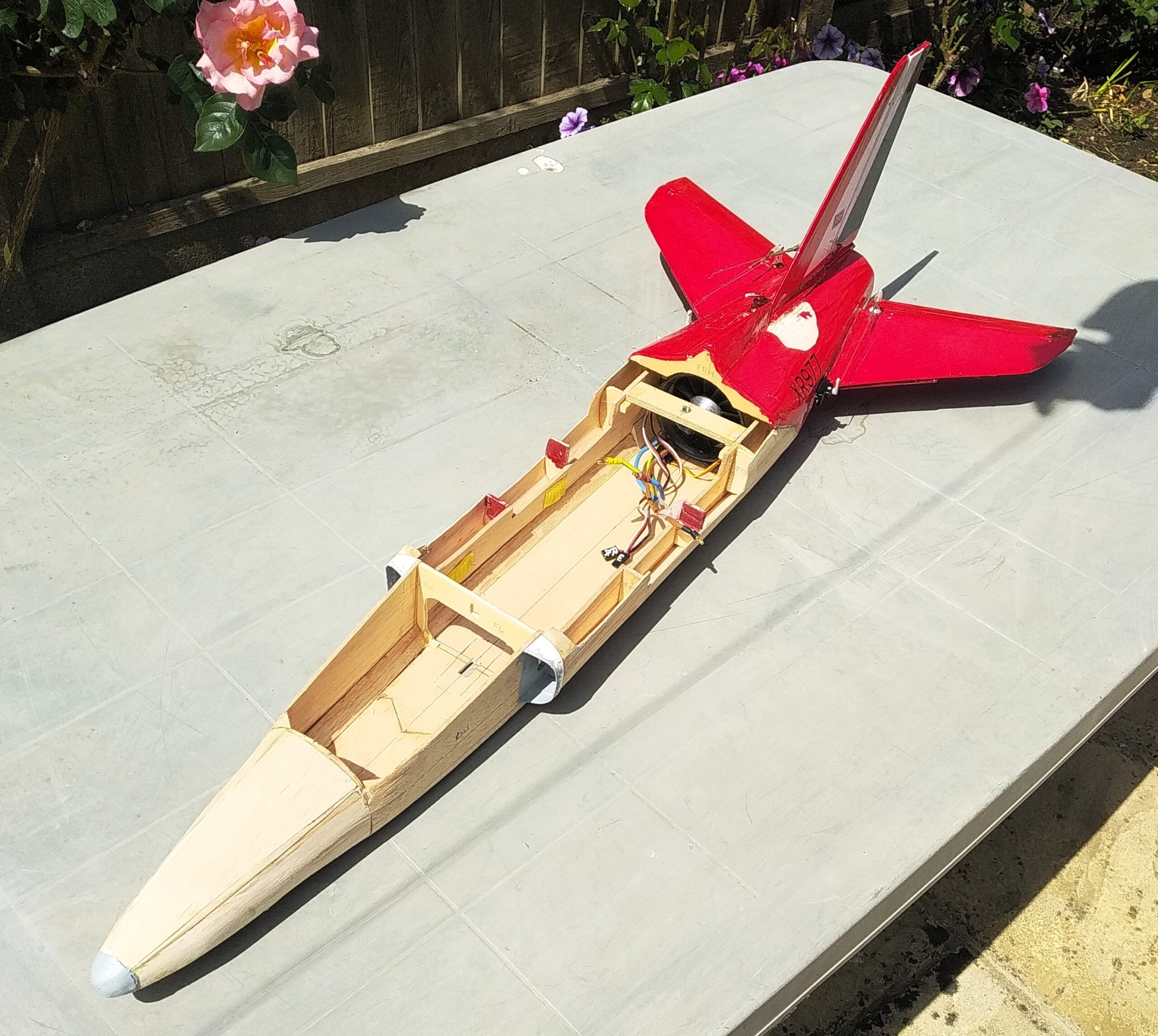 We’re all looking forward to seeing you back at the field and flying again soon Dwayne.
We’re all looking forward to seeing you back at the field and flying again soon Dwayne.
Oh, and by the way, Gordon says please can he borrow your launch ramp?!
Also at the end of April a rather unusual event occurred, Dougal Entendre crashed!
Here’s what he says about it: I had a bad day. 2nd flight of the Edge, I tried to enter a knife-edge spin, but it went wrong and I ended up in a fast spin. When I tried to pull out it didn’t seem to respond, and it went in hard, about 3/4 of the way to the car park.
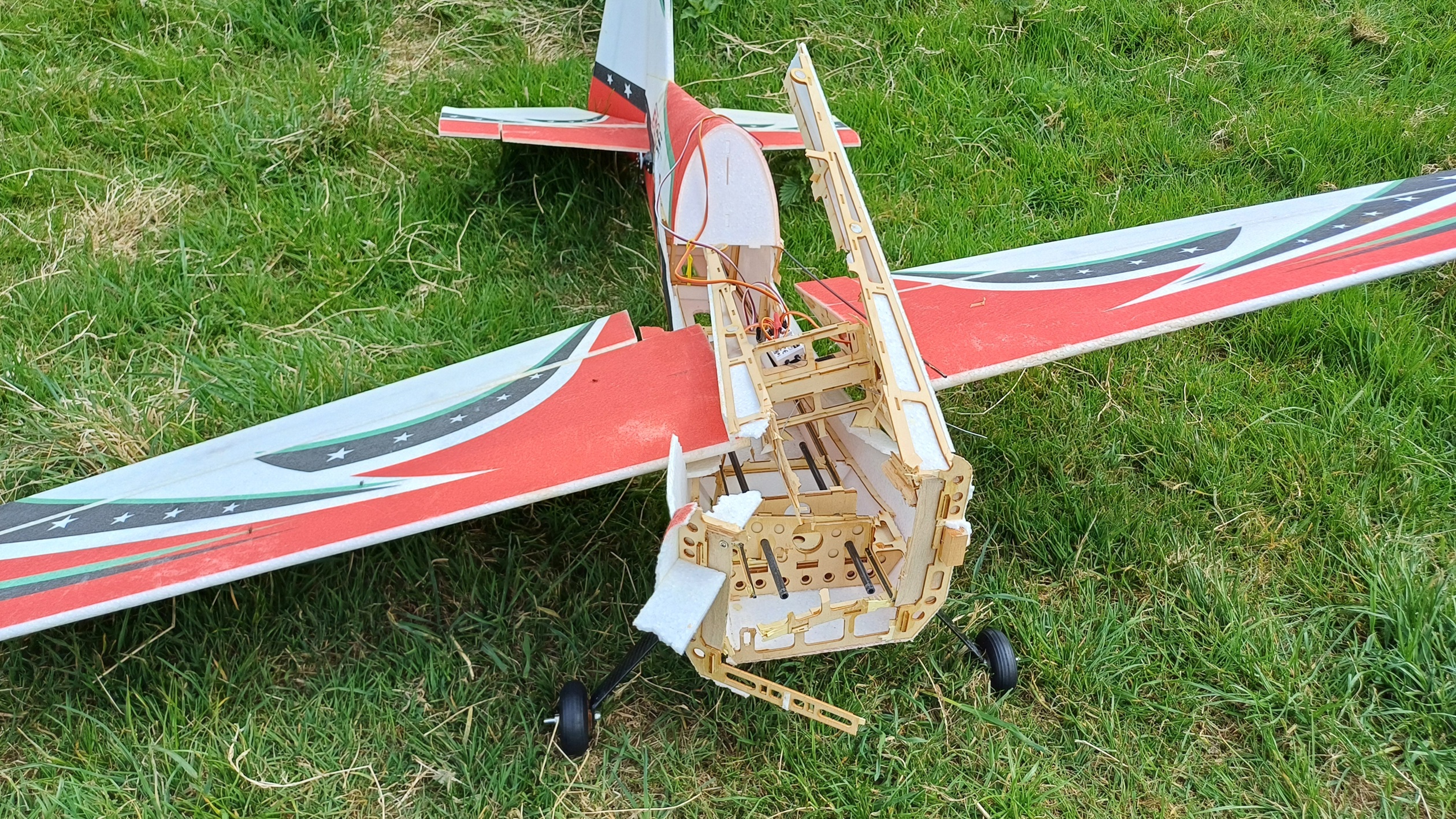 There was a puff of smoke, so I legged it over to the wreckage, most of which was about 3 feet away from the burning batteries and ESC. The cells went off one after the other, and each time one went, it shot out flames about a foot long. I stayed with it until all the flames had subsided and I was sure the grass wasn’t going to catch light.
There was a puff of smoke, so I legged it over to the wreckage, most of which was about 3 feet away from the burning batteries and ESC. The cells went off one after the other, and each time one went, it shot out flames about a foot long. I stayed with it until all the flames had subsided and I was sure the grass wasn’t going to catch light.
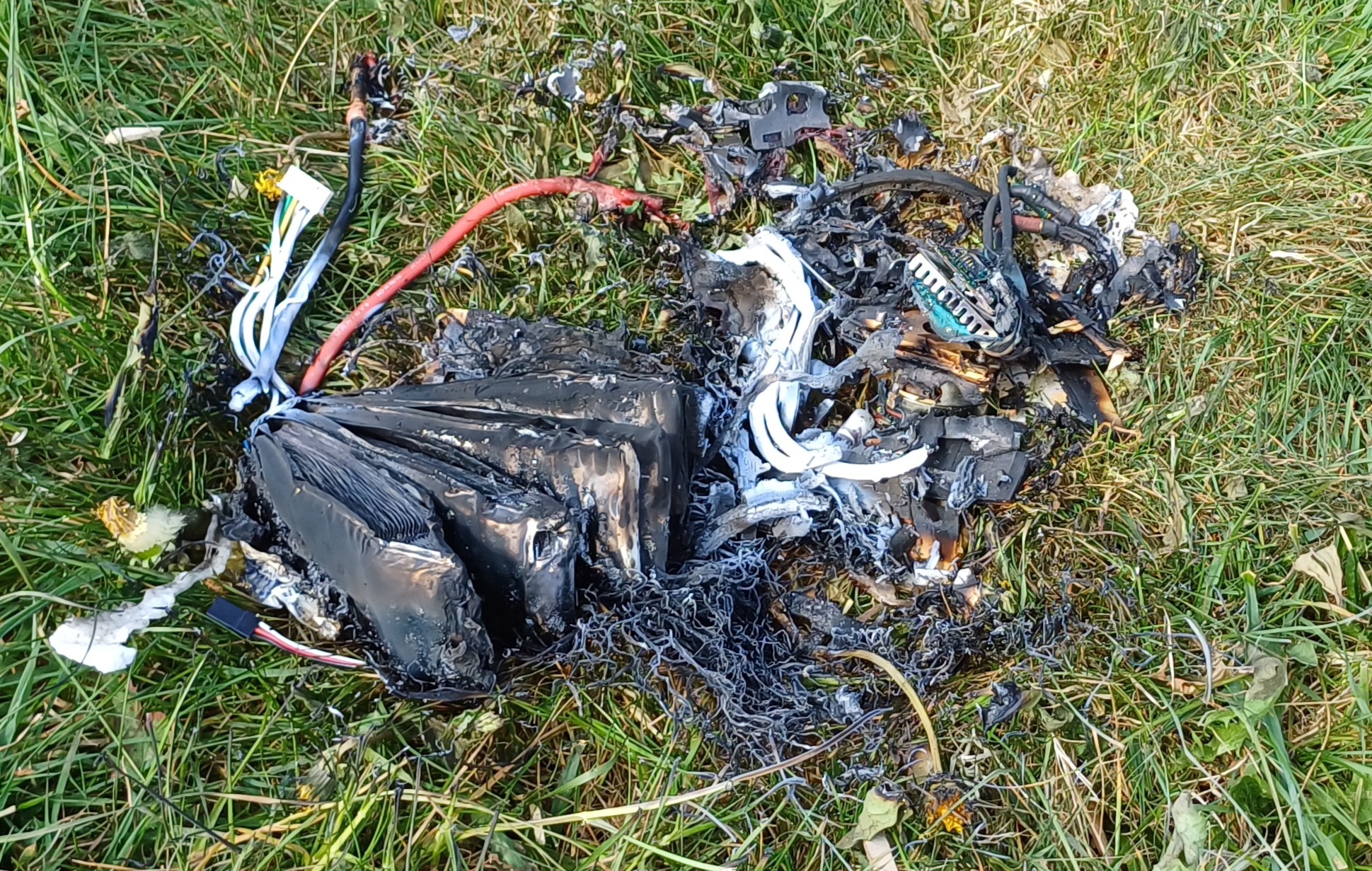 I then returned with my phone to take pictures of the burnt mess, and used the shovel to dig up the motor and charred remains of the ESC. The servos and Rx are OK, but everything else is a write-off. Fortunately I have an untouched kit for another one!
I then returned with my phone to take pictures of the burnt mess, and used the shovel to dig up the motor and charred remains of the ESC. The servos and Rx are OK, but everything else is a write-off. Fortunately I have an untouched kit for another one!
That’s a great shame Dougal but we look forward to seeing the next one when it emerges.
The first new model to feature this month is Mini Mike’s Soar Ahead Sailplanes Blob.
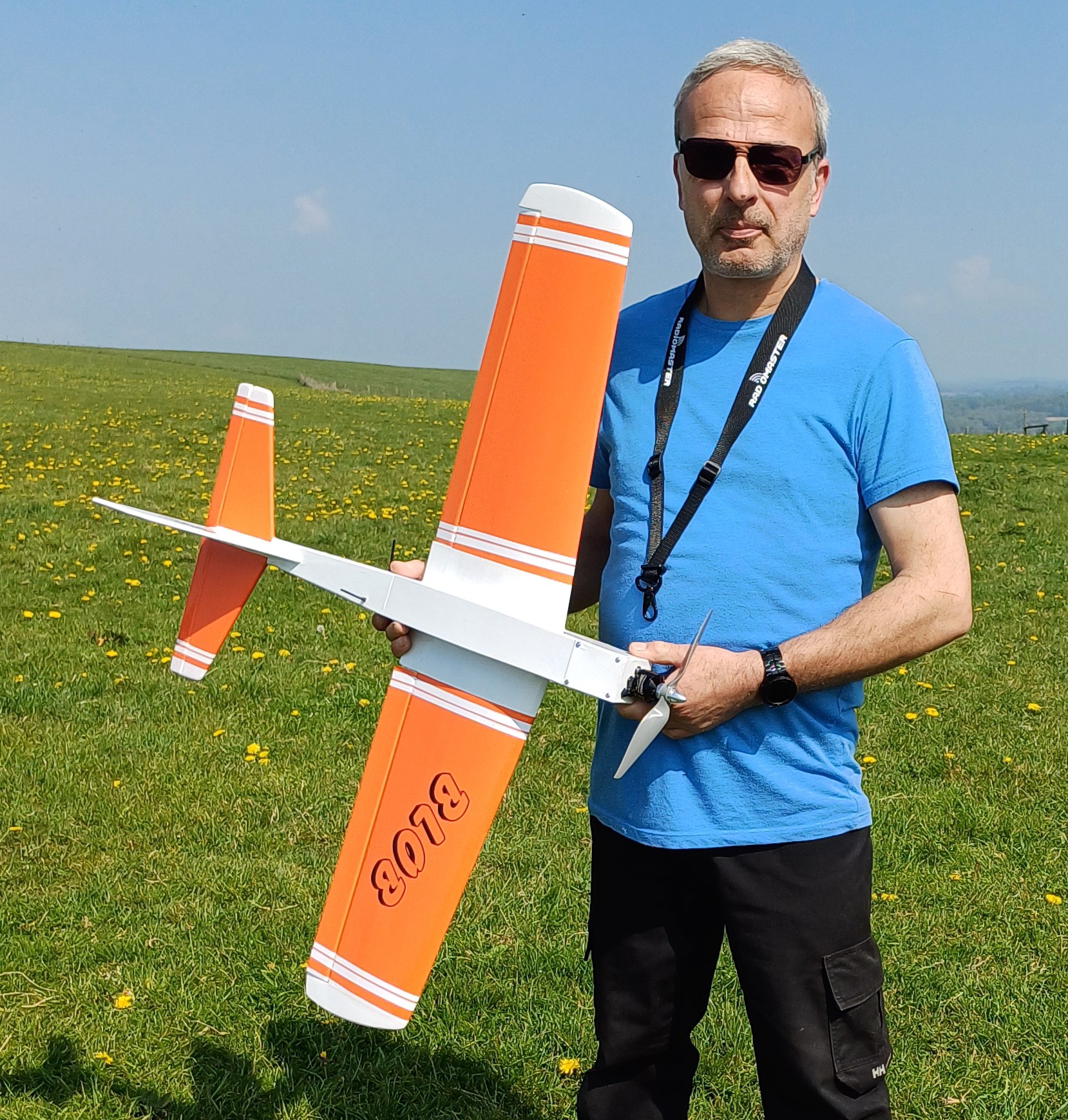 The Blob is a 40” span model that was originally designed as a slope soarer but was then made available as I/C powered and now electric. SAS ceased trading a long time ago but the designs are now kitted by NJR Modelling where the I/C or Electric Blob costs £86.99.
The Blob is a 40” span model that was originally designed as a slope soarer but was then made available as I/C powered and now electric. SAS ceased trading a long time ago but the designs are now kitted by NJR Modelling where the I/C or Electric Blob costs £86.99.
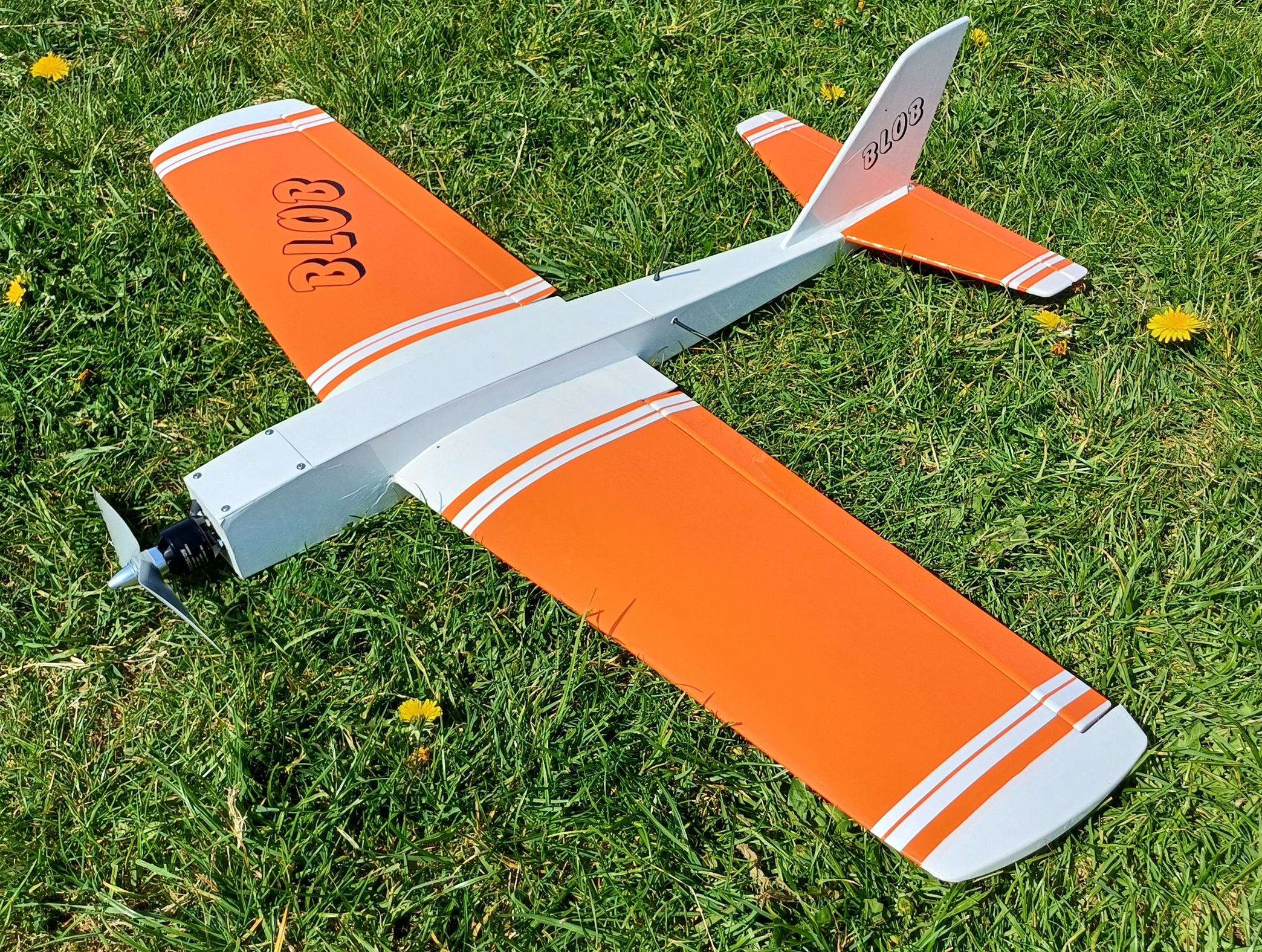 Mini Mike says the kit was a little strange to build as you have to build the fuselage onto the wing rather than slide the wing into the pre-built fuselage as you would normally. This resulted in Mike’s having a slightly bent rear fuselage, not that’s it’s noticeable.
Mini Mike says the kit was a little strange to build as you have to build the fuselage onto the wing rather than slide the wing into the pre-built fuselage as you would normally. This resulted in Mike’s having a slightly bent rear fuselage, not that’s it’s noticeable.
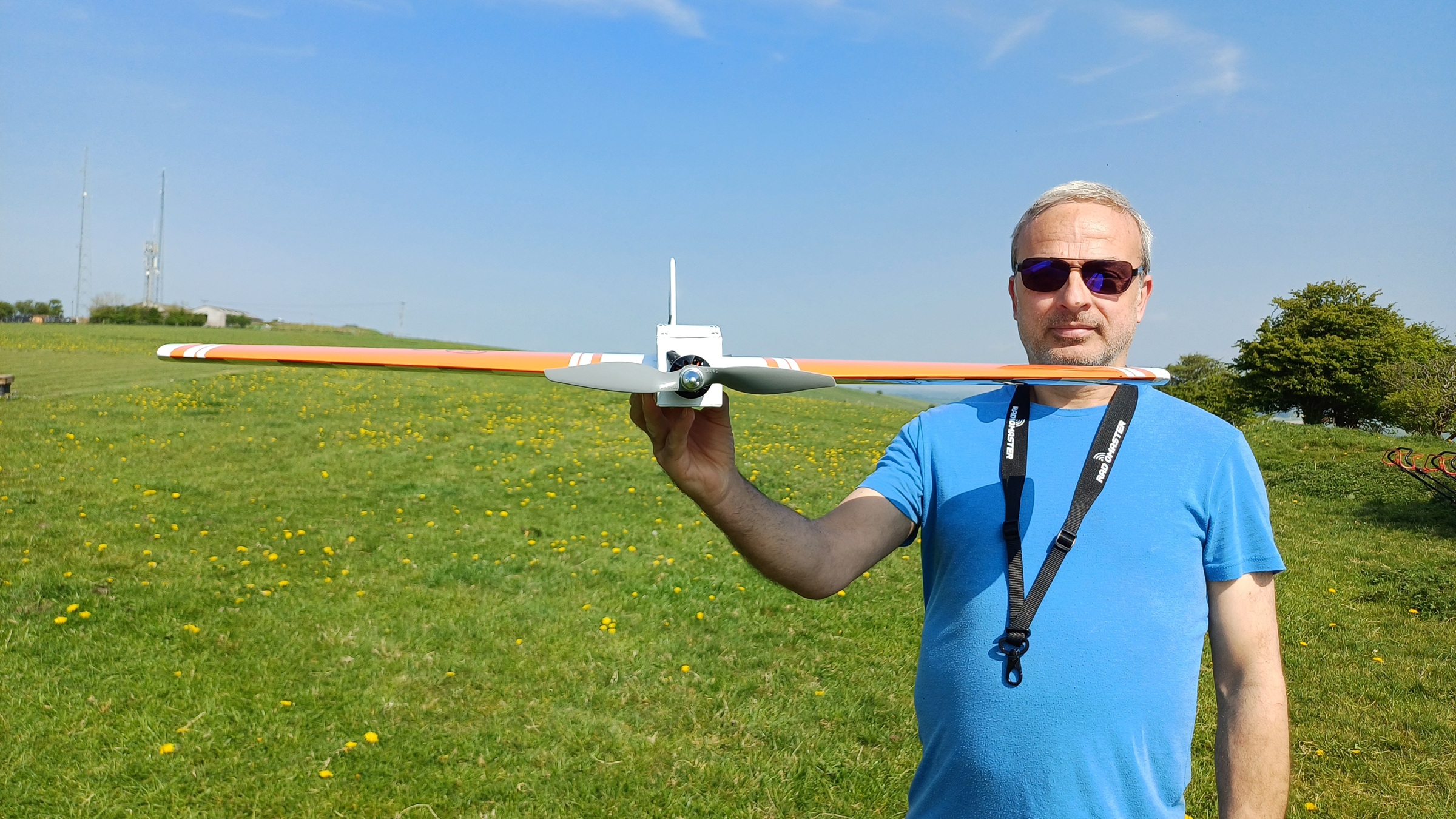 Mini Mike has fitted his with an Overlander 3536/05 1500Kv motor and an Overlander 50A speed controller. He’s using a 9×6 propeller and the new Shorty 2200mAh 3 cell 50C lipos from HobbyKing. He says they are lighter than the standard size ones and get the centre of gravity closer to the correct position. Mike has used JX metal geared servos and there are only two so the Blob must just use one centre mounted servo for the ailerons.
Mini Mike has fitted his with an Overlander 3536/05 1500Kv motor and an Overlander 50A speed controller. He’s using a 9×6 propeller and the new Shorty 2200mAh 3 cell 50C lipos from HobbyKing. He says they are lighter than the standard size ones and get the centre of gravity closer to the correct position. Mike has used JX metal geared servos and there are only two so the Blob must just use one centre mounted servo for the ailerons.
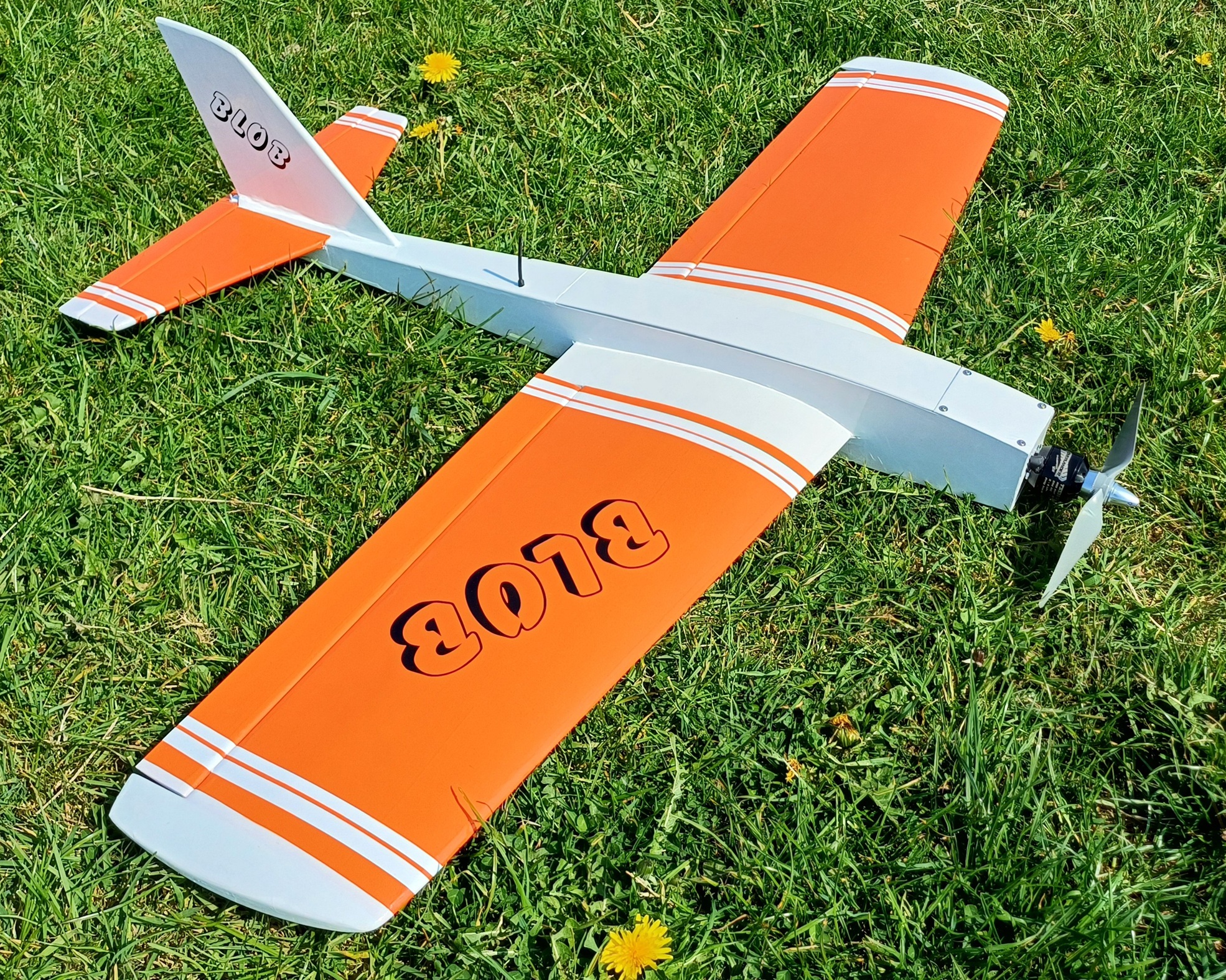 The covering is Ripmax Aero heat-shrink film and very smart it looks too. So, now for the all-important question, how does it fly? I haven’t seen it fly myself yet but, as you will see in this month’s video, it looks to be excellent, fast and smooth, nice one Mike.
The covering is Ripmax Aero heat-shrink film and very smart it looks too. So, now for the all-important question, how does it fly? I haven’t seen it fly myself yet but, as you will see in this month’s video, it looks to be excellent, fast and smooth, nice one Mike.
The Popham Model Show took place on the weekend of May 10th and 11th. Sadly I missed the show this year as I was away but several members went and reported it was excellent, with great weather and more trade stands than last year. Dougal Entendre took lots of photos for us, including one of some pilots, I have no idea why he concentrated on these!
 I’ll include some more of Dougal’s Popham photos towards the end of this Patch News. Dougal splashed out and left the show with a model, here’s his report: I picked up a Wasp E2K racer in the bring-and-buy at Popham, just like 1066’s red one, but this one’s blue.
I’ll include some more of Dougal’s Popham photos towards the end of this Patch News. Dougal splashed out and left the show with a model, here’s his report: I picked up a Wasp E2K racer in the bring-and-buy at Popham, just like 1066’s red one, but this one’s blue.
I only paid £50 for it, fully equipped (bind-and-fly), so it was too good to miss.
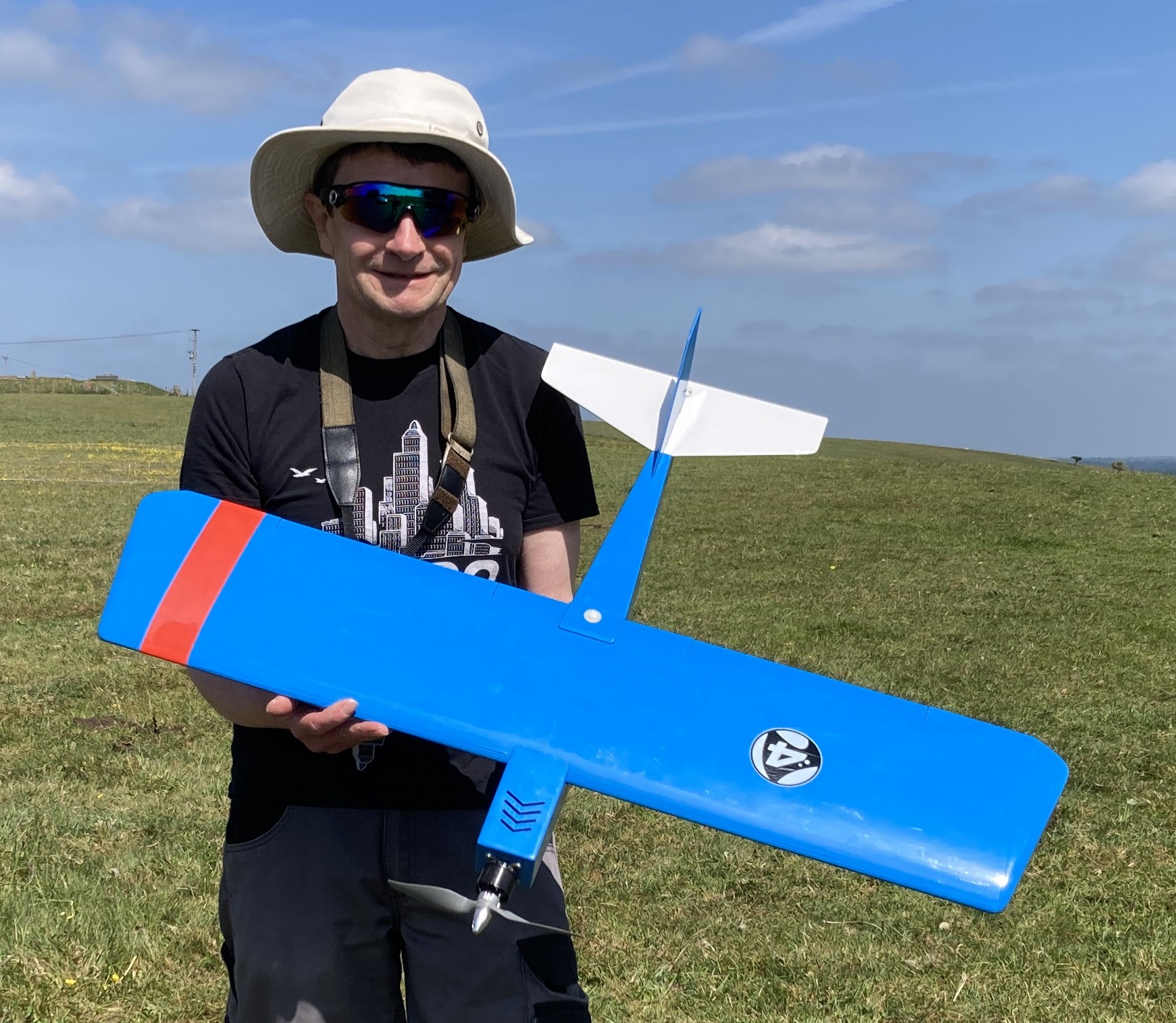 The drawbacks were relatively minor: a slight crack in one fuselage side near the LE, which had been well repaired, and the Rx was Spektrum! Also there’s no battery hatch, so it’s a case of removing the wing to change the battery, but it’s only one bolt.
The drawbacks were relatively minor: a slight crack in one fuselage side near the LE, which had been well repaired, and the Rx was Spektrum! Also there’s no battery hatch, so it’s a case of removing the wing to change the battery, but it’s only one bolt.
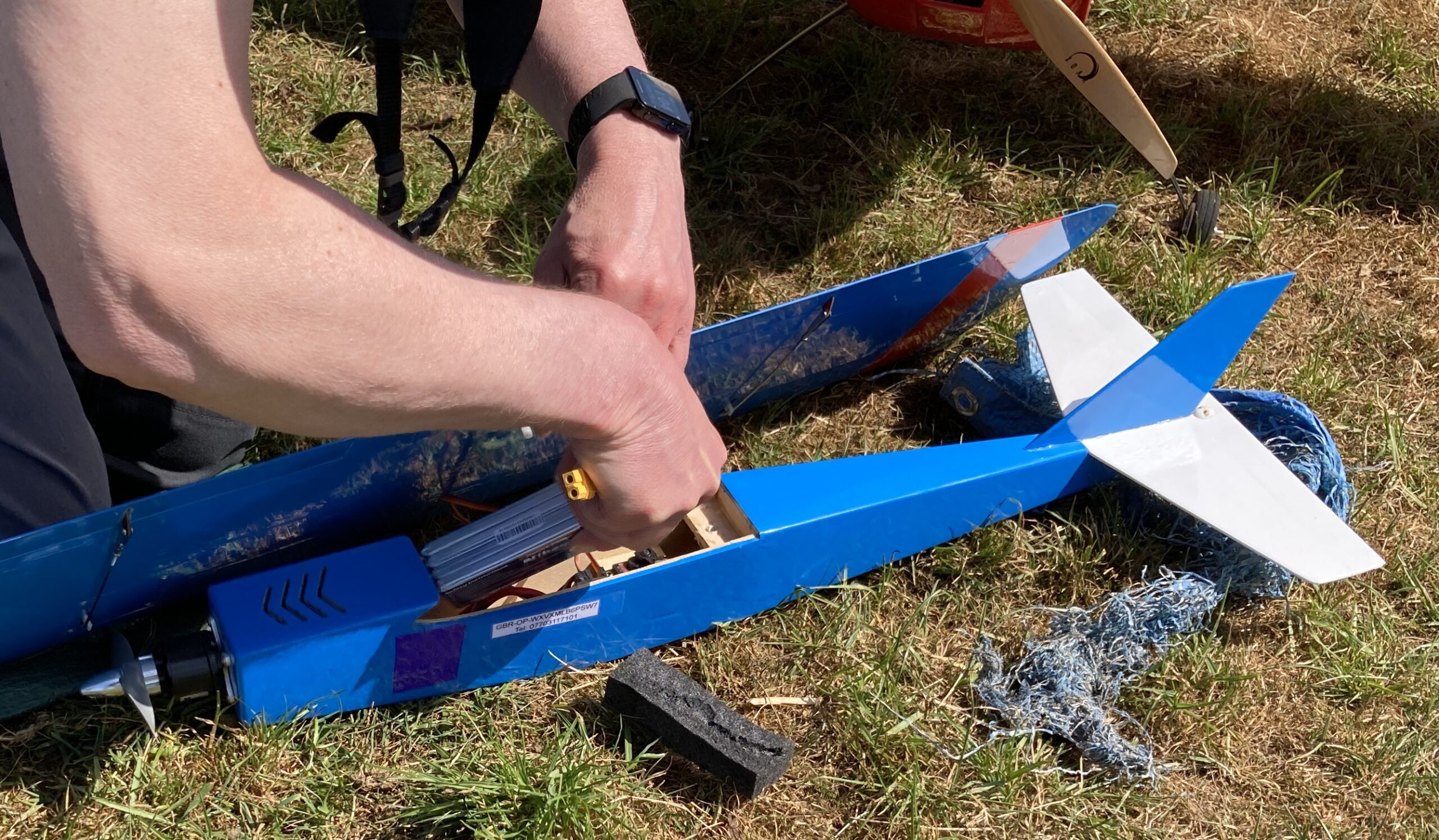 I added a stripe and decal to the wings, as I didn’t fancy my chances of retaining orientation with a plain light blue model! I bought a couple of Nihewo LiPos for it, 4s 2200mAh 100C, currently £47.49 for two on Amazon. I then bound my Radiomaster Tx to the Rx, set up quite small throws (as recommended by the seller), and was ready to go.
I added a stripe and decal to the wings, as I didn’t fancy my chances of retaining orientation with a plain light blue model! I bought a couple of Nihewo LiPos for it, 4s 2200mAh 100C, currently £47.49 for two on Amazon. I then bound my Radiomaster Tx to the Rx, set up quite small throws (as recommended by the seller), and was ready to go.
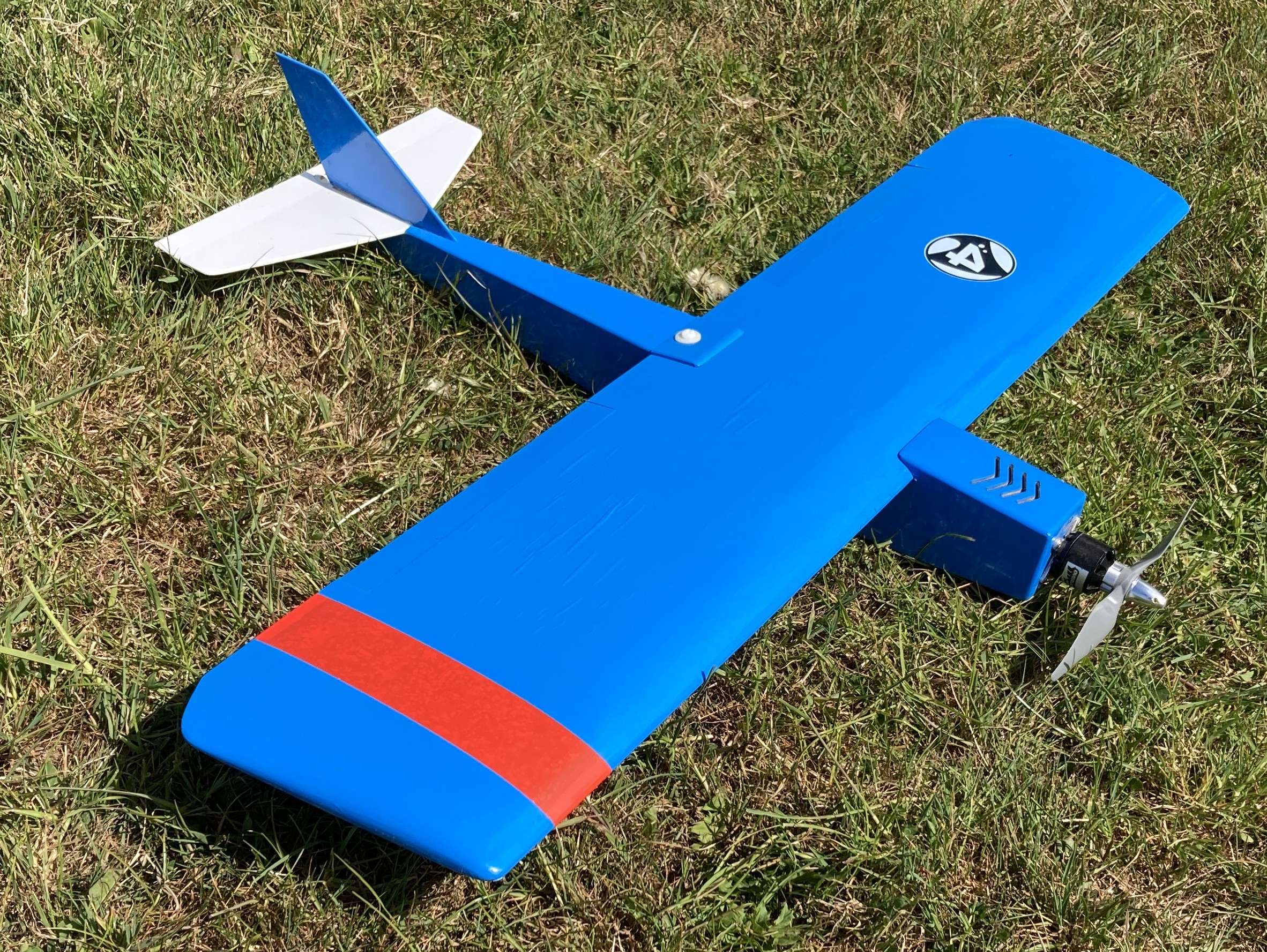 I went off with about 3/4 throttle to avoid torque issues. 1066 launched it and it climbed away rapidly, with only a little aileron trim required. Once I’d gained some confidence I opened up the throttle and listened to it whistle! No issues with the AR6210 Rx – it covered a lot of sky without any problem. It’s a big grin model for remarkably little cost.
I went off with about 3/4 throttle to avoid torque issues. 1066 launched it and it climbed away rapidly, with only a little aileron trim required. Once I’d gained some confidence I opened up the throttle and listened to it whistle! No issues with the AR6210 Rx – it covered a lot of sky without any problem. It’s a big grin model for remarkably little cost.
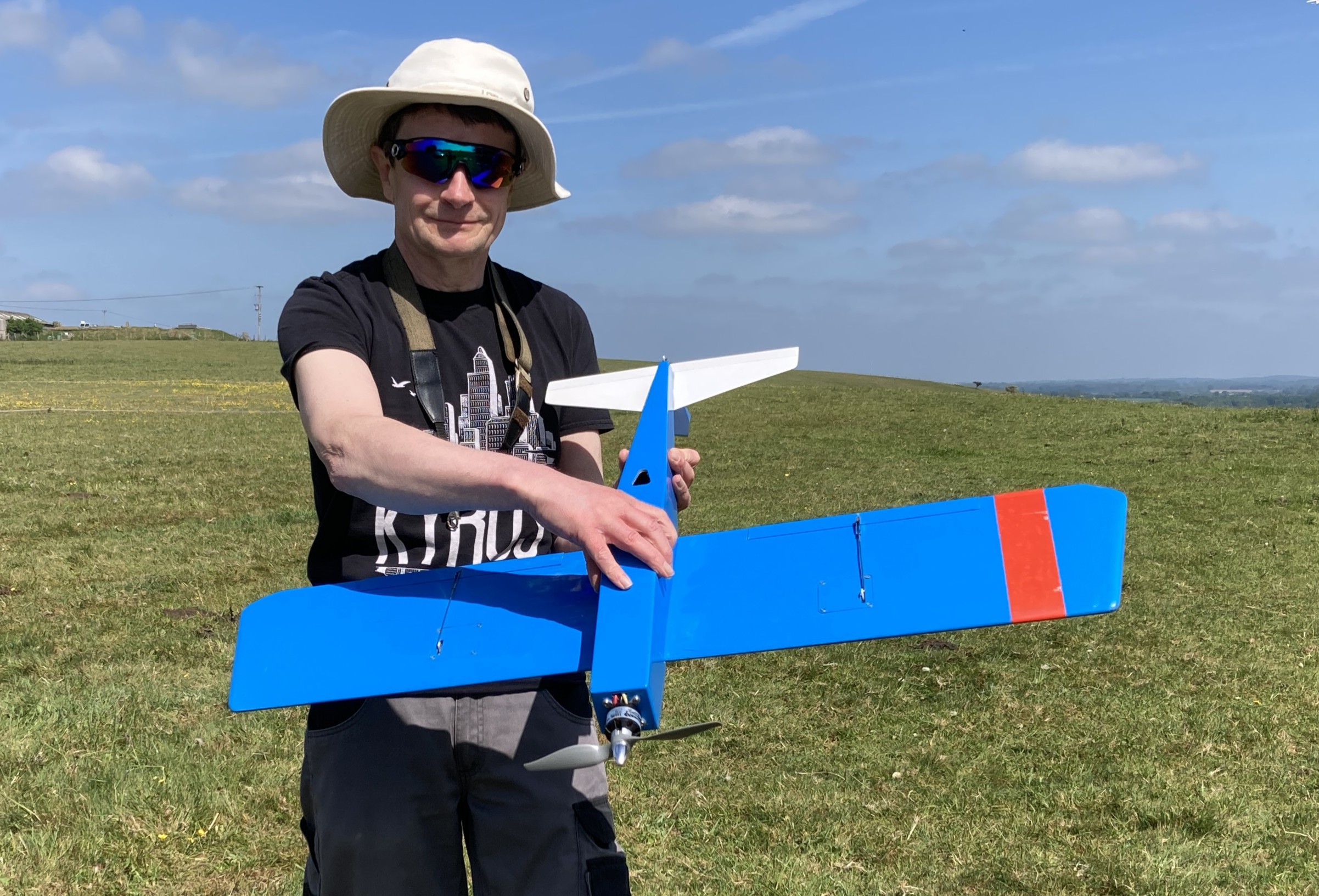 The motor is an Overlander T3536/05, 1500kV, with an 8 x 6.5 prop. The ESC is a Red Brick, but it’s glued in (what kind of psychopath does that?!) and I can’t read the label.
The motor is an Overlander T3536/05, 1500kV, with an 8 x 6.5 prop. The ESC is a Red Brick, but it’s glued in (what kind of psychopath does that?!) and I can’t read the label. 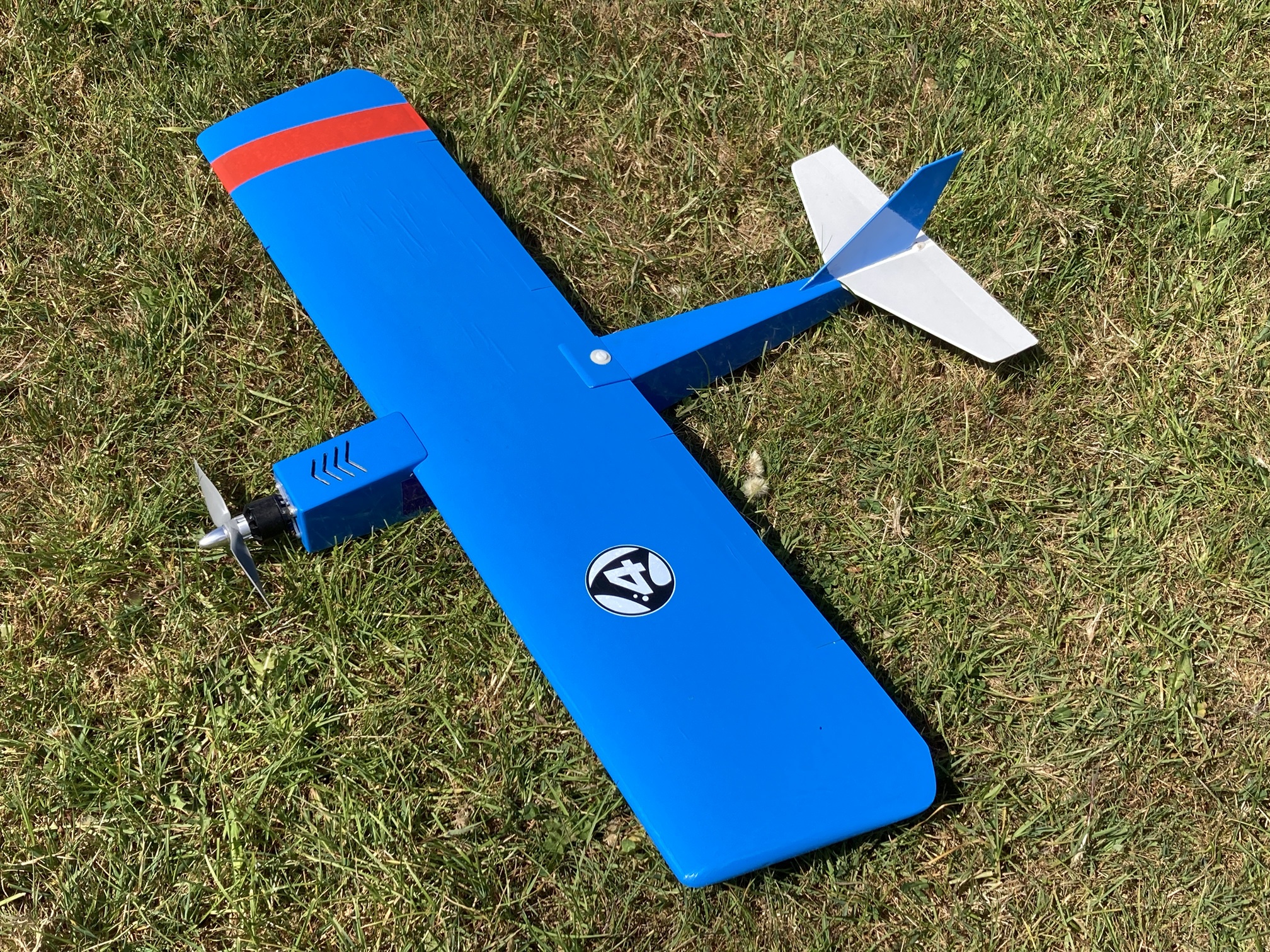 My first flight was 5 minutes, but I only had 10% left in the pack, so I dialled it down to 3 and a half minutes for the second flight, and came down with 33%.
My first flight was 5 minutes, but I only had 10% left in the pack, so I dialled it down to 3 and a half minutes for the second flight, and came down with 33%.
Thanks for that Dougal, the Wasp certainly looks good, and fast flying in the video.
Another new model that flew in May was 1066’s Voltigeur. This is the second Voltigeur that’s been owned by a PAM member, the first one being Cream Egg, but I’m not sure that one is still flying, I seem to remember he had a rather ‘abrupt arrival’ a while back! I’m sure that won’t happen with 1066, he’s much more experienced with aerobatic machines.
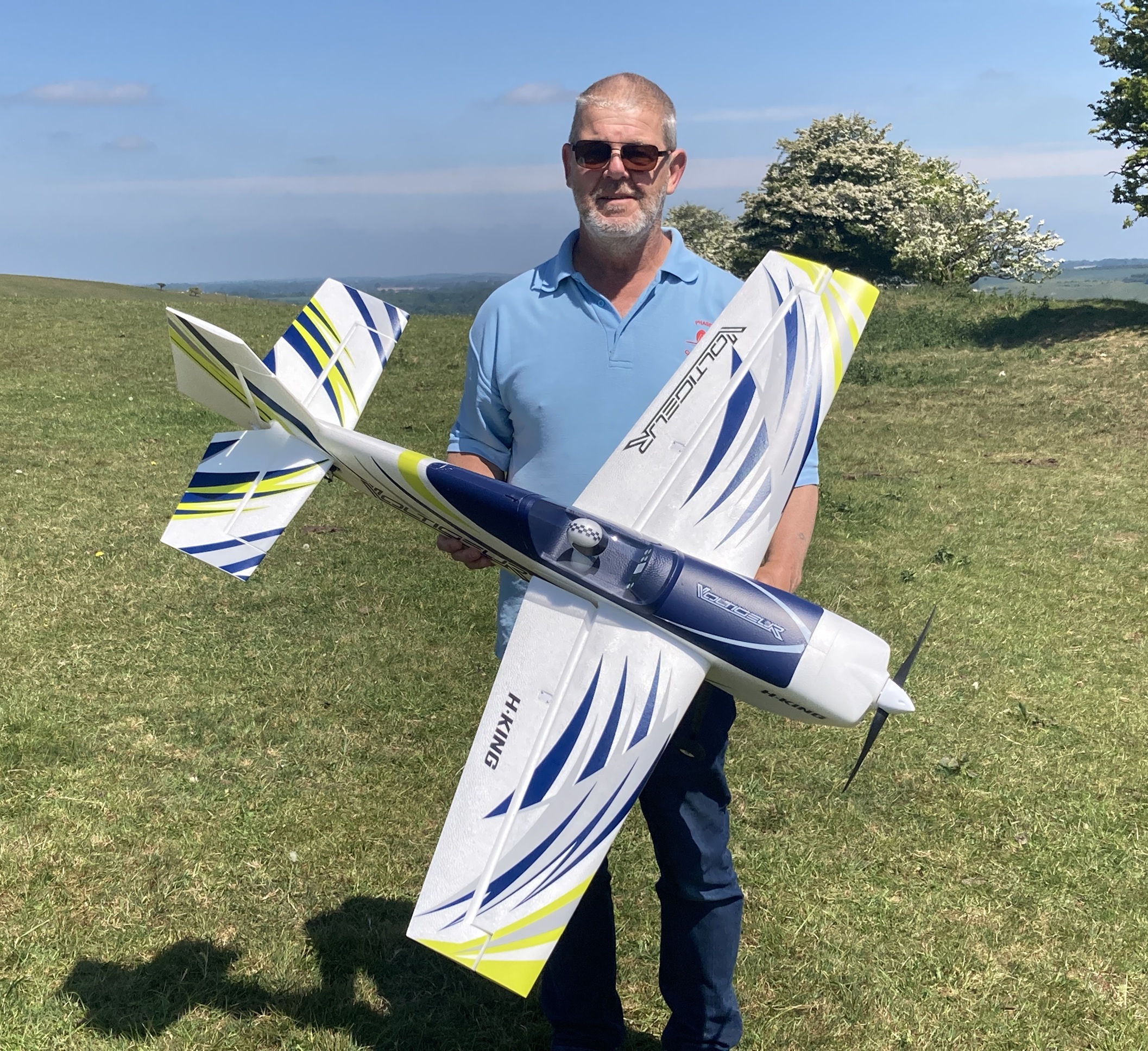 1066 bought his Voltigeur secondhand on Facebook Marketplace for just £125, a real bargain as the current new price is over £200. The plane was still in it’s box and 1066 thinks it has never flown. It was a case of being in the right place at the right time as the seller was within walking distance of where 1066 happened to be when he spotted the ad. The Voltigeur is a 1220mm wingspan EPO moulded 3D model from HobbyKing who say this about it: The Voltigeur is a well-known performer and we’ve just taken it to the next level. Flying the Voltigeur is a dream, using the recommended 3S Lipo battery for aerobatics and sports flying it handles like a trainer, docile, and extremely predictable.
1066 bought his Voltigeur secondhand on Facebook Marketplace for just £125, a real bargain as the current new price is over £200. The plane was still in it’s box and 1066 thinks it has never flown. It was a case of being in the right place at the right time as the seller was within walking distance of where 1066 happened to be when he spotted the ad. The Voltigeur is a 1220mm wingspan EPO moulded 3D model from HobbyKing who say this about it: The Voltigeur is a well-known performer and we’ve just taken it to the next level. Flying the Voltigeur is a dream, using the recommended 3S Lipo battery for aerobatics and sports flying it handles like a trainer, docile, and extremely predictable. 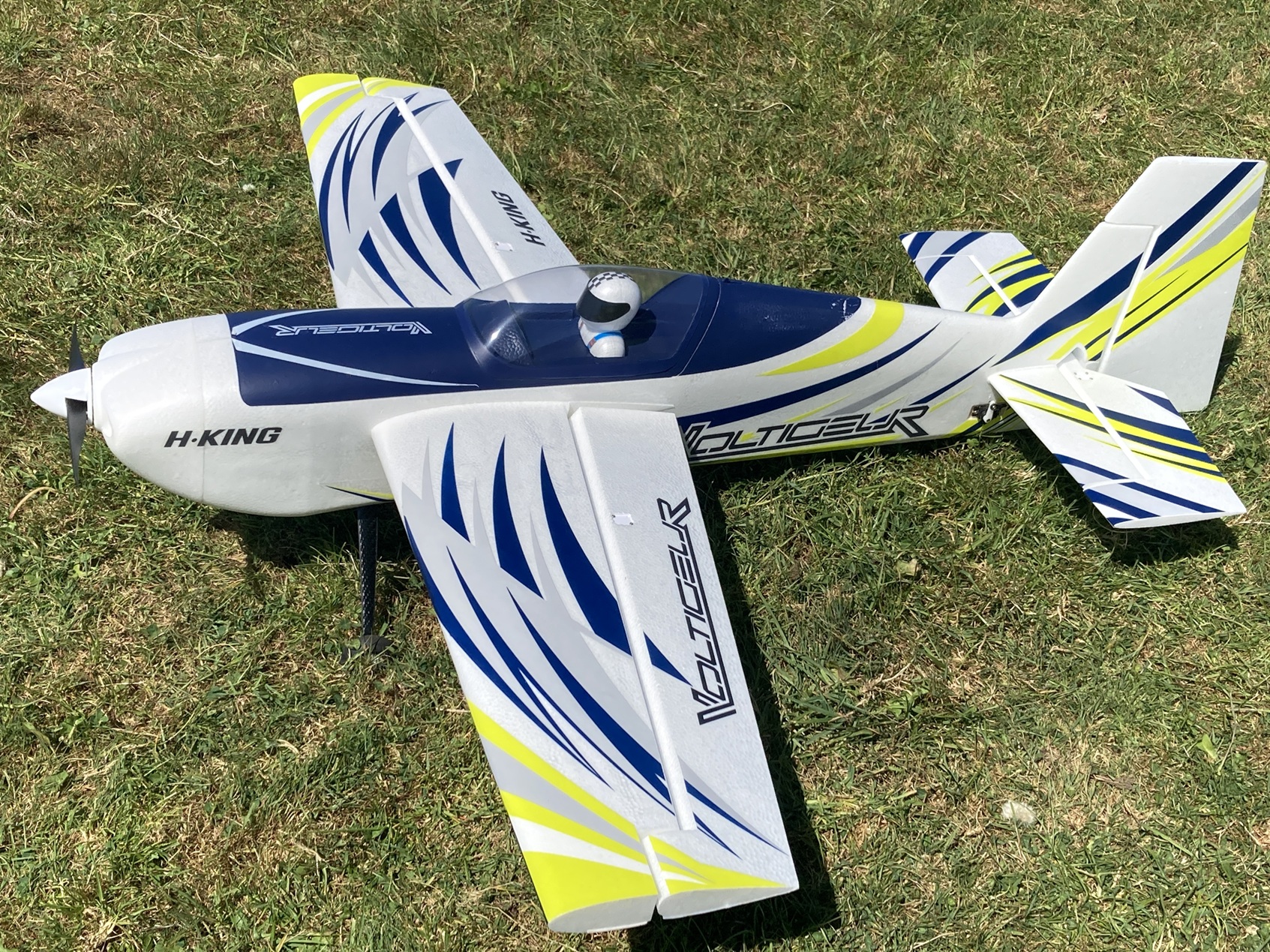 Everything from rolling circles, waterfalls, inverted harriers, and blenders, nothing will stop the Voltigeur. We have improved the drive train to provide even more power (1900g thrust), better efficiency, and cooler running with a 5% lower temperature). To help with the extremes of 3D flying the servo arms have been beefed up and the landing gear has been improved with carbon fiber legs. No more applying stickers as they are factory-fitted too. There is even a bigger, better ESC access hole for more airflow.
Everything from rolling circles, waterfalls, inverted harriers, and blenders, nothing will stop the Voltigeur. We have improved the drive train to provide even more power (1900g thrust), better efficiency, and cooler running with a 5% lower temperature). To help with the extremes of 3D flying the servo arms have been beefed up and the landing gear has been improved with carbon fiber legs. No more applying stickers as they are factory-fitted too. There is even a bigger, better ESC access hole for more airflow.
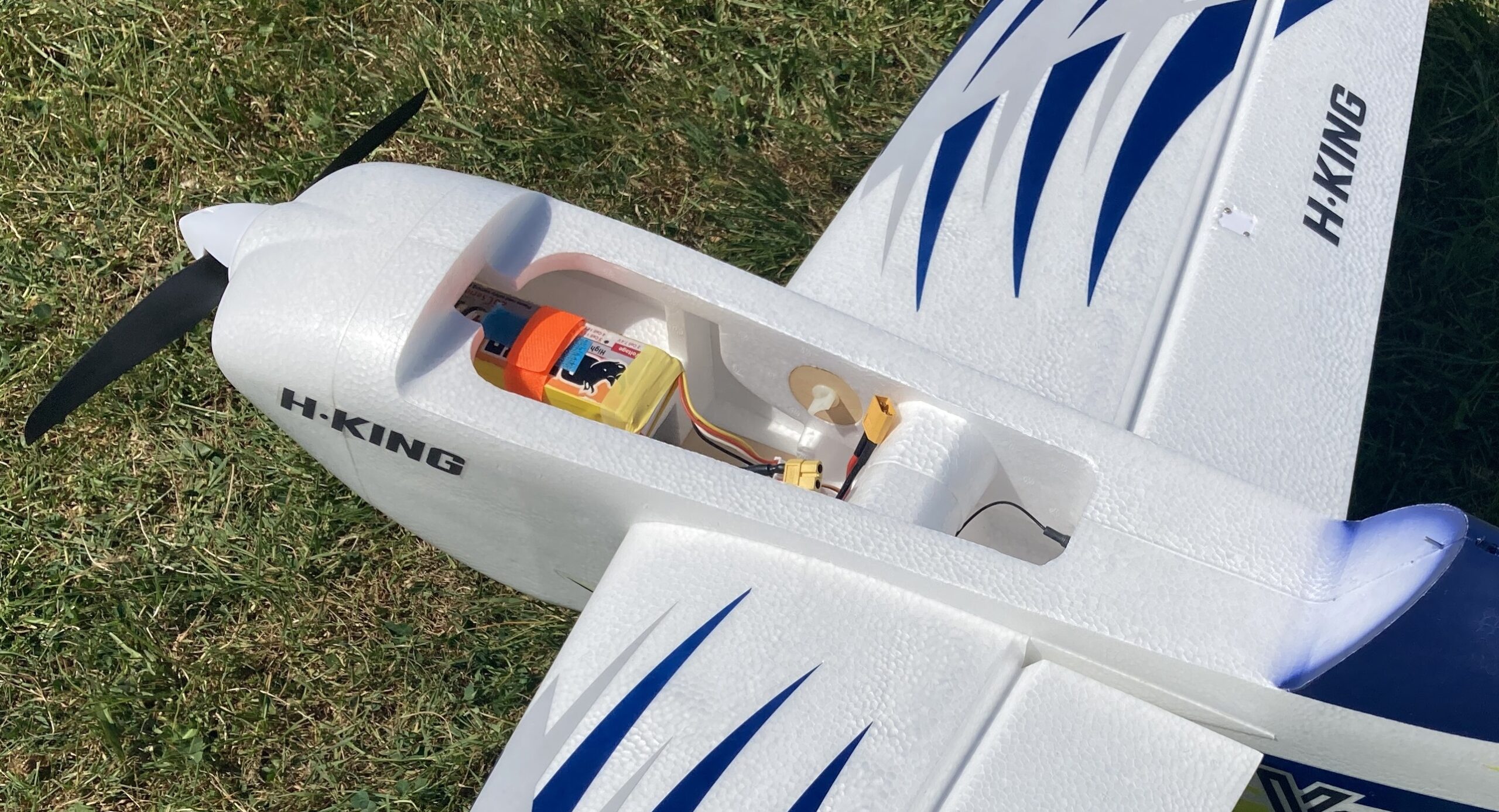 Want even more power? Then fit a 4S battery. You will notice straight away the extra speed and power, you’ll be able to use that extra power and quicker throttle response during your maneuvers. This added power will make your pop tops, rifle rolls, and all the extreme 3D moves that much more aggressive, ideal for experienced 3D pilots.
Want even more power? Then fit a 4S battery. You will notice straight away the extra speed and power, you’ll be able to use that extra power and quicker throttle response during your maneuvers. This added power will make your pop tops, rifle rolls, and all the extreme 3D moves that much more aggressive, ideal for experienced 3D pilots.
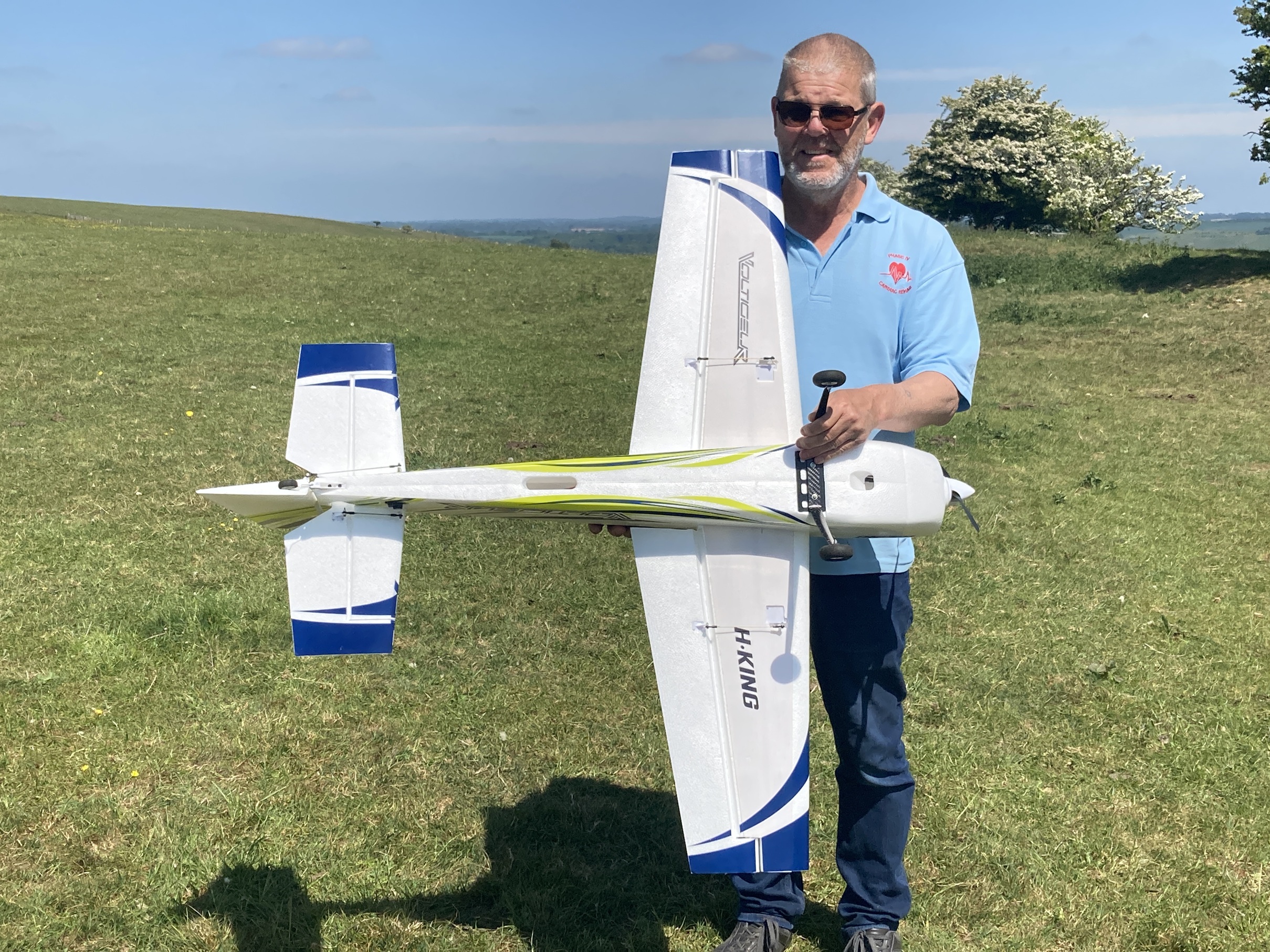
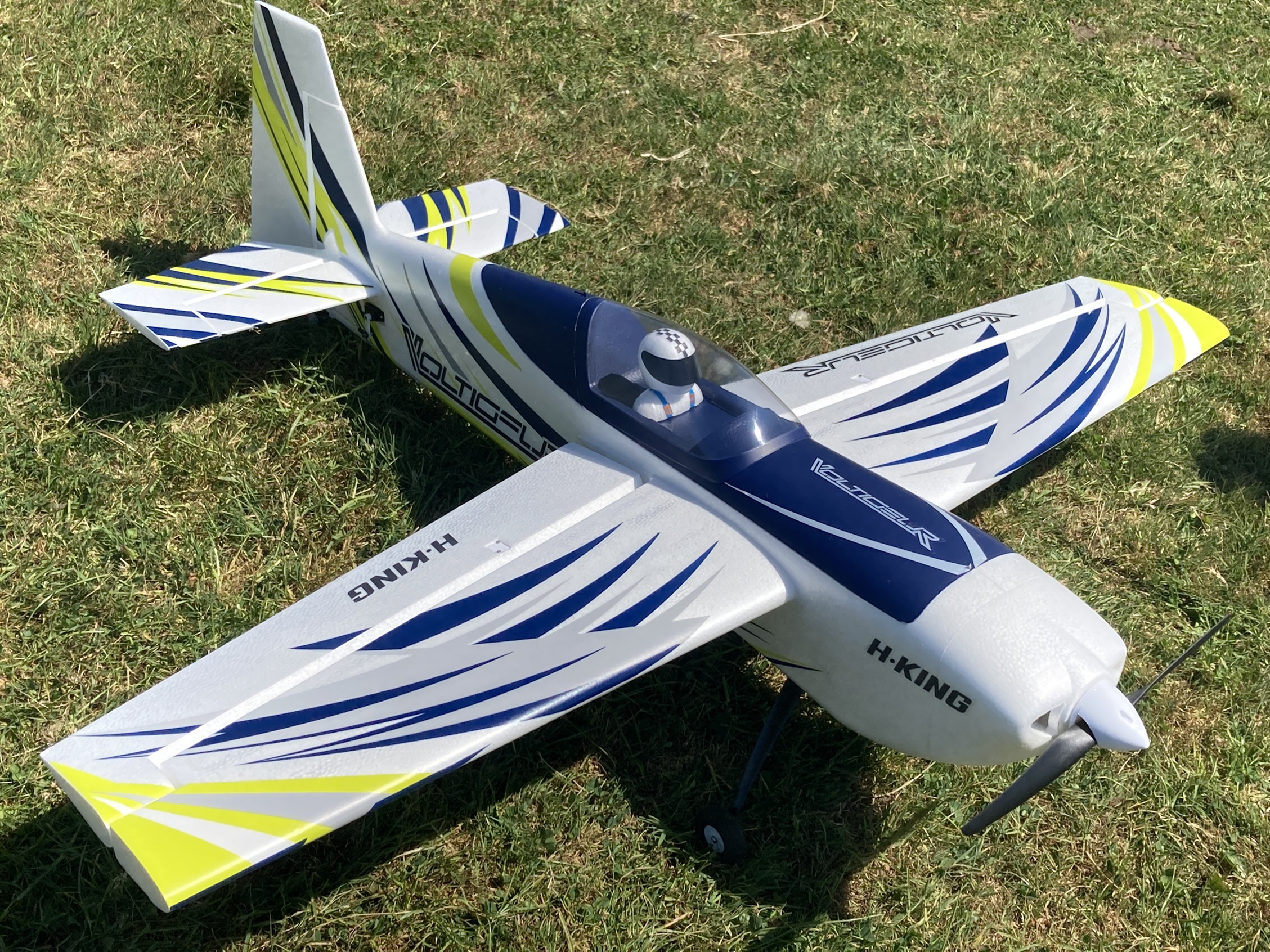 The Voltigeur is a true aerobatic performer and an extreme 3D flying machine. Construction is from lightweight EPO foam and features large control surfaces coupled with masses of power. Perfectly balanced with a mid-mounted full symmetrical wing, large battery compartment, composite glass fiber wing tube, metal gear high-speed servos all around, and all electronics pre-installed. Orientation is not a problem with the highly visible and unique color scheme. The HobbyKing info above is for the Mk2 version and 1066’s is presumably the Mk1 version. He is currently using a three cell lipo which seems to be enough judging by how the Voltigeur is performing in the video, it looks good.
The Voltigeur is a true aerobatic performer and an extreme 3D flying machine. Construction is from lightweight EPO foam and features large control surfaces coupled with masses of power. Perfectly balanced with a mid-mounted full symmetrical wing, large battery compartment, composite glass fiber wing tube, metal gear high-speed servos all around, and all electronics pre-installed. Orientation is not a problem with the highly visible and unique color scheme. The HobbyKing info above is for the Mk2 version and 1066’s is presumably the Mk1 version. He is currently using a three cell lipo which seems to be enough judging by how the Voltigeur is performing in the video, it looks good.
Returning home from St Kitts we walked out and boarded the plane in bright sunshine but then, as we taxied out, the heavens opened and the rain was torrential as we took-off.
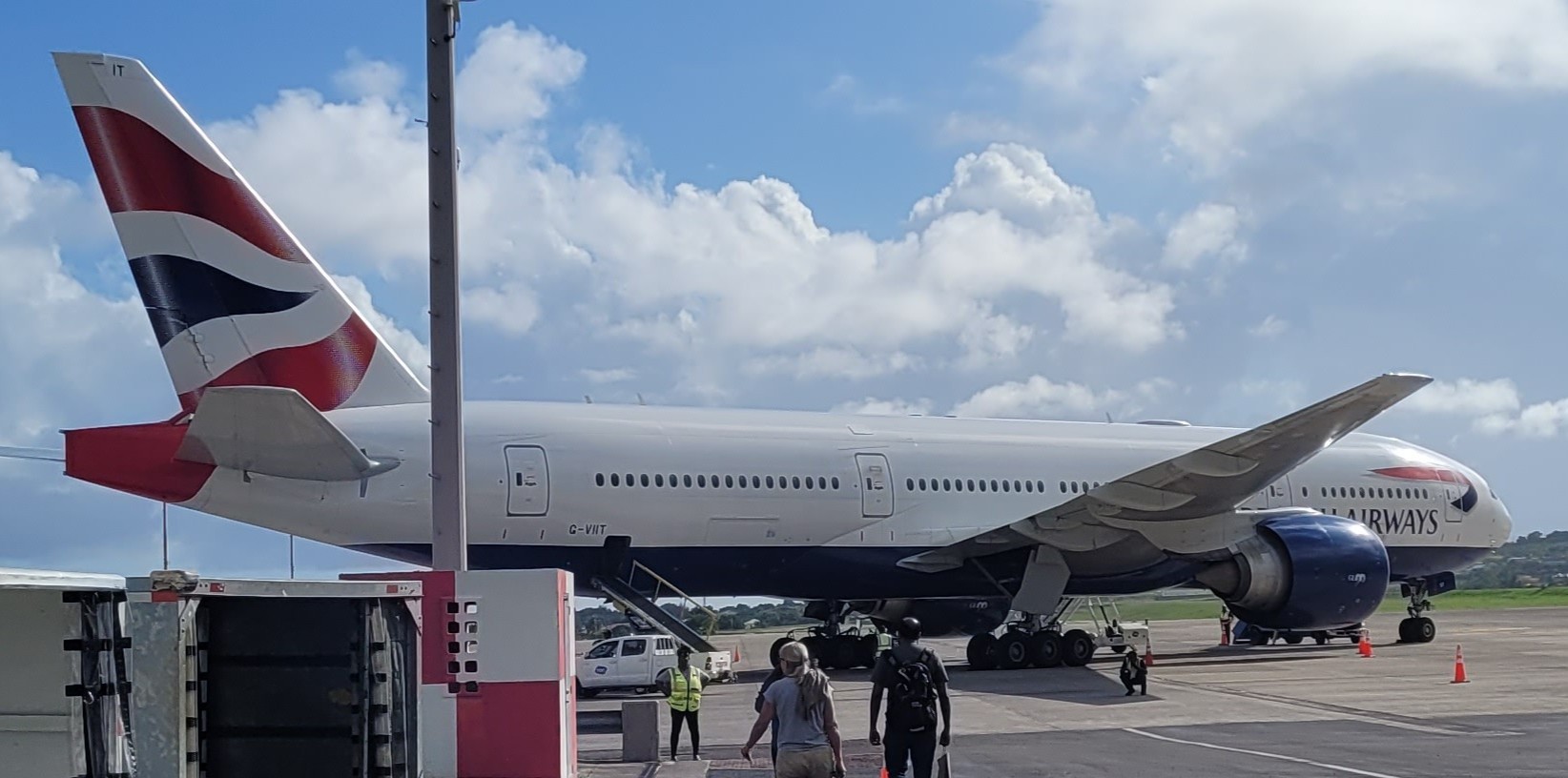 The first leg of the journey is just a short twenty minute hop to Antigua where we landed in sunshine. All the passengers stayed aboard while lots more got on, and the Boeing 777 was fuelled for the Gatwick flight. While we were on the ground I was able to visit the cockpit and was chatting to the crew when two British Airways maintenance guys turned up.
The first leg of the journey is just a short twenty minute hop to Antigua where we landed in sunshine. All the passengers stayed aboard while lots more got on, and the Boeing 777 was fuelled for the Gatwick flight. While we were on the ground I was able to visit the cockpit and was chatting to the crew when two British Airways maintenance guys turned up.
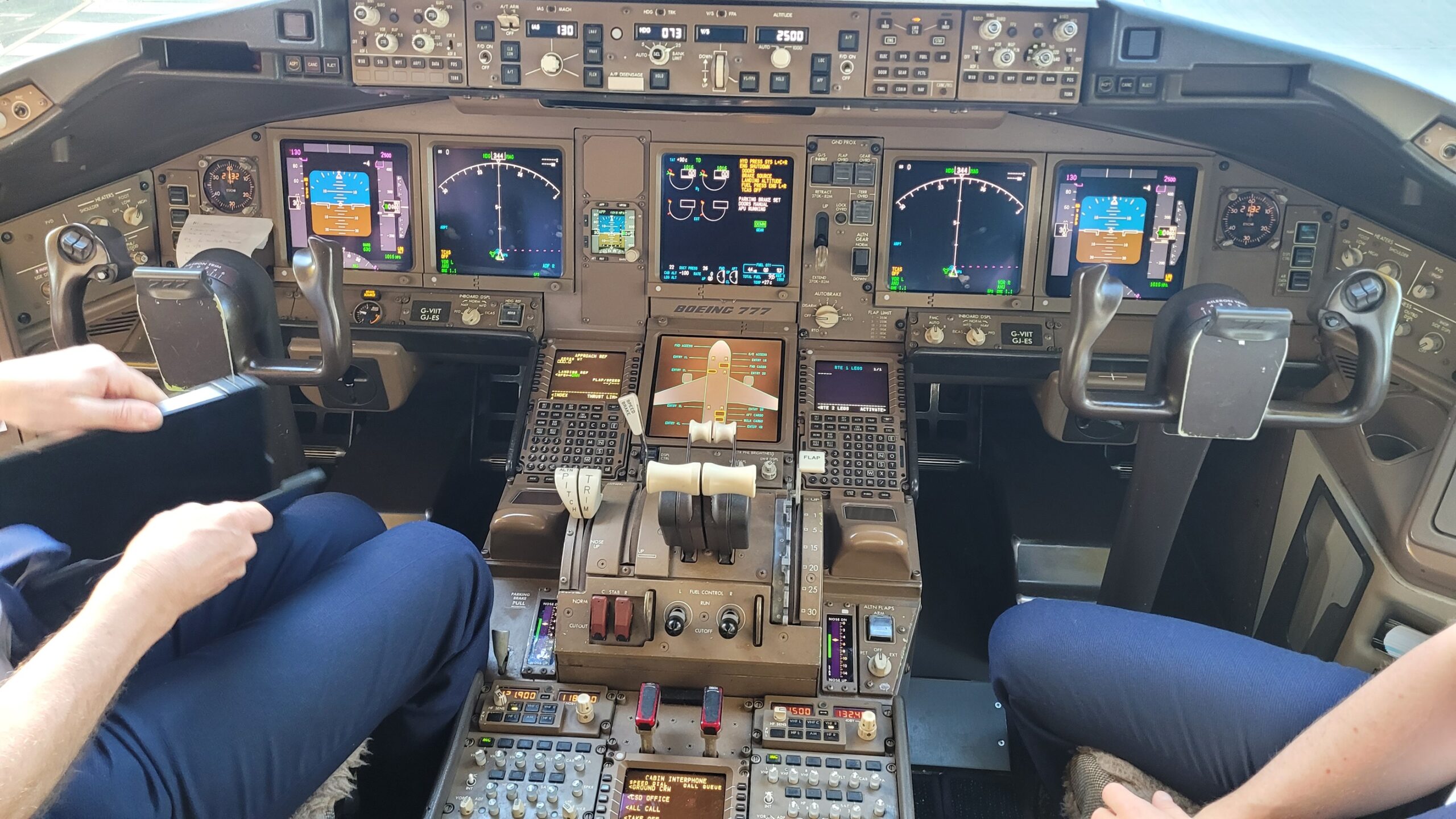 The Captain explained that the windscreen wiper on his side was rubbish and he couldn’t see a thing when we took-off but fortunately the Co-Pilot could! They then wound open the cockpit side window and a maintenance guy hung out of it and changed the wiper blade.
The Captain explained that the windscreen wiper on his side was rubbish and he couldn’t see a thing when we took-off but fortunately the Co-Pilot could! They then wound open the cockpit side window and a maintenance guy hung out of it and changed the wiper blade.
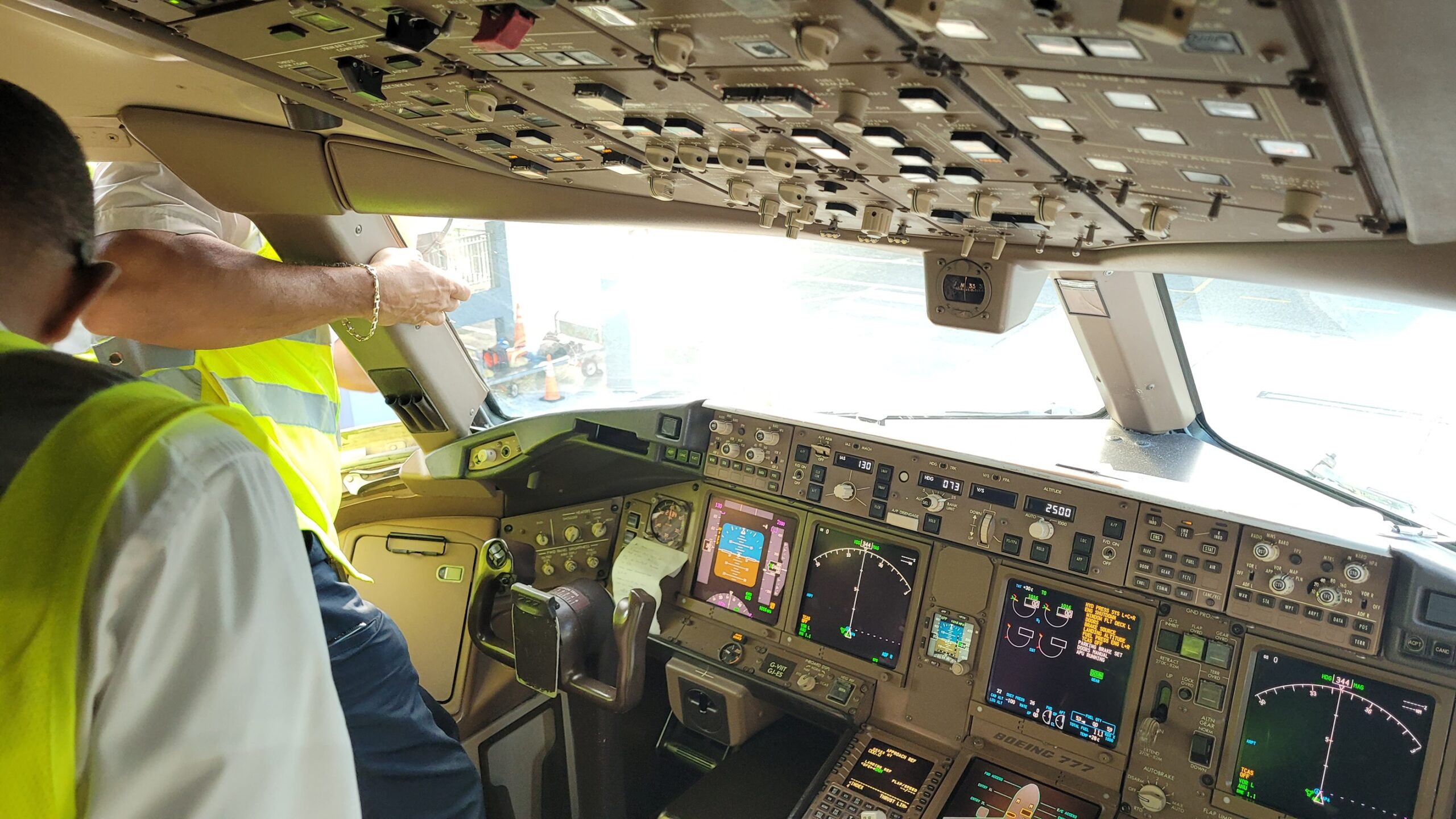
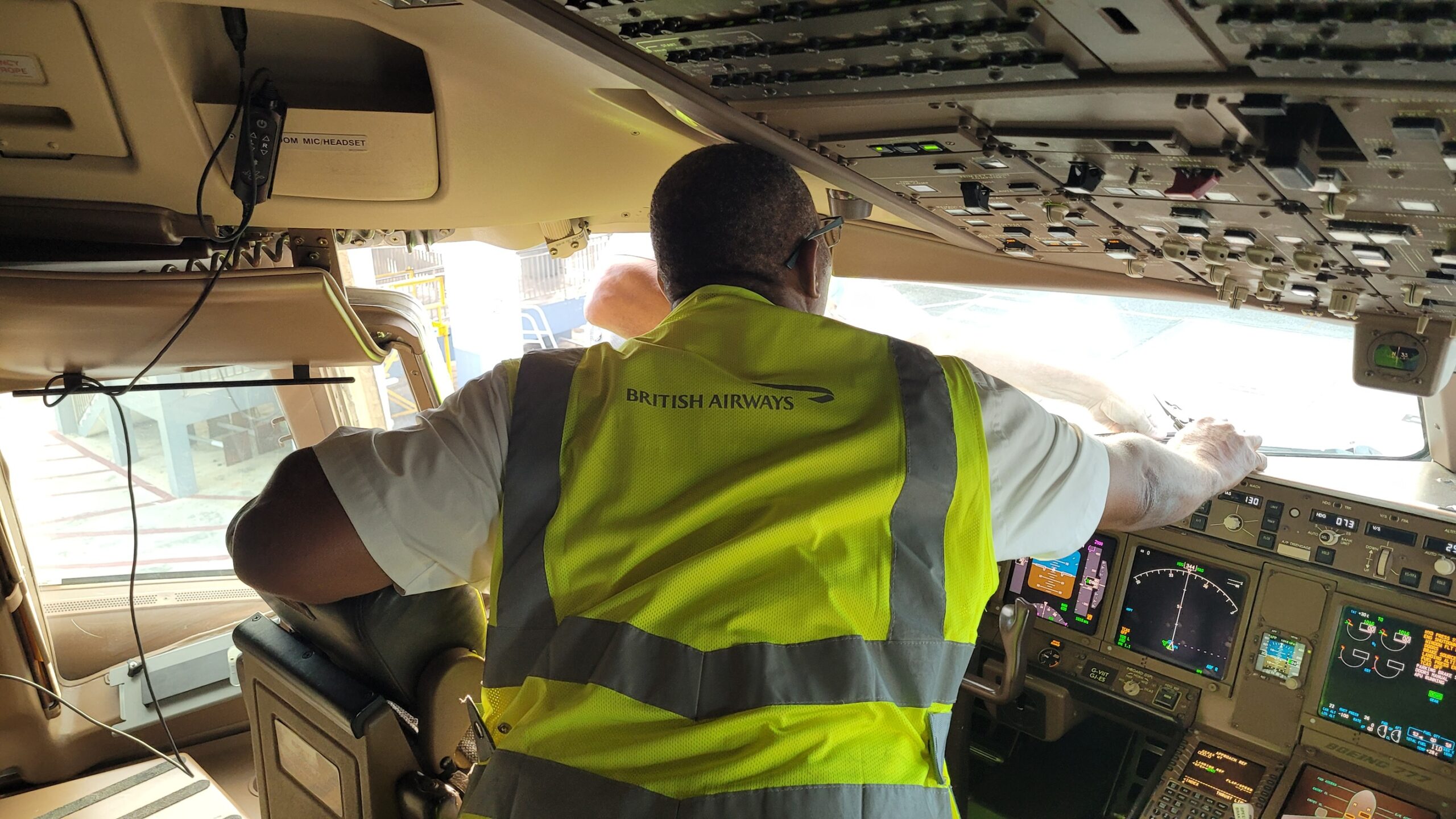 The Captain said if they had waited to change it at Gatwick if would have involved a cherry picker, a mountain of paperwork, and a delay! When they’d finished the Captain told me “Boeing made a great aircraft but they used windscreen wipers from an old Ford Fiesta!”
The Captain said if they had waited to change it at Gatwick if would have involved a cherry picker, a mountain of paperwork, and a delay! When they’d finished the Captain told me “Boeing made a great aircraft but they used windscreen wipers from an old Ford Fiesta!”
I was back home in time to test fly the last new model to fly in May, Woody’s XFly Glastar.
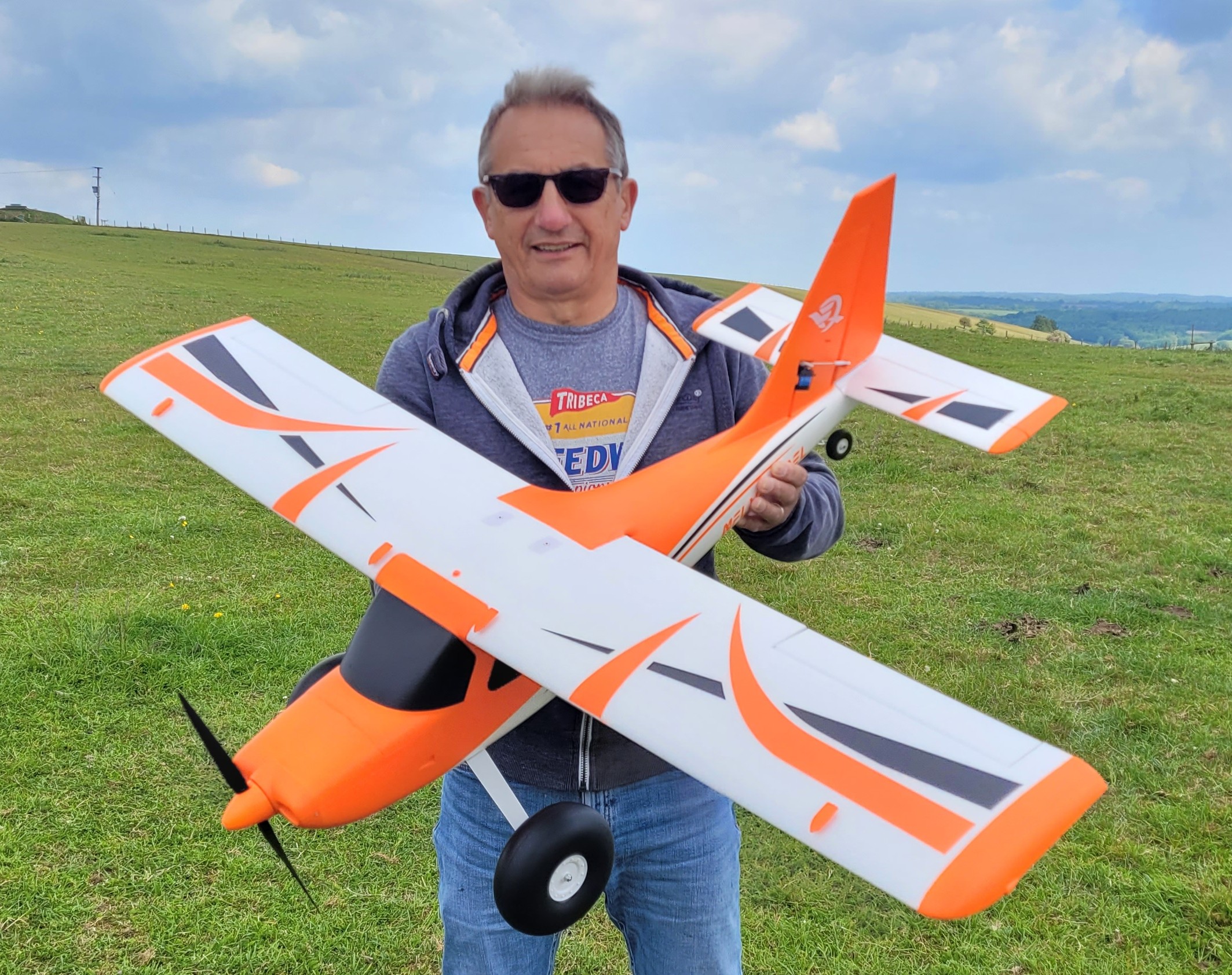 The 1233mm wingspan Glastar is a smaller version of the 1500mm span Tasman and other than the size they look identical, although the Tasman has flaps but the Glastar doesn’t.
The 1233mm wingspan Glastar is a smaller version of the 1500mm span Tasman and other than the size they look identical, although the Tasman has flaps but the Glastar doesn’t. 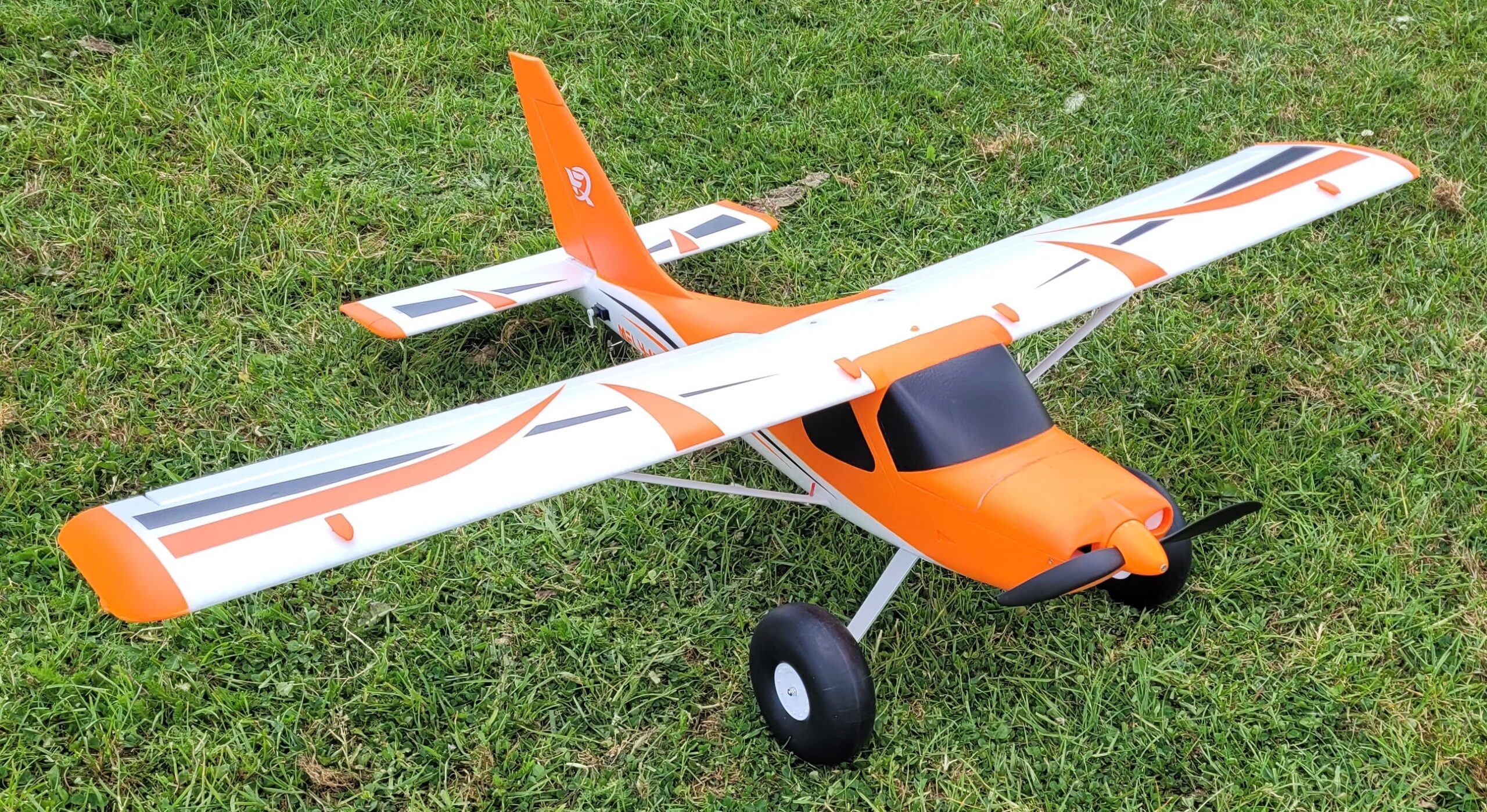 Both Bob the Builder and John Warren fly Tasmans and they appear to be excellent models. Woody’s Glastar is an attractive little model and it proved to be a delight to fly, no problems at all and I soon handed the transmitter over to Woody to enjoy it for himself.
Both Bob the Builder and John Warren fly Tasmans and they appear to be excellent models. Woody’s Glastar is an attractive little model and it proved to be a delight to fly, no problems at all and I soon handed the transmitter over to Woody to enjoy it for himself.
It seems like an ideal model for our field with its large wheels and totally benign handling.
You can see how it flew on it’s very first flight in this month’s video.
Instead of the usual ‘action’ shots here are some of Dougal’s pics from the Popham Show: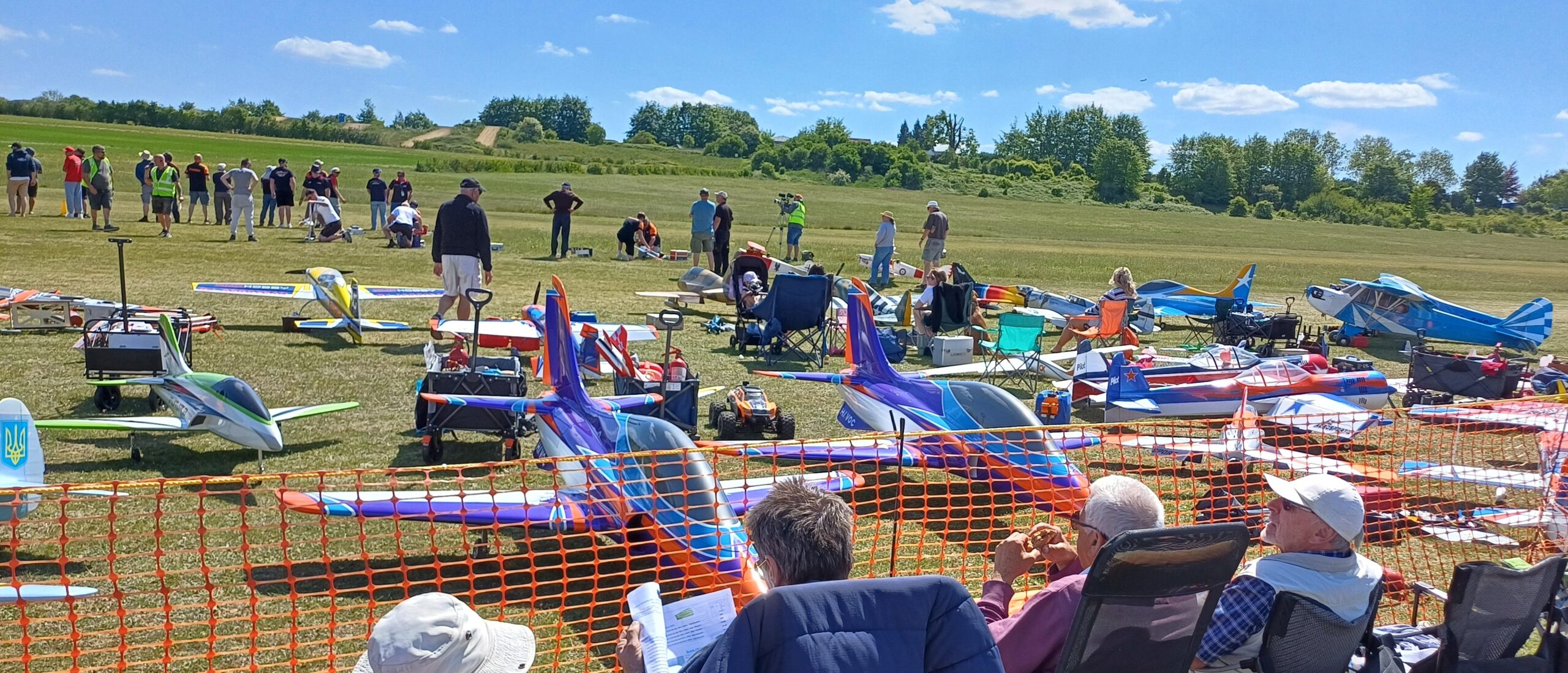
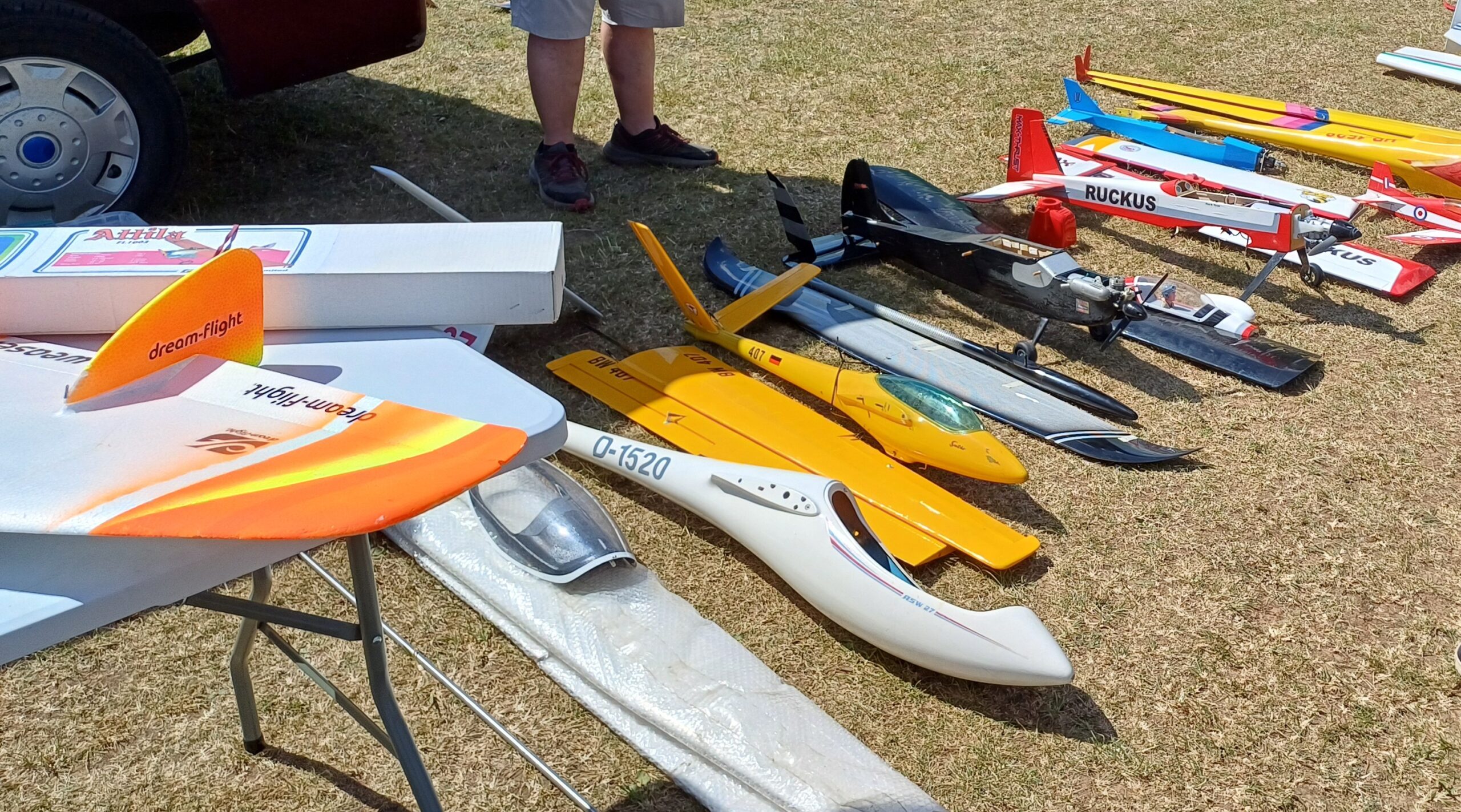
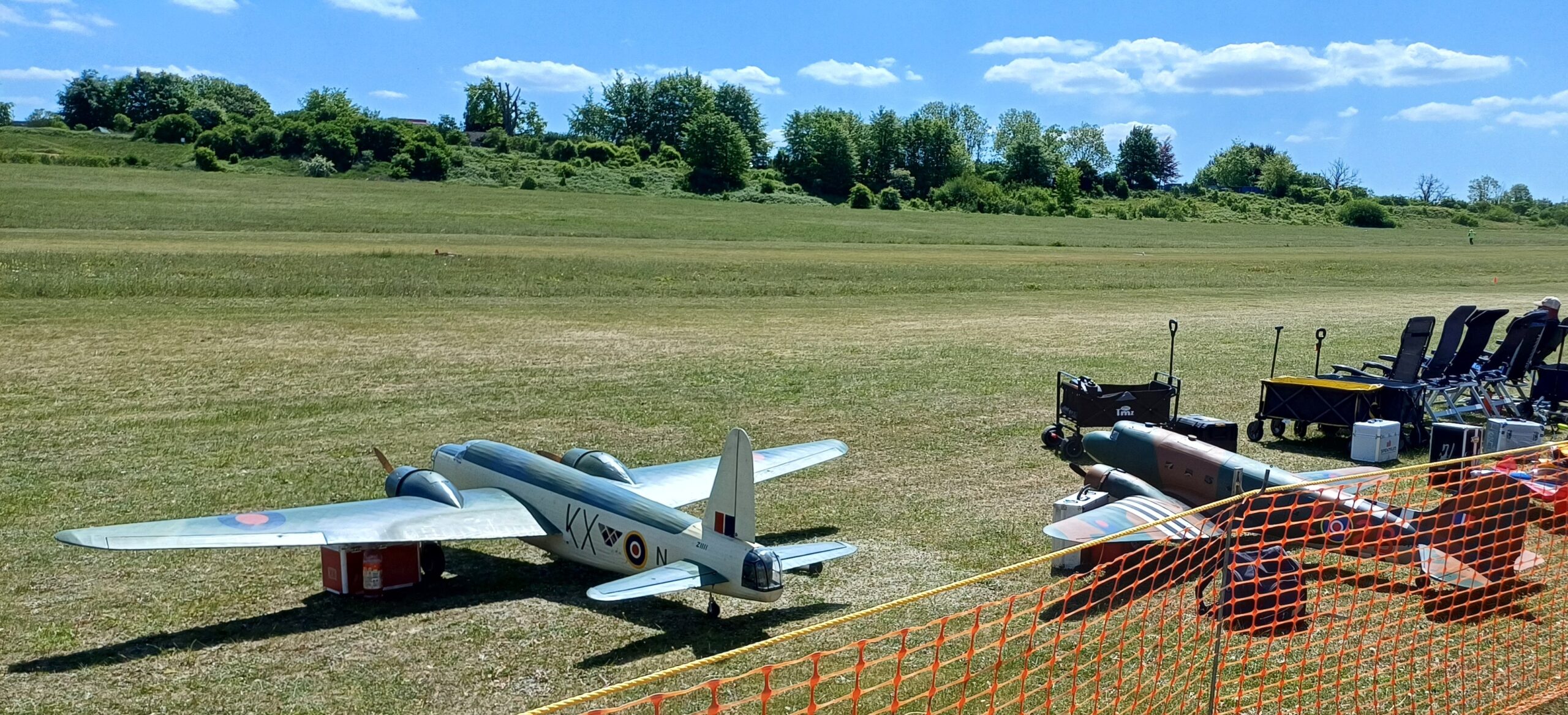
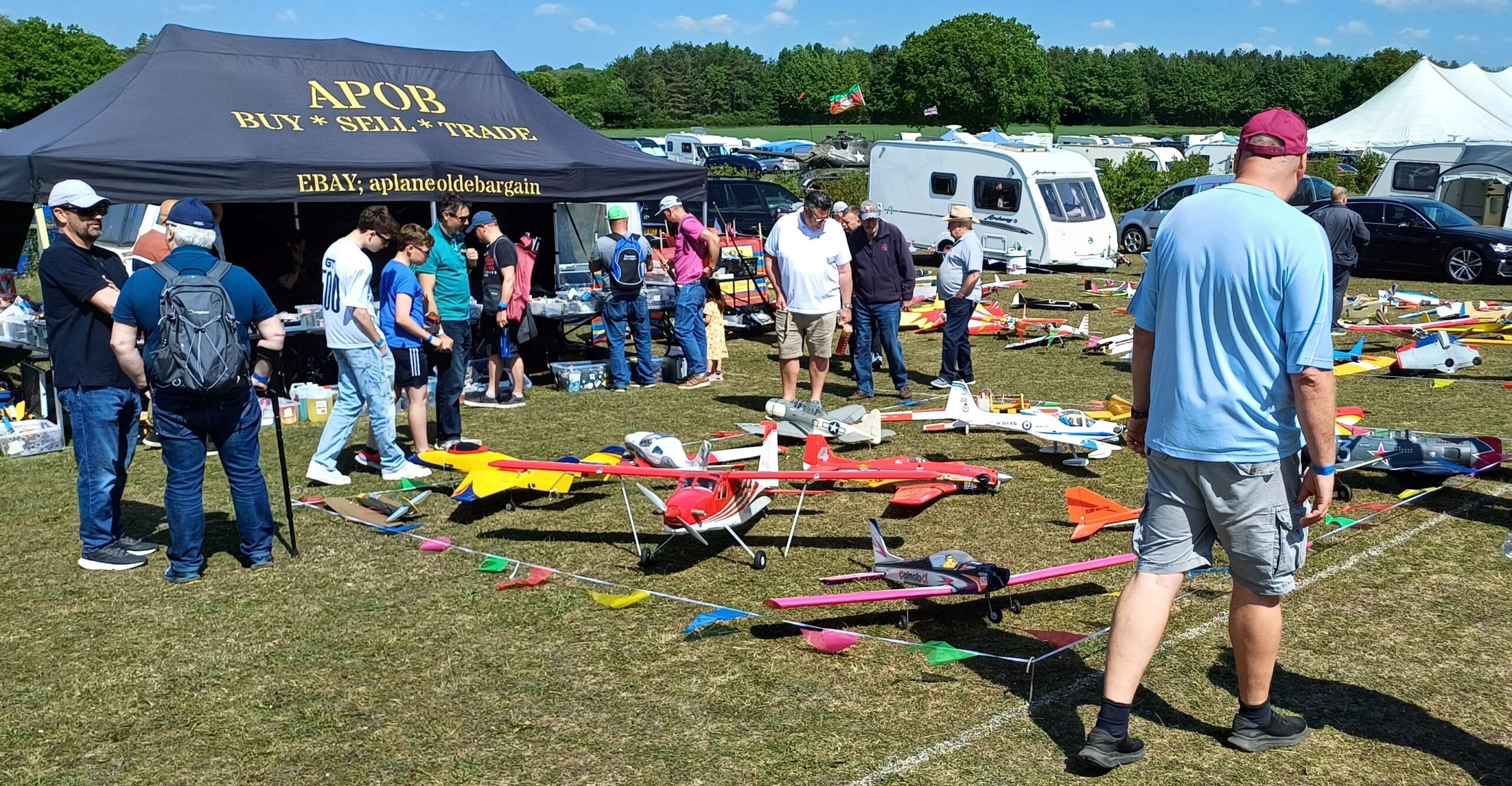
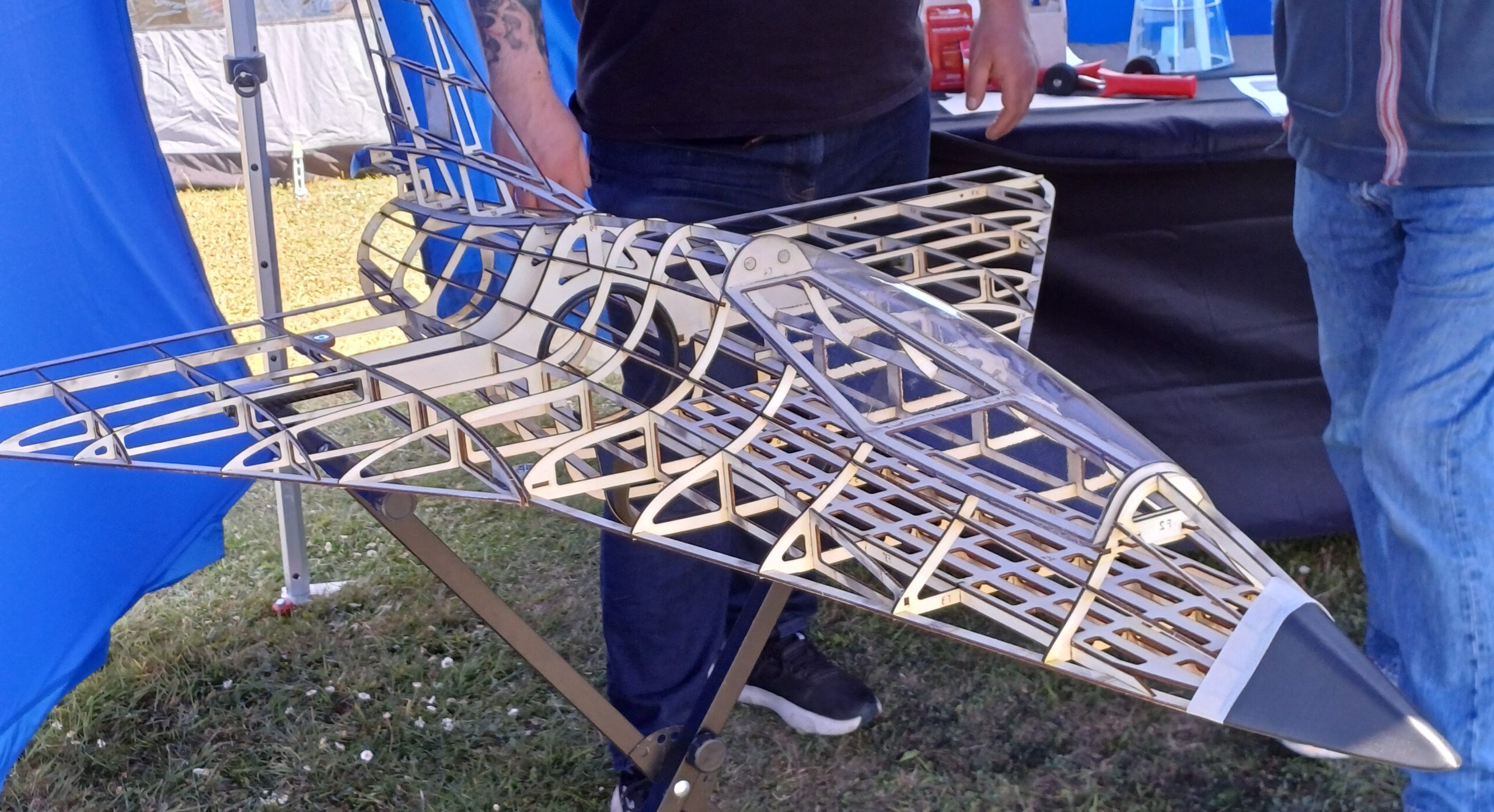
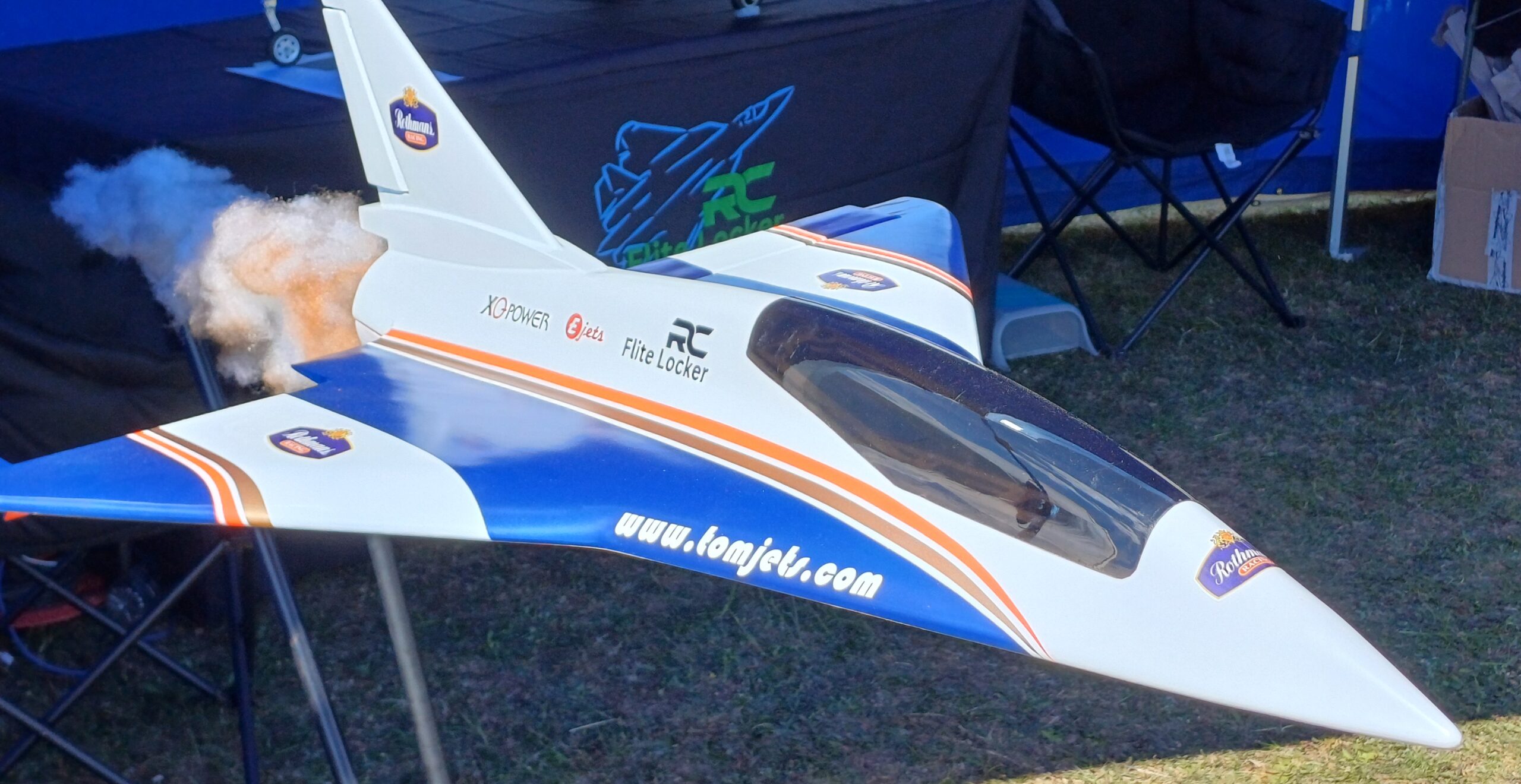
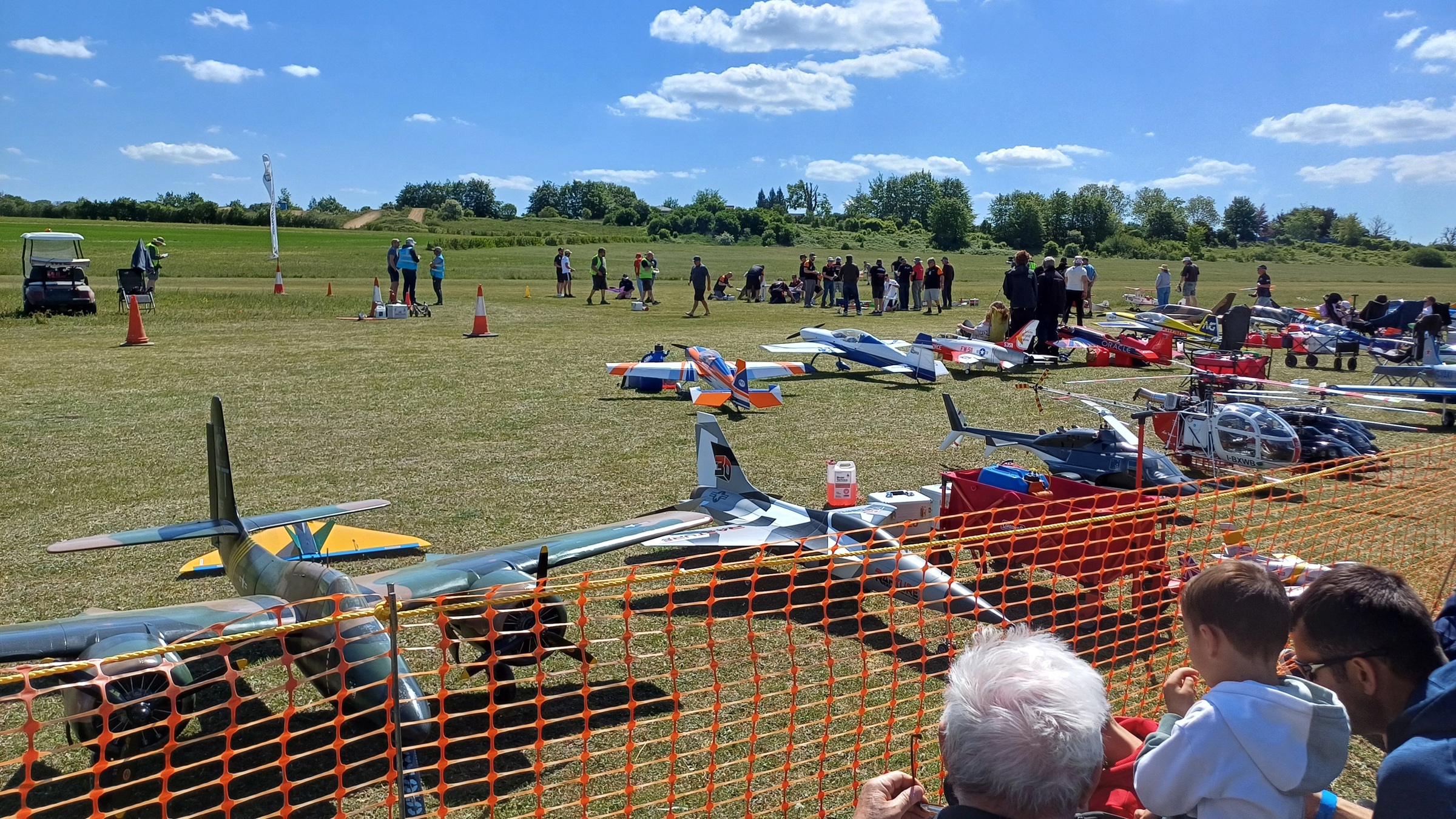

Video time now, this month with footage shot by MacFly, and Dougal Entendre.
Please watch the video full-screen, it’s so much better with small models flying around:
If the video won’t play for you please click HERE
Final Funny:
When a British Airways Boeing 737 touched down at Frankfurt airport the Air Traffic Controller was obviously in a bit of a frivolous mood and he transmitted:
“Speedbird 123. Nice landing Captain, but a little left of the centre-line I think.”
Quick as a flash, the BA Captain replied in a cool, suave English accent:
“Roger Frankfurt Tower. Perfectly correct. I am a little to the left of the centre-line. And my co-pilot is a little to the right of it.”
Colin Cowplain
Patch News – April 2025
This month’s Patch News will only include events of the first three weeks of April as I was away for the last week. But there’s lots to talk about, some flying and some non-flying.
The month began with gloriously sunny but windy weather, exactly as March had ended, and it seemed to continue for ages. The strong wind was from the east so it was perfect for the MVSA slope soarers and they were flying at the same time as us on several occasions.
But of course the wind was also in the right direction for the Sky Surfers with their paragliders and hang gliders. Fortunately, most of the time the wind was too strong for them, especially the paragliders, so we didn’t have to stop flying too many times. As I said last month, they seem to stand around a lot, threatening to fly, often with their wing inflated, but not actually take flight. I can see their point, if we take a chance and fly in unsuitable winds, we might break a model but the only thing that gets hurt is our pride.
A bigger problem was the herd of bullocks in the field which was a much larger herd than we are used to. They had slightly damaged the electric fence once in March and, having repaired it and watched them touch it and back away, we thought our troubles were over.

 But in April they trampled over the fence several times. We changed the wire to a different type but it made no difference, they still wrecked it. There was lots of discussion about the reason, was the cause the old batteries or was the energiser reaching the end of its useful life? We couldn’t be sure so, after the fifth time of arriving to find the fence down and damaged again, the decision was made to replace the batteries, earth rod, and energiser.
But in April they trampled over the fence several times. We changed the wire to a different type but it made no difference, they still wrecked it. There was lots of discussion about the reason, was the cause the old batteries or was the energiser reaching the end of its useful life? We couldn’t be sure so, after the fifth time of arriving to find the fence down and damaged again, the decision was made to replace the batteries, earth rod, and energiser.
These were quickly purchased and on April 12th four of us installed all the new gear.

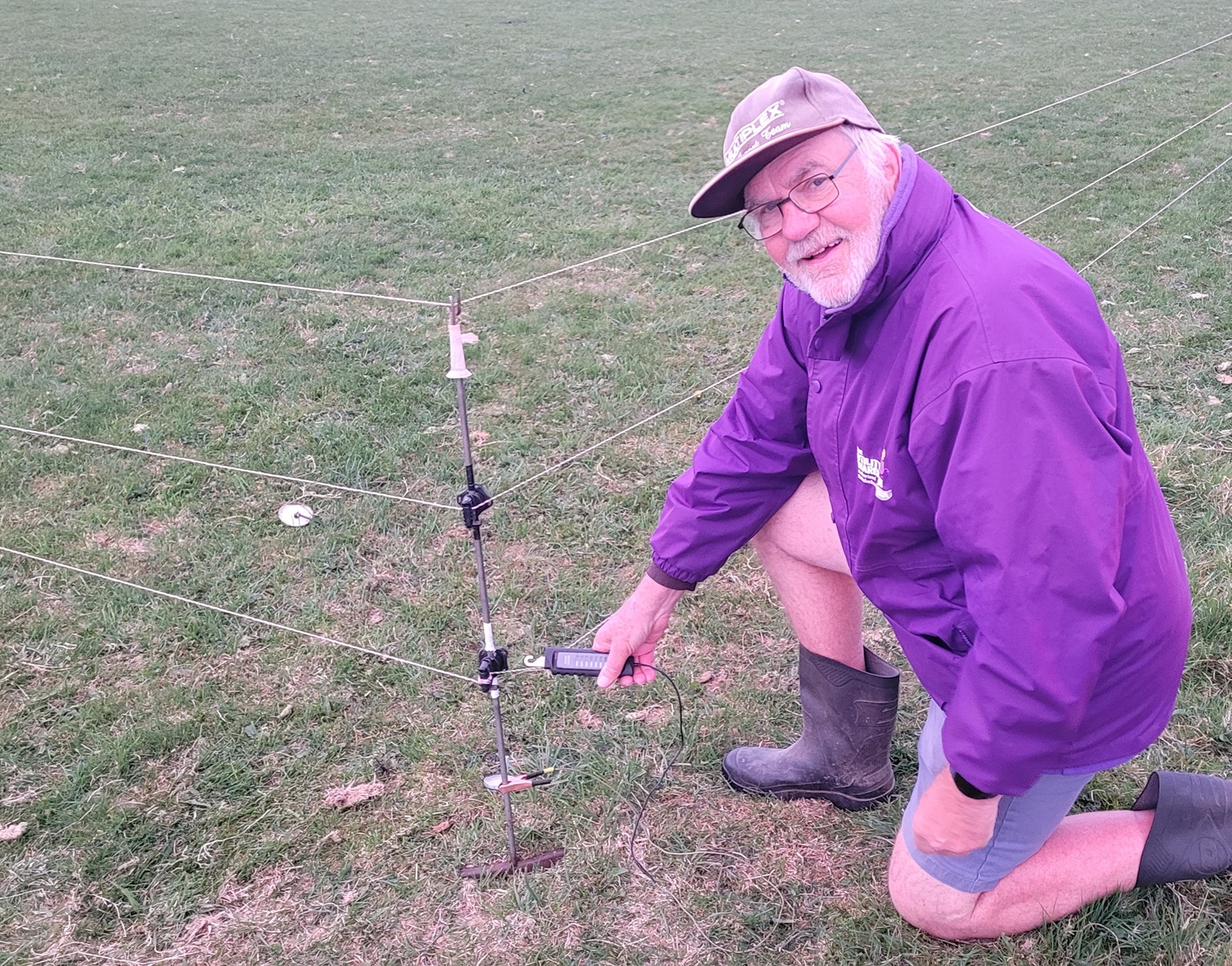
 We were treated to a glorious sunset as we finished the work. By then the bullocks had been moved on to fresh pastures, but when we flew on the 20th a different batch were in the field and the fence was untouched so it seems the new gear has done the trick…hooray!
We were treated to a glorious sunset as we finished the work. By then the bullocks had been moved on to fresh pastures, but when we flew on the 20th a different batch were in the field and the fence was untouched so it seems the new gear has done the trick…hooray!
Last month’s blog went live on 1st April so I felt obliged to include an April Fools piece. But almost nobody seemed to spot it, the only ones who mentioned it were 1066 and Page Boy. So what was it? There was a photo that I said was taken from the video with the comment that Page Boy and Mini Mike’s Avantis had flown towards each other and had a near miss.  But if you watched the video you would have seen that the two Avantis were never even in the air at the same time, let alone close. Also, in the write-up I said ‘it must have been Mini Mike’s fault as he was feeling a bit under the weather at the time…poorly lad, as if.’
But if you watched the video you would have seen that the two Avantis were never even in the air at the same time, let alone close. Also, in the write-up I said ‘it must have been Mini Mike’s fault as he was feeling a bit under the weather at the time…poorly lad, as if.’
Well ‘poorly lad as if’ is an anagram of April Fools Day. Mini Mike told Page Boy that he didn’t remember the near miss so Page Boy explained it to him! 1066 posted a comment on the blog about it being foolish to not fly circuits but nobody picked up on that either!
Lots of new models turned up to fly in April, especially when the strong easterly winds had been replaced by more favourable conditions. First up was Mini Mike’s new Electro Streak. 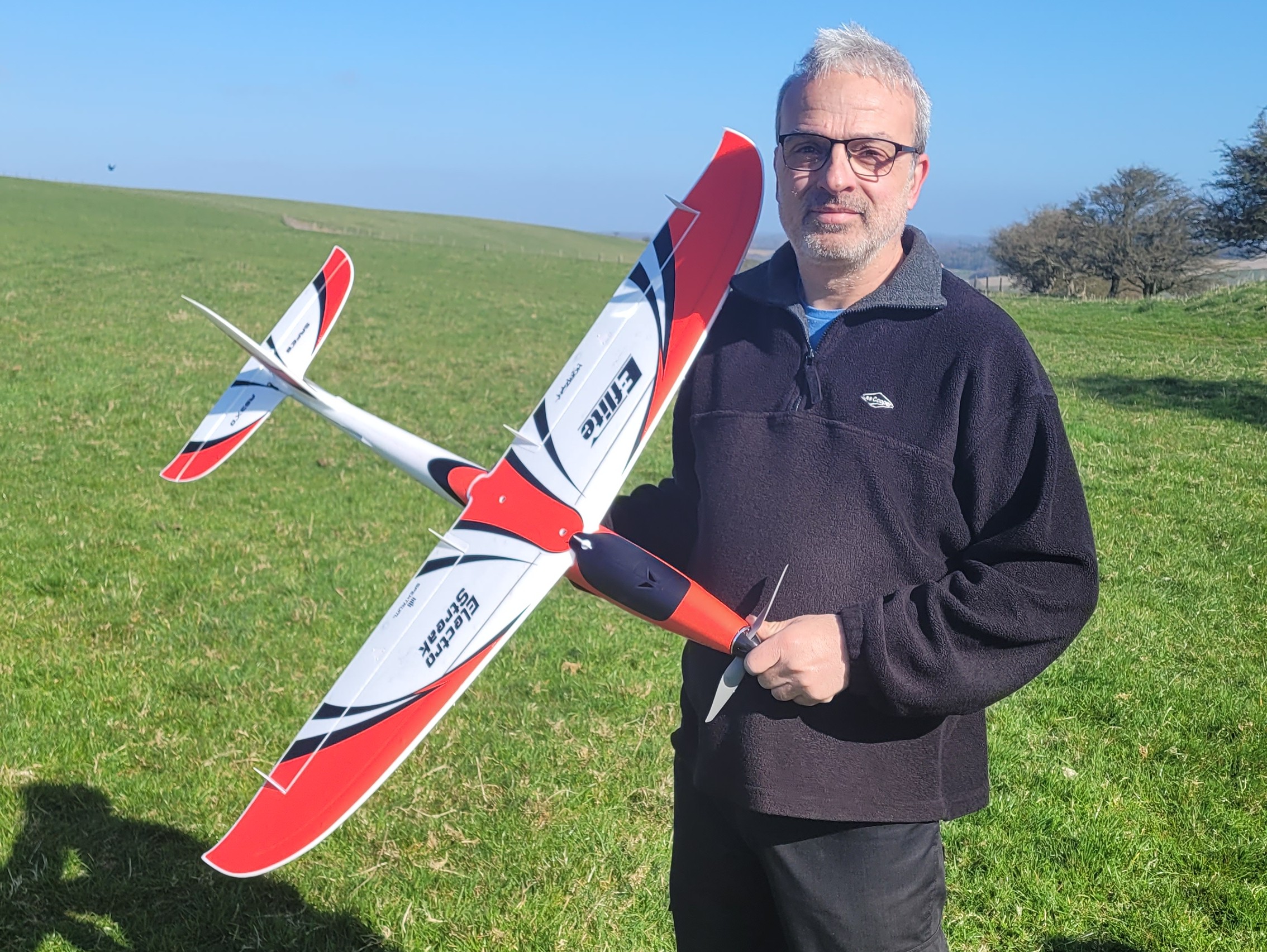 Mike has had a series of Electro Streaks over the years, going right back to the original early balsa ones but this one is an all-foam creation by E-flite which can use either three or four cells. On its first outing he flew it on a three cell lipo pack and it went well but Mini Mike decided he could do better, so for the next outing he switched up to a four cell pack.
Mike has had a series of Electro Streaks over the years, going right back to the original early balsa ones but this one is an all-foam creation by E-flite which can use either three or four cells. On its first outing he flew it on a three cell lipo pack and it went well but Mini Mike decided he could do better, so for the next outing he switched up to a four cell pack.
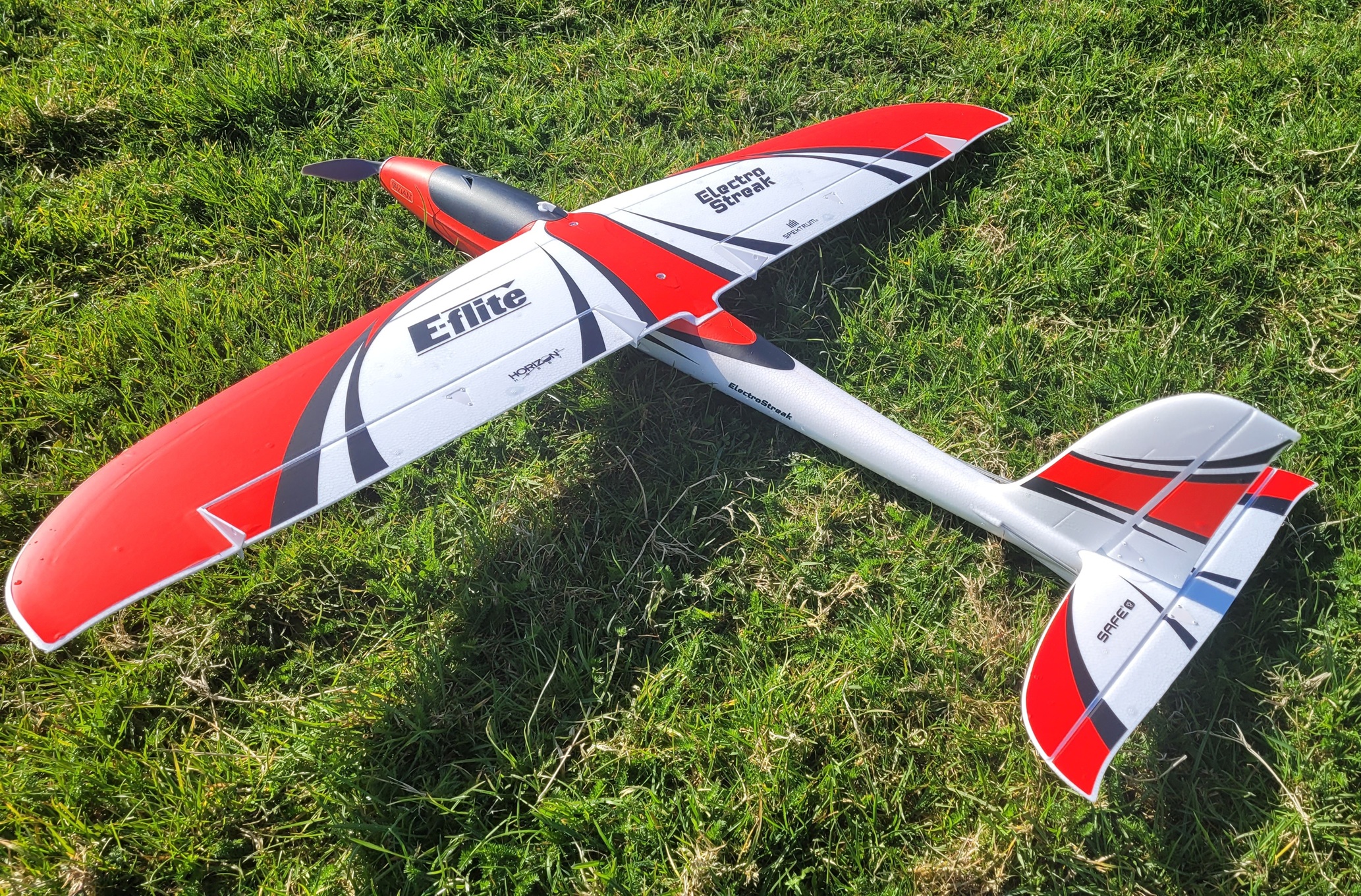
 It certainly shifts around the sky when flat out and I didn’t bother trying to film it, but you can see how it went on the rather cautious first flight on three cells in this month’s video.
It certainly shifts around the sky when flat out and I didn’t bother trying to film it, but you can see how it went on the rather cautious first flight on three cells in this month’s video.
Dougal Entendre retired his ancient Slick last month after the much weakened undercarriage parted company with the fuselage yet again. Dougal said there was nothing left to glue it back to in the lightly constructed fuselage, so after years of faithful service it’s flown it’s last. But some time ago Woody had sold an Edge 540T to Dougal when he decided it was too much of a handful, and Dougal had just lost his own identical Edge in a midair collision. So in April Dougal brought the Edge out of retirement to fly again.

 The Edge is one of a now discontinued range produced by HobbyKing that was made of a lite-ply skeleton covered in EPP foam so the model is very light for its 1430mm span.
The Edge is one of a now discontinued range produced by HobbyKing that was made of a lite-ply skeleton covered in EPP foam so the model is very light for its 1430mm span.

 The motor is a Turnigy Aerodrive 4250 500kV which is coupled to an 80A speed controller. Amazingly the 14” propeller on Dougal’s previous Edge had survived the midair collision and he is using it on this one. He mostly flies it with a five cell 3000mAh pack but he only has two of those so if he wants a third flight he uses a Y-lead to put two three cell 2200mAh packs in series (equivalent to a 6 cell 2200mAh pack) and says there seems to be no difference in performance. You can watch the performance in this month’s video.
The motor is a Turnigy Aerodrive 4250 500kV which is coupled to an 80A speed controller. Amazingly the 14” propeller on Dougal’s previous Edge had survived the midair collision and he is using it on this one. He mostly flies it with a five cell 3000mAh pack but he only has two of those so if he wants a third flight he uses a Y-lead to put two three cell 2200mAh packs in series (equivalent to a 6 cell 2200mAh pack) and says there seems to be no difference in performance. You can watch the performance in this month’s video.
Some of you will have seen Norwegian Nick’s E-Shark at the club EGM in late February. At the time it had not been flown and April was the first opportunity Nick has had to try it.

 As usual Nick had made a lovely job of the building and covering. The plan for the E-Shark is available from Sarik Hobbies and this is what their website says: This is a simple sports or slope (using a folding prop) 41 in. span model design by Graham Dorschell built up from 5mm Depron using the ‘folding wing’ method, with some balsa and Correx board and using basic tools with two 9g servos for delta mix. With just a few parts to cut it turns into a quick model to fly with a 35mm 1500KV brushless motor, 60 Amp ESC, 8″ x 6″ prop and a 3S 2200-3000 mAh LiPo. It sounds good to me, a simple, cheap, small model to chuck in the car for flying at any opportunity, what could possibly go wrong?
As usual Nick had made a lovely job of the building and covering. The plan for the E-Shark is available from Sarik Hobbies and this is what their website says: This is a simple sports or slope (using a folding prop) 41 in. span model design by Graham Dorschell built up from 5mm Depron using the ‘folding wing’ method, with some balsa and Correx board and using basic tools with two 9g servos for delta mix. With just a few parts to cut it turns into a quick model to fly with a 35mm 1500KV brushless motor, 60 Amp ESC, 8″ x 6″ prop and a 3S 2200-3000 mAh LiPo. It sounds good to me, a simple, cheap, small model to chuck in the car for flying at any opportunity, what could possibly go wrong?  Unfortunately, quite a lot as it turned out. I was flying so I missed what happened on it’s maiden flight, I just saw it going away from the launch but that was all. The next thing I knew was that it had come down somewhere in the distance and Nick had gone off to retrieve it. Sadly the E-Shark had literally crashed and burned and eventually Nick returned with some very charred remains. I’ve no idea what caused the crash but the battery obviously got damaged in the impact and destroyed the rest of it, a great shame.
Unfortunately, quite a lot as it turned out. I was flying so I missed what happened on it’s maiden flight, I just saw it going away from the launch but that was all. The next thing I knew was that it had come down somewhere in the distance and Nick had gone off to retrieve it. Sadly the E-Shark had literally crashed and burned and eventually Nick returned with some very charred remains. I’ve no idea what caused the crash but the battery obviously got damaged in the impact and destroyed the rest of it, a great shame.
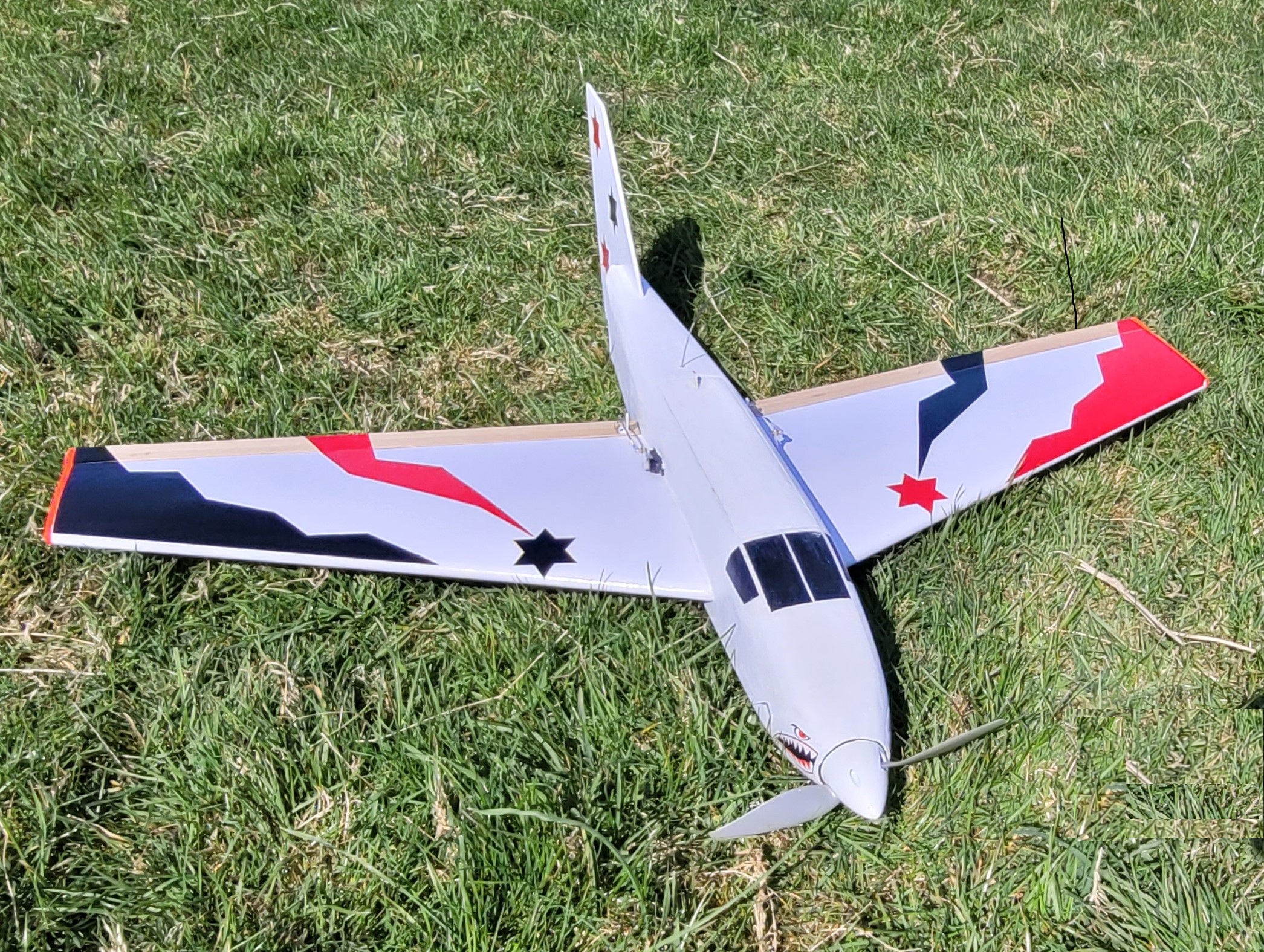 It’s extremely rare for that to happen but it’s a possibility that we all need to be aware of.
It’s extremely rare for that to happen but it’s a possibility that we all need to be aware of.
Time to move on to happier things now. Having been to the field several times, asked lots of questions, and done loads of research, new member Terry splashed the cash on what seems to be an ideal set of equipment for someone with zero knowledge of model flying.
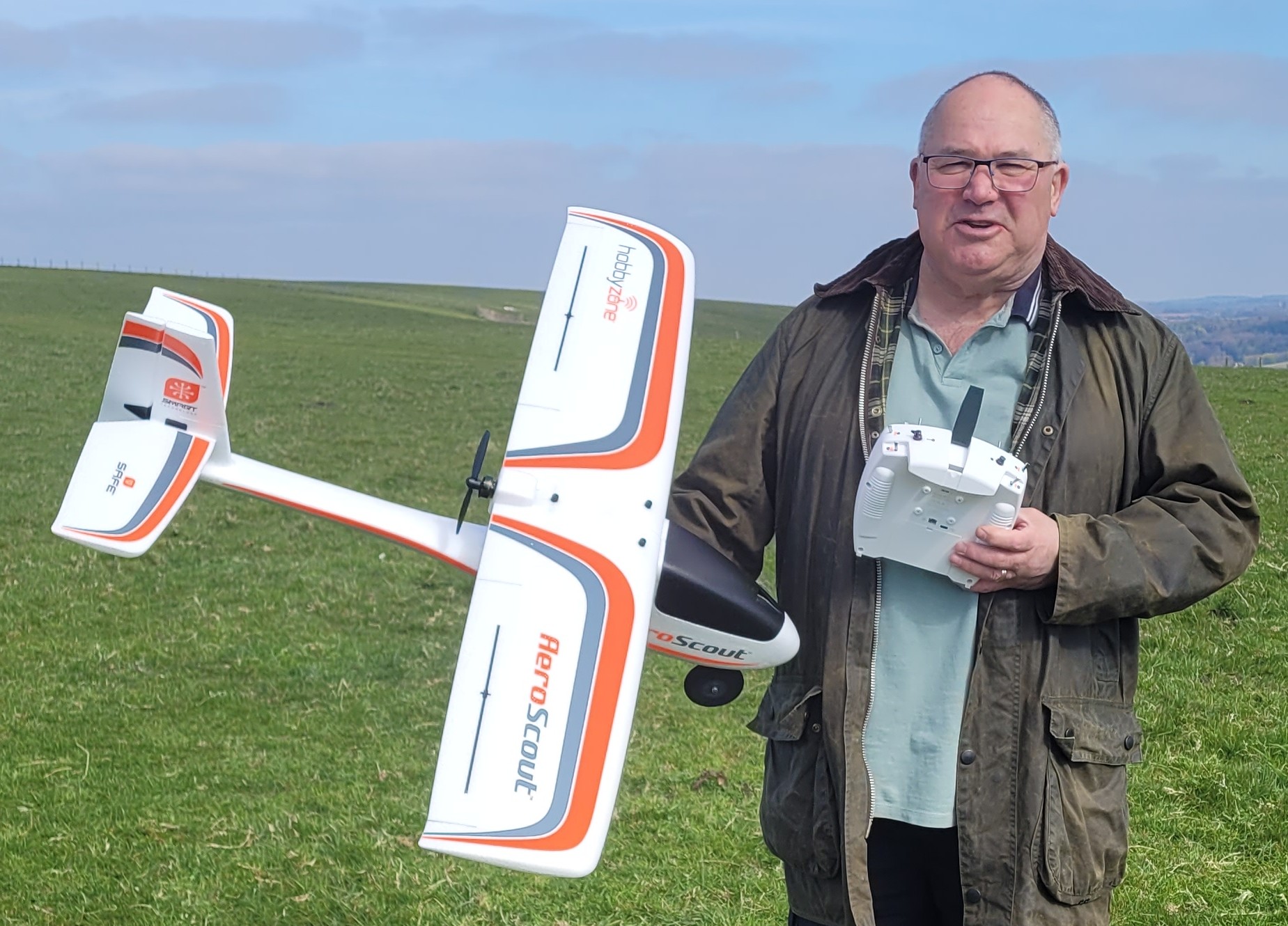 He bought a HobbyZone AeroScout trainer, a Spektrum NX7e+ transmitter, five Turnigy three cell 2200mAh batteries from HobbyKing, and an Overlander VSRmini+ charger.
He bought a HobbyZone AeroScout trainer, a Spektrum NX7e+ transmitter, five Turnigy three cell 2200mAh batteries from HobbyKing, and an Overlander VSRmini+ charger.
Here’s what the Wheelspin Models site says about the plane: The HobbyZone® AeroScout™ S 2 1.1m makes learning to fly an RC (radio controlled) airplane more fun and easier than ever before! It’s the perfect trainer because it’s very durable and is equipped with exclusive SAFE® (Sensor Assisted Flight Envelope) technology that helps to prevent overcontrol, loss of orientation and crashes so nearly everyone can learn to fly successfully. It also features Beginner, Intermediate and Experienced flight modes so you can choose the level of stability and control you need at the flip of a switch. The “pusher” power configuration and EPO construction make it more durable than other similar class models. Tricycle landing gear with oversized tires and a steerable nose wheel makes it easy to take off from and land on a wide variety of surfaces from pavement to grass, or you can install the optional floats (sold separately) to fly from ponds and lakes!  Terry was very lucky as for the first couple of sessions he flew the conditions were near perfect with light winds. The AeroScout proved to be ideal for Terry and after just a few minutes in Beginner mode Terry was happily flying in Intermediate mode which gives more control but doesn’t allow the pilot to over control and inadvertently get upside down.
Terry was very lucky as for the first couple of sessions he flew the conditions were near perfect with light winds. The AeroScout proved to be ideal for Terry and after just a few minutes in Beginner mode Terry was happily flying in Intermediate mode which gives more control but doesn’t allow the pilot to over control and inadvertently get upside down.
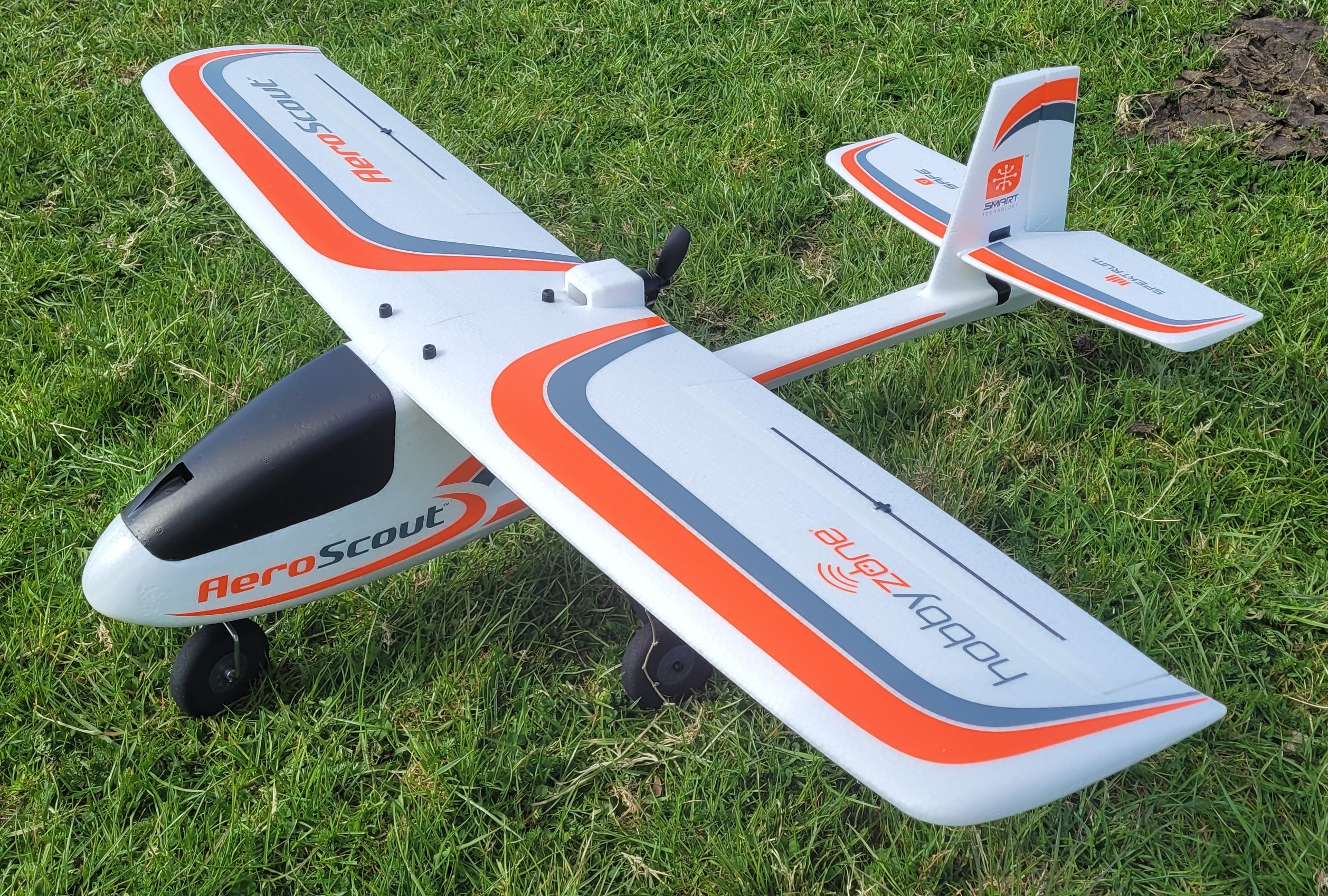 On only his third flight he took off with no problems and by around flight number seven he was landing safely. On his third flying session there was a strong wind blowing which made Terry realise that it’s not always quite so easy but he coped well and I’m sure he’ll quickly reach the BMFA ‘A’ certificate standard. Some of Terry’s flying is in the video.
On only his third flight he took off with no problems and by around flight number seven he was landing safely. On his third flying session there was a strong wind blowing which made Terry realise that it’s not always quite so easy but he coped well and I’m sure he’ll quickly reach the BMFA ‘A’ certificate standard. Some of Terry’s flying is in the video.
When Bob the Builder decided he had too many models a while back he sold his Tiger Moth to Gordon Bennett. Bob had built the Tiger from a HobbyKing laser cut kit back in 2016 and made a beautiful job of it. The Tiger had it’s first flight in September that year.
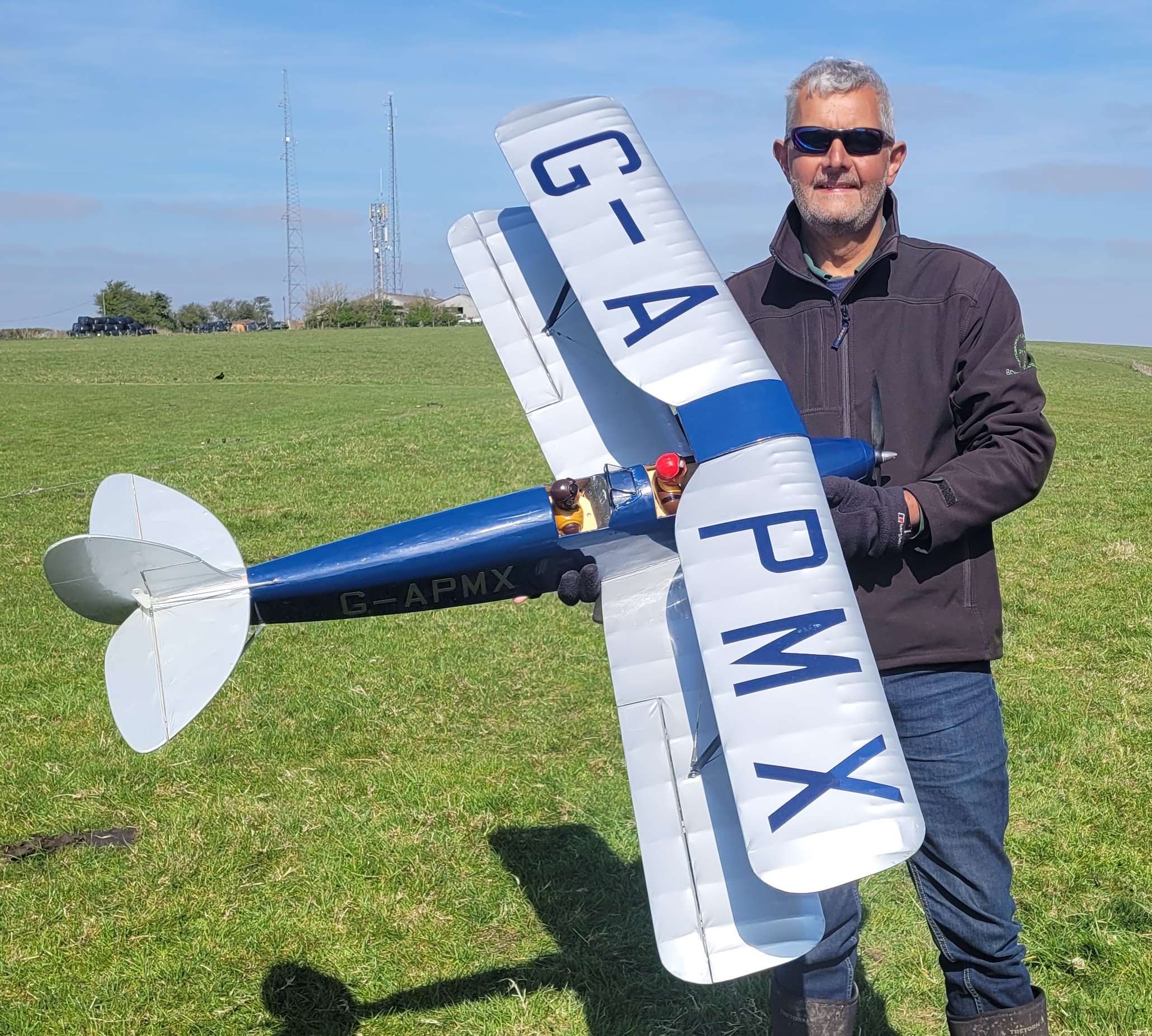
 Bob finished it in the colour scheme of the one Ralph Hubbard landed in our field twice but who was sadly killed doing the Cresta Run in Switzerland in 2017 at the age of 72!
Bob finished it in the colour scheme of the one Ralph Hubbard landed in our field twice but who was sadly killed doing the Cresta Run in Switzerland in 2017 at the age of 72!
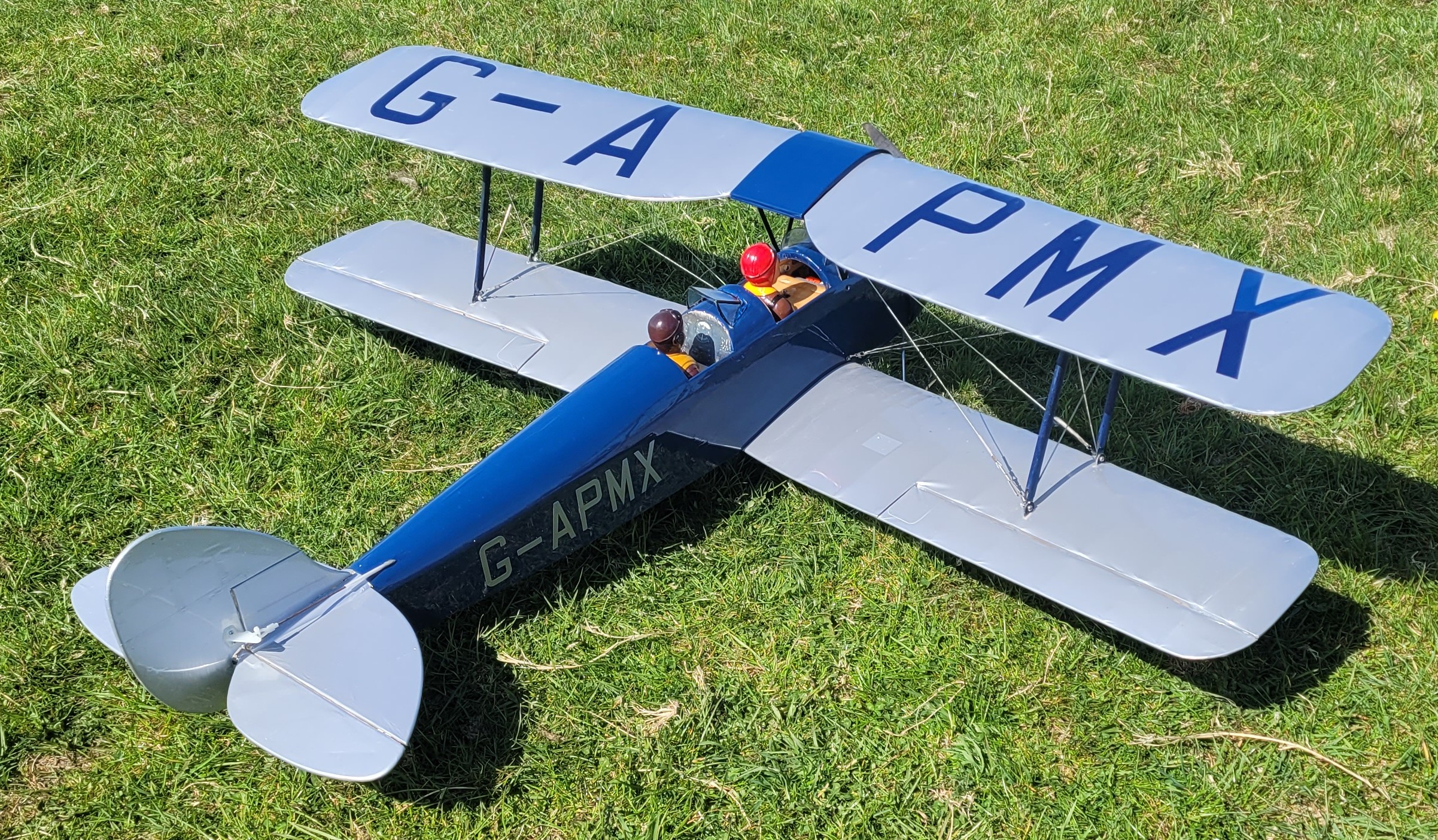
 New owner Gordon has now had several flights with the Tiger Moth and is gradually getting used to flying a fairly draggy biplane,. He has been making a few adjustments to get it flying as he likes but overall it’s a lovely model that flies well as you’ll see in the video.
New owner Gordon has now had several flights with the Tiger Moth and is gradually getting used to flying a fairly draggy biplane,. He has been making a few adjustments to get it flying as he likes but overall it’s a lovely model that flies well as you’ll see in the video.
Last month 1066 decided to sort out his battery packs as, like most of us, he had quite a few that weren’t up to the job of providing decent power for a reasonable time. He spends a lot of his spare time making stuff out of gash wood, pallets, old furniture etc. so, having discarded the duff batteries, he set about making a storage unit for the remaining ones.
 It seems he still has over seventy packs! That’s very neat 1066, are you taking orders?
It seems he still has over seventy packs! That’s very neat 1066, are you taking orders?
While he was clearing out his batteries 1066 also cleared out a model. Having finished his new kit-built Mirus 1066 donated his old Mirus look-a-like airframe to Woody.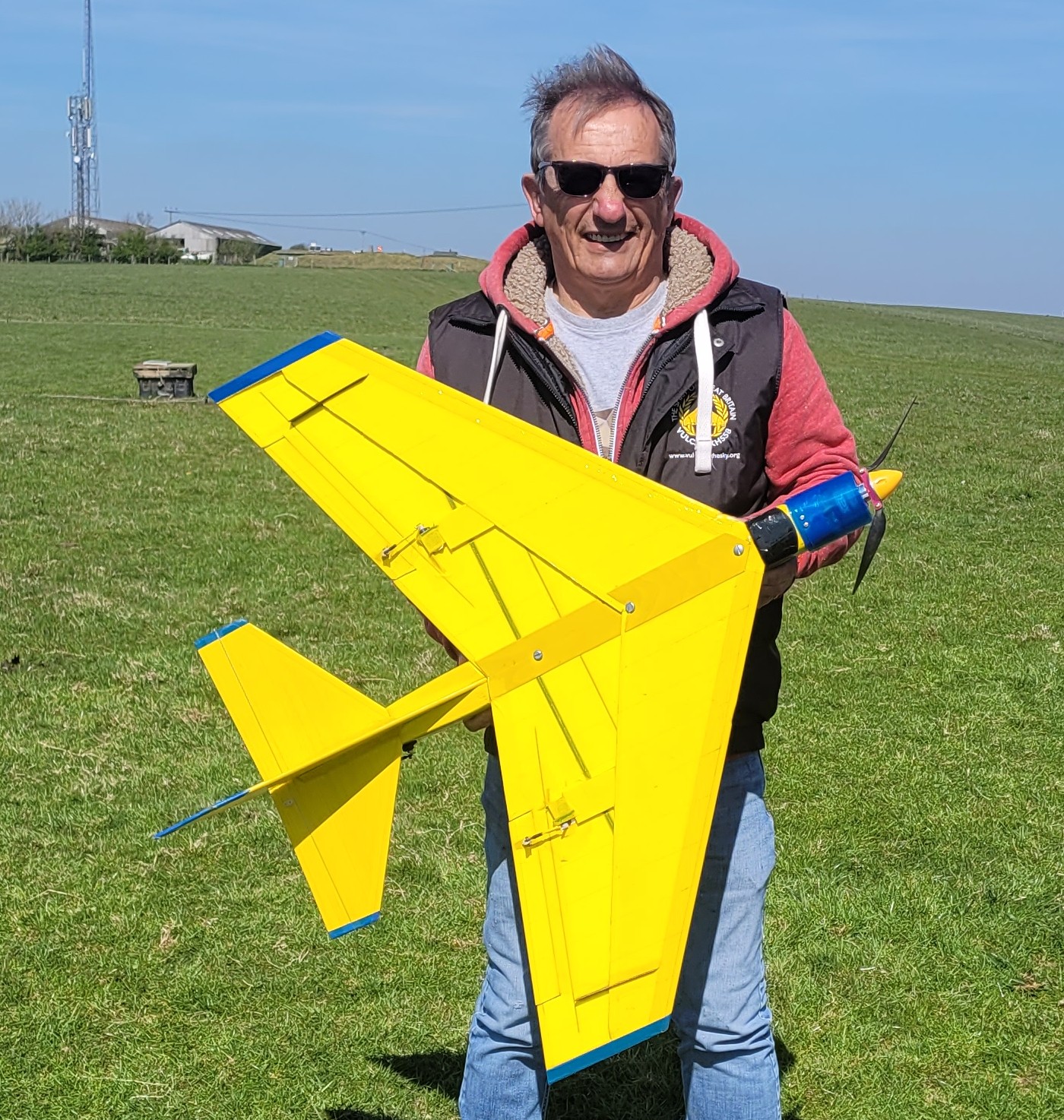
Woody has fitted an Airtek Excell 3536 1400KV motor along with a Hobbywing speed controller, and is using the folding prop that survived when he crashed his Aggessor.
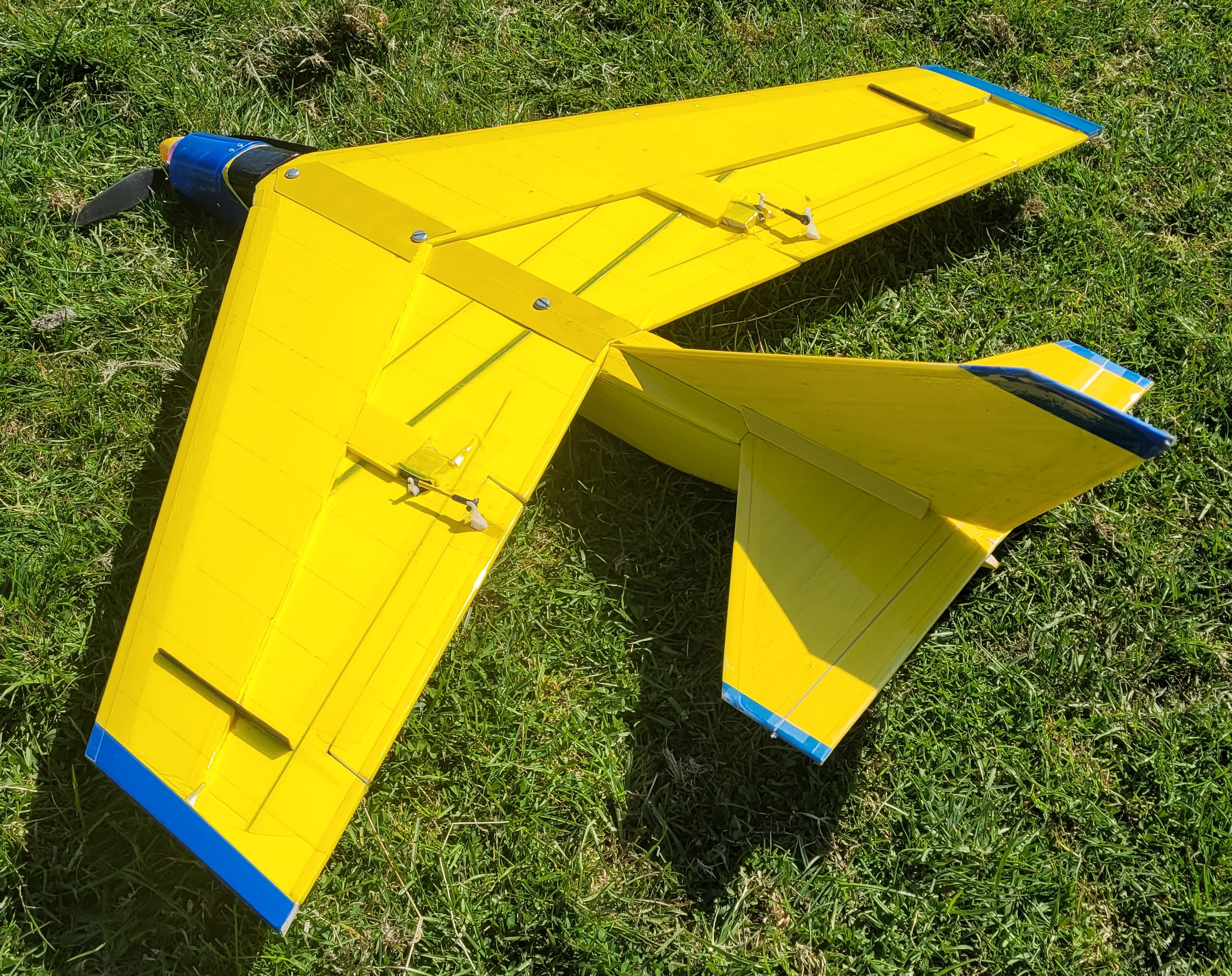 He has made a new cowl from two plastic cups which I notice has a sexy see-through look!
He has made a new cowl from two plastic cups which I notice has a sexy see-through look!
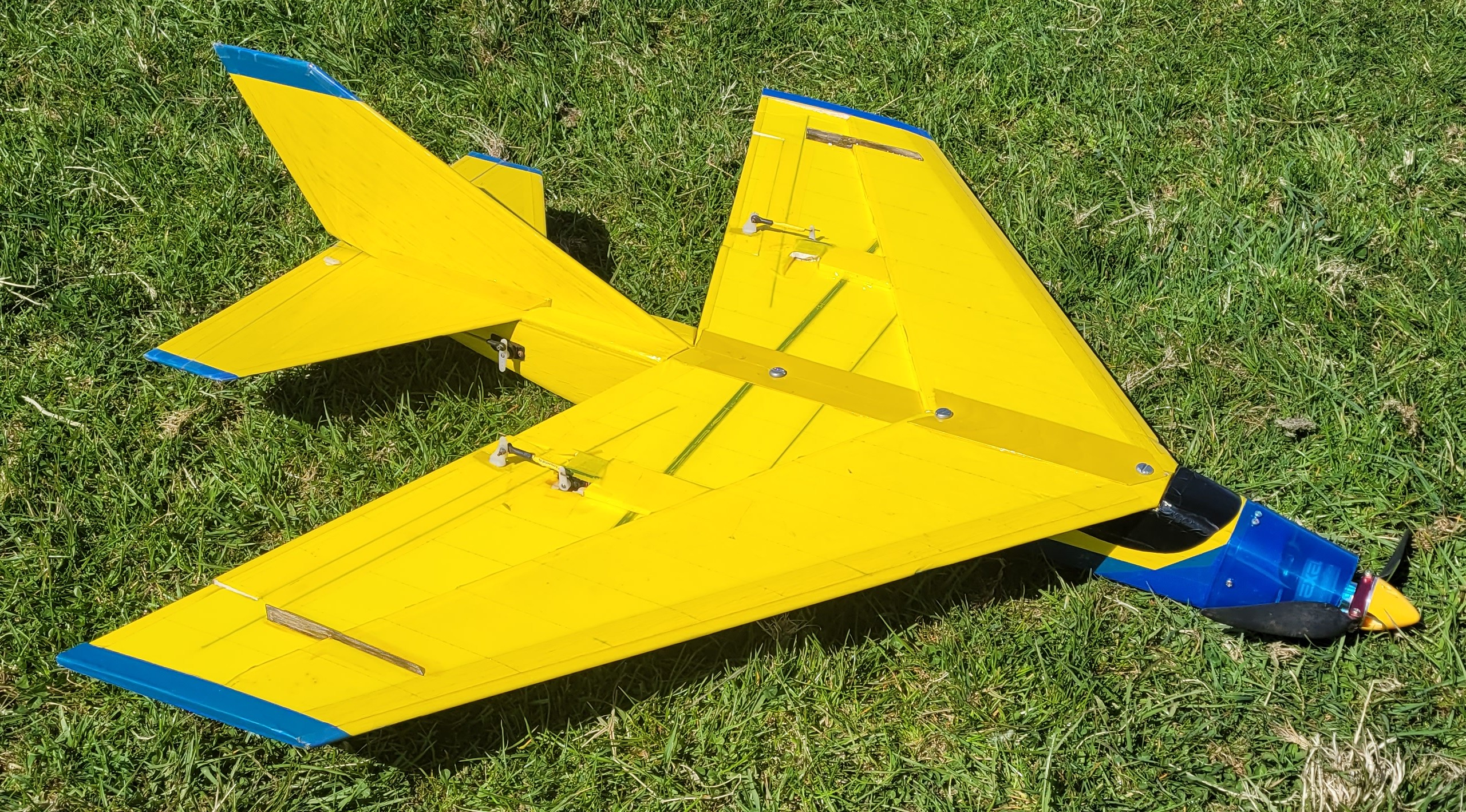 With the rates reduced, and flying it on three cells instead of four, the Mirus is much less of a hooligan machine and seems to suit Woody well. Guess where you can see it in action!
With the rates reduced, and flying it on three cells instead of four, the Mirus is much less of a hooligan machine and seems to suit Woody well. Guess where you can see it in action!
This month the rather poor quality action photos are all taken from the video.
Sorry Dougal but I couldn’t resist including your Sport Jet landing ‘incident’! 
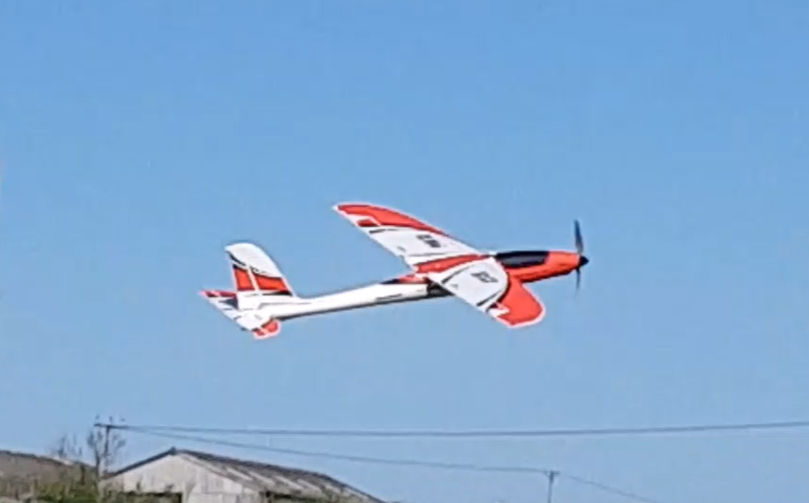


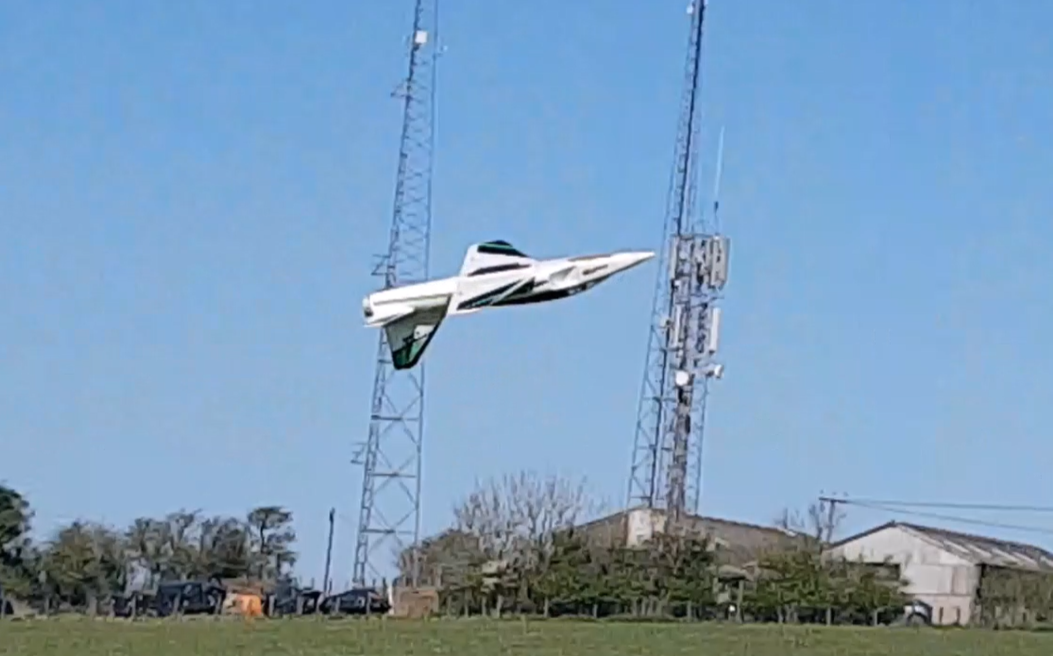
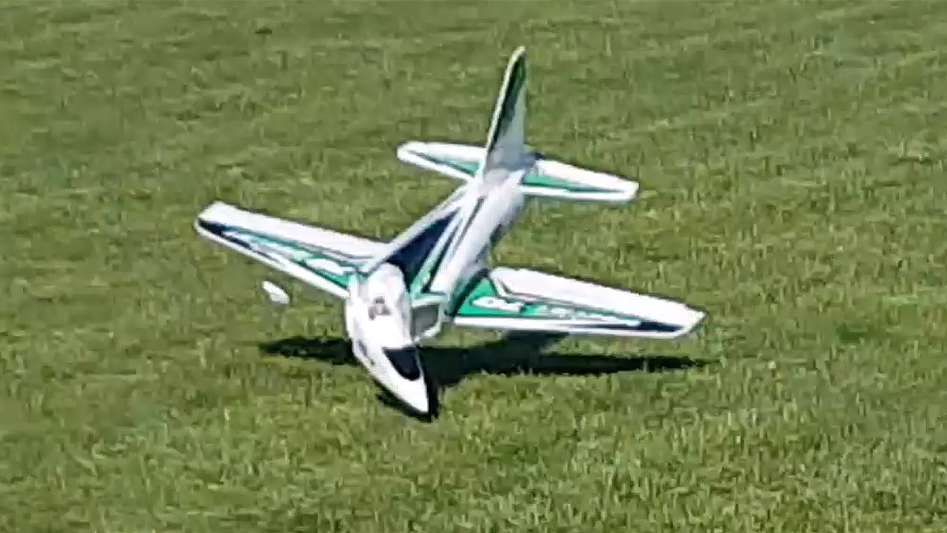 Video time now, this month with footage shot by myself and Dougal Entendre.
Video time now, this month with footage shot by myself and Dougal Entendre.
Please watch the video full-screen, it’s so much better with small models flying around:
If the video won’t play for you please click HERE
The Final Funny:
This is supposedly a true conversation between Air Traffic Control and a student pilot.
Cessna: “Jones tower, Cessna 1234, I’m a student pilot and I’m out of fuel!”
Tower: “Roger Cessna 1234, reduce airspeed to best glide. Can you see the airfield?”
Cessna: “Er…tower, I’m on the south ramp; I just want to know where the fuel truck is..”
Colin Cowplain
Patch News – March 2025
March saw a definite improvement in the weather and club members did lots of flying. There was very little rain in the month which meant the parking area has now dried out well and our cars won’t be getting filthy every time we go flying. There was an easterly wind on several days so MVSA members were often flying and on a few occasions the paragliders and/or hang gliders appeared but they seemed to sitting around waiting a lot more than they were flying so rarely stopped our flying. As the weather warmed up the young bullocks that had wintered in the barn were let out into our field and they must have discovered what an electric fence does. One of the corner posts was down when we arrived to fly one day and they’d left us a few presents on one corner of the patch. But the fence had mostly done it’s job as they were all stood around close to, but not on, the patch and once we had herded them away they didn’t bother us again. The next day that we flew the fence was untouched and they had been moved to a different field. They will probably return sometime in the future but hopefully they will have learnt not to touch the fence.
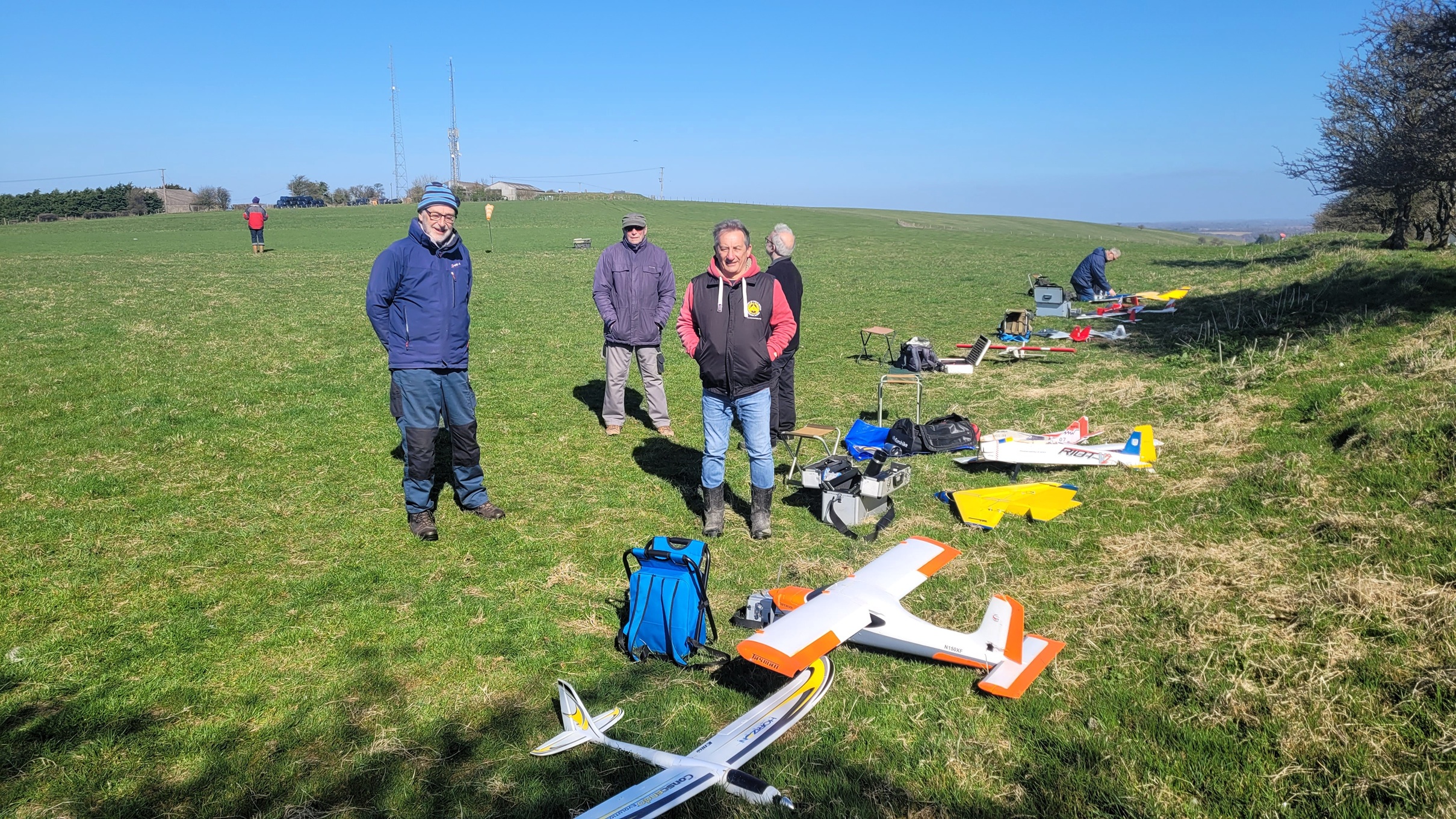 On Sunday March 30th the weather was lovely and sunny but with a very strong wind at ninety degrees to the strip so there was more standing around socialising than flying!
On Sunday March 30th the weather was lovely and sunny but with a very strong wind at ninety degrees to the strip so there was more standing around socialising than flying!
One of the newest club members, Terry Small, has been learning to fly for a few months. 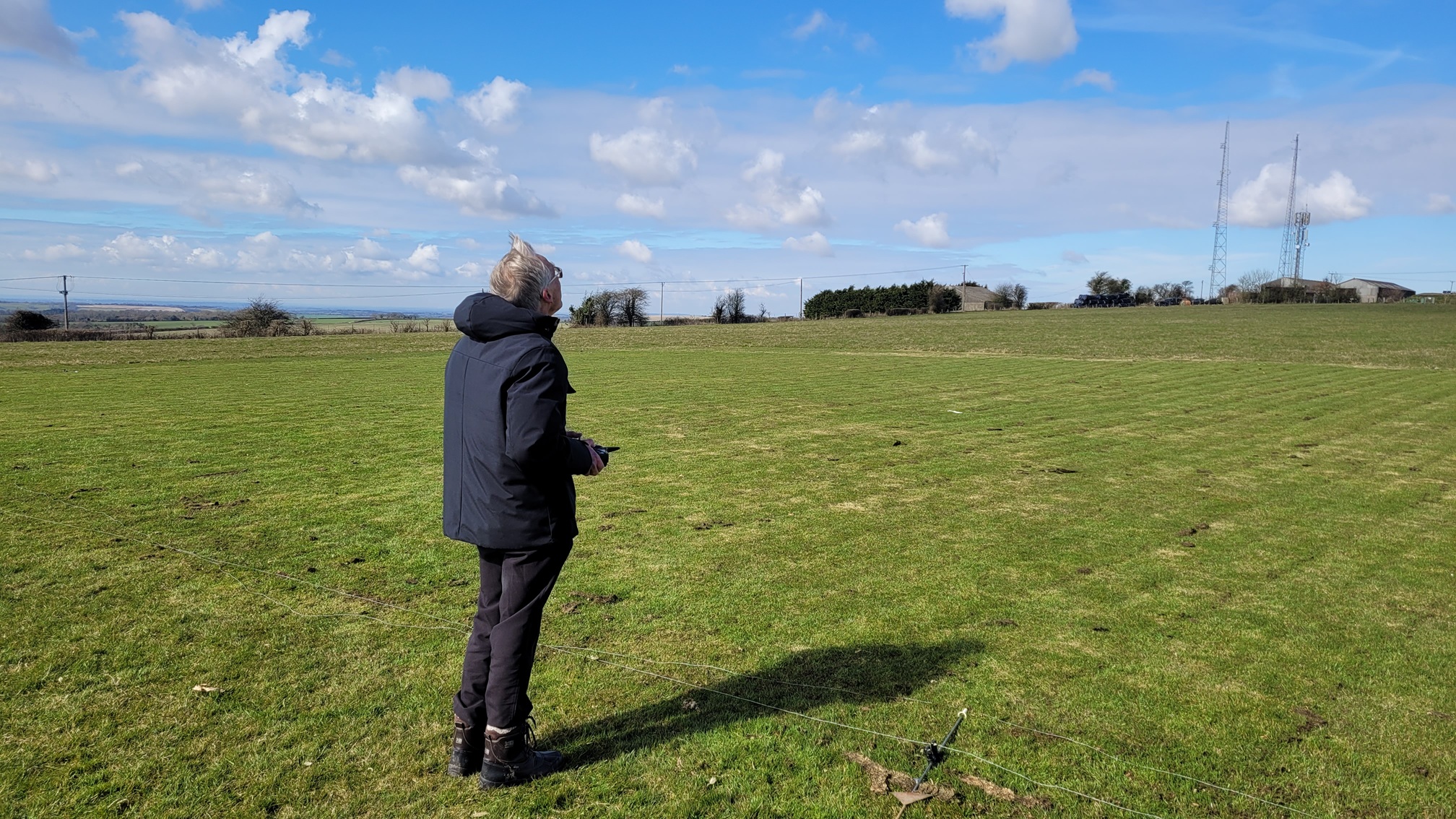 Terry came to the club having already flown a little 700mm span HobbyZone Apprentice STOL which is a scaled down version of the 1500mm span E-flite Apprentice. The little Apprentice is fully stabilised and too light to qualify for the BMFA ‘A’ certificate so Terry bought the larger E-flite version and has been working towards taking his ‘A’ test. He’s done quite a lot of practising on his simulator but complains that the wind at the field is different to the simulator wind, it’s too strong/too bumpy/wrong direction/the wrong sort of wind etc. so 1066 suggested a suitable blog name for him and Terry will now be known as Windshy! He’s had the usual few knocks along the way but nothing too drastic and by the end of March I suggested he was ready for the test. I think I know why he chose to take his test on the 26th when there was a very light wing blowing straight down the strip!
Terry came to the club having already flown a little 700mm span HobbyZone Apprentice STOL which is a scaled down version of the 1500mm span E-flite Apprentice. The little Apprentice is fully stabilised and too light to qualify for the BMFA ‘A’ certificate so Terry bought the larger E-flite version and has been working towards taking his ‘A’ test. He’s done quite a lot of practising on his simulator but complains that the wind at the field is different to the simulator wind, it’s too strong/too bumpy/wrong direction/the wrong sort of wind etc. so 1066 suggested a suitable blog name for him and Terry will now be known as Windshy! He’s had the usual few knocks along the way but nothing too drastic and by the end of March I suggested he was ready for the test. I think I know why he chose to take his test on the 26th when there was a very light wing blowing straight down the strip!
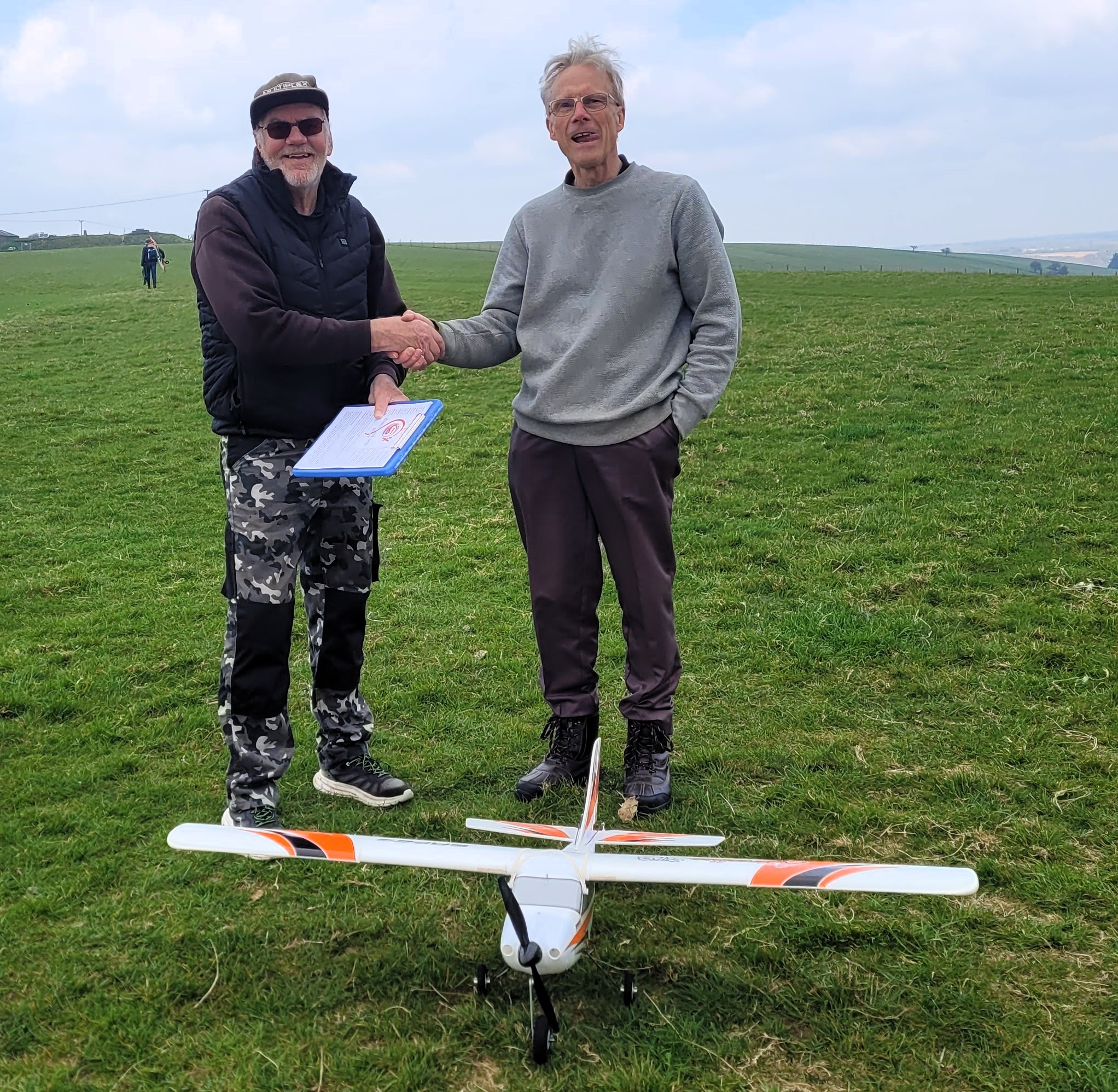 After a couple of practise run throughs of the test Windshy bit the bullet, flew the test for real, answered the necessary questions and passed. So congratulations Windshy, it’s now time to look for a slightly more advanced model…no not a pylon racer or a Lancaster!
After a couple of practise run throughs of the test Windshy bit the bullet, flew the test for real, answered the necessary questions and passed. So congratulations Windshy, it’s now time to look for a slightly more advanced model…no not a pylon racer or a Lancaster!
Several new models were flown in March and there were also several older planes brought out of retirement to fly again. The first to fly was Page Boy’s Woodpecker that I featured back in January as finished but not yet flown. Page Boy had started the build back in 2018 so there didn’t seem too much of a rush to get it in the air the moment it was completed. But on 2nd March the Woodpecker finally arrived at the field and took to the air.
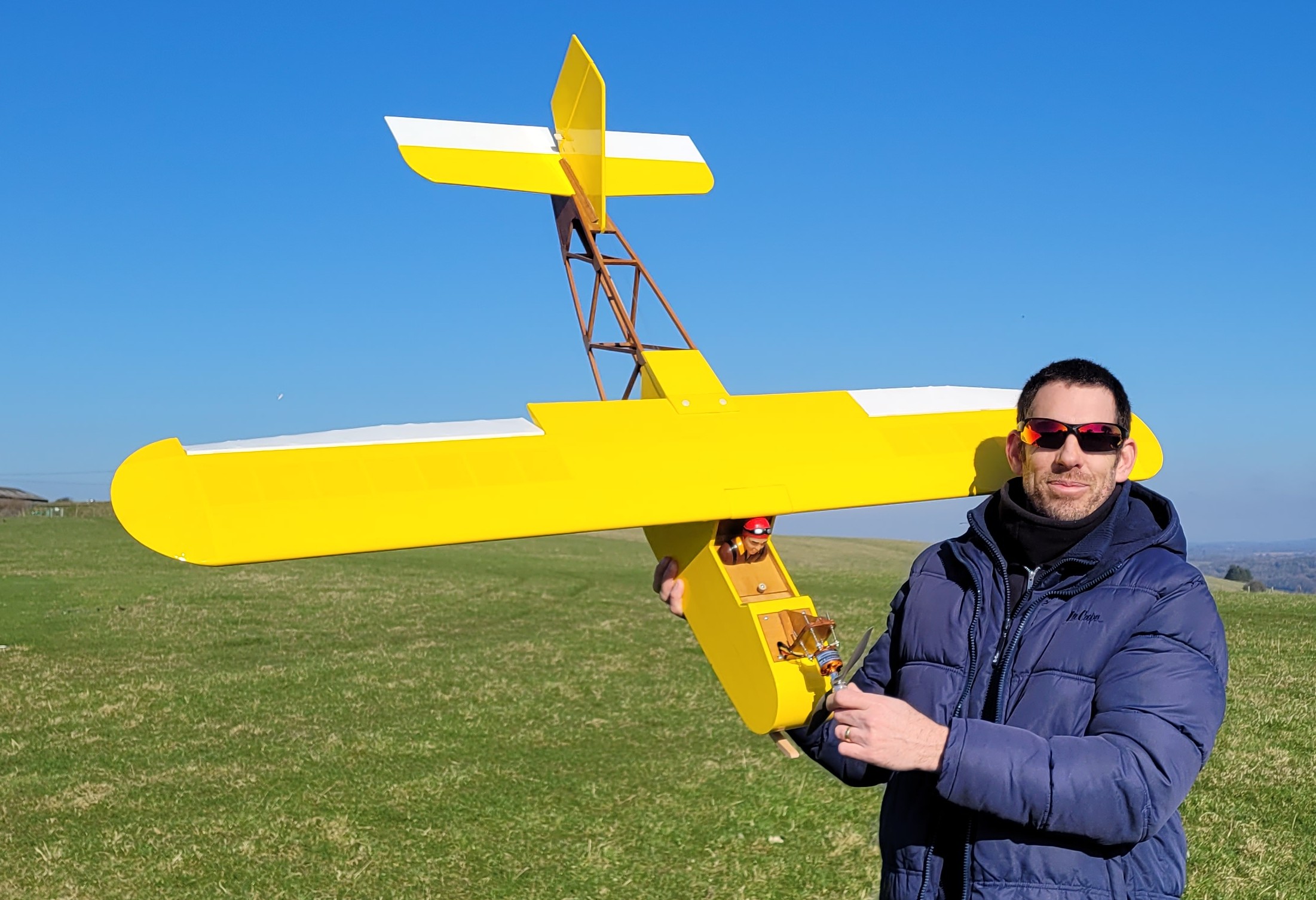
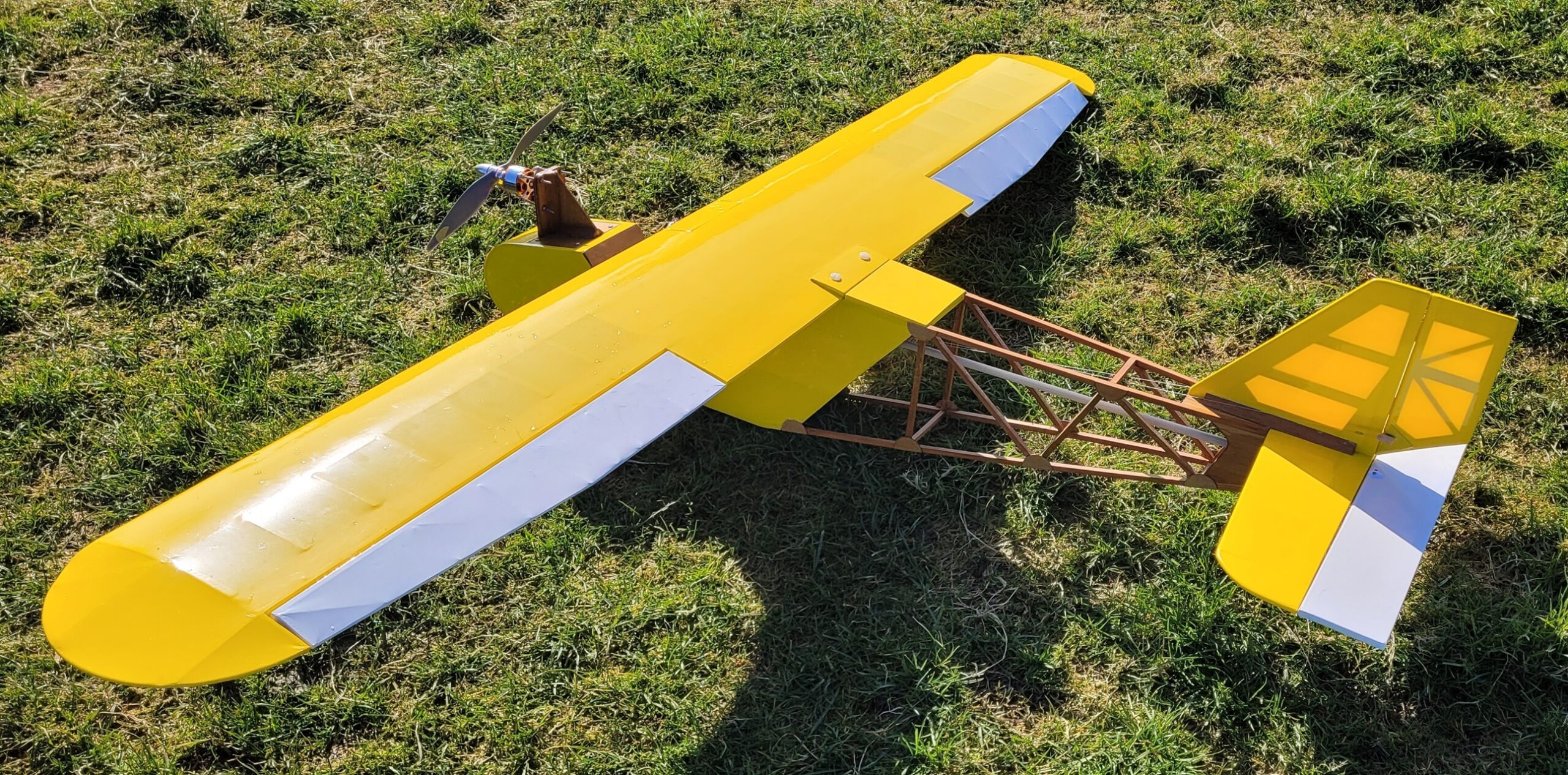 I was surprised when I first saw it as, at 66” span, it was much larger than I had realised from the photos Page Boy had sent me. The Woodpecker was designed by Lindsay Todd and Paul Rice and the original used a 900kv motor and a 3 cell lipo but Page Boy has fitted a 3536 1250kv Turnigy motor and he’s using a 3300mAh 4 cell lipo which avoids the need for a lot of weight in the nose and gives flight times of around 6 or 7 minutes.
I was surprised when I first saw it as, at 66” span, it was much larger than I had realised from the photos Page Boy had sent me. The Woodpecker was designed by Lindsay Todd and Paul Rice and the original used a 900kv motor and a 3 cell lipo but Page Boy has fitted a 3536 1250kv Turnigy motor and he’s using a 3300mAh 4 cell lipo which avoids the need for a lot of weight in the nose and gives flight times of around 6 or 7 minutes.
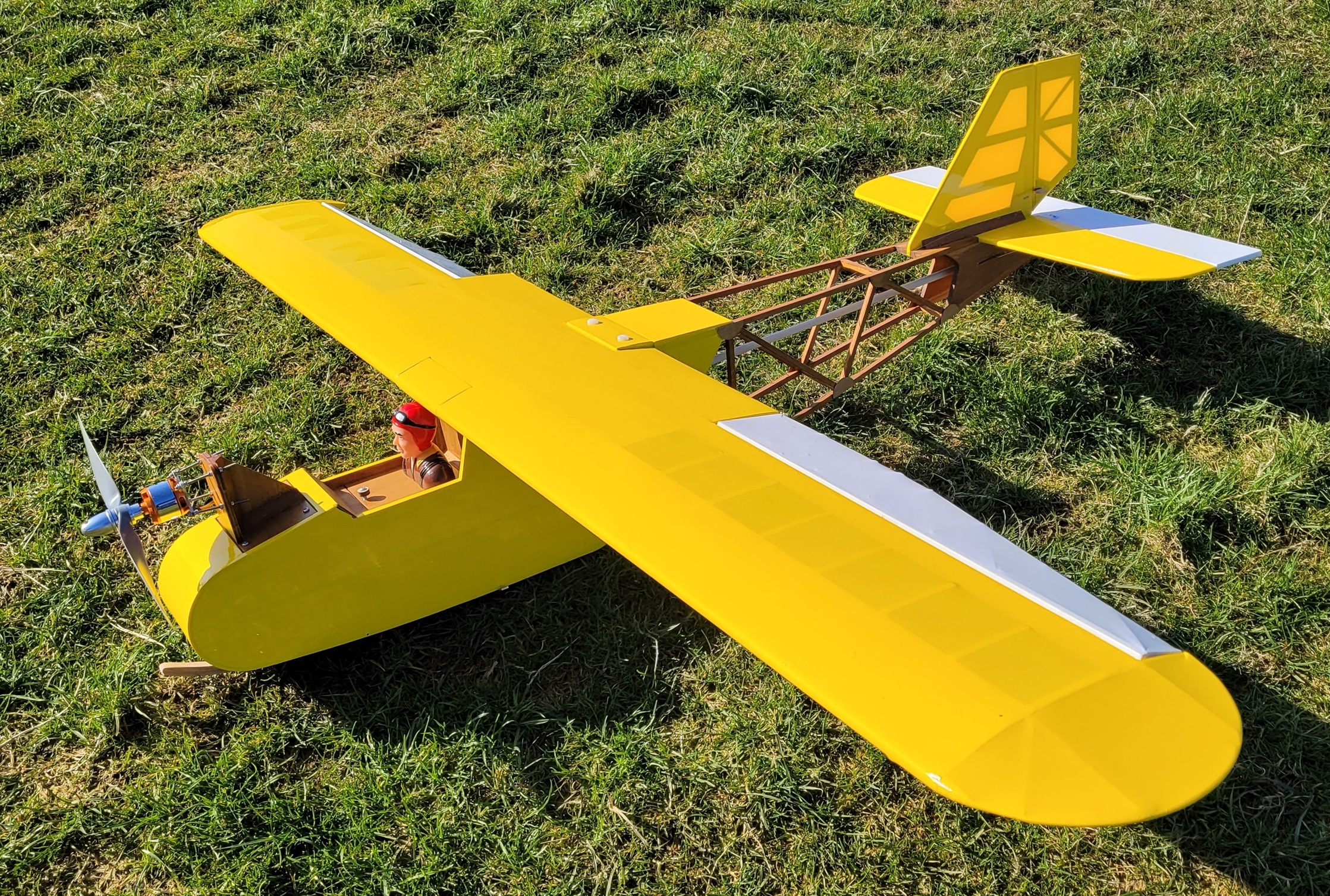 The speed controller is a 60A Turnigy unit and he’s using 4-Max servos for all control surfaces. The first flight looked reasonable but Page Boy said he was struggling as the motor had too much downthrust. As the motor is mounted on a pylon it’s easy to adjust so before the next flight the downthrust was removed and the second flight went much better.
The speed controller is a 60A Turnigy unit and he’s using 4-Max servos for all control surfaces. The first flight looked reasonable but Page Boy said he was struggling as the motor had too much downthrust. As the motor is mounted on a pylon it’s easy to adjust so before the next flight the downthrust was removed and the second flight went much better. 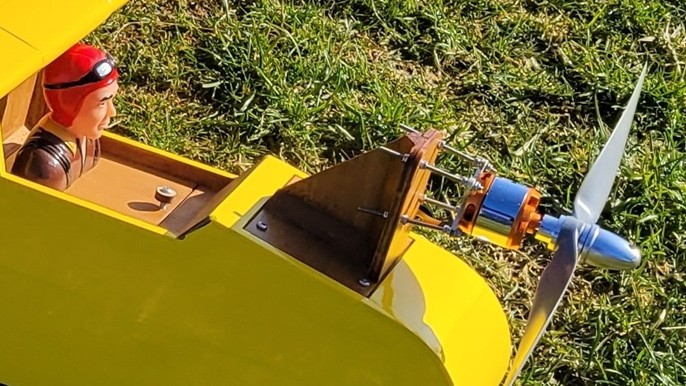 You can see the Woodpecker flying after the changes had been made in this month’s video.
You can see the Woodpecker flying after the changes had been made in this month’s video.
Also featured in the January Patch News but unflown was Captain Slow’s Piwakawaka.
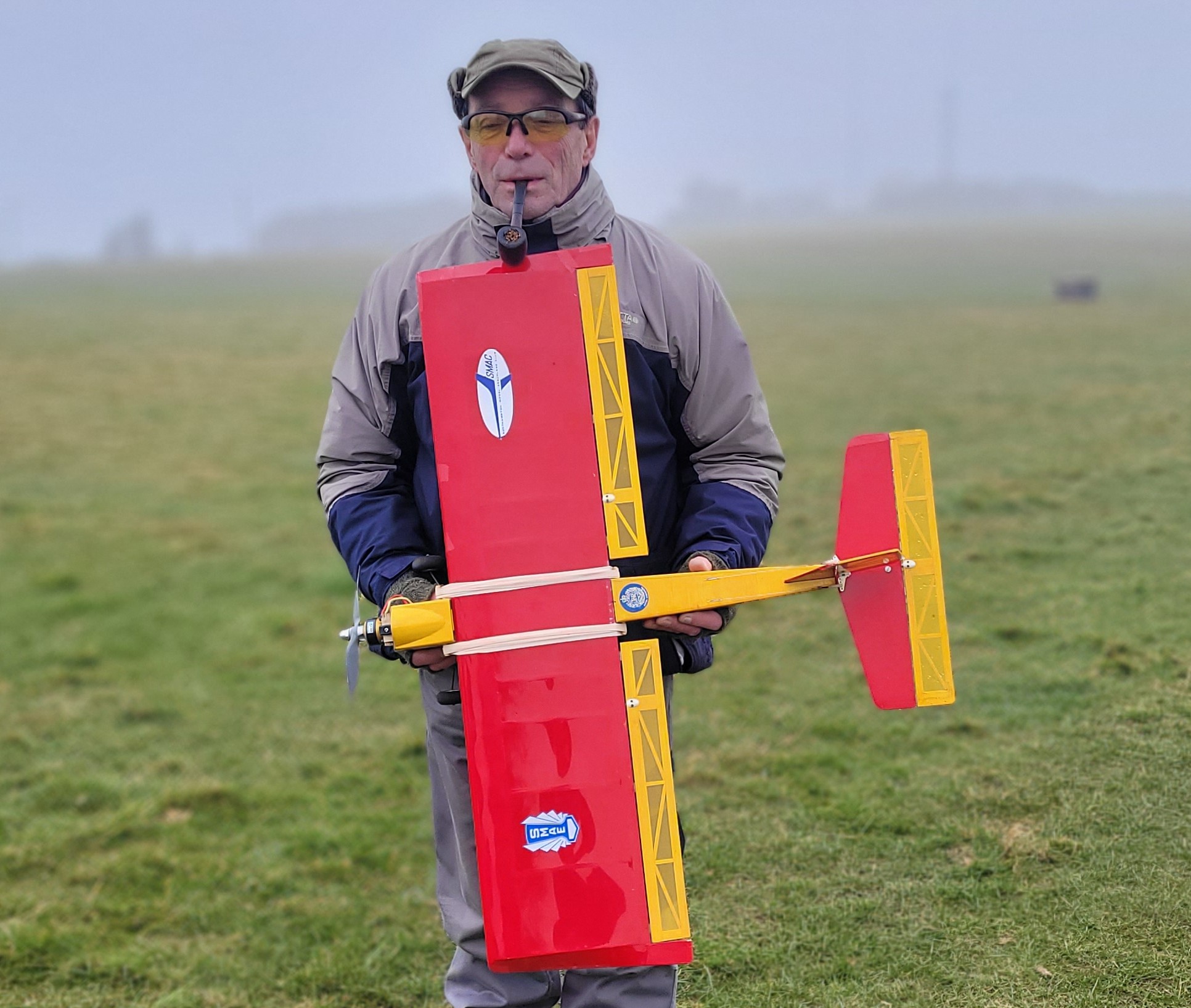 He bought it second-hand from a modeller in Southampton so it has flown previously. It seems very successful, Captain Slow had several flights with it in March with no problems. He’s been using a 3 cell 2200mAh pack but even after two flights on the same battery he’s still landing with around 40% left so he’s thinking of trying it with a 1300mAh instead.
He bought it second-hand from a modeller in Southampton so it has flown previously. It seems very successful, Captain Slow had several flights with it in March with no problems. He’s been using a 3 cell 2200mAh pack but even after two flights on the same battery he’s still landing with around 40% left so he’s thinking of trying it with a 1300mAh instead.
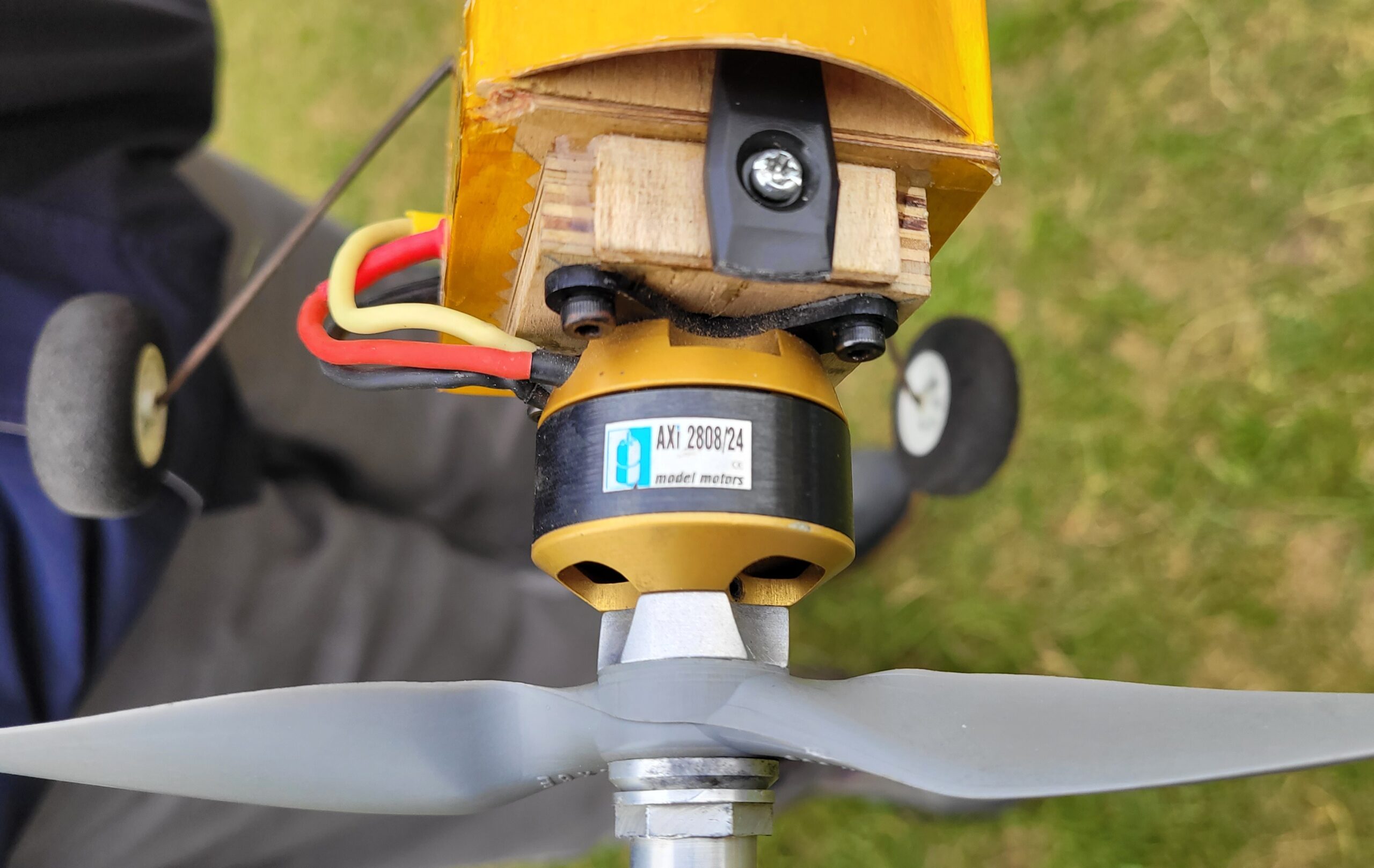 I was going to suggest moving the throttle stick up beyond the mid position occasionally but I wouldn’t want to scare him and then have to change his name to Captain Medium!
I was going to suggest moving the throttle stick up beyond the mid position occasionally but I wouldn’t want to scare him and then have to change his name to Captain Medium!
The next new model to fly was John Warren’s XFly Tasman. John was after something nice and easy to fly and Bob the Builder suggested the Tasman as he loves his own and finds it very easy. John asked me to do the trimming flight which went perfectly other than it briefly disappearing briefly in the mist/low cloud… not the ideal day for a test flight!
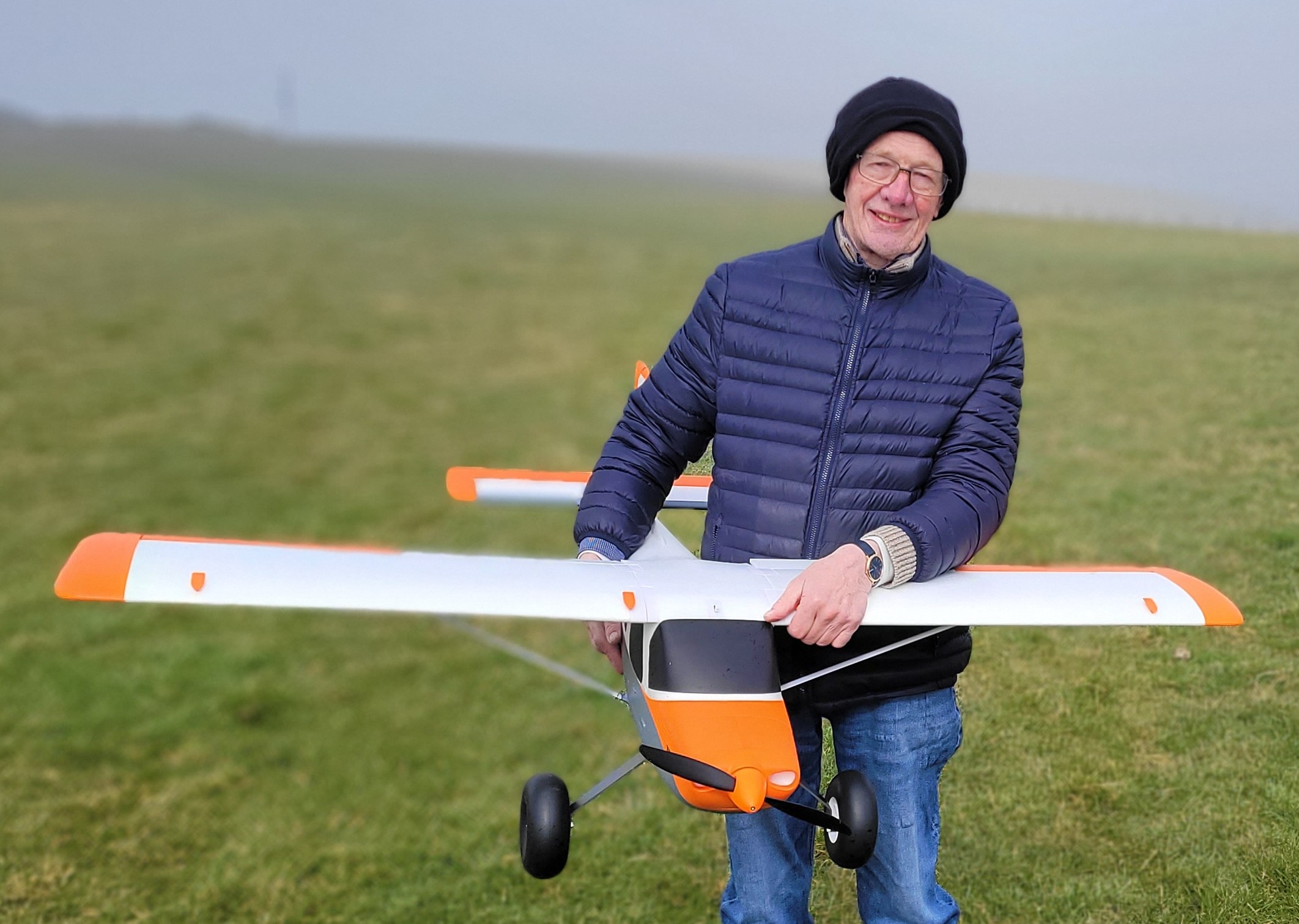
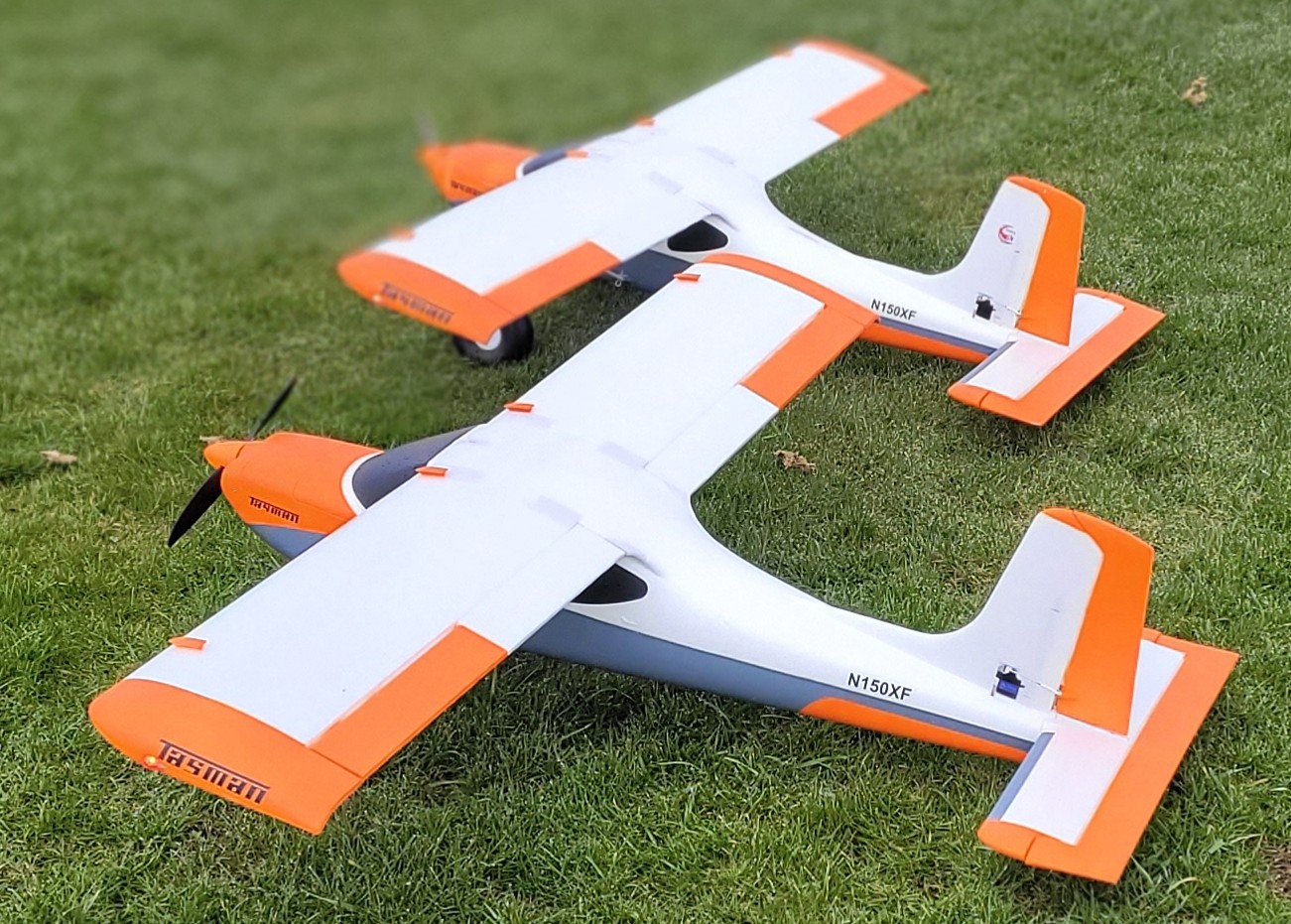 Apart from the murky weather at the start of the flight all was good and John has now had several flights with no problems, the Tasman is the perfect model for John. Both Tasmans are in the video which is slightly confusing but I think I’ve got the captions correct.
Apart from the murky weather at the start of the flight all was good and John has now had several flights with no problems, the Tasman is the perfect model for John. Both Tasmans are in the video which is slightly confusing but I think I’ve got the captions correct.
At the end of February 1066 broke his VisionAire in half when a low inverted pass went just a tad too low and, much to his annoyance, I snuck a couple of photos into Patch News!
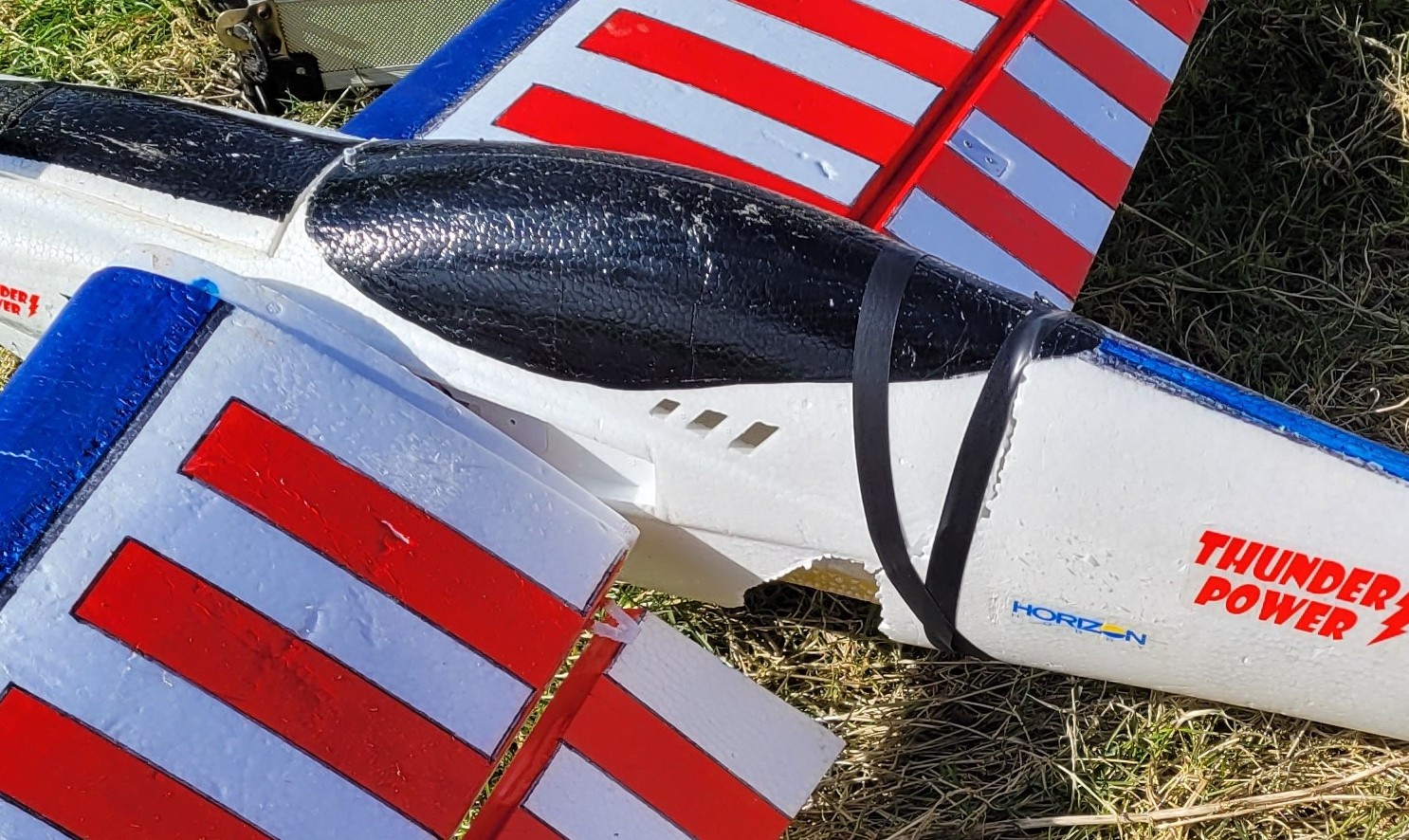 Well 1066 put his repairing hat on and soon had everything back in one piece and looking almost as good as before so it seems only fair for me to show you another photo of it.
Well 1066 put his repairing hat on and soon had everything back in one piece and looking almost as good as before so it seems only fair for me to show you another photo of it.
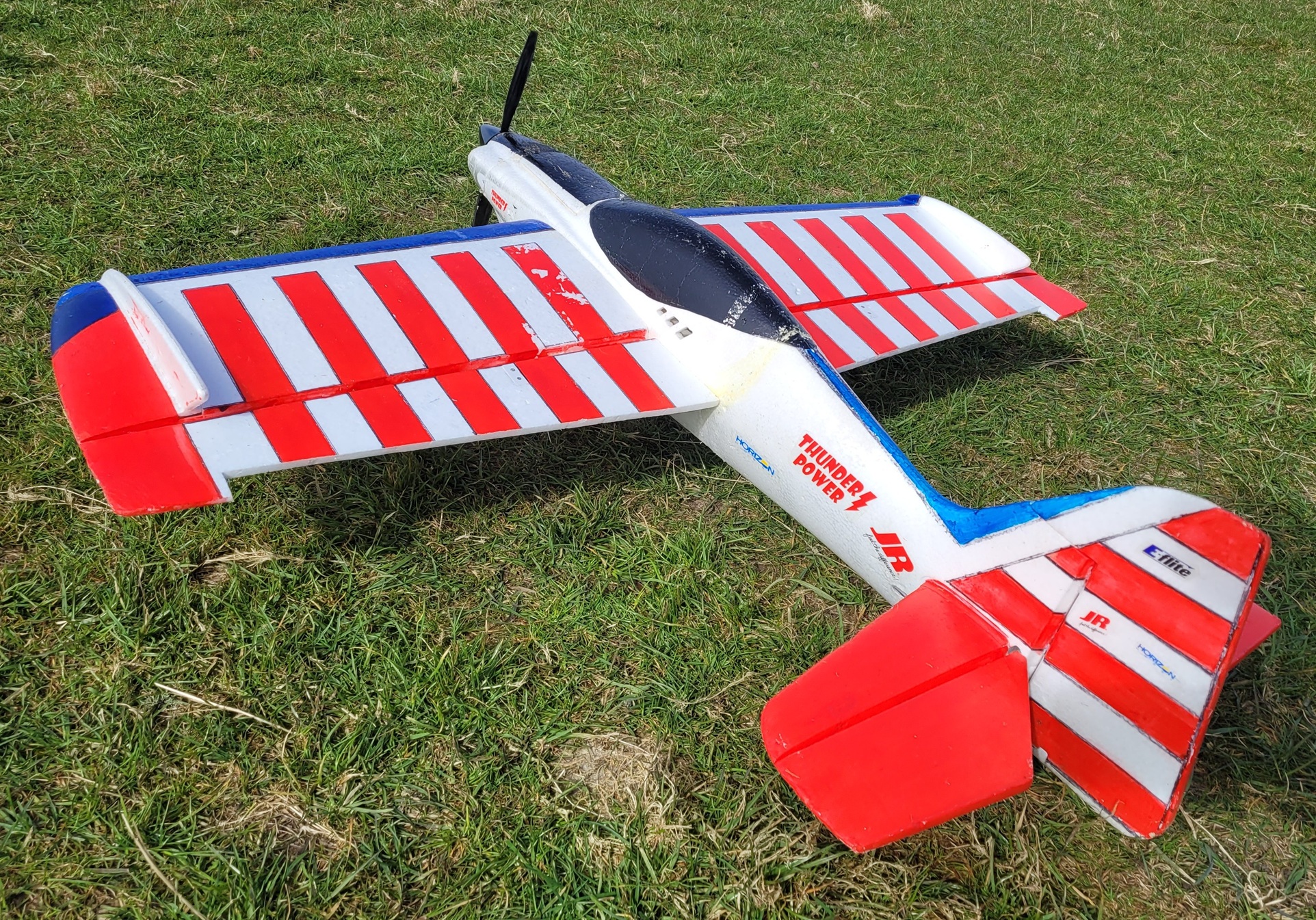 The VisionAire now flies just as well as it did before it’s minor misadventure but oddly 1066 kept refusing to do any low inverted passes with it this month, I can’t think why!
The VisionAire now flies just as well as it did before it’s minor misadventure but oddly 1066 kept refusing to do any low inverted passes with it this month, I can’t think why!
Back to new models now and another from Page Boy, this time an Arrows Hobby Avanti. 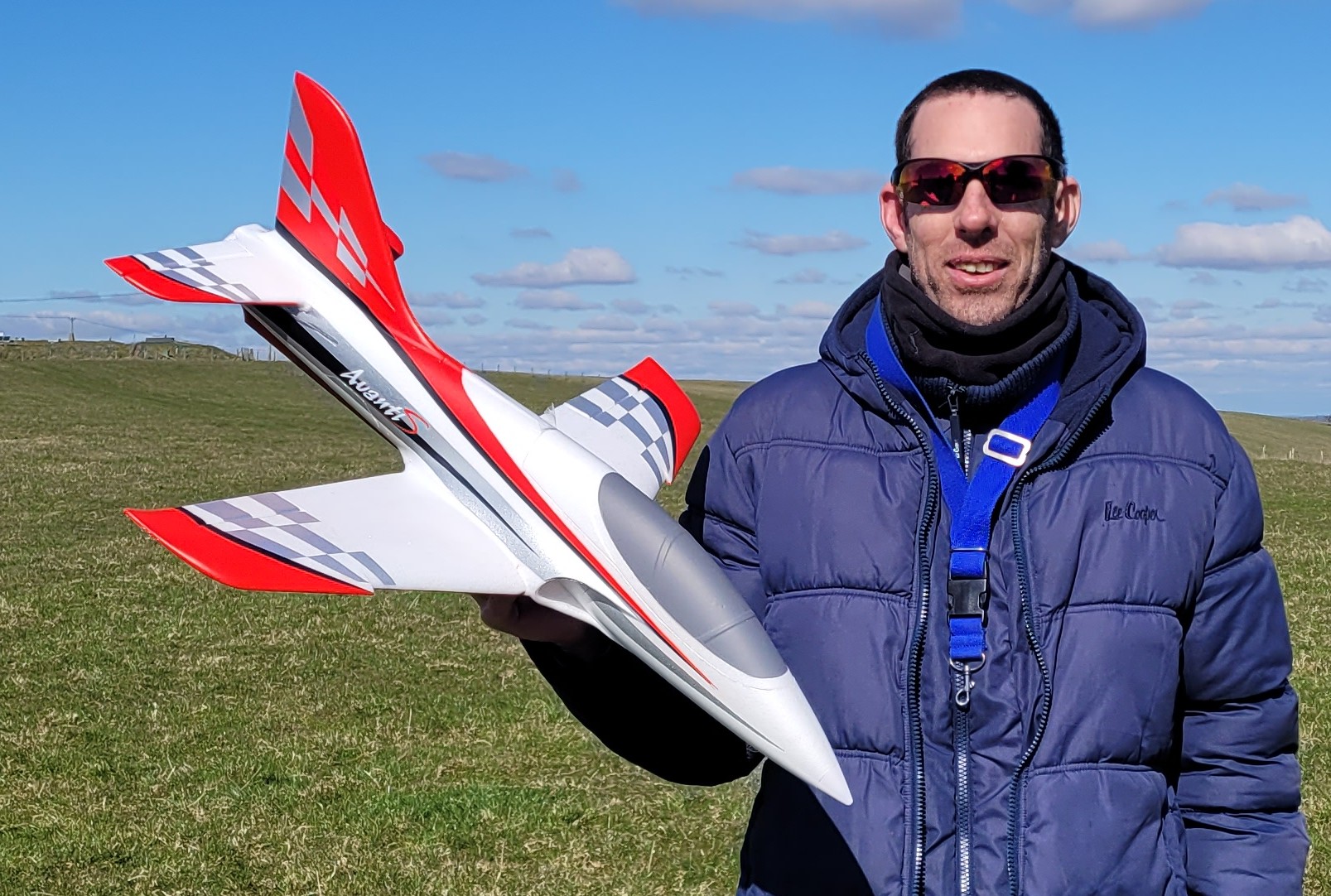 Unlike the Woodpecker that took seven years to make it from plan to play the Avanti was bought and flown in the same month. The EPO foam Avanti comes almost finished with an 11 blade fan, 2627 4500kv motor, 30A esc, 6 axis gyro, and 3x9g servos all pre-installed.
Unlike the Woodpecker that took seven years to make it from plan to play the Avanti was bought and flown in the same month. The EPO foam Avanti comes almost finished with an 11 blade fan, 2627 4500kv motor, 30A esc, 6 axis gyro, and 3x9g servos all pre-installed. 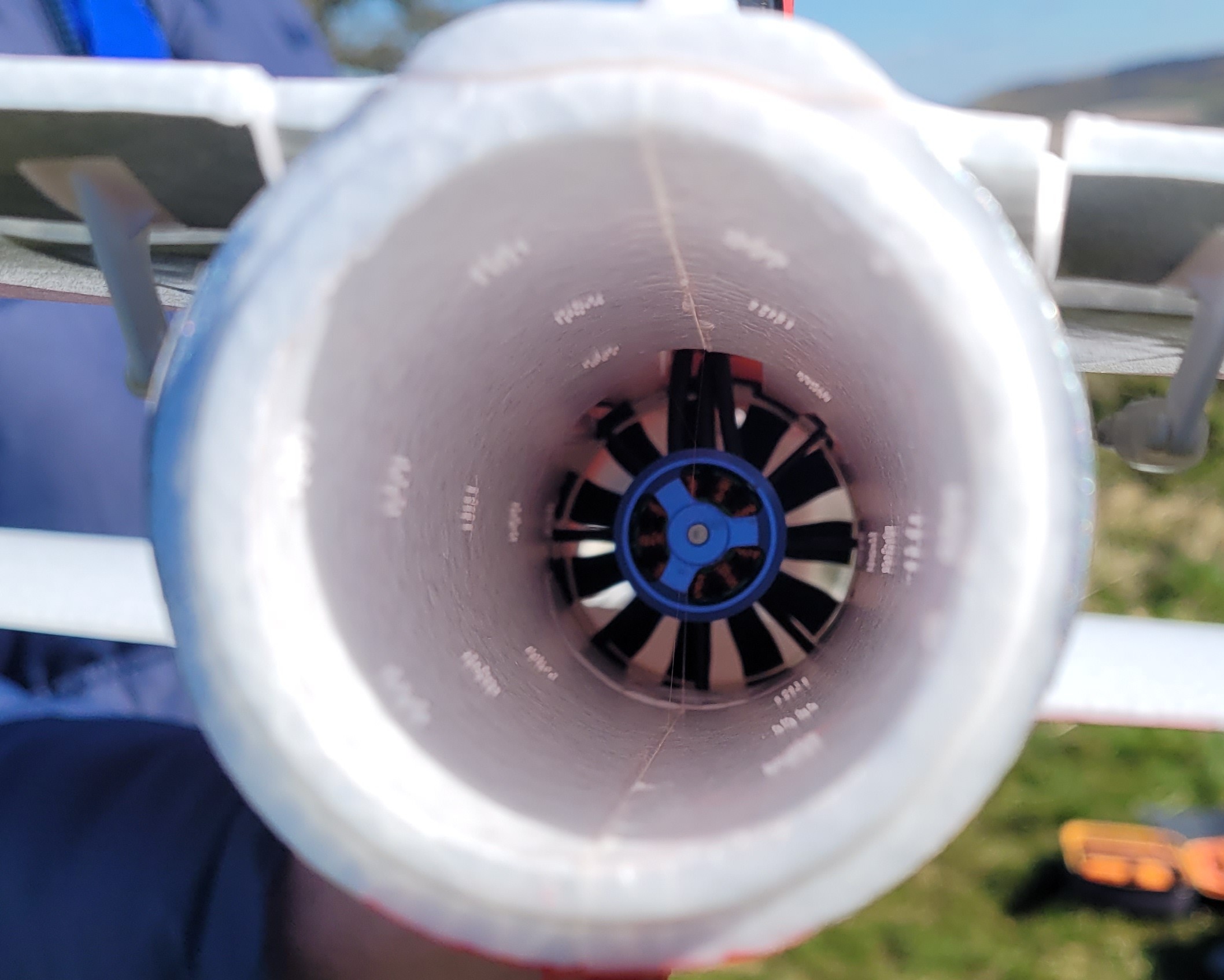
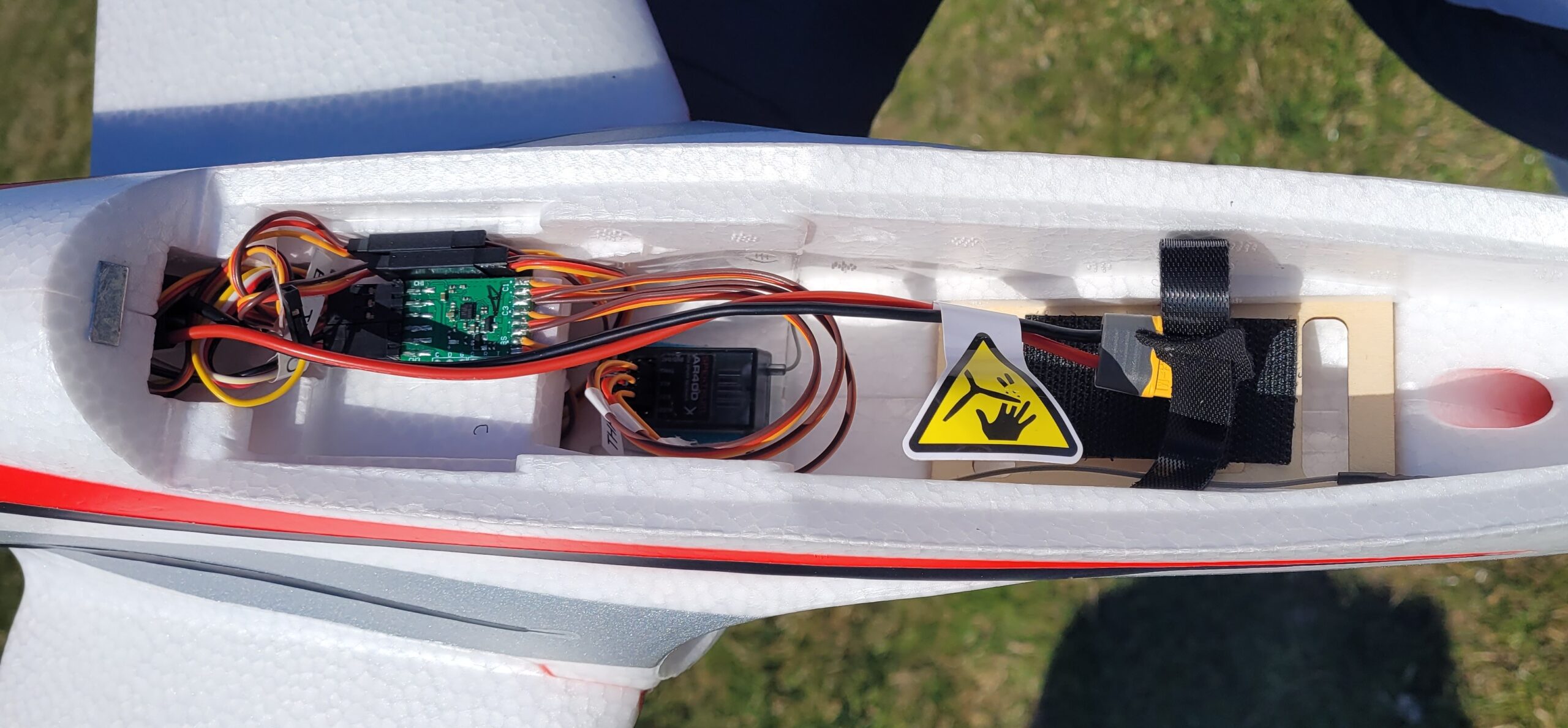 The instructions say just thirty minutes assembly time so buying and flying in the same month should have been easy. This is what the Wheelspin Models website says about it:
The instructions say just thirty minutes assembly time so buying and flying in the same month should have been easy. This is what the Wheelspin Models website says about it:
Where good-looking, top performing, 50mm EDF sport jets are concerned, little can beat the locked-in, arrow-like characteristics of the Arrows Avanti. ‘If it looks right, it’ll fly right they say and in this instance there’s never been a truer word. Sporting Arrows highly-regarded, jet-like 50mm 11-blade fan and 2627 4500KV brushless motor combo, this 3S-fuelled slick ship will appeal to all who seek smooth, torque-free aerobatics, benign handling and a ‘go where you put it’ performance. OK, got that Page Boy?!
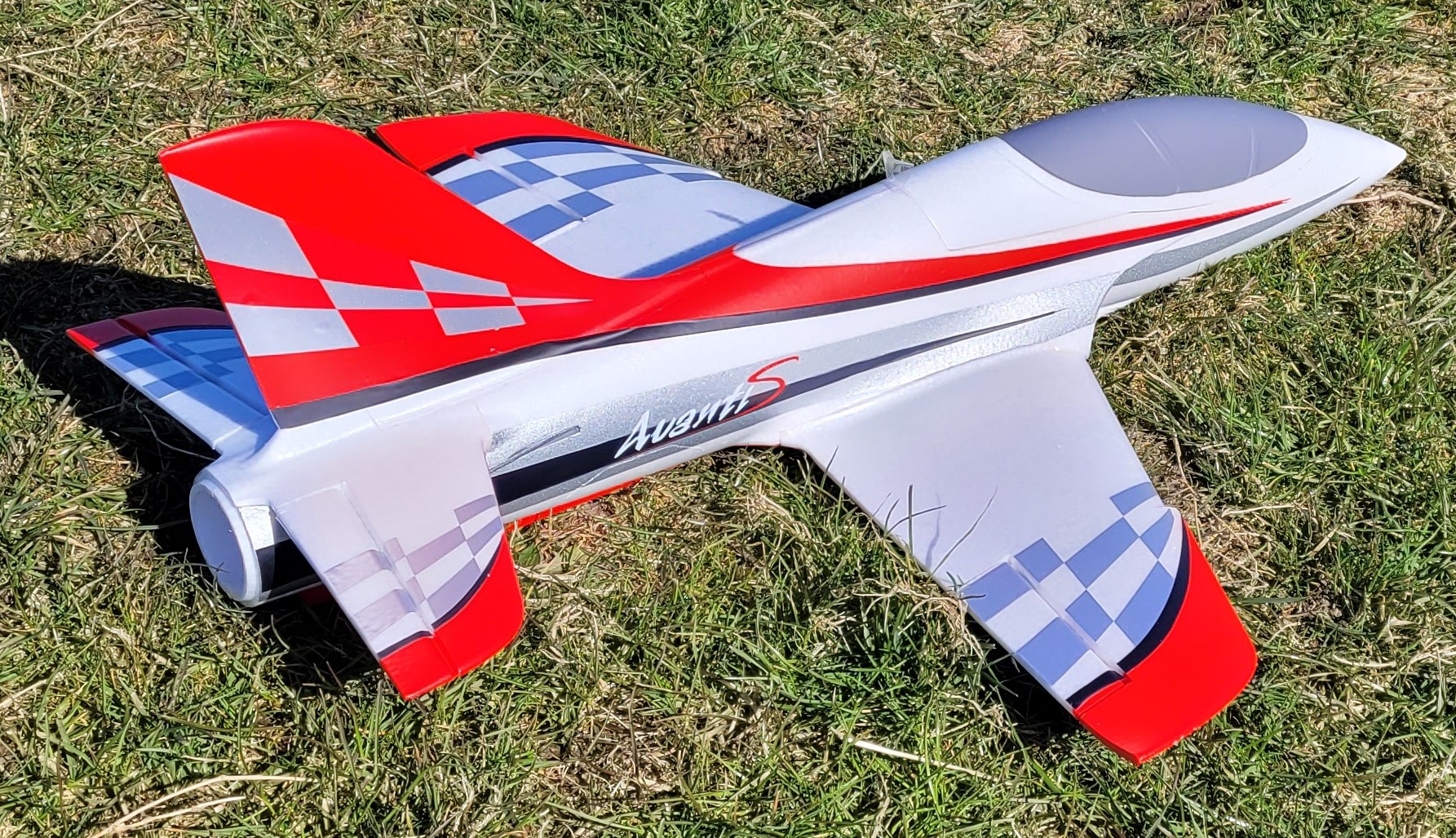 It was quite a windy day that Page Boy test flew his Avanti with some pretty turbulent air so the stabiliser was working hard but all went well and it looked great on the air. Mini Mike also has one of these and they can both be seen flying in this month’s video.
It was quite a windy day that Page Boy test flew his Avanti with some pretty turbulent air so the stabiliser was working hard but all went well and it looked great on the air. Mini Mike also has one of these and they can both be seen flying in this month’s video.
 They were very lucky not to have a mid-air at one point, I captured this rather blurry screenshot from the video, Page Boy’s is the nearest one. He reckoned it must have been Mini Mike’s fault as he was feeling a bit under the weather at the time…poorly lad, as if!
They were very lucky not to have a mid-air at one point, I captured this rather blurry screenshot from the video, Page Boy’s is the nearest one. He reckoned it must have been Mini Mike’s fault as he was feeling a bit under the weather at the time…poorly lad, as if!
I mentioned earlier that Bob the Builder has an XFly Tasman that he’s been flying for a while and he likes it so much that he’s now designed and built himself a mini version of it. 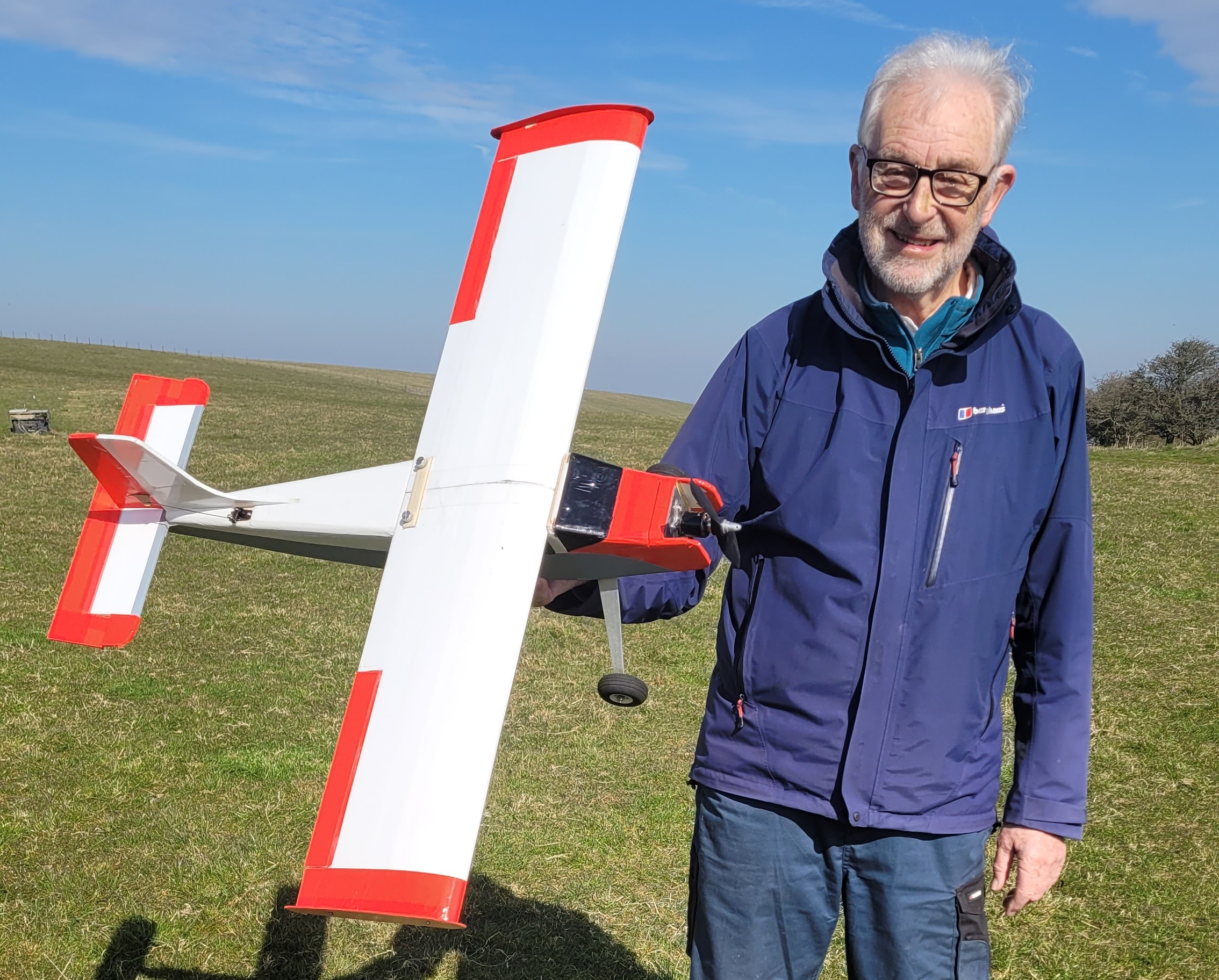 This is what he says about it: Decided I needed to replace my old Basher with something easier to fly. What could be better than a Mini Tasman. I love my big Tasman so decided to scale it down to run a 1300 3s battery. First thoughts were to scale down to 60%. Started making all the dimensions 60%. Wasn’t long before I realised that the wing area was much smaller than 60% which didn’t look right, in fact it was only 36% when you multiplied the wing span by the cord. Decided to change tack and make the area of all flying surfaces 50% of the original area. I watched several YouTube build videos that used 10mm Thermocol foamboard which seemed to make the build very quick and easy. Unfortunately Thermocol doesn’t appear to be available in the UK and the closest I could find was 5mm foam board from Hobbycraft. It was all built from this foam board but with added strength where required and all covered with white or red parcel tape.
This is what he says about it: Decided I needed to replace my old Basher with something easier to fly. What could be better than a Mini Tasman. I love my big Tasman so decided to scale it down to run a 1300 3s battery. First thoughts were to scale down to 60%. Started making all the dimensions 60%. Wasn’t long before I realised that the wing area was much smaller than 60% which didn’t look right, in fact it was only 36% when you multiplied the wing span by the cord. Decided to change tack and make the area of all flying surfaces 50% of the original area. I watched several YouTube build videos that used 10mm Thermocol foamboard which seemed to make the build very quick and easy. Unfortunately Thermocol doesn’t appear to be available in the UK and the closest I could find was 5mm foam board from Hobbycraft. It was all built from this foam board but with added strength where required and all covered with white or red parcel tape.
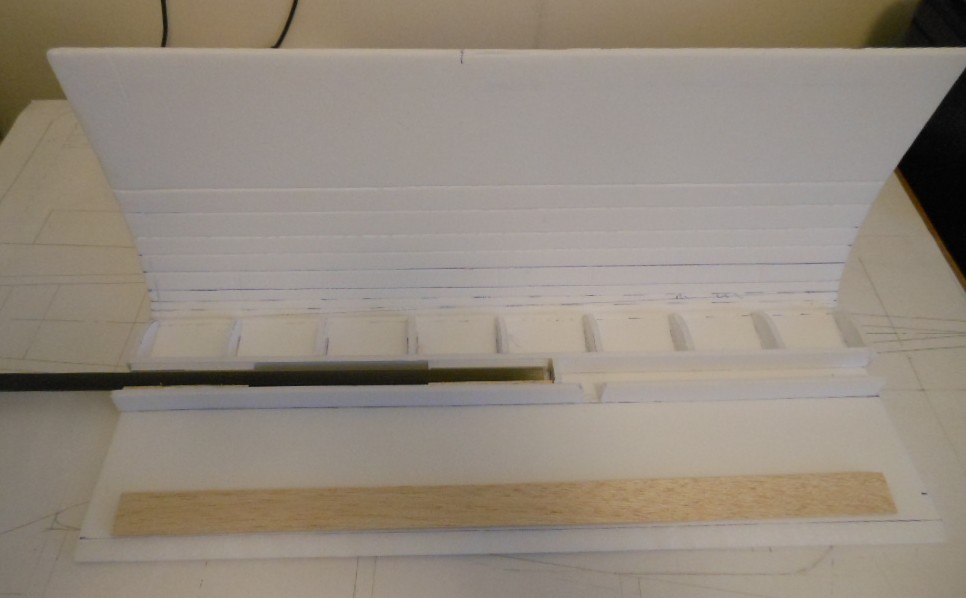
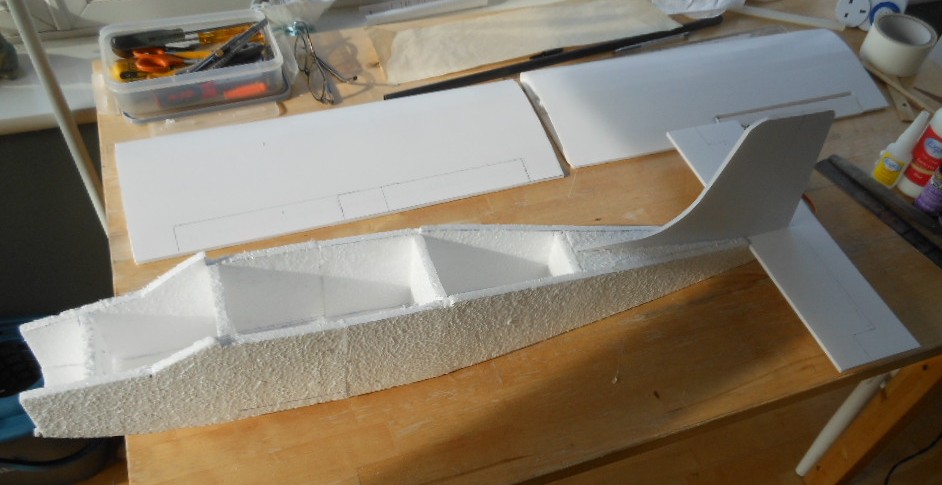
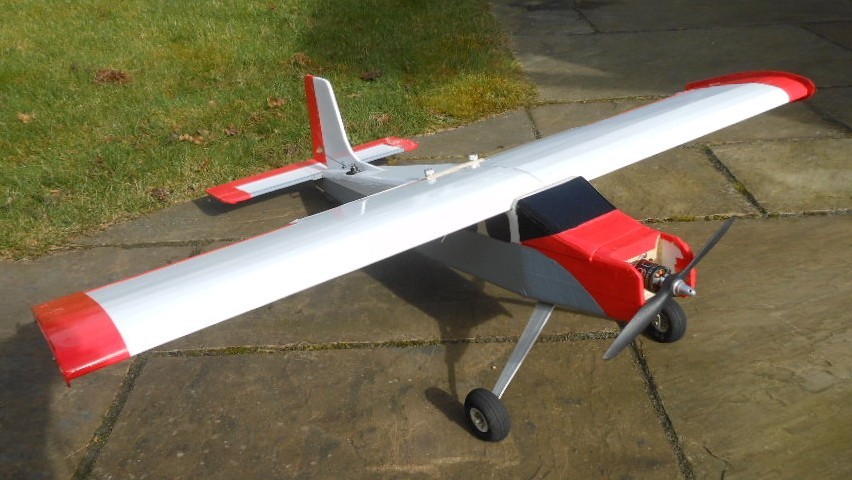 The fuselage bottom has been sprayed with grey paint. Technical data: Wingspan 1000mm, flying weight with 1300 3cell =1065grm, motor is a Hobbyking Propdrive 28/36 1400KV with a 9×6 Prop at 270 watts, 4 servos of 11grms. No flaps or wing struts yet and I need bigger wheels. A little more than half the weight of big Tasman with half the wing area so should fly OK but not quite as slow. Thanks Bob. To save weight Bob has removed the paper covering from much of the foam by soaking it in water. The pics show the construction method well, including the folded over wing profile and carbon joiner.
The fuselage bottom has been sprayed with grey paint. Technical data: Wingspan 1000mm, flying weight with 1300 3cell =1065grm, motor is a Hobbyking Propdrive 28/36 1400KV with a 9×6 Prop at 270 watts, 4 servos of 11grms. No flaps or wing struts yet and I need bigger wheels. A little more than half the weight of big Tasman with half the wing area so should fly OK but not quite as slow. Thanks Bob. To save weight Bob has removed the paper covering from much of the foam by soaking it in water. The pics show the construction method well, including the folded over wing profile and carbon joiner.
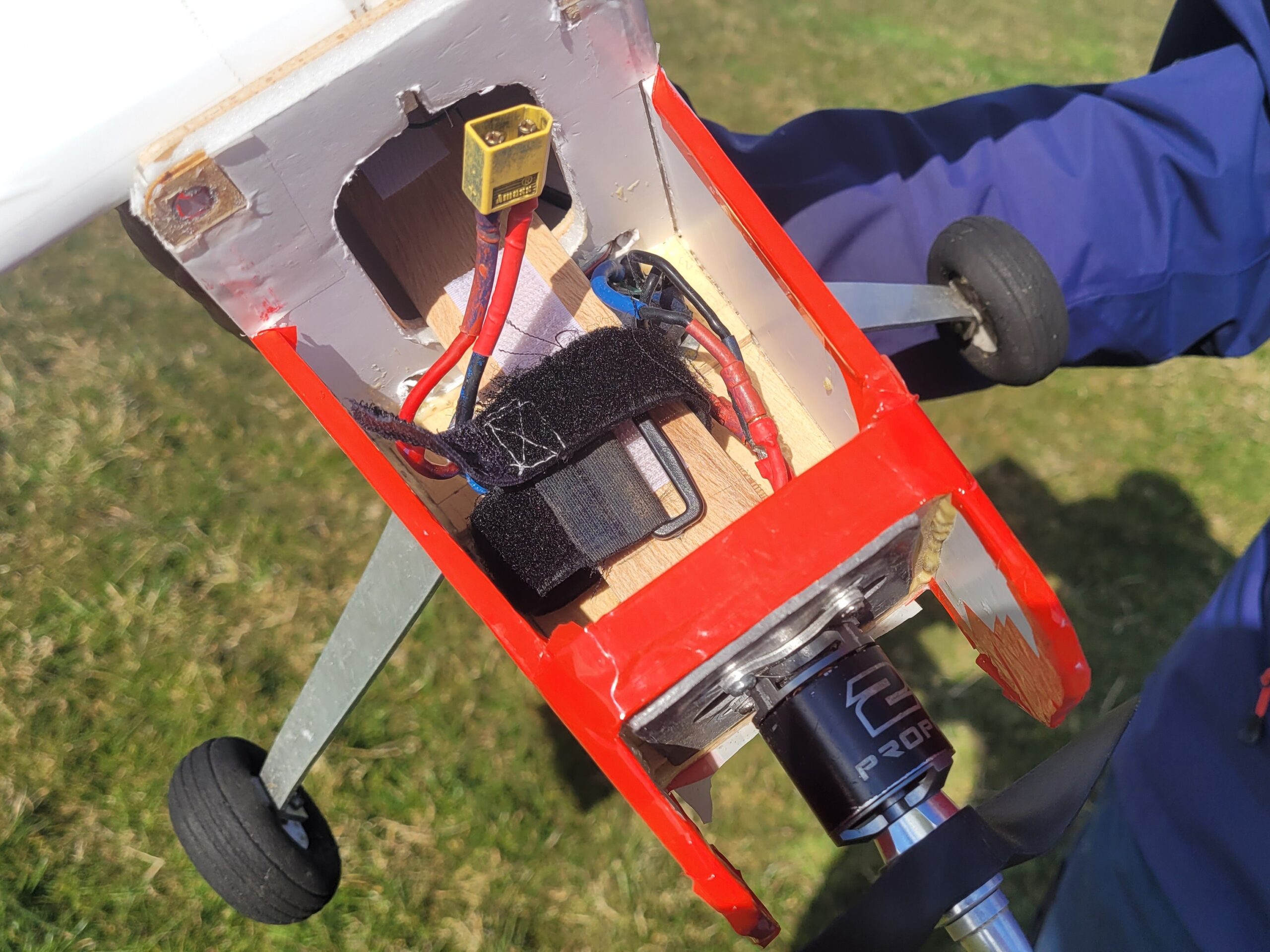 I did the initial trimming for Bob and the plane flew well. I then handed over to Bob and he flew it around for a few minutes before it suddenly dived into the ground. Bob wonders if he’d stalled it but I don’t think so, maybe something broke. The model was damaged but not too badly so Bob soon had it flying again. Everything appeared to be working perfectly but shortly after take-off the Mini Tasman lost radio contact and crashed again. It’s fairly easy to repair and Bob has changed the speed controller as that appears to have been the cause. He will of course give the whole thing a thorough check over before he tries again.
I did the initial trimming for Bob and the plane flew well. I then handed over to Bob and he flew it around for a few minutes before it suddenly dived into the ground. Bob wonders if he’d stalled it but I don’t think so, maybe something broke. The model was damaged but not too badly so Bob soon had it flying again. Everything appeared to be working perfectly but shortly after take-off the Mini Tasman lost radio contact and crashed again. It’s fairly easy to repair and Bob has changed the speed controller as that appears to have been the cause. He will of course give the whole thing a thorough check over before he tries again.
After taking a couple of months away from working on his Mirus 1066 finally got down to finishing and flying it in March. There were a few things he wasn’t happy about in the build, hence the delay, but now it’s all done and the end result looks good.
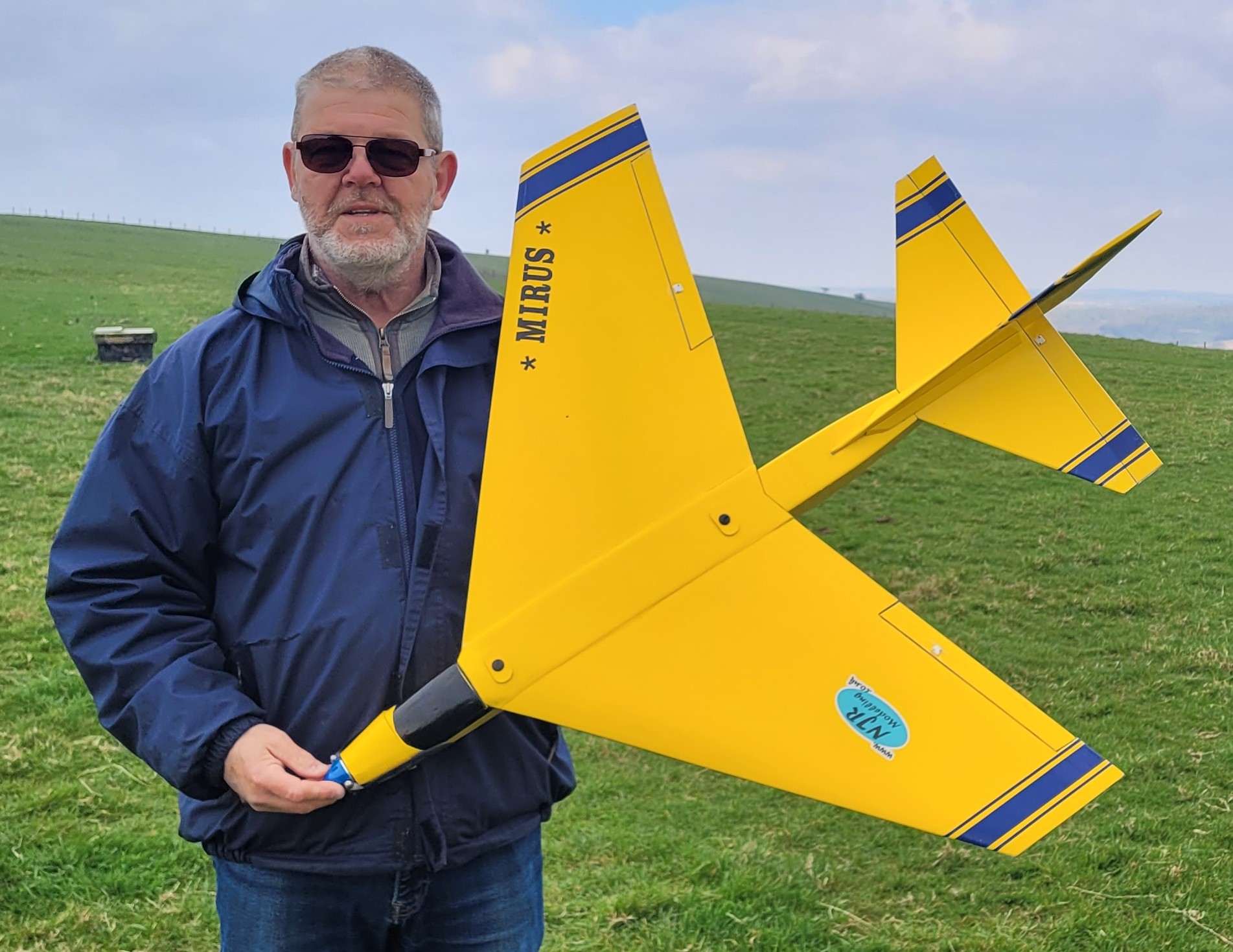 1066 says he had trouble with the covering on the underside and then found it tricky to see in the air so he’s jazzed it up with a few stickers, perfect! He’s fitted a 35mm 1000kv motor, a 70A speed controller, and powers it with a 4 cell 3300 or 3600mAh lipo battery.
1066 says he had trouble with the covering on the underside and then found it tricky to see in the air so he’s jazzed it up with a few stickers, perfect! He’s fitted a 35mm 1000kv motor, a 70A speed controller, and powers it with a 4 cell 3300 or 3600mAh lipo battery.
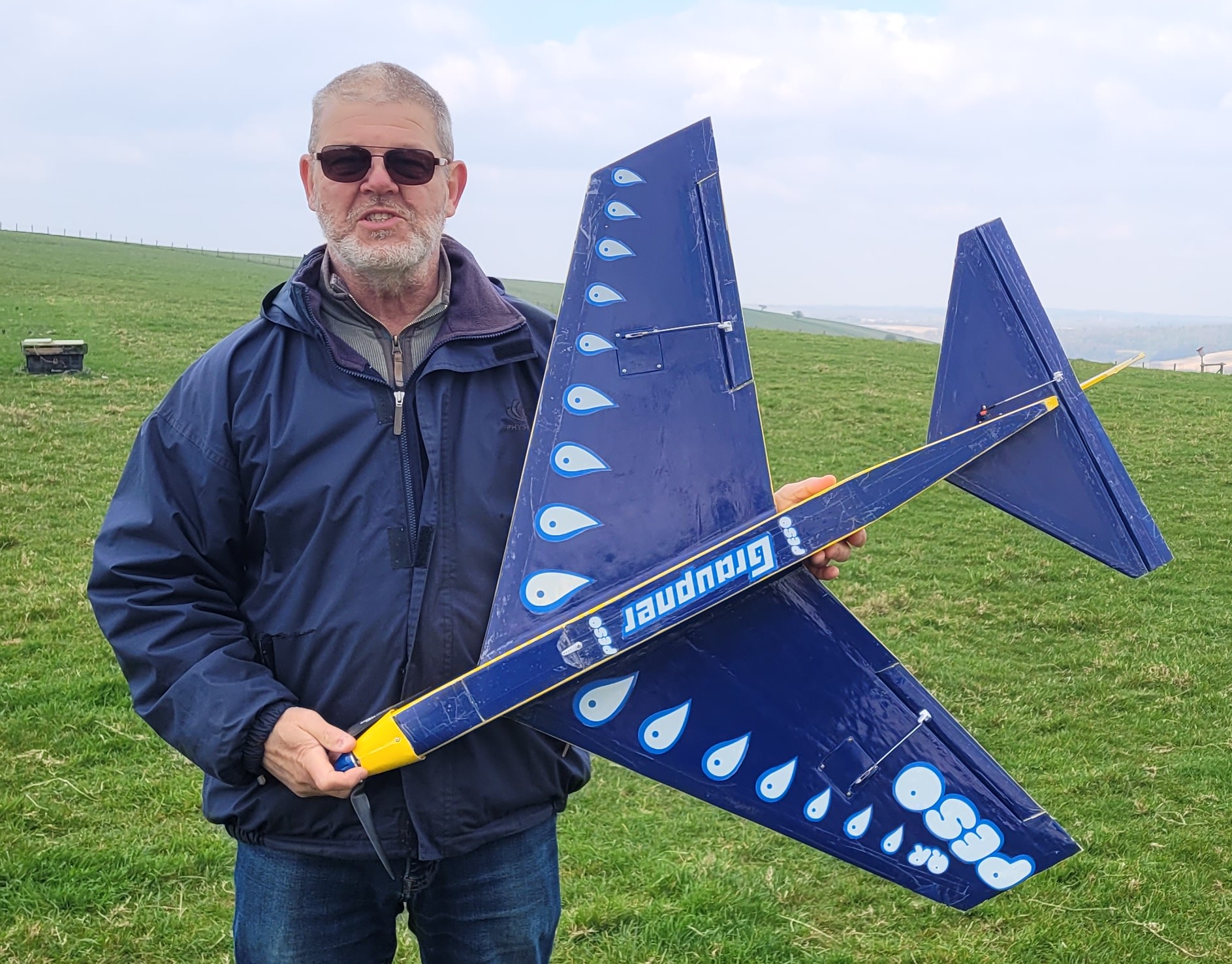 Knowing that it’s very easy to break the prop when landing a Mirus 1066 decided to try an Aeronaut folding prop and for the first flight he fitted a 12×8. The Mirus flew well but wasn’t as fast as he’d hoped, plus it was pulling close to the limit of the esc so he switched to an 11×6 folder which worked much better, more speed and a lower current draw.
Knowing that it’s very easy to break the prop when landing a Mirus 1066 decided to try an Aeronaut folding prop and for the first flight he fitted a 12×8. The Mirus flew well but wasn’t as fast as he’d hoped, plus it was pulling close to the limit of the esc so he switched to an 11×6 folder which worked much better, more speed and a lower current draw.
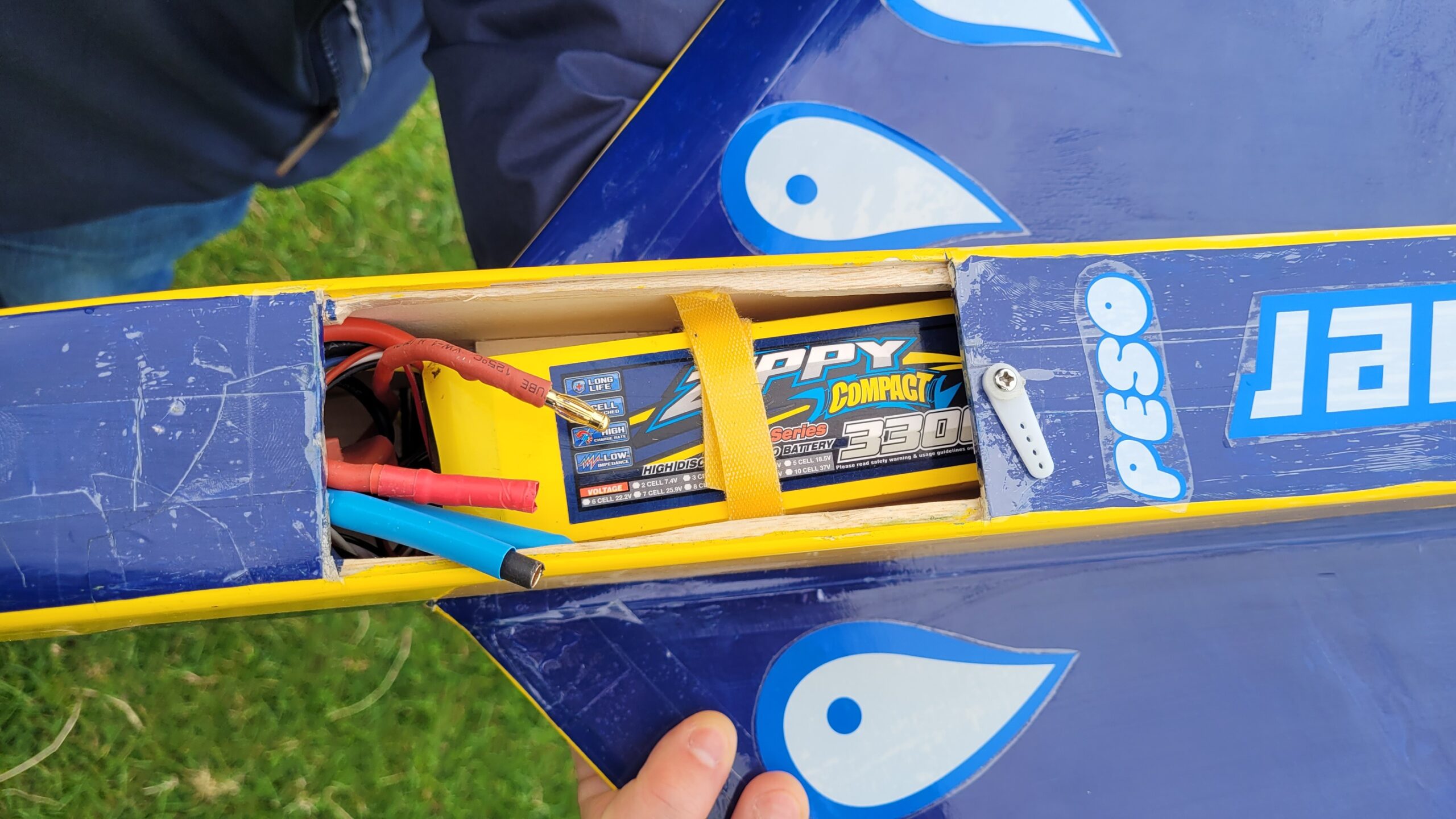 Having hand launched the Mirus a few times I can testify that it has a lot pull! You can see how it went on the first flight in this month’s video, on subsequent flights it was faster.
Having hand launched the Mirus a few times I can testify that it has a lot pull! You can see how it went on the first flight in this month’s video, on subsequent flights it was faster.
Last month I wrote that Woody was building a Yellow that he had bought as a plan and laser cut kit from Sarik Hobbies. He’s now finished the build and has finished it in blue covering. Woody has added some yellow trim in keeping with the Yellow name but just to confuse us all he is calling it Bluey instead. The covering is Ripmax heat shrink film.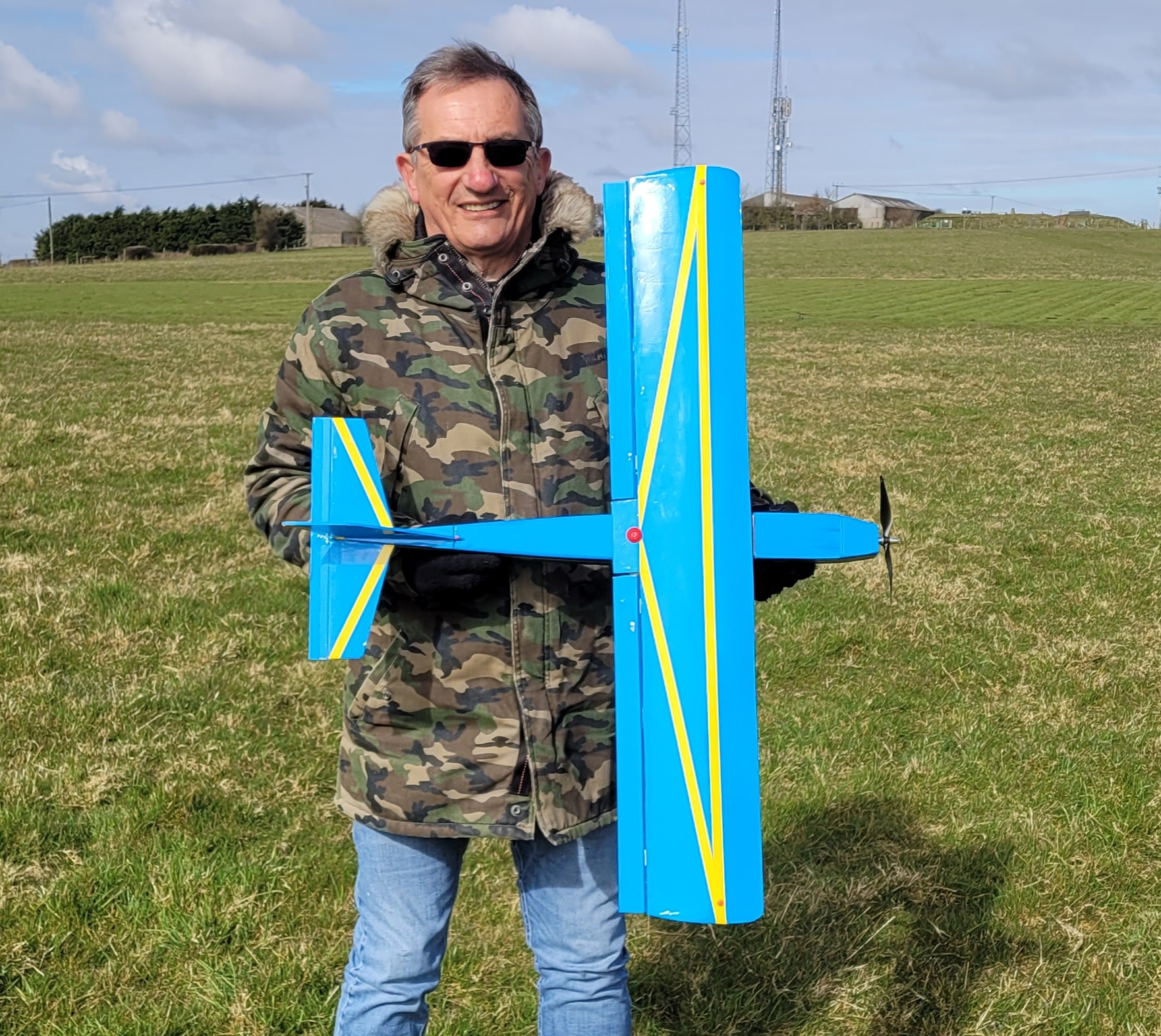
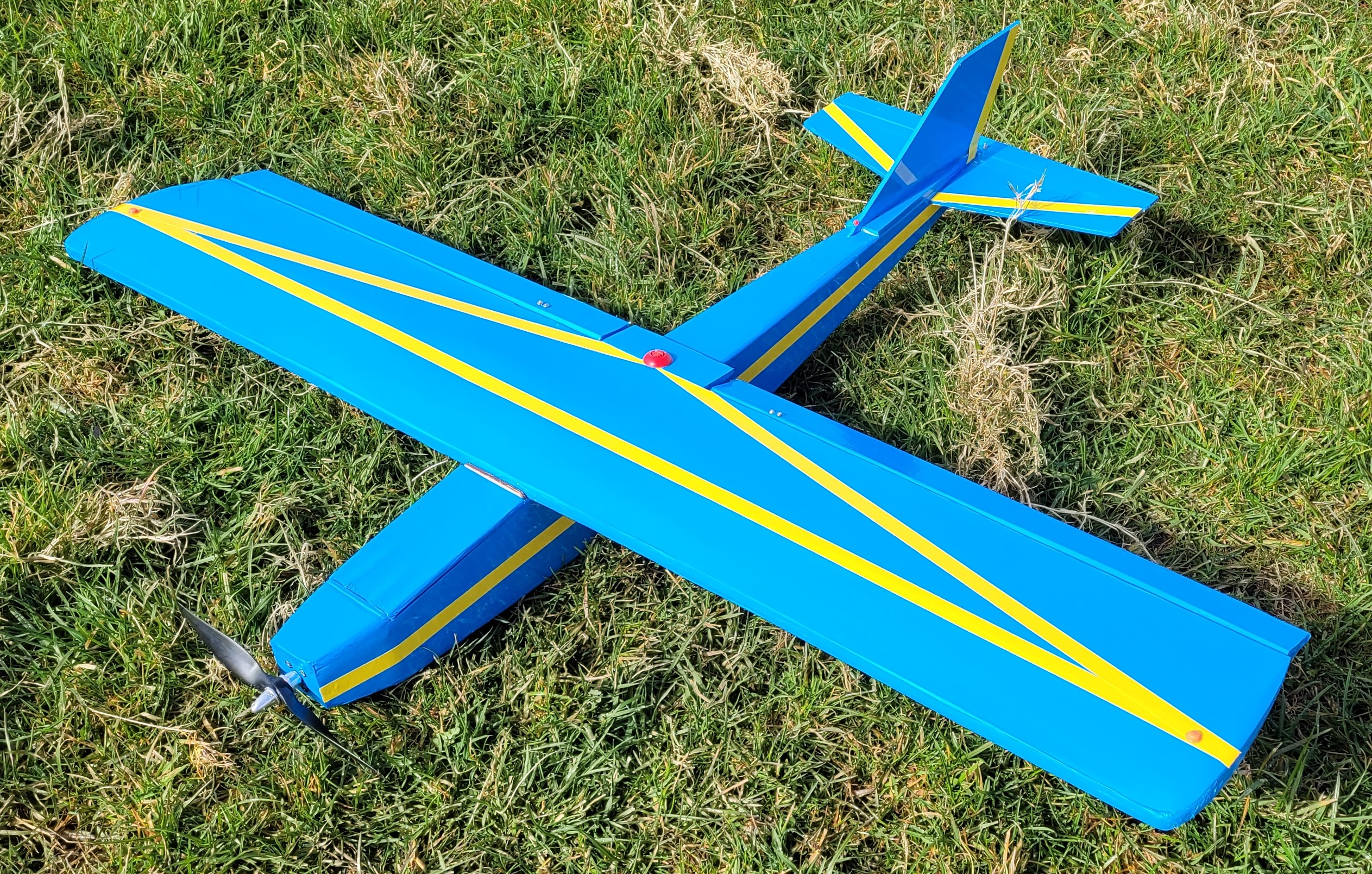
He has fitted a 2810 1400kv motor with a 7×5 propeller coupled to a 30A speed controller and is using a 3 cell 1000mAh lipo. Bluey had a few flights in March with no real problems but Woody is gradually making a few adjustments to get it flying just as he likes.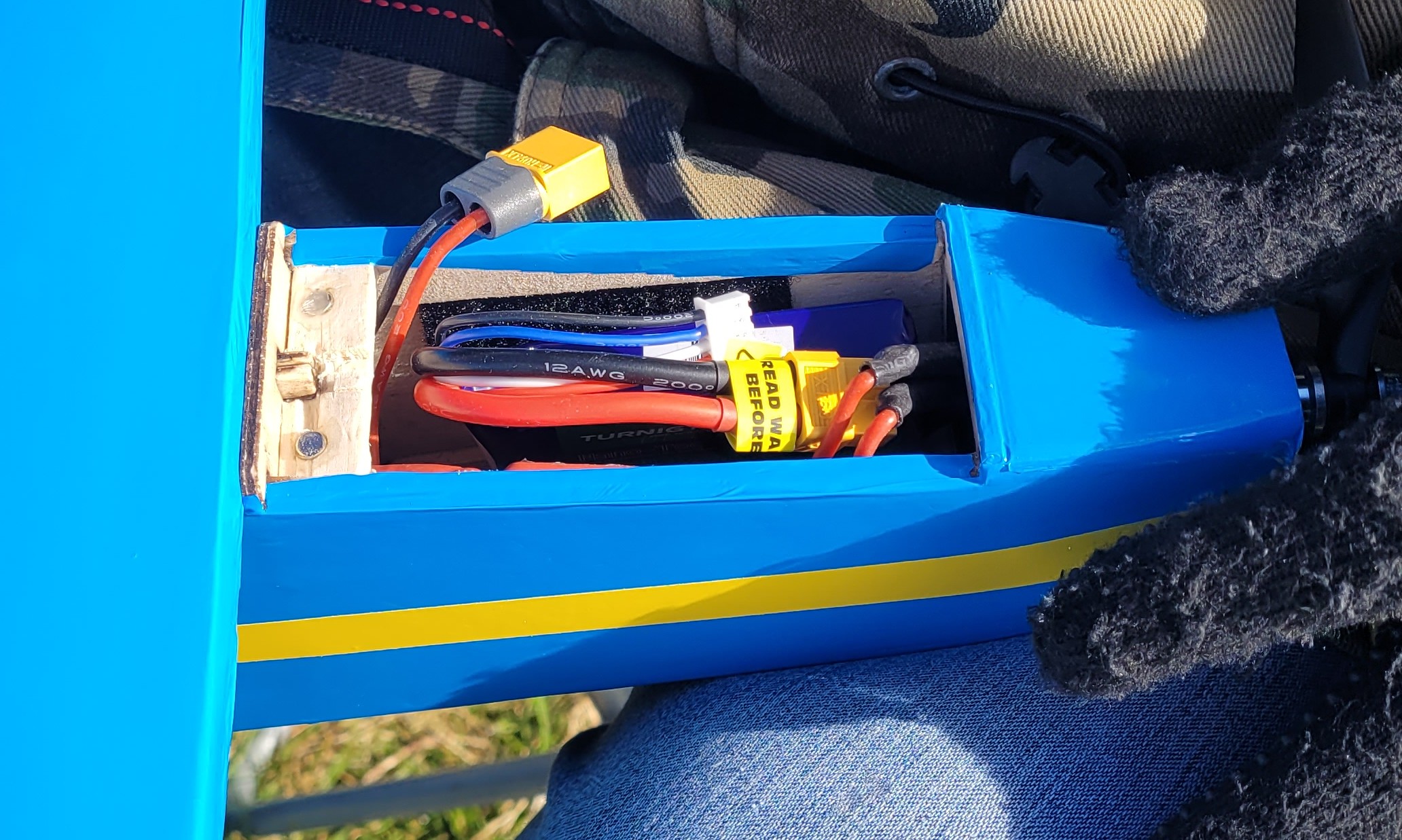
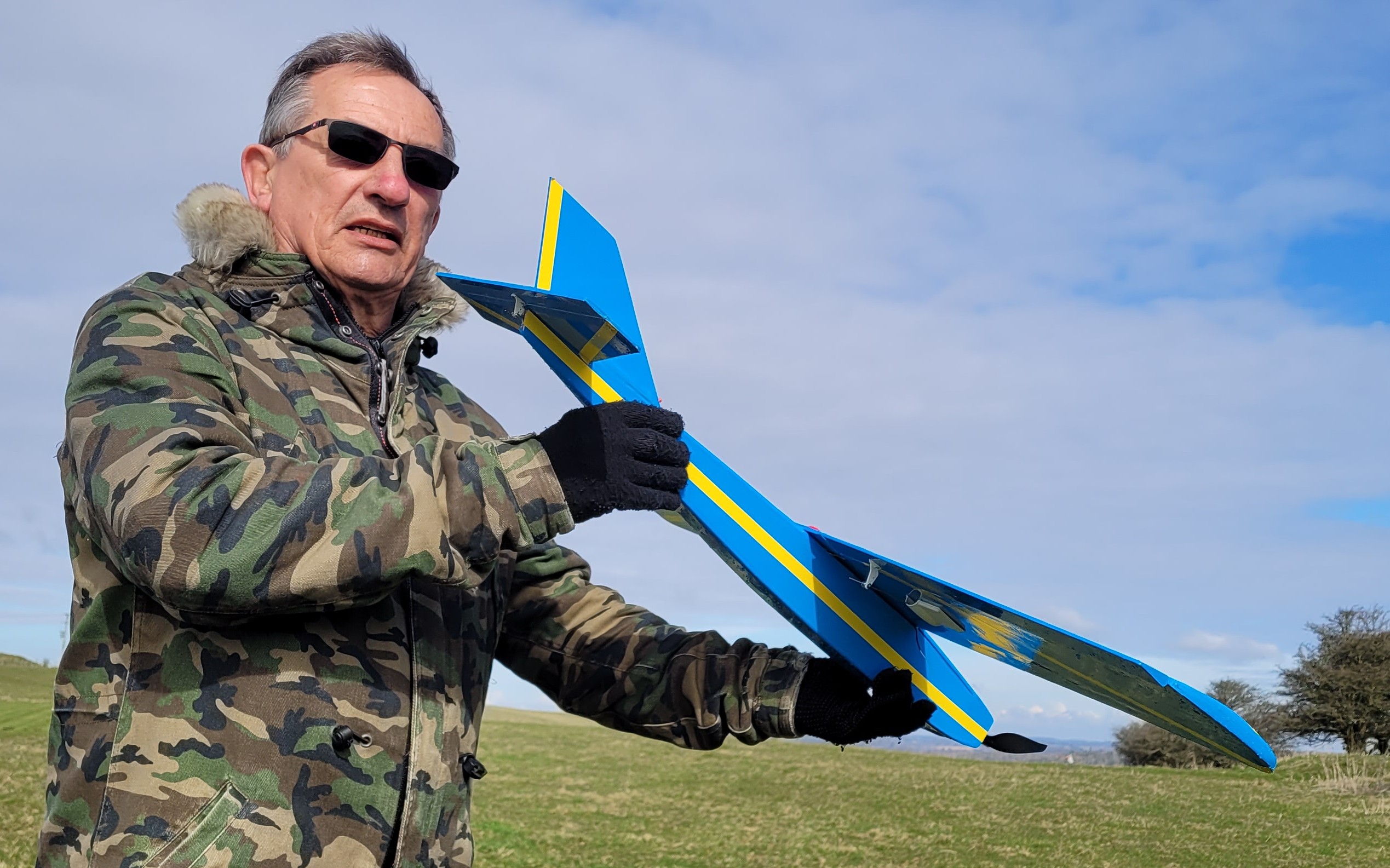
Looking very smart…Bluey not Woody! None of the usual suspects managed to shoot any video of the Bluey flying in March but hopefully I’ll be able to include some next month.
In March I got two models out of semi-retirement and have enjoyed flying them both. First was a Kyosho Raptor that I’d put together back in 2017. Oh look, I haven’t changed a bit…
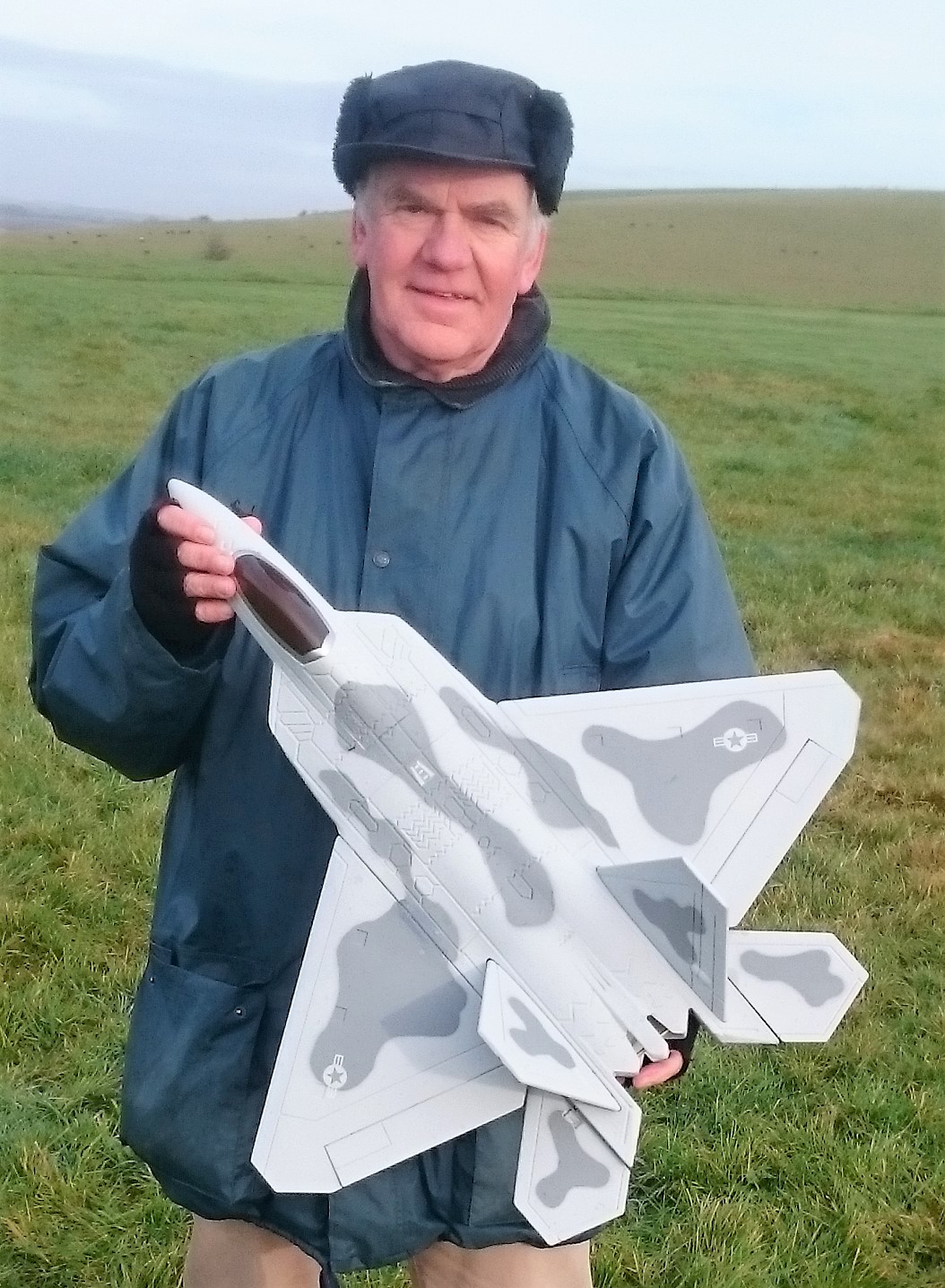 It flew well but one of the aileron servos kept freezing momentarily in flight, fortunately always in the neutral position. Obviously I needed to change the servo but the wiring on the Raptor was all glued in place during the construction to keep the EDF airflow clear.
It flew well but one of the aileron servos kept freezing momentarily in flight, fortunately always in the neutral position. Obviously I needed to change the servo but the wiring on the Raptor was all glued in place during the construction to keep the EDF airflow clear.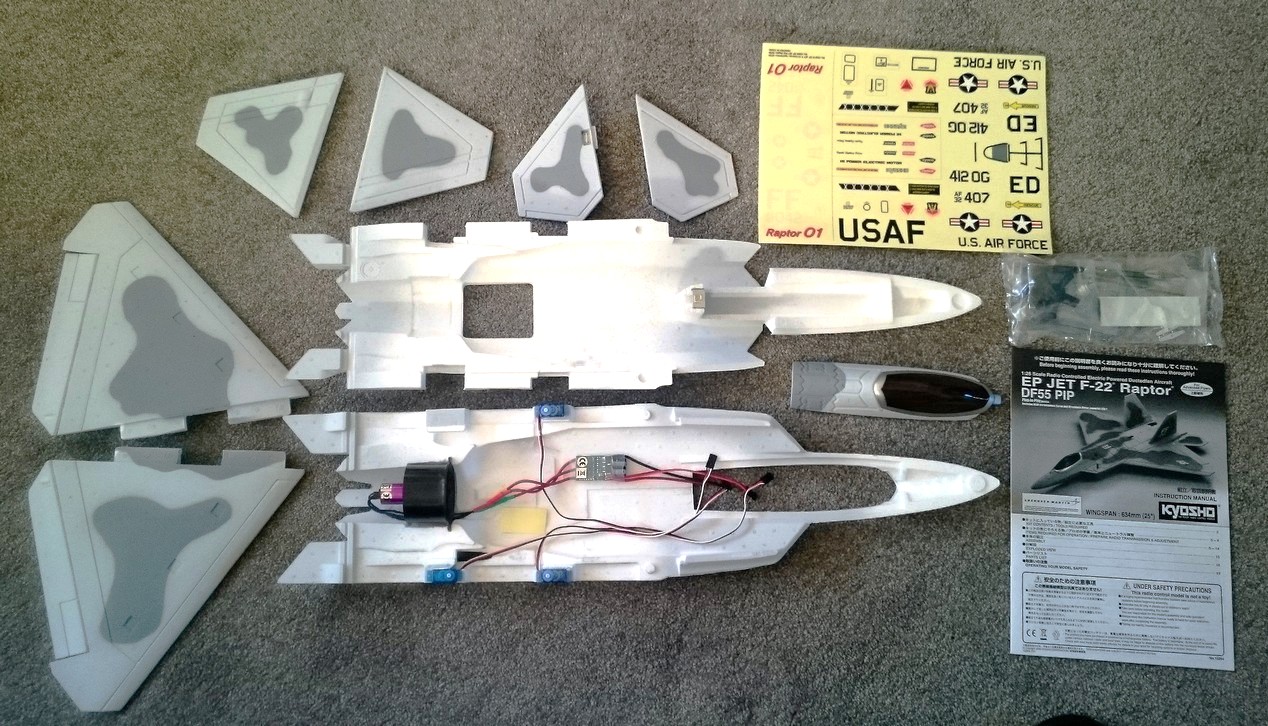
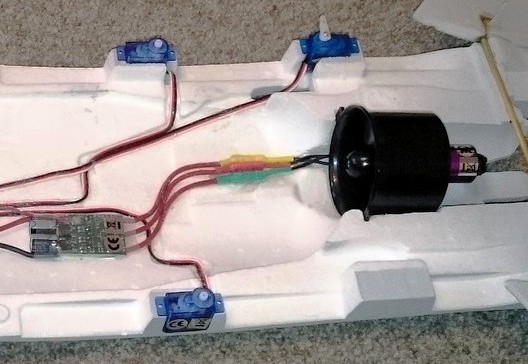 So I stopped flying it while I pondered…for several years! I decided the only thing to do was to cut the servo off, leaving the wire glued in place, and then run the new servo wire through the duct as neatly as possible. Once I’d bitten the bullet if was very easily done, something I should have sorted years ago! The other change I made was to enlarge the battery bay slightly so I could use 2200mAh 3 cell packs instead of the 1300mAh packs.
So I stopped flying it while I pondered…for several years! I decided the only thing to do was to cut the servo off, leaving the wire glued in place, and then run the new servo wire through the duct as neatly as possible. Once I’d bitten the bullet if was very easily done, something I should have sorted years ago! The other change I made was to enlarge the battery bay slightly so I could use 2200mAh 3 cell packs instead of the 1300mAh packs.
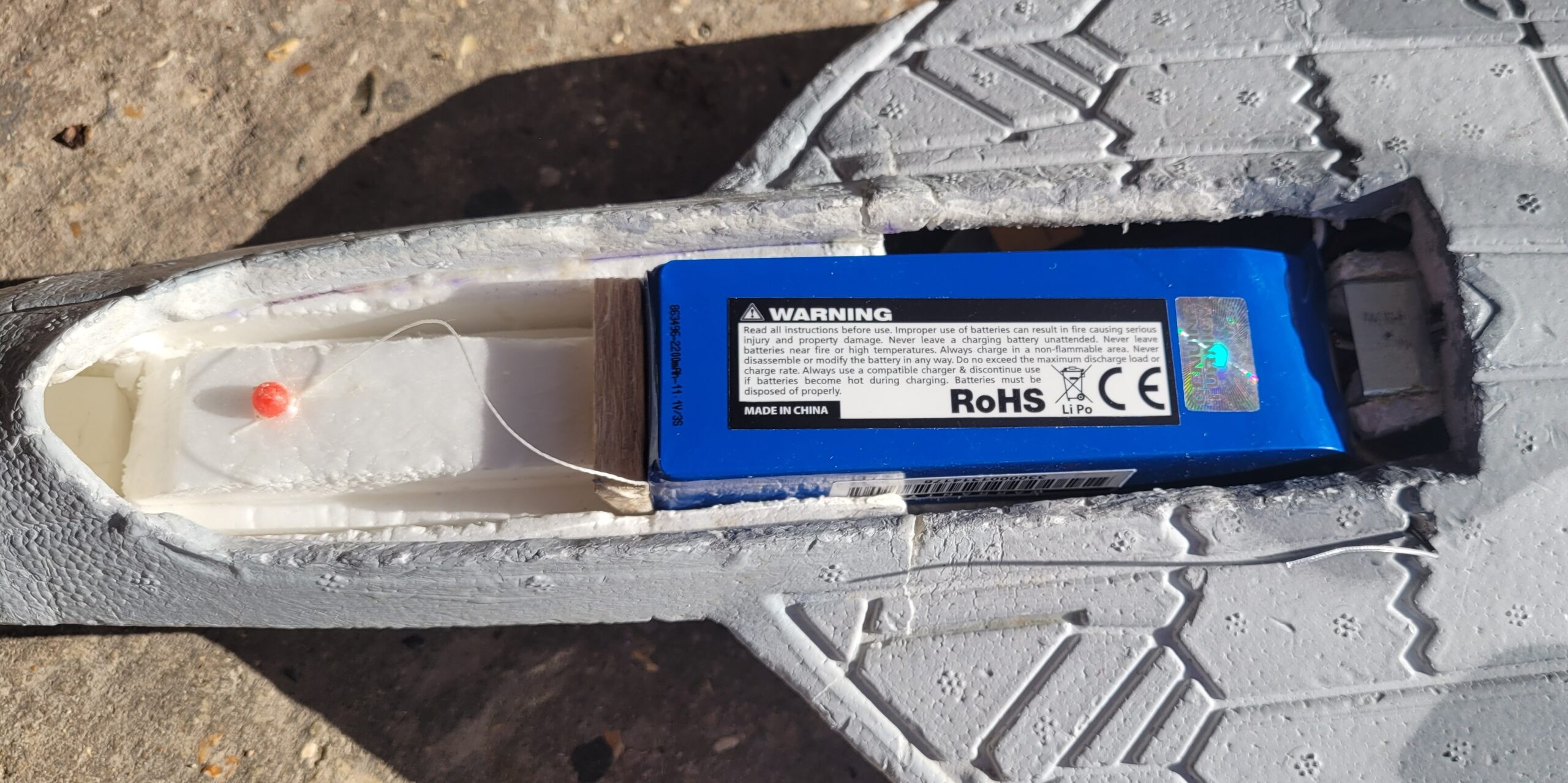 This meant adding even more lead to the tail to correct the centre of gravity so, with the extra battery weight and the lead, the Raptor is now considerably heavier than intended. It needs a bit more of a chuck to get it away from the launch but once airborne it is nice and smooth to fly and I get around five minutes airtime. It’s in the video, I think it looks good.
This meant adding even more lead to the tail to correct the centre of gravity so, with the extra battery weight and the lead, the Raptor is now considerably heavier than intended. It needs a bit more of a chuck to get it away from the launch but once airborne it is nice and smooth to fly and I get around five minutes airtime. It’s in the video, I think it looks good.
The other rejuvenated model is my little Sharkface, another model that I had built in 2017.
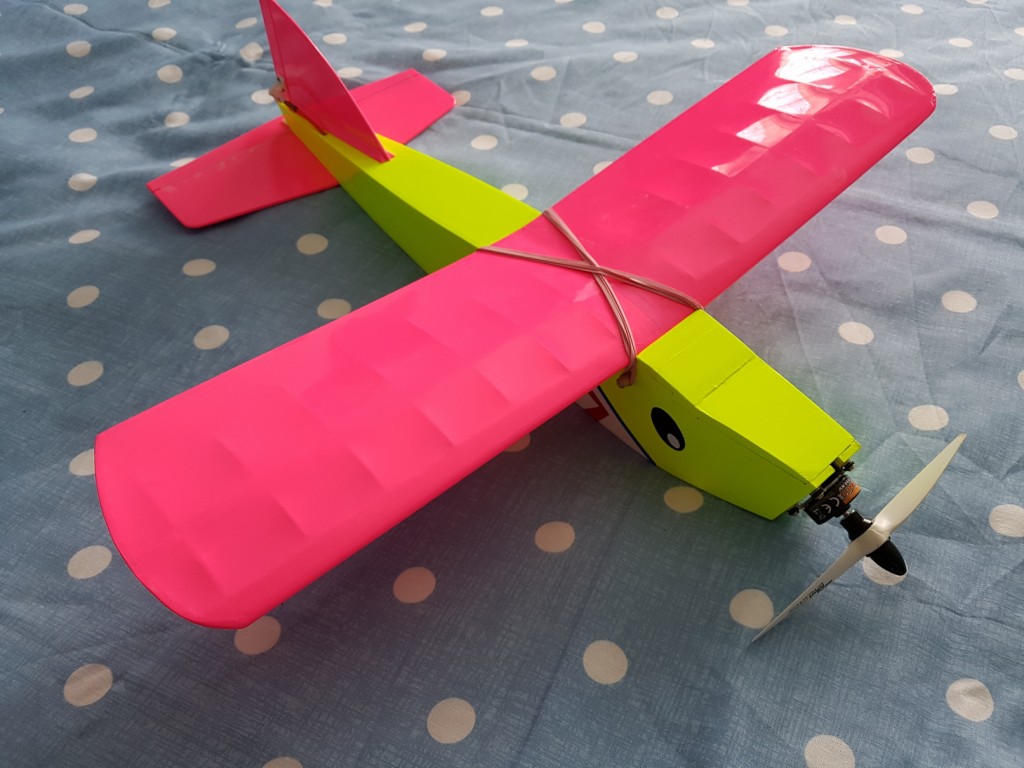 The original was a single channel (rudder only) model designed in 1965 by Eric Clutton and in those days many people fitted them with Cox .049 glow-plug engines, although the design says for up to 1.5cc so some modellers fitted one of the small diesel engines that were popular in the sixties. In March 2017 RCM&E re-issued the original plan along with an article by Shaun Garrity and also added a Mk2 version of the plan which updated it for modern radio by adding an elevator. I’d stopped flying mine because I’d damaged the old ‘bell’ type motor it was fitted with and although it still ran there was a terrible vibration.
The original was a single channel (rudder only) model designed in 1965 by Eric Clutton and in those days many people fitted them with Cox .049 glow-plug engines, although the design says for up to 1.5cc so some modellers fitted one of the small diesel engines that were popular in the sixties. In March 2017 RCM&E re-issued the original plan along with an article by Shaun Garrity and also added a Mk2 version of the plan which updated it for modern radio by adding an elevator. I’d stopped flying mine because I’d damaged the old ‘bell’ type motor it was fitted with and although it still ran there was a terrible vibration.
This month I rummaged through my stuff for the smallest motor I could find but the best I had was a drone motor from an old foamboard model. It was soon fitted along with a 30A speed controller and, as the old bell motor only used a 10A controller, I knew there was going to be huge increase in power! I fitted the smallest prop I could find, a 5×4, and gave it a go. The first couple of flights were ‘interesting.’ I’ve found that it needs to be launched at less than half throttle and, having reduced the rates a lot, it flies well… mad but well!
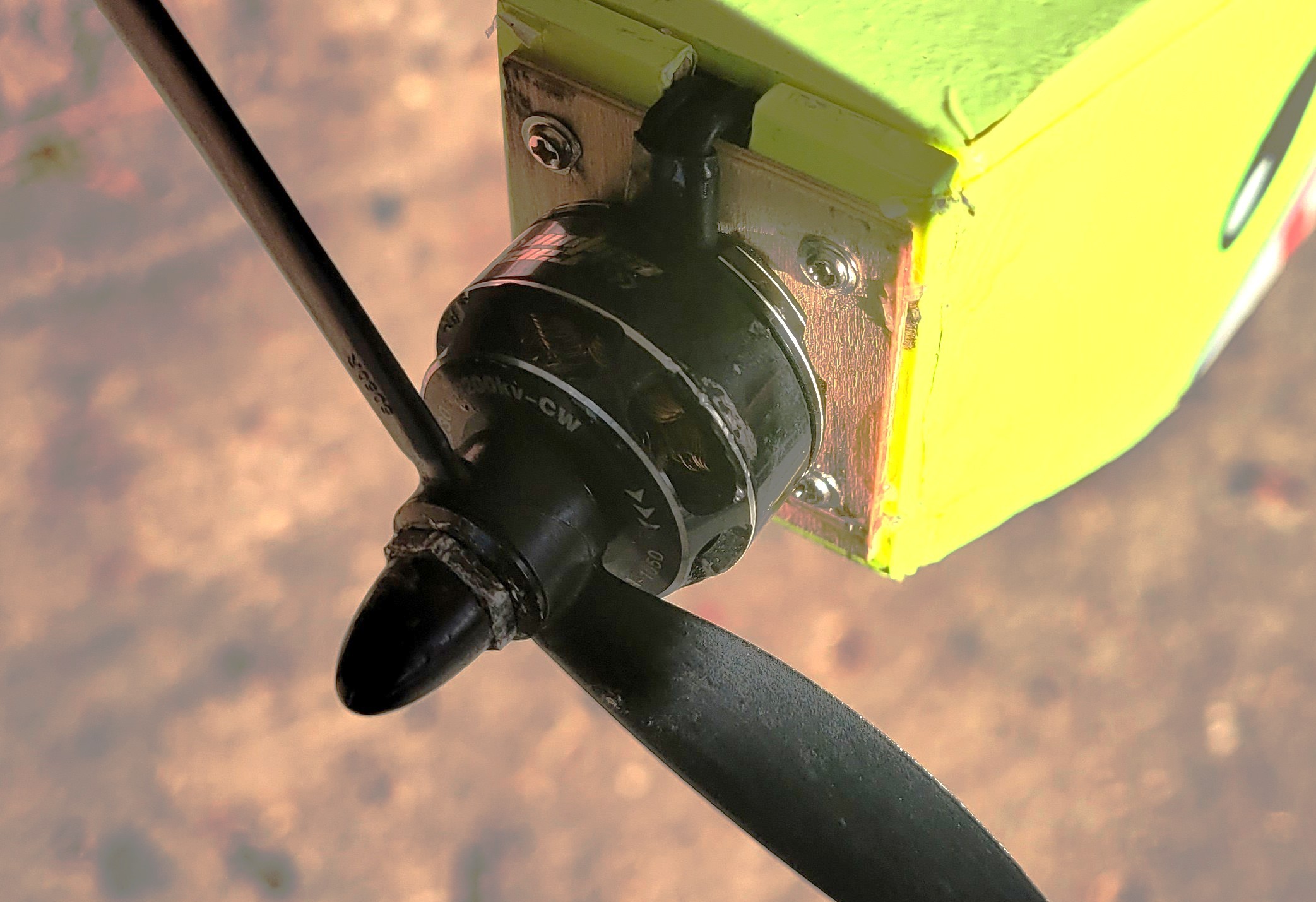 Note how much the covering has faded over the eight years since I built it. I was very lucky with one landing which finished right on the spot, total fluke, I wasn’t even aiming for it!
Note how much the covering has faded over the eight years since I built it. I was very lucky with one landing which finished right on the spot, total fluke, I wasn’t even aiming for it!
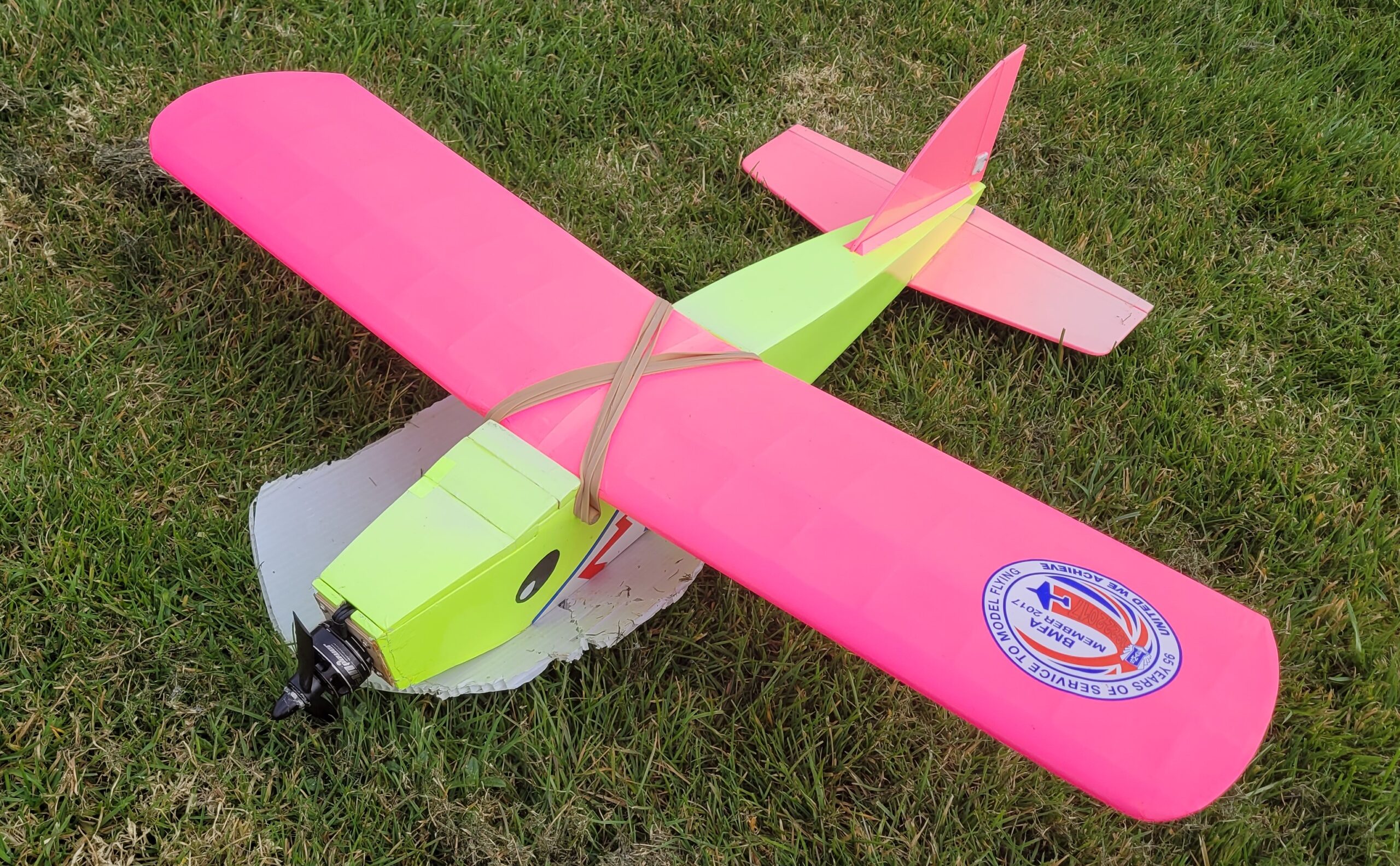 You can see the Sharkface in action in the video, it’s ridiculously overpowered but fun.
You can see the Sharkface in action in the video, it’s ridiculously overpowered but fun.
The action shots this month are all taken from the video so rather poor quality I’m afraid: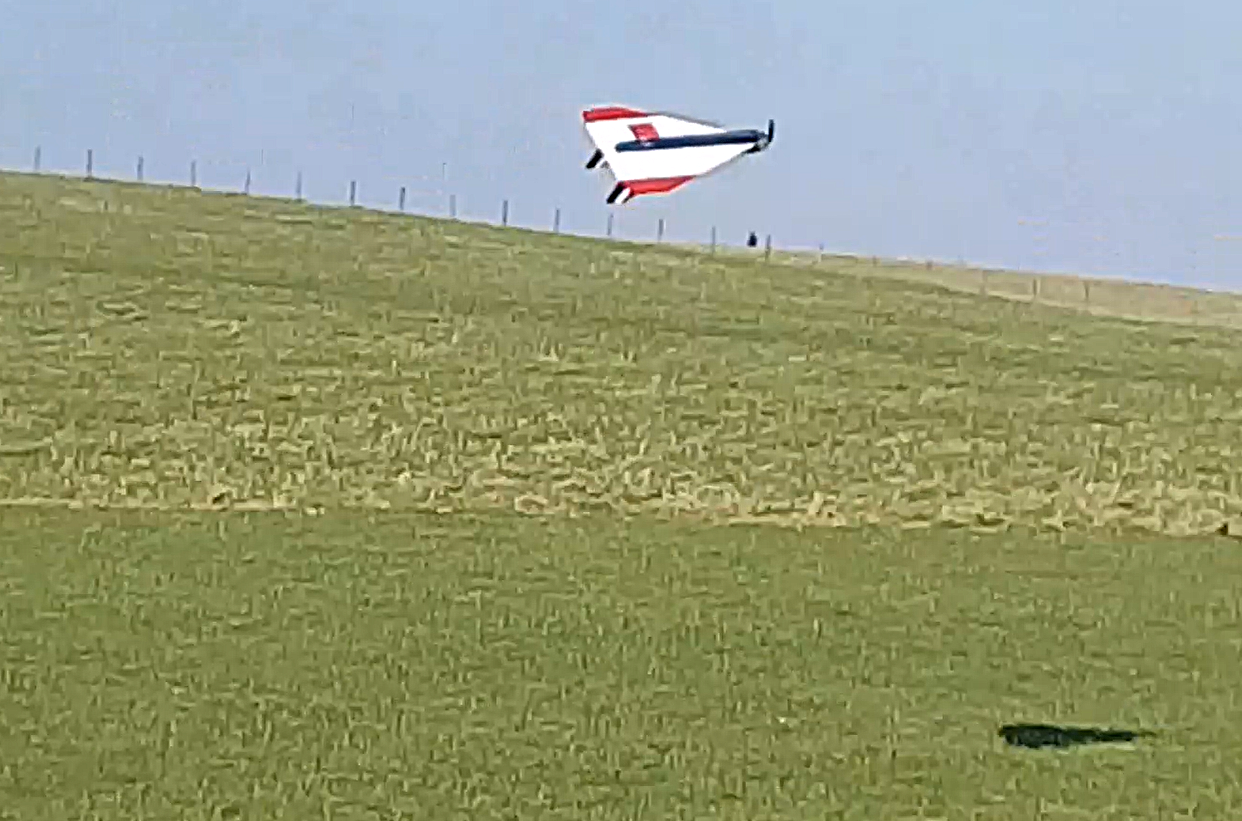
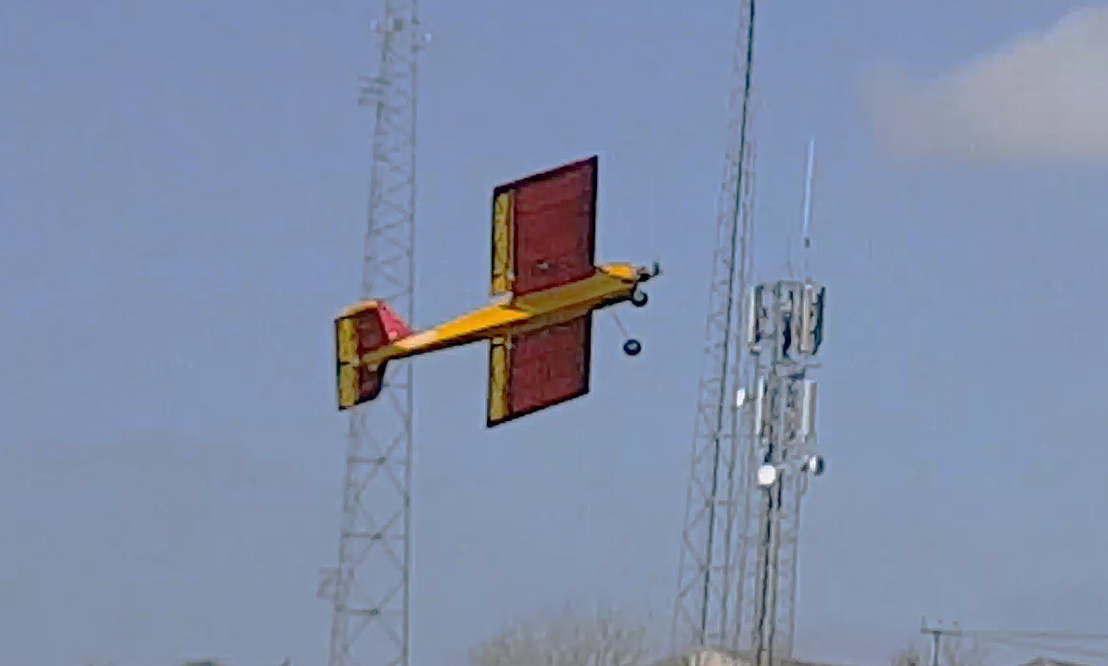
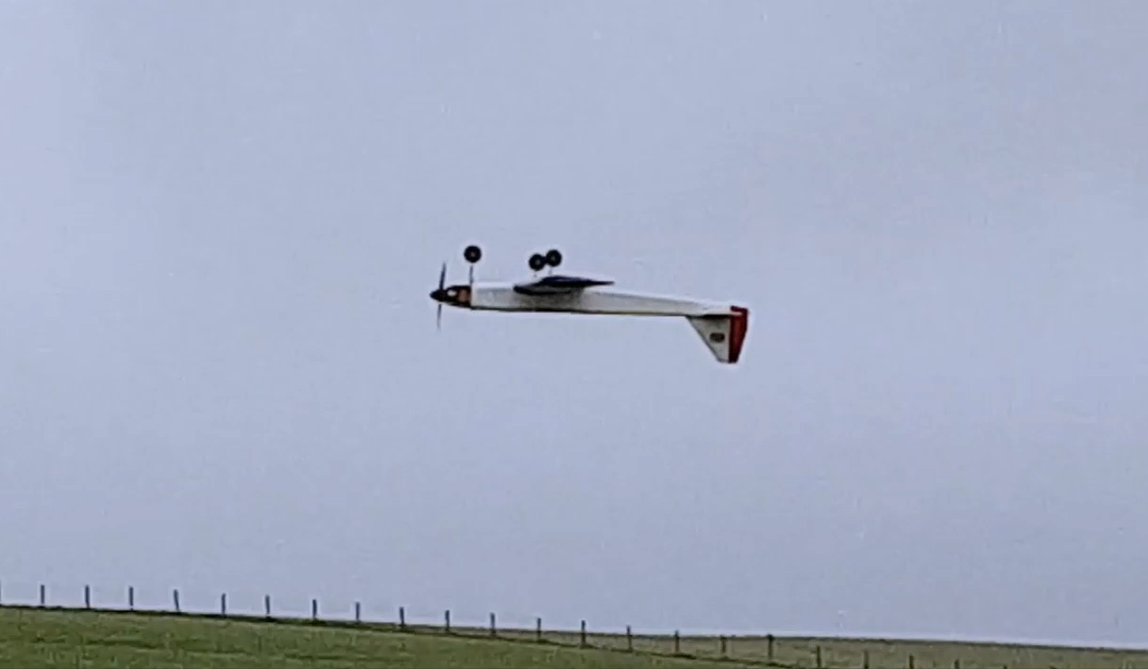
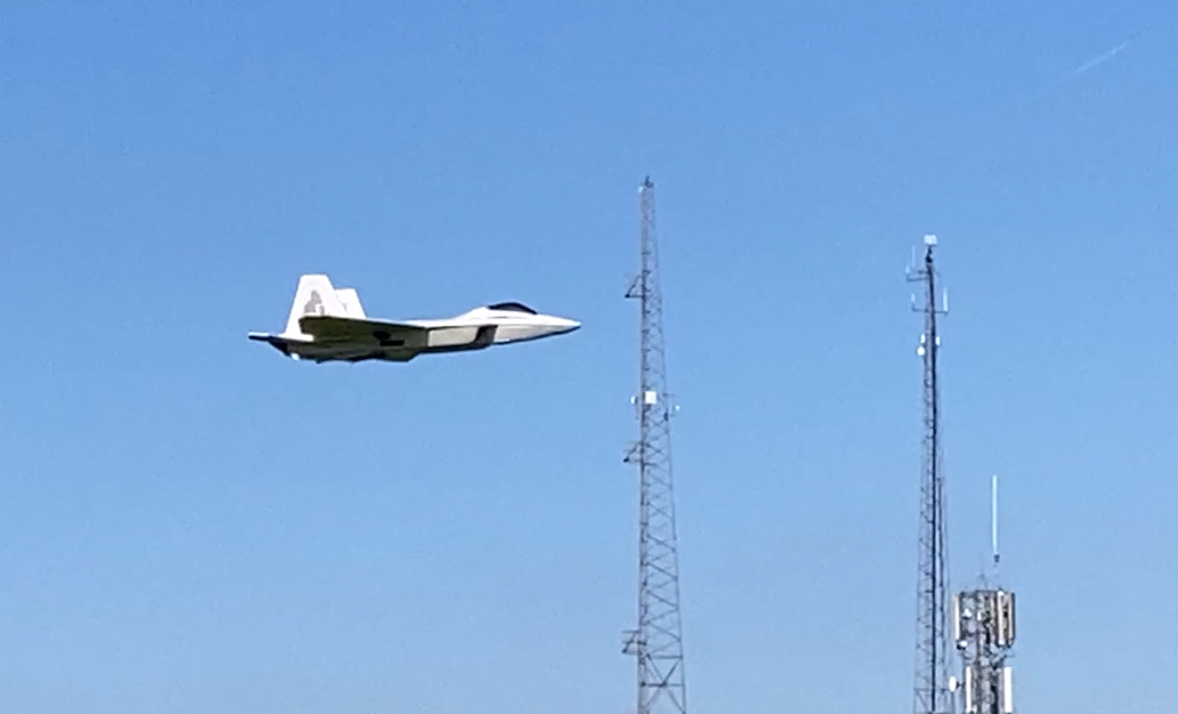
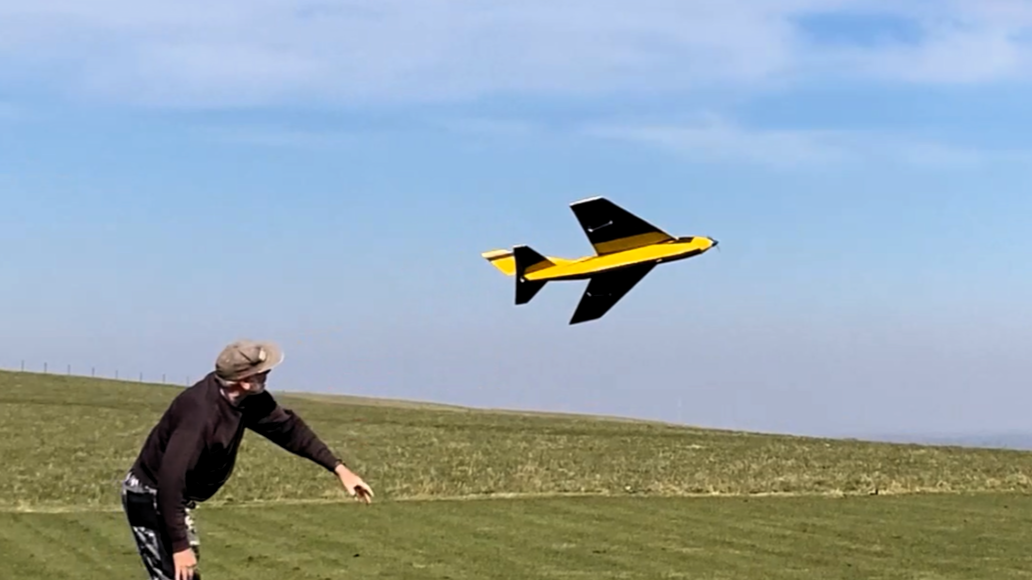
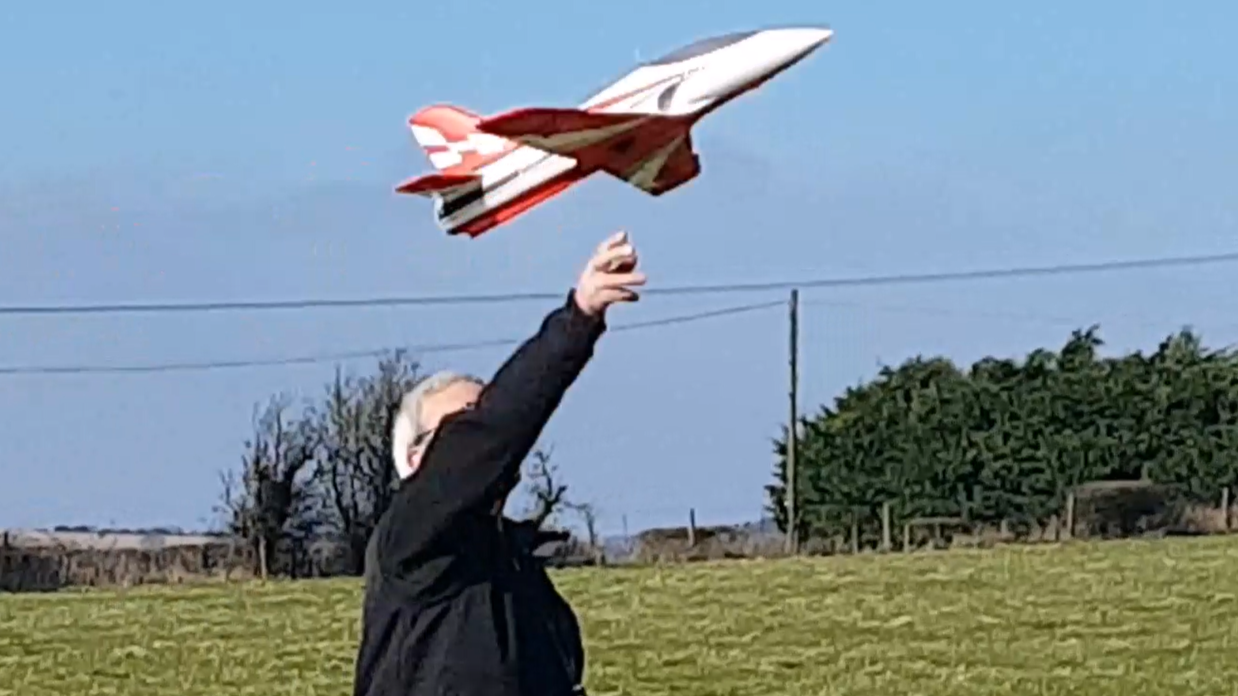
Video time now, this month with footage shot by myself, Dougal Entendre, and MacFly.
Please watch the video full-screen, it’s so much better with small models flying around:
If the video won’t play for you please click HERE
The Final Funny:
This month I have a helpful tip for you when you’re flying off on your holiday.
If you board the plane and spot Jack, your old mate from school, don’t call out “Hi Jack!”
Colin Cowplain

